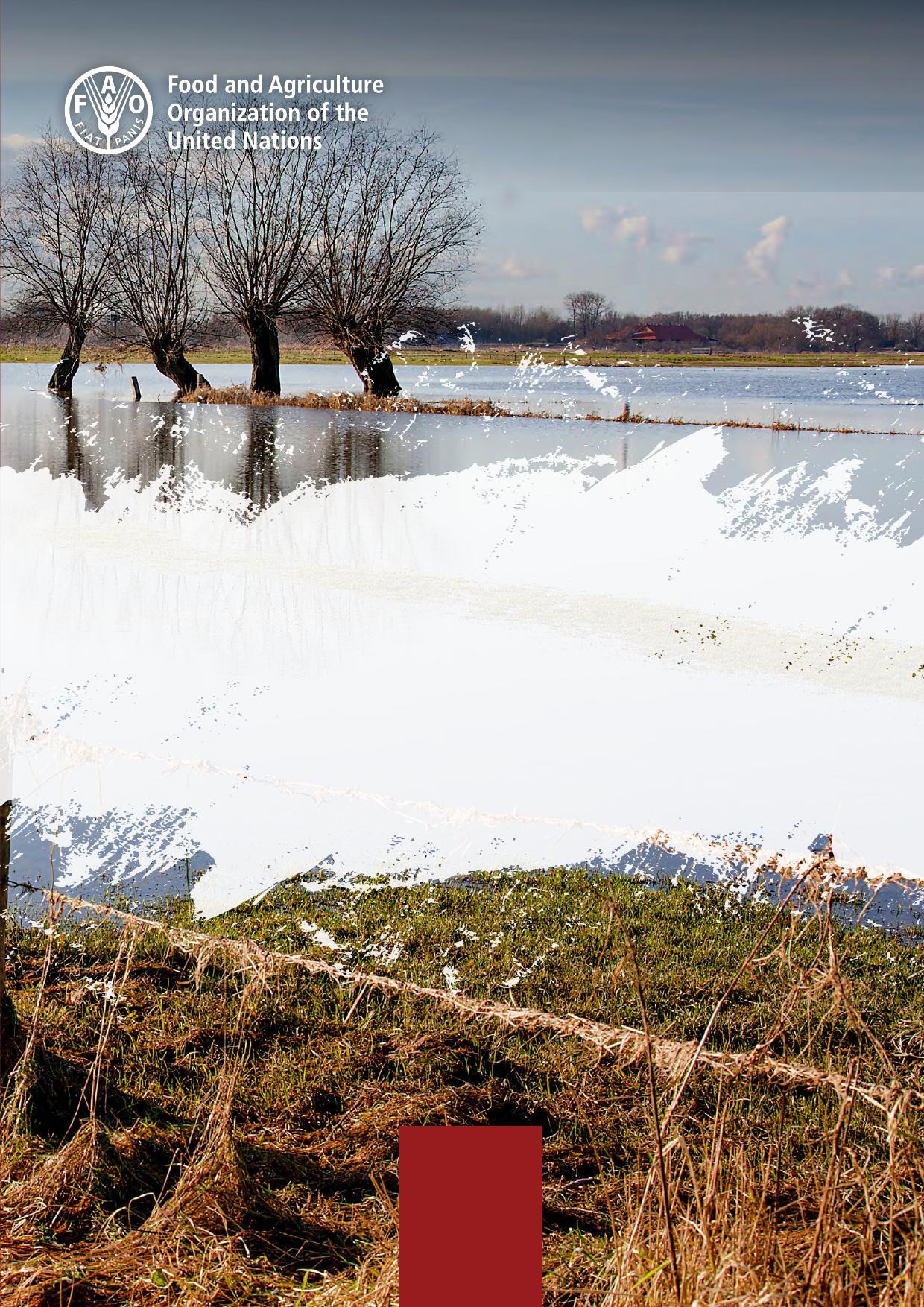THEIMPACTOFDISASTERSONAGRICULTUREANDFOODSECURITYAVOIDINGANDREDUCINGLOSSESTHROUGHINVESTMENTINRESILIENCE2023Requiredcitation:FAO.2023.TheImpactofDisastersonAgricultureandFoodSecurity2023–Avoidingandreducinglossesthroughinvestmentinresilience.Rome.https://doi.org/10.4060/cc7900enThedesignationsemployedandthepresentationofmaterialinthisinformationproductdonotimplytheexpressionofanyopinionwhatsoeveronthepartoftheFoodandAgricultureOrganizationoftheUnitedNations(FAO)concerningthelegalordevelopmentstatusofanycountry,territory,cityorareaorofitsauthorities,orconcerningthedelimitationofitsfrontiersorboundaries.Dashedlinesonmapsrepresentapproximateborderlinesforwhichtheremaynotyetbefullagreement.Thementionofspecificcompaniesorproductsofmanufacturers,whetherornotthesehavebeenpatented,doesnotimplythatthesehavebeenendorsedorrecommendedbyFAOinpreferencetoothersofasimilarnaturethatarenotmentioned.ISBN978-92-5-138194-6©FAO2023Somerightsreserved.ThisworkismadeavailableundertheCreativeCommonsAttribution-NonCommercial-ShareAlike3.0IGOlicence(CCBY-NC-SA3.0IGO;https://creativecommons.org/licenses/by-nc-sa/3.0/igo/legalcode).Underthetermsofthislicence,thisworkmaybecopied,redistributedandadaptedfornon-commercialpurposes,providedthattheworkisappropriatelycited.Inanyuseofthiswork,thereshouldbenosuggestionthatFAOendorsesanyspecificorganization,productsorservices.TheuseoftheFAOlogoisnotpermitted.Iftheworkisadapted,thenitmustbelicensedunderthesameorequivalentCreativeCommonslicence.Ifatranslationofthisworkiscreated,itmustincludethefollowingdisclaimeralongwiththerequiredcitation:“ThistranslationwasnotcreatedbytheFoodandAgricultureOrganizationoftheUnitedNations(FAO).FAOisnotresponsibleforthecontentoraccuracyofthistranslation.TheoriginalEnglisheditionshallbetheauthoritativeedition.”DisputesarisingunderthelicencethatcannotbesettledamicablywillberesolvedbymediationandarbitrationasdescribedinArticle8ofthelicenceexceptasotherwiseprovidedherein.TheapplicablemediationruleswillbethemediationrulesoftheWorldIntellectualPropertyOrganizationhttp://www.wipo.int/amc/en/mediation/rulesandanyarbitrationwillbeconductedinaccordancewiththeArbitrationRulesoftheUnitedNationsCommissiononInternationalTradeLaw(UNCITRAL).Third-partymaterials.Userswishingtoreusematerialfromthisworkthatisattributedtoathirdparty,suchastables,figuresorimages,areresponsiblefordeterminingwhetherpermissionisneededforthatreuseandforobtainingpermissionfromthecopyrightholder.Theriskofclaimsresultingfrominfringementofanythird-party-ownedcomponentintheworkrestssolelywiththeuser.Sales,rightsandlicensing.FAOinformationproductsareavailableontheFAOwebsite(www.fao.org/publications)andcanbepurchasedthroughpublications-sales@fao.org.Requestsforcommercialuseshouldbesubmittedvia:www.fao.org/contact-us/licence-request.Queriesregardingrightsandlicensingshouldbesubmittedto:copyright@fao.org.COVERPHOTOGRAPH©ToondeVos/Pexels.comTHEKINGDOMOFTHENETHERLANDS.Anaverageof12000hectaresofcropslikecotton,cornandwalnutwereaffectedbyrainandriveroverflows.THEIMPACTOFDISASTERSONAGRICULTUREANDFOODSECURITYAVOIDINGANDREDUCINGLOSSESTHROUGHINVESTMENTINRESILIENCE2023FoodandAgricultureOrganizationoftheUnitedNationsRome,2023CONTENTSTUREANDFOODSECURITYTHEIMPACTOFDISASTERSOACTOFDISASTERSONAGRICULTUREANDFOODSECURIT9PART2IMPACTOFDISASTERSINAGRICULTUREKeymessages102.1Multifacetedimpactsofdisastersinagriculture11792.2TowardsanassessmentofFOREWORDvglobalagriculturallosses16METHODOLOGYvii2.3Measurementandevidenceoncropsandlivestock21PART4ACKNOWLEDGEMENTSviii2.4Measuringimpactsinforestry,DISASTERRISKREDUCTIONSOLUTIONSINAGRICULTUREACRONYMSxandfisheriesandaquaculture43KEYMESSAGESKeymessages80xii4.1Benefitsfromfarm-leveldisasterriskreductionpractices82EXECUTIVESUMMARYxiv4.2Returnoninvestmentofanticipatoryactioninterventions894.3Combiningpreventativecontrolandanticipatoryaction–57thecaseofdesertlocustsintheHornofAfrica941PART3DISASTERRISKDRIVERSANDCASCADINGIMPACTSPART1Keymessages58INTRODUCTION3.1.Linkingclimatechangeto1.1Aconceptualframeworkofagriculturalproductionloss6099disasterrisksandtheorganization3.2Pandemicandepidemic:PART5COVID‑19andAfricanswinefever65ofthisreport4CONCLUSIONS3.3Theimpactofarmedconflictonagriculture73TECHNICALANNEXES104GLOSSARY117NOTES122iiONAGRICULTUREANDFOODSECURITYTHEIMPACTOFDISTYTHEIMPACTOFDISASTERSONAGRICULTUREANDFOOTABLESFIGURES16Totalagriculturallossesasapercentageofestimated1Hazardtypes1NumberofdisastersbyEM-DATcounterfactualproductionbyaddressedinthisreport4hazardgrouping,andtotalcommoditygroupworldwide,economiclosses(1971–2022)3inlow-incomecountries,and2PinewoodnematodeinSmallIslandDevelopingdiseaseinChina482ConceptualframeworkStates(1991–2021)293Dimensionsofdisasterforthereport517Productionlosspereventimpactsinforestry503Statusofemploymentbyhazardtypeincropsand4Lossanddamageinfisheryinagricultureformenandlivestock(1991-2021)30andaquaculturecausedbythewomeninPakistan1518DroughtimpactonHungaTonga–HungaHa’apai4Shareofsectorallosses17livestockkeepers31eruptionandtsunami545Shareof(percentage)lossin19Relativedifferencein5Overviewofattributionresults63agriculturebyhazardtype19livestockpopulationcomparedto6BenefitcostratiosforFAO’s6Breakdownoflossesinpre-droughtyear32anticipatoryactioninterventions90agriculturebysubsectors20Relativedifferencein7Summaryofactionsand(2007-2022)19livestockofftakecomparedtooutcomesforthe2020–20217Agriculturallossesdeclaredpre-droughtyear32desertlocustemergency96underSendaiFramework21Relativedifferencein8PoolofclimateindicesindicatorC2(2015–2021)20milkofftakecomparedtousedforthestatisticalcrop8Shareofimpactbypre-droughtyear33modelling,whichisthenreducedhazardtypedeclared22AveragelocalmarketpricesbasedonindependenceandunderSendaiFramework(USD)forlocalqualitygoatandexplanatorypower109indicatorC2(2015-2022)20camelmilk(toprow)andterms9Costsandbenefits1119Totalestimatedagriculturaloftradeinthepre-drought,productionlossesdroughtandpost-drought10Costsandbenefits23years(bottomrow)34perhousehold11410Estimatedlossesinmain23Relativedifferenceintheproductgroups(1991–2021)23estimatedvalueofanimal11DistributionoftotalestimatedandmilkofftakecomparedtolossesofUSD3.8trillionbypre-droughtyear35region(1991–2021)2624GlobalmapofFAWinvasion3612Lossesasshareof25Lineofbestfitwhentotalyieldloss(proportion)isagriculturalgrossdomesticregressedonplantdamagerating38product(1991-2021)2613Totalagriculturallosses26Lineofbestfitformaizewhenyieldloss(proportion)asashareofagriculturalisregressedforplantswithadamageratinggreaterthanthree38grossdomesticproductbysubregion(1991-2021)2614Totalagriculturallosses(top)27Totalestimateddailylossesandtotalagriculturallossesasofenergyandnutrientsperashareofagriculturalgrosspersonperdaybyfoodgroup,domesticproduct(bottom)byasapercentage(1991-2021)40countrygroups(1991-2021)2815Totalagriculturallosses28Estimateddailylossesasapercentageofestimatedofenergyandnutrientscounterfactualproductionbyasashareofhumansubregion(1991-2021)requirements(1991-2021)4028iiiTUREANDCONTENTSFOODSECURITYTHEIMPACTOFDISASTERSOACTOFDISASTERSONAGRICULTUREANDFOODSECURIT29Estimateddailylossesof40BenefitcostratiosandnetBOXESenergyandnutrientsasashareofpresentvaluesofthedisasterriskhumanrequirementsformenbyreductiongoodpracticeofridge1Recenteventsregion(1991-2021)41sowingofcottoncombinedwithaffectingagriculture1330EstimateddailylossesofintegratedpestmanagementenergyandnutrientsasashareofintheMuzaffargarhdistrictof2DisasterdisplacementhumanrequirementsforwomenPakistanduringkharifin202187anditseffectsonagriculturebyregion(1991-2021)41Benefitcostratiosandnetandfoodsecurity144131Historicaldataofburntarea,presentvaluesofthegreen3Unveilinggendervulnerability:numberoffiresandCO2emissionssuperriceandlocalricevariety,impactofdisastersonfromwildfires(2000–2021)undernon-hazardandhazardfemaleemploymentin45conditionsintheBicolregionofagricultureinPakistan1532DamageandlossinthePhilippines874Methodologyforestimatingfisheriesandaquaculture42Differenceinreturnsfromdisaster-inducedcropriceproduction,GSRscalingupcausedbyTyphoonRai54versuspreviouspracticescenario88andlivestocklossesat33Climateimpactsontheglobalscale22agrifoodsystemsandrelevant43Keycharacteristicsof5Animalhealth:impactofattributionconcepts60anticipatoryaction89the2016/17droughtonSomali34Estimatedinfluenceof44Outcomeofinterventionlivestockkeepers31climatechangeoncropyieldstoperhectaretreated956Croplossesonthedate:fourcasestudies64ground:thecaseofthefall35Percentageoffarmersarmyworminfestation36reportingdifficultiestransportingproductsandaccessinginputs687Estimatingnutrientavailabilityreductions36Damageandlossincropsandcausedbydisasters42livestocksubsectorsinUkraine8Twopestsaffectingforests48(USDmillionandpercentage)7737Cumulativenetpresentvalue9Barkbeetledamageperacreover11yearsofbananainHonduras49cultivationwithmulching,10Methodologytoattributeyieldchangetoclimatechange61contourtrenches,organiccompostingandimproved11MethodologytoestimatevarietiesinUganda84theimpactoftheCOVID-1938Simulationresults–AveragepandemiconagricultureannualnetpresentvaluesusingtheDatainEmergenciesfrombananaproductionunderMonitoring(DIEM)69differenthazardfrequency12Methodologyforcost–benefitscenarios:disasterriskanalysis(CBA)offarm-levelreductiongoodpracticescalingDRRgoodpracticesupscenarioversusprevious83practicescenario,central13Methodologytoregion,Uganda(USDmillions)84estimateavoidedlosses39Cumulativenetbenefitsandfromrisk-informeddesertbenefitcostratioofdisasterlocustintervention94riskreductiongoodpracticesforllamacamelidsandinthePlurnationalStateofBolivia85ivFOREWORDONAGRICULTUREANDFOODSECURITYTHEIMPACTOFDISTYTHEIMPACTOFDISASTERSONAGRICULTUREANDFOODisastersarecausingunprecedentedlevelsofdestructionacrosstheglobe,demandingnewapproachestoreducingrisk,strengtheningresponsecapabilitiesandbuildingresiliencecapacities.Theyear2023hasbrokenallexistingrecordsforthehighesttemperaturesrecordedonourwarmingplanetandepisodesofextremefloods,storms,droughts,wildfires,andpestanddiseaseoutbreaksarebecomingdailyfeaturesinglobalheadlines.Astheeffectoftheclimatecrisisunfolds,thefrequencyandintensityofclimate-relateddisastersarealsoincreasing,inflictingaheavytolloncommunitiesandlivelihoodsacrosstheworld.Agricultureisoneofthemosthighlyexposedandvulnerablesectorsinthecontextofdisasterrisk,givenitsprofounddependenceonnaturalresourcesandclimateconditions.Recurrentdisastershavethepotentialtoerodegainsinfoodsecurityandunderminethesustainabilityofagrifoodsystems.Withthisreport,theFoodandAgricultureOrganizationoftheUnitedNations(FAO)presentsgroundbreakingevidenceontheglobalimpactofdisastersonagricultureandfoodsecurityoverthelastthreedecades.Itwasmydecisiontoelevatethisreporttothelevelofaflagshippublication,toreflectourcommitmenttoinvestinginevidence-baseddisasterriskreductionsolutionsandpromotingmoreefficient,inclusive,resilientandsustainableagrifoodsystemsforabetterfutureallaroundtheworld.Thefindingsofthereportarestark.WehavelostanestimatedUSD3.8trillionworthofcropsandlivestockproductionduetodisastereventsoverthepastthreedecades.Thiscorrespondstomorethan5percentofannualglobalagriculturalGDP,afigurethatwouldbesignificantlyhigherifsystematicdataonlossesinthefisheriesandaquaculture,andforestrysubsectorswasavailable.Weurgentlyneedbetterinformationontheimpactofdisastersinallsubsectorsofagriculturetocreatedatasystemsthatcanserveasthefoundationuponwhicheffectiveactioncanbebuiltandinformed,andtomeetthemonitoringrequirementsoftheSendaiFrameworkonDisasterRiskReductionandthe2030AgendaforSustainableDevelopment.vTUREANDFOREWORDFOODSECURITYTHEIMPACTOFDISASTERSOACTOFDISASTERSONAGRICULTUREANDFOODSECURITInsomeways,disastereventsrepresentthetipoftheiceberg.Therearedeeperunderlyingchallengesandvulnerabilitiescreatedbysocialandenvironmentalconditionsthatgeneratedisastrousoutcomesandproducecascadingeffectsacrossagrifoodsystems.Poverty,unequalaccesstoresourcesandgovernancestructuresallplayapivotalroleindeterminingtheimpactsofdisastersandcrises.Amongthese,theclimatecrisisishavingasignificanteffectinamplifyingexistingrisks,butrecentpandemicsandarmedconflictshavealsocontributedtolossesexperiencedintheagrifoodsector.Reducingtheimpactofdisasterswillrequirenotonlyunderstandingtheirdirecteffects,butalsonecessitatesunpackingtheoverarchingconditionsthatdriverisksandthewayinwhichtheirimpactscascadeoversectors,systemsandgeographicalregions.Inaworldwithlimitedresources,weneedtoincreaseinvestmentinresiliencebyadoptingcreative,innovativeandscalablesolutionsthatcanavoidandreducelossesgeneratedbydisasters.LeveragingFAO’stechnicalexpertise,thispublicationshowcasesopportunitiestoproactivelyaddressrisksinagriculturewhiledemonstratingwaystomainstreamdisasterriskintoagriculturalpracticesandpolicies.Itcallsforadeepunderstandingofthecontextinwhichthesesolutionsareimplemented,aswellasstrengthenedpartnershipsandcollaborationwithallrelevantpartners.AspartofFAO’sworktosupportrisk-informedagrifoodsystems,thisreportisavaluableadditiontotheknowledgebaserequiredforadoptingandscalingupinnovativeapproachestoresilientandsustainableagriculture,thusenablingbetterproduction,betternutrition,abetterenvironmentandabetterlife–whileleavingnoonebehind.QuDongyuFAODirector-GeneralviMETHODOLOGYONAGRICULTUREANDFOODSECURITYTHEIMPACTOFDISTYTHEIMPACTOFDISASTERSONAGRICULTUREANDFOOTheImpactofDisastersonAgricultureandFoodSecurity2023hasbeenpreparedbytheStatisticsDivision(ESS)andtheOfficeofEmergenciesandResilience(OER)ofFAO.TechnicalinputswereprovidedbytheOfficeofClimateChange,BiodiversityandEnvironment(OCB),andtheFisheriesandAquacultureDivision(NFI),theForestryDivision(NFO),theAnimalProductionandHealthDivision(NSA),andthePlantProductionandProtectionDivision(NSP)oftheNaturalResourcesandSustainableProductionstream.AcoordinationteamconsistingofthemanagementofthecollaboratingdivisionsandofficesofFAOguidedtheproductionofthereport.Thisteamdecidedontheoutlineofthereportanddefineditsthematicfocus.Further,itoversawthetechnicalwritingteamcomposedofexpertsfromthecollaboratingdivisionswhocontributedtotheanalysisandtechnicalcontentofthereport.Backgroundtechnicalpaperswerepreparedtosupporttheresearchanddataanalysisundertakenforindividualsectionsofthereport.Thewritingteamproducedseveralinterimoutputs,includinganannotatedoutline,firstdraftandfinaldraftofthereport.Thesedraftswerereviewedandvalidatedbyexternalexpertsintwoworkshopsheldduringthepreparationprocess.Thefinalreportunderwentarigoroustechnicalreviewbyseniormanagement,technicalexpertsfromvariousdivisionsandofficesofFAO,aswellasindependentexternalreviewers.Finally,thereportunderwentaprocessofexecutiveclearanceatFAObytheheadsoftheco-publishingdivisions,theChiefEconomist,theDeputyDirector-GeneralinchargeofEmergenciesandResilience,andtheofficeoftheDirector-General.viiACKNOWLEDGEMENTSTUREANDFOODSECURITYTHEIMPACTOFDISASTERSOACTOFDISASTERSONAGRICULTUREANDFOODSECURITTheImpactofDisastersonAgricultureandFoodSecurity2023istheoutcomeofextensivecollaborationacrossseveraltechnicaldivisionsandofficeswithintheFoodandAgricultureOrganizationoftheUnitedNations(FAO),primarilyincludingtheEconomicandSocialDevelopmentStream,theOfficeofEmergenciesandResilience(OER),theOfficeofClimateChange,BiodiversityandEnvironment(OCB),andtheNaturalResourcesandSustainableProductionstream.ThereportwasjointlyproducedbytheStatisticsDivisionofFAO(ESS)andOER,withtheoverallguidanceofLaurentThomasandMaximoTorreroCullen,andunderthedirectionofJoséRoseroMoncayoandReinPaulsen.ThedevelopmentofthereportwascoordinatedbyateamconsistingofZehraZaidi,theeditorofthepublication,andWiryaKhim,PieroConforti,StephanBaas,LaurelHansonandVeronicaBoero.ManagerialsupportwasprovidedbyPieroConforti,ShukriAhmed,FleurWouterseandDunjaDujanovic.CentraltothedevelopmentofthereportwerethetechnicalpapersandbackgroundmaterialspreparedandrevisedbyseveralFAOexperts.ValuablecommentsandfinalapprovalofthereportwereprovidedbytheexecutiveheadsandseniorstaffofvariousFAOdivisions.Part1ofthereportwaswrittenbyZehraZaidiandPieroConforti,withinputfromWiryaKhimandLaurelHanson.Part2ofthereportwascoordinatedbyZehraZaidi.Section2.1waswrittenbyZehraZaidi.SylvainPonserreandVicenteAnzellinioftheInternalDisplacementMonitoringCenterdevelopedBOX2ondisplacement,andGiuliaCaivanoandPritiRajagopalanproducedBOX3ongenderinsection2.1.ZehraZaidiwrotesection2.2withsupportfromPieroConforti.RahulSenguptaandXuanCheoftheUnitedNationsOfficeforDisasterRiskReduction(UNDRR)provideddataandinputfortheanalysisoftheC2SendaiIndicator.Section2.3waswrittenbyPieroConforti,ZehraZaidi,VeronicaBoero,PritiRajagopalanandEstherLaske.KeyinputswereprovidedbyPritiRajagopalan,EstherLaskeandVeronicaBoeroontheestimationofdisasterlosses,whilesupportandcommentswereprovidedbyAntonioScognamillo,NidhiChaudharyandXinmanLiu.Subsection2.3.2onnutritionwasproducedbyEstherLaske,incollaborationwithNancyAburto,BridgetHolmesandVictoriaPaduladeQuadro.Section2.4wascoordinatedbyZehraZaidi,withkeyinputsfromEstherLaske.Backgroundpapersandtechnicalinputsforsection2.3wereprovidedbyJoachimOtteandDominikWisserfromtheAnimalProductionandHealthDivision(NSA),CharlesMidega(independentconsultant),BuyungHadiandShawnMcGuireonbehalfofthePlantProtectionandProductionDivision(NSP),LaraSteil,ShiromaSathyapala,PeterMoore,WilliamJohndeGroot,ErikLindquistandAmyDuchelleascontributingauthorsfortheForestryDivision(NFO),andStefaniaSavore,IrisMonnereau,SilkePietzsch(FAORAP),JamesMcCafferty(independentconsultant)andLatu‘Aisea(MinistryofFisheries,Tonga)onbehalfoftheFisheriesandAquacultureDivision(NFI).Part3ofthereportwascoordinatedbyWiryaKhim,LaurelHansonandStephanBaas.Forsection3.1,WiryaKhim,StephanBaas,LaurelHansonandJuliaWolfprovidedoverallcoordinationandguidancewithinputfromPieroConfortiandZehraZaidi.ThepolicydevelopmentssectionwaswrittenbyMakieYoshidaandSilviaSantato.TheattributionandimpactstudywaswrittenbySabineUndorf(PotsdamInstituteforClimateImpactsResearch),BernhardSchauberger(PotsdamInstituteforClimateImpactResearch/Weihenstephan-TriesdorfUniversityofAppliedScience),LennartJansen(PotsdamInstituteforClimateImpactResearch/UniversityofKassel),PaulaRomanovska(PotsdamInstituteforClimateImpactResearch)andChristophGornott(PotsdamInstituteforClimateImpactviiiONAGRICULTUREANDFOODSECURITYTHEIMPACTOFDISTYTHEIMPACTOFDISASTERSONAGRICULTUREANDFOOResearch/UniversityofKassel)withinputfromHidekiKanamaru,WiryaKhim,LaurelHansonandStephanBaas.Section3.2.1waswrittenbyAmandinePoncin,NeilMarslandandJosselinGauny,withinputsfromWiryaKhimandLaurelHanson.Section3.2.2waswrittenbyDamianTagoPacheco,BoudaVosoughAhmadi,AndriyRozstalnyy,MadhurDhingraandKeithSumption,withinputfromWiryaKhim,LaurelHansonandStephanBaas.Section3.3waswrittenbyLaurelHanson,JuliusJacksonandNeilMarslandwithinputfromDanieleBarelliandJosselinGauny.Part4ofthereportwascoordinatedbyWiryaKhim,StephanBaasandLaurelHanson.Section4.1waswrittenbyWiryaKhim,TamaraVan’tWoutandLaurelHansonwithinputfromStephanBaasandNiccolòLombardi.Section4.2waswrittenbyNicholasBodanacandNiccolòLombardiwithinputfromWiryaKhimandLaurelHanson.Section4.3waswrittenbySergioInnocente,WiryaKhimandLaurelHansonwithinputfromKeithCressman,CyrilFerrand,ShokiAlDobai,StephanBaasandShukriAhmed.Part5wasjointlypreparedbyZehraZaidiandPieroConforti,withinputfromEstherLaske,WiryaKhim,LaurelHansonandStephanBaas.Numerousexternalexpertsprovidedcomprehensivereviewsandvaluabletechnicalcommentsforthereport.TheentirereportwaspeerreviewedbyJulioSerje(formerUNDRRstaffmember).ForPart2ofthereport,SepehrMarzi,oftheJointResearchCentreoftheEuropeanCommission(JRC),andJeremyPal,oftheEuro-MediterraneanCenteronClimateChange(CMCC)undertookatechnicalreviewofthemethodology.Specificreviewsforsection2.4wereprovidedbyYacobAklilu(Farm-D)forthelivestocksection,byKrisWykhuis(FAO),RogerDay(CentreforAgricultureandBioscienceInternational[CABI]),AnnaSzyniszewska(CABI),BryonyTaylor(CABI)andFazilDusunceliforthesectiononfallarmyworm,AneAlencar(theAmazonEnvironmentalResearchInstitute[IPAM]),BrettHurley(UniversityofPretoria),GaryMan,SimonLawson,RobertRabaglia(USDAForestService),JesusSan-Miguel-Ayanz(JRC)forthesectiononforestryandDenisLacroix(InstitutFrançaisdeRecherchepourl’ExploitationdelaMer[Ifremer])forthesectiononfisheries.Section3.1wasreviewedbyCarlosDionisioPerezBlanco(UniversityofSalamanca),ElisaCalliari(InternationalInstituteforAppliedSystemsAnalysis),AndreaToretti(JRC),RupertStuart-Smith(OxfordUniversity),JamesDouris(WorldMeteorologicalOrganization[WMO]),VeronicaGrasso(WMO),SihanLi(UniversityofSheffield)andToshichikaIizumi(NationalAgricultureandFoodResearchOrganization[NARO]–Japan).Section3.2.1ontheCOVID-19pandemicwasreviewedbyMarkAlexanderConstas(CornellUniversity)andJohnM.Ulimwengu(InternationalFoodPolicyResearchInstitute[IFPRI]),whilesection3.2.2onAfricanswinefeverwasreviewedbyManonSchuppers(SAFOSOAG)andKarlRich(OklahomaStateUniversity).Section3.3ontheimpactofarmedconflictsonagriculturewasreviewedbyDominiqueBlariaux(PostCrisisAssessmentandRecoveryPlanning:SupportOfficeoftheEuropeanUnion),IrynaVysotska(TheQualityFoodTradeProgram)andIgorKravchenko(TheQualityFoodTradeProgram).ProductionsupportwasprovidedbyOlivierLavagned’OrtigueandChiaraGnetti.TheFAOPublicationsandLibraryBranchoftheOfficeofCommunicationsprovidededitorialsupport,design,andlayout,aswellasproductioncoordinationforeditionsinallsixofficiallanguages.TheFAOMeetingBranchandLanguageServicesBranchofGoverningBodiesServicingDivision(CSG)carriedoutthetranslations.ixACRONYMSTUREANDFOODSECURITYTHEIMPACTOFDISASTERSOACTOFDISASTERSONAGRICULTUREANDFOODSECURITAAanticipatoryactionASEANAssociationofSoutheastAsianNationsAfricanswinefeverASFbenefit–costratioBCRBureauofFisheriesandAquaticResources(thePhilippines)BFARbodymassindexBMICoupledModelIntercomparisonProjectPhase6CMIP6ConferenceofPartiesCOPCentreforResearchontheEpidemiologyofDisastersCREDDetectionandAttributionModelIntercomparisonProjectDAMIPDepartmentofForestry,FisheriesandtheEnvironment(SouthAfrica)DFEEFAODatainEmergenciesDIEMTheSomaliaDroughtImpactandNeedsAssessmentDINADesertLocustInformationServiceDLISdisasterriskreductionDRRestimatedaveragerequirementEARequilibriumclimatesensitivityECSEuropeanFoodSafetyAuthorityEFSATheInternationalDisasterDatabaseEM-DATElNiño-SouthernOscillationENSOfallarmywormFAWfoodcompositiontableFCTFoodSecurityandNutritionAnalysisUnit(Somalia)FSNAUgrossdomesticproductGDPGlobalFacilityforDisasterReductionandRecoveryGFDRRgreensuperriceGSRGlobalWildfireInformationSystemGWISharmfulalgalbloomsHABsHungaTonga–HungaHa’apaiHT–HHInternalDisplacementMonitoringCentreIDMCinternallydisplacedpeopleIDPInternationalFundforAgriculturalDevelopmentIFADintegratedfiremanagementIFMxONAGRICULTUREANDFOODSECURITYTHEIMPACTOFDISTYTHEIMPACTOFDISASTERSONAGRICULTUREANDFOOIFRCInternationalFederationofRedCrossandRedCrescentSocietiesIOMInternationalOrganizationforMigrationIPCIntegratedFoodSecurityPhaseClassificationIPCCIntergovernmentalPanelonClimateChangeMIROC6ModelforInterdisciplinaryResearchonClimateMPBmountainpinebeetleNAPNationalAdaptationPlanNDCnationallydeterminedcontributionsNPVnetpresentvaluesIRCInternationalRescueCommitteeISCInternationalScienceCouncilISIMIP3Inter-SectoralModelIntercomparisonProjectMODISmoderate-resolutionimagingspectroradiometerNOAANationalOceanicandAtmosphericAdministrationOECDOrganisationforEconomicCo-operationandDevelopmentOIEWGopen-endedintergovernmentalexpertworkinggroupPALphysicalactivitylevelPDNApostdisasterneedsassessmentPPPpurchasingpowerparityRoIreturnoninvestmentSDGsUnitedNationsSustainableDevelopmentGoalsSIDSSmallIslandDevelopingStatesSPBsouthernpinebeetleTADtransboundaryanimaldiseasesTCRtransientclimateresponseTFPtotalfactorproductivityUNDPUnitedNationsDevelopmentProgrammeUNDRRUnitedNationsOfficeforDisasterRiskReductionUNFCCCUnitedNationsFrameworkConventiononClimateChangeUSAIDUnitedStatesAgencyforInternationalDevelopmentUSDAUnitedStatesDepartmentofAgricultureWFPWorldFoodProgrammeWHOWorldHealthOrganizationWIMWarsawInternationalMechanismWMOWorldMeteorologicalOrganizationWWAWorldWeatherAttributionxiKEYMESSAGESTUREANDFOODSECURITYTHEIMPACTOFDISASTERSOACTOFDISASTERSONAGRICULTUREANDFOODSECURITèDefinedasseriousdisruptionstothefunctioningofacommunityorsociety,disastersareproducingunprecedentedlevelsofdamageandlossinagriculturearoundtheworld.Theirincreasingseverityandfrequency,from100peryearinthe1970stoaround400eventsperyearinthepast20years,affectagrifoodsystemsacrossmultipledimensions,compromisingfoodsecurityandunderminingthesustainabilityoftheagriculturesector.èDatafordescribingtheimpactofdisastersonagricultureandagrifoodsystemsispartialandinconsistent,especiallyinthefisheries,aquacultureandforestrysubsectors.Thereisanurgentneedforimprovingdatacollectiontoolsandsystemstosupportevidence-basedpolicies,practicesandsolutionsforriskreductionandresiliencebuildinginagriculture.Despitetheselimitations,thisnewflagshipreportpresentsthefirsteverglobal-levelestimationoftheimpactofdisastersonagriculture.èOverthelast30years,anestimatedUSD3.8trillionworthofcropsandlivestockproductionhasbeenlostduetodisasterevents,correspondingtoanaveragelossofUSD123billionperyear,or5percentofannualglobalagriculturalGDP.Inrelativeterms,thetotalamountoflossesover30yearsisapproximatelyequivalenttoBrazil’sGDPin2022.èOverthelast30years,disastersinflictedthehighestrelativelossesonlower-andlower-middle-incomecountries,rangingbetween10and15percentoftheirtotalagriculturalGDP,respectively.DisastersalsohadasignificantimpactonSmallIslandDevelopingStates(SIDS),causingthemtolosenearly7percentoftheiragriculturalGDP.xiiONAGRICULTUREANDFOODSECURITYTHEIMPACTOFDISTYTHEIMPACTOFDISASTERSONAGRICULTUREANDFOOèUnderstandinginterconnectedandsystemicrisksandunderlyingdisasterriskdriversisessentialtobuildresilientagrifoodsystems.Climatechange,pandemics,epidemicsandarmedconflictareallaffectingagriculturalproduction,valuechainsandfoodsecurity.Therefore,gainingabetterunderstandingoftheirinteractionsisessentialfordevelopingacomprehensiveviewoftoday’srisklandscape.èResearchaimedatdecipheringtheimpactofclimatechangeonagricultureindicatesthatclimatechangeislikelytoleadtomorefrequentyieldanomaliesandadecreaseinagriculturalproduction.GlobalcrisessuchastheCOVID-19pandemicandongoingarmedconflictshaveimpactedagriculturalproductionaswellasinputandoutputmarkets,resultinginnegativeeffectsinthewideragrifoodsystemandforoverallfoodsecurity.èProactiveandtimelyinterventionscanbuildresiliencebypreventingandreducingrisksinagriculture.Theavailableinformationindicatesthattherearequantifiablebenefitstoinvestinginfarm-levelDRRgoodpractices.Anticipatoryactionsundertakeninseveralcountriesthroughearlywarningsystems,suchascombinedpreventativecontrolagainstthedesertlocustoutbreakintheHornofAfricaduring2020–2021,demonstratedfavourablebenefittocostratiosforinvestingindisasterpreventionandresilience.èUrgentactionisneededtoprioritizetheintegrationofmultisectoralandmultihazarddisasterriskreductionstrategiesintoagriculturalpoliciesandprogrammes.Thiscanbeachievedbyenhancingtheavailableevidence,fosteringtheadoptionofavailableinnovations,facilitatingthecreationofmorescalablefarm-levelriskmanagementsolutions,andstrengtheningearlywarningsystemsthatleadtoanticipatoryaction.xiiiEXECUTIVESUMMARYTUREANDFOODSECURITYTHEIMPACTOFDISASTERSOACTOFDISASTERSONAGRICULTUREANDFOODSECURITNotonlyaredisastereventsafunctionofhazard,exposure,vulnerabilityincreasinginfrequencyandandcapacity,whileadisasterreferstoaseriousintensity,buttheirimpactisdisruptionofthefunctioningofacommunityexpectedtoworsen,asawarmingorasocietyatanyscaleduetohazardousplanetcomestotermswiththeeventsinteractingwithconditionsofexposure,challengesofanuncertainriskvulnerabilityandcapacity,leadingtoonelandscapeinthecontextoffinitebiologicalormoreofthefollowing:human,material,andecologicalresources.Accordingtotheeconomicandenvironmentallossesandimpacts.InternationalDisasterDatabase(EM-DAT)oftheCentreforResearchontheEpidemiologyAgricultureispredominantlyaffectedbyofDisasters(CRED),disastereventshavemeteorologicalandhydrologicalhazards,increasedfrom100peryearinthe1970stogeohazards,environmentalhazardsandaround400eventsperyearworldwideinbiologicalhazards,althoughsocietalhazardsthepast20years.suchasarmedconflict,andtechnologicalandchemicalhazardsalsoposepotentialthreats.FAOislaunchingthisnewflagshipreport,TheamountoflossanddamageproducedbyaTheImpactofDisastersonAgricultureandFooddisasterdependsonthespeedandspatialscaleSecurity,aspartofitsongoingcommitmentatwhichahazardinteractswithvulnerabilitytopromoteamoreinclusive,resilientandandpre-existingrisks,alongwiththeamountsustainablefutureforagriculture.Buildingofexposedassetsorlivelihoods.onthreepriorpublicationsbyFAOonthistopic,thisreportaimsatorganizingandTheimpactofdisastersisalsoinfluencedbydisseminatingavailableknowledgeonthethesystemicandinterconnectednatureofimpactofdisastersonagriculturewithaviewtotoday’srisklandscape.Whenhazardsmanifest,promoteevidence-basedinvestmentindisastertheycanhavecascadingimpacts,affectingriskreduction.multiplesystemsandsectorswithinandacrossboundaries.UnderlyingdisasterriskdriversDisasterriskiscomposedofacomplexinterplayincludeclimatechange,povertyandinequality,betweenthephysicalenvironment(bothnaturalpopulationgrowth,healthemergenciescausedandbuilt),andsociety(suchasbehaviour,bypandemics,practicessuchasunsustainablefunction,organizationanddevelopment).landuseandmanagement,armedconflictsandDisasterriskisdeterminedprobabilisticallyasenvironmentaldegradation.xivONAGRICULTUREANDFOODSECURITYTHEIMPACTOFDISTYTHEIMPACTOFDISASTERSONAGRICULTUREANDFOOIMPACTOFEXTREMEEVENTSAsshowninBOX3,womenareoftenthemostONAGRICULTUREadverselyaffectedbydisasters.ResourceandstructuralconstraintsarethemaindriversMultifacetedimpactsofdisastersofgenderdisparitiesindisasters.Womenonagriculturefaceobstaclesaccessingtheinformationandresourcesneededtoadequatelypreparefor,Agriculturearoundtheworldisincreasinglyrespondtoandrecoverfromadisaster–atriskofbeingdisruptedduetomultipleincludingaccesstoearlywarningsystemshazardsandthreatssuchasflooding,waterandsafeshelters,aswellasaccesstosocialscarcity,drought,decliningagriculturalandfinancialprotectionschemesandyieldsandfisheriesresources,lossofalternativeemployment.biologicaldiversitiesandenvironmentaldegradation.VariationsinwatersupplyandTowardsanassessmentofglobalextremetemperaturesaretwoofthebiggestagriculturallossesfactorsthatdirectlyandindirectlyimpactagriculturalproduction.FloodsandheavyUnderstandingtheextentanddegreetowhichprecipitationcanhavebothpositiveandtheseweatheranomaliesandextremeeventsnegativeimpactsonagriculturalsystemsandaffectagricultureisthefirststeptodevelopingproductivity.Agriculturaldroughtemergesdisasterriskreductionandclimateadaptationfromacombinationofrainfalldeficitsstrategies.Althoughseveraldatabases(meteorologicaldrought),soilwaterdeficits,recorddisasterimpacts,lossesoccurringinandreducedgroundwaterorwaterstorageagricultureanditssubsectorsarecurrentlylevelsneededforirrigation(hydrologicalnotcomprehensivelyassessedorreporteddrought).Extremetemperatureeventsalsoaspartoftotaleconomiclossesinexistinghavenegativeconsequencesforagriculturalglobal,multihazarddisasterdatabases.Missingproduction.Inthelivestocksubsector,heatdataandalackofconsistencyacrossexistingstresscanaffectthemortality,liveweightgain,databasesareknownlimitationsofinternationalmilkyield,andfertilityofananimal.repositoriesmaintainedbyEM-DAT,DesInventar,theWorldBank,theInternationalFederationofThereisevidencetoshowthatcurrentRedCrossandRedCrescentSocieties(IFRC),warmingtrendsaroundtheglobearealreadydatabasesmaintainedbyglobalreinsurancehavinganimpactonagriculture.Arecentgroups,aswellasnationalleveldatabases.studyfoundthattheseverityofheatwaveanddroughtimpactsoncropproductionCurrentlytherearetwosetsofmethodologiesroughlytripledfrom2.2percentbetweenthatareusedtocollectinformationondisaster1964and1990,to7.3percentbetween1991lossesinagriculture.Thefirstformspartofand2015.Disastersalsoaffectlivelihoods,postdisasterneedsassessment(PDNA)surveys,foodsecurityandnutrition.TheycauseruralwhilethesecondwasdevelopedbyFAOinunemployment,adeclineinincomeforfarmerscoordinationwiththeUnitedNationsOfficeforandagriculturalworkers,andreducetheDisasterRiskReduction(UNDRR)tomeasureavailabilityoffoodinlocalmarkets.indicatorC2oftheSendaiFrameworkMonitorforDisasterRiskReduction.Inextremecases,disastersresultinthedisplacementandoutwardmigrationofruralDatafromPDNAsundertakenfrom2007topopulations.Pakistan’ssouthernprovinceof2022showsthatagriculturallossesmadeupSindhisanillustrativeexampleofhowtheanaverageof23percentofthetotalimpactcombinationofslowandsuddenonsethazardsofdisastersacrossallsectors,andthatovertriggereddisplacement,negativelyimpacting65percentoflossescausedbydroughtsfoodsystemsandincreasingfoodinsecurity.wereexperiencedintheagriculturesector.Indisastereventscausedbyfloods,storms,xvTUREANDFOODEXECUTIVESUMMARYSECURITYTHEIMPACTOFDISASTERSOACTOFDISASTERSONAGRICULTUREANDFOODSECURITcyclonesandvolcanicactivityaround20percentLossesdisplayincreasingtrendsformajoroflossesareexperiencedintheagriculture,agriculturalproductgroups.Lossesincerealsthusunderscoringthedisproportionatelyhighamountedtoanaverageof69milliontonnesperimpactofdroughtsinthesector.Amongtheyearinthelastthreedecades,correspondingtosubsectors,cropsandlivestockaccountfortheentirecerealproductionofFrancein2021,themostlosses,butfisheries,aquacultureandfollowedbyfruitsandvegetablesandsugarforestrymaynothavereceivedenoughattentioncrops,bothofwhichapproachedanaverageintheseevaluations.of40milliontonnesperyear.Forfruitsandvegetables,lossescorrespondtotheentireDatafromtheSendaiFrameworkforDisasterproductionoffruitsandvegetablesinJapanRiskReduction2015–2030subindicatorC2andVietNamin2021.Meats,dairyproducts–whichcorrespondstodirectagriculturalandeggsshowanaverageestimatedlossoflossesattributedtodisasters–wasreportedby16milliontonnesperyear–corresponding82countriesoutofthe195,with38countriestothewholeproductionoftheseproductsinreportingsubsectoraldata.TotalagriculturalMexicoandIndiain2021.lossesfromdisastersreportedintheSendaiFrameworkMonitoramounttoanaverageofGloballossesmasksignificantvariabilityUSD13billionperyear,mostlyfromfloodsacrossregions,subregionsandcountrygroups.(16percent),fireandwildfire(13percent)andAsiaexperiencesbyfarthelargestshareofdrought(12percent).FiguresfrombothPDNAstotaleconomiclosses,almostequaltolossesandtheC2indicatorarelikelytobesignificantexperiencedinAfrica,EuropeandtheAmericasunderestimations,giventhelimitationsandputtogether.However,lossesinAsiaonlydelaysofdatareporting.accountfor4percentoftheagriculturalGDP(valueadded),whileinAfricatheycorrespondMeasurementandevidenceoncropstonearly8percentoftheagriculturalGDP.andlivestockInabsoluteterms,lossesarehigherinhigh-incomecountries,lower-middle-incomeDataonlossanddamageisnotbeingcountriesandupper-middle-incomecountries,systematicallycollected.Asameansofaddressingbutlow-incomecountriesandSIDSsufferedthisgap,datafromEM-DATandFAOSTATwasthehighestshareoflossesinagriculturalusedtoprovideafirsteverquantificationofthevalueadded.Comparedtotheestimatedimpactofdisastersonagriculturalproductioncounterfactualproduction,lossesappeartobeataglobalscale,focusedoncropsandlivestock.particularlysignificantinseveralpartsofAfrica,NationalaverageproductivityreductionsbyitemsprimarilyEastern,NorthernandWesternAfrica,arecomparedtoacounterfactualscenarioinandinMicronesiaandtheCaribbean.whichdisastereventsdidnotoccur.AnattributionoflossestospecifichazardtypesGlobalaggregatedlossesforthe1991–2021cannotbedeterminedwiththeestimatedcropperiodamountstoUSD3.8trillion,correspondingandlivestockdata,mainlyduetothedifficultytoaboutUSD123billionperyear.Thisvalueisofdisaggregatingimpactsformultipledisastersequivalentto5percentofglobalagriculturaloccurringinthesameyear.ResultsfromamixedGDP,andnearly300milliontonnesofeffectsregressionmodelshowthatattheglobalaccumulatedlossesperyear,ortherealGDPlevel,extremetemperaturesanddroughtsareofBrazilinyear2022.Comparedtotheearlythehazardsthatinflictthelargestimpactper1990s,whileoveralllosseshaveincreasedonlyevent,followedbyfloods,stormsandwildfires.moderately,theyhavebecomemorewidespreadintermsofthecountriesandproductsthatGloballossesincropsandlivestockaretheyaffect.Thefrequencyandcovariatenatureconvertedtocorrespondingenergyandoftheextremeeventsthatgeneratelossesinninemicronutrientvalueslostforhumancropsandlivestockaroundtheworldappearconsumption.Agriculturalproductslostduetotobeincreasing.xviONAGRICULTUREANDFOODSECURITYTHEIMPACTOFDISTYTHEIMPACTOFDISASTERSONAGRICULTUREANDFOOdisastersarematchedtoappropriatenutrientincludeinconsistentapproachestoassessingvaluesintheglobalnutrientconversionlossesanddamages,insufficientapplicationtable,whichprovidesequivalentnutritionalofappropriatemethodologies,andalackvaluesformajorfoodcommodities.Itisofcomprehensivecoverageacrossthefullimportanttoemphasizethatthefocusisonspectrumofimpacts.theavailabilityofnutrientsandenergy,andnotonchangesinconsumptionpatternsdueWildfires,drivenbyarisingpopulationdensitytodisasters.Theestimatedlossesamounttointhewildland–urbaninterface,areincreasinglyapproximately147kilocalories(kcal)perpersondamagingtheenvironment,wildlife,humanperdayoverthepast31years.Toputthisintohealthandinfrastructure.Everyyear,aboutperspective,itisequivalenttothedailydietary340million–370millionhectares(ha)oftherequirementsofapproximately400millionEarth’ssurfaceareburntbywildfire,andmenor500millionwomen.Comparedto25millionhaofforestlandwereburntin2021dailydietaryrequirements,nutrientlossesalone.AccordingtorecentIntergovernmentalappeartobeparticularlyprominentforiron,PanelonClimateChange(IPCC)findings,hotter,phosphorus,magnesiumandthiamine.Atadrierandwindierweatherisbecomingmoreregionallevel,theestimatednutritionallossesfrequentinsomeregionsandwillcontinuetolinkedtoproductionlostduetodisastersareincreaseifcountriesdonotmeetandexceedaround31percentinAsiaandtheAmericas,theirParisAgreementcommitments.Wildfire24percentinEurope,11percentinAfricaanddataforAfricaisnotablyhigherthanthat3percentinOceania.ofothercontinents,accountingforroughly70percentofallglobalwildlandfires.ThisDifferentimpactsindifferentsubsectors:isfollowedby21percentinAustraliaandforestry,andfisheriesandaquacultureSouthAmerica.Atthesametime,59percentofallfiresin2002–2019occurredinleastForthesubsectorsofforestry,fisheriesanddevelopedcountries,suggestinganassociationaquaculture,alackofdatadoesnotallowbetweenfirerisk,lowerincomeandresourceforassessmentssimilartothoseconductedmanagementcontexts.Tacklingtheunderlyingforcropsandlivestock.Insightsondisasterscausesoffiresusingriskreductionactionscanimpactsinthesetwosubsectorsarethereforehelpavoidconsiderablelossanddamage.gatheredfromexistingliteratureanddocumentedevidenceobtainedfromtheForestdamagebyinvasivespeciescanbeanalysisofspecificcases.economicallycatastrophic,andestablishingthresholdsbeyondwhichatolerablepresenceofForestsareextremelyvulnerabletothepestsevolvesintoaninfestationisachallenge.impactsofdisastersandclimatechangebutCurrentreportingofpestanddiseasedamagealsoplayakeyroleinriskreductionandisbasedonlandareaofdamage,volumeofmitigation.Thetwomostsignificanthazardstreemortality,oreconomicimpacts—thereisthataffectforestryarewildfireandinsectnoharmonizedsystemforreportingimpacts.infestations.MosthazardsaffectingtheOverall,dataoninsectpestanddiseaseforestrysectoraredrivenbymeteorologicaloutbreaksislimited,especiallyindevelopingfactors,long-termclimatevariabilityandcountries.Inhighincomecountries,reportedhumaninfluence,includingland-usechange,lossesaresignificantandsomestudieslandmanagementpracticesandintroductionofconcludethatthenetvalueofeconomicimpactsinvasivespecies.However,inthe2020editionassociatedwithpestsinNewZealandwouldbeoftheGlobalForestResourcesAssessmentNZD3.8billionto20.3billionwhenprojectedto(FRA),only58countries,representing2070.Damagebyinvasivespeciesisestimated38percentoftheglobalforestarea,currentlytocosttheUnitedKingdomofGreatBritainmonitorthedegradationofforestsarisingfromandNorthernIreland’seconomymorethanlogging,burning,diseaseorinsectinfestation.USD2.2billionperyear.ObstaclestogatheringdataonforestimpactsxviiTUREANDFOODEXECUTIVESUMMARYSECURITYTHEIMPACTOFDISASTERSOACTOFDISASTERSONAGRICULTUREANDFOODSECURITAssessingtheimpactofdisastersonforestscapturefisheriesandaquaculturedevelopmentrequiresadiverserangeofdataandindicators,inmarineandfreshwaterenvironments.includingmeasurementofdirectimpactsAtthesametime,therapidrestorationofonproductiveassets,theconsequencesoncapturefisheriesactivitiesafteradisastercanwoodproduction,andtheimplementationprovidenutritiousfoodandemploymentandofstandardizedmethodologiesforassessingcanexpediteacommunity’sreturntonormalimpactsonecosystemservices.Animportanteconomicactivity.aspectofassessingtimberlossesafterlarge-scaledisastersintheforestrysectorisHABsoccurwhenalgae–simplephotosyntheticthatasignificantportionofdamagedtimberorganismsthatliveintheseaandfreshwater–canusuallybesalvaged.Thenumberoftreesgrowoutofcontrol,producingtoxicordestroyedafteradisasterdoesnotautomaticallyharmfuleffectsonpeople,fish,shellfish,resultinadropintimberproduction.Rather,marinemammalsandbirds.InMarch2021,foranincreaseintimbersalesisobservedintheinstance,SouthAfrica’swestcoastexperiencedimmediateaftermathoftheeventasmorea500tonne“walkout”ofwestcoastrocktimberisputonthemarketthanusual.lobster.Similarly,inneedsassessmentreportsforthreetyphoonsthathitthePhilippinesFAOhasbeenpromotingaspecificmethodologyinthelastfiveyears–TyphoonKammurifordatacollectionandforcalculatinglosses(Tisoy),2019,TyphoonGoni,2020,TyphoonRaianddamagestoimproveandstandardizethe(Odette),2021–thenecessitytobetterhighlightestimationofforestrylossesfromdisasters.theimpactsonthefishingandaquacultureItoffersanassessmentofforestresourcesthatcommunitiesiswellreflected,includingsectordifferentiatesbetweenthevalueofmaturespecificneedsandpriorities.Onemoretellingmerchantabletimberstands(stumpage)andexampleisthatoftheHungaTonga–HungatimberstandsthathavenotyetreachedtheirHa’apai(HT–HH)underseavolcanoinTonga,rotationagesatthetimeofdamage.whicheruptedon15January2022.TheinitialdisasterassessmentreportproducedinWildcaptureandaquaculturefisheriesFebruary2022bytheMinistryofFisheriesinarevulnerabletomultiplesuddenandslowTongafocusedondamagetofisheriesassetsonsetdisasters,includingstorms,tsunamis,coveringsmall-scale,tunaandsnappervessels,floods,droughts,heatwaves,oceanwarming,andtheirenginesandgear.Thetotalestimatedacidification,deoxygenation,disruptiontodamageforthefisheriesandaquacultureprecipitationandfreshwateravailability,andsubsectorswasUSD4.6million.saltintrusionincoastalareas.AkeyecosystemriskdriverforcapturefisheriesistheincreasingDISASTERRISKDRIVERSANDintensityandfrequencyofmarineheatwaves,CASCADINGIMPACTSwhichthreatenmarinebiodiversityandecosystems,makeextremeweathermorelikely,Riskisomnipresent,anditisgrowingatarateandnegativelyimpactfisheriesandaquaculture.thatisoutstrippingoureffortstoreduceit.Inaquaculture,short-termimpactscanincludeGlobalriskslikeclimatechange,environmentallossesofproductionandinfrastructure,degradationandbiodiversitylossareexistentialincreasedrisksofdiseases,parasitesandinnatureandcontributetoincreasingdisasterharmfulalgalblooms(HABs).risk.Beyondthedirectimpactofdisasters,indirect,cascadingimpactsarealsosignificant,Extremeeventsandclimatechangedirectlyevenatthegloballevel.Addressingriskdoesaffectthedistribution,abundanceandhealthnotjustrequireanassessmentofthedirectofwildfish,andtheviabilityofaquacultureimpactsofdisasters,butalsoanunderstandingprocessesandstocks.Climatechange,ofhowtheimpactsofdisasterscascadevariabilityandextremeweathereventsarewithinandacrosssectorsandovergeographiccompoundingthreatstothesustainabilityofareas,thewayinwhichelementsofaffectedxviiiONAGRICULTUREANDFOODSECURITYTHEIMPACTOFDISTYTHEIMPACTOFDISASTERSONAGRICULTUREANDFOOsystemsinteractwitheachotherduringaInKazakhstan,resultsshowthatasubstantialhazardevent,andthesystemicfactorsdrivingshareofrecordedwheatyieldvariationsintherisks.Part3ofthereporthighlightsclimatehighest-producingoblastacanbeexplainedchange,theimpactsofbiologicalhazards–thebyvariationsingrowingdegreedays,bCOVID-19pandemicandtheAfricanswinetemperaturevariability,cold,precipitationfever(ASF)epidemic–andtheroleofarmedvariabilityanddrought.Inthiscase,climateconflictsindrivingdisasterriskandcausingchangedecreasedaverageyieldsduringthesubstantialdamageandlossinagricultureandperiodof2000–2019byabout0.1t/ha,whichisagrifoodsystems.morethan10percentoftheaverageobservedyieldduringthatperiod.LinkingclimatechangetoagriculturalproductionlossThemodelshowsthatalargeshareoftherecordedwheatyieldvariabilityintheClimatechangeiscontributingtoarisehighest-producingregionsofMoroccocaninhazardincidence,leadingtoincreasedbeexplainedbyvariationsintemperaturevulnerabilityandexposureanddiminishingvariability,hightemperatures,droughtandhighthecopingcapacityofindividualsandsystems.precipitation.ItsuggeststhatclimatechangeAttributionscience,definedasevaluatinganddecreasedaverageyieldsduringtheperiodofcommunicatinglinkagesassociatedwithclimate2000–2019bylessthan0.1t/haandamountedchange,offersanentrypointforestimatingtoabout2percentoftheaverageobservedyieldtheeffectofclimatechangeoncropyieldsandduringthatperiod.thedegreetowhichagriculturalproductionisbeinginfluencedbyextremeandslowonsetForSouthAfrica,themodelshowsthatalargeevents.Theanalysisevaluateshowclimateshareoftherecordedmaizeyieldvariationschangeaffectsyieldlevelsbycomparinginthehighest-producingprovincescanbeobservedrecordswithestimatedcounterfactualexplainedbyvariationsingrowingdegreeandfactualyielddistributionsforsoyyieldsdays,temperaturevariability,cold,droughtinArgentina,wheatyieldsinKazakhstanandandhighprecipitation.ClimatechangehasMorocco,andmaizeyieldsinSouthAfrica.AnhadastatisticallysignificantadverseeffectimportantcaveatconcerningtheresultsisthatonmaizeyieldsinSouthAfrica.Themodelthereisasignificantdegreeofuncertaintysuggeststhatclimatechangedecreasedinvolvedintheestimationofsuchattributions,averageyieldsduringtheperiodof2000–2019andalthoughnouncertaintyquantificationwasbymorethan0.2t/ha,amountingtomorethanattemptedforthisassessment,allresultsshould5percentoftheaverageobservedyieldduringbetreatedasapproximations.thatperiod,andthatthenegativeimpactofclimatechangewasevenstrongerintheInArgentina,themodelshowsthatobservedlowest-yieldingyears.Collectively,theresultsvariationsinhighandlowtemperatures,rainfallsuggestthatclimatechangecouldalreadybeintensityanddroughtexplainthehighershareworseningagriculturallosses,underscoringoftherecordedsoyyieldvariationsinthethesignificanceofinvestinginmeasuresaimedhighest-producingprovincesofthecountry.atmitigatinglossesanddamages.Resultssuggestthatclimatechangeincreasedaverageyieldsduringtheperiodof2000–2019byaAnadministrativedivision,correspondingtoregionlessthan0.1t/ha,amountingtoabout3percentorprovince.oftheaverageobservedyieldduringthatperiod.bAmeasureofheataccumulationusedtopredictcropResultsalsoindicatethatyieldanomaliesindevelopmentrate.Argentinathatareasloworlowerthanthosein2018mayhavebecomeabouthalfaslikelyduetoclimatechange,subjecttouncertainty.Note,however,thattheyieldmodelonlycapturessomeoftherecordedyieldanomaly.xixTUREANDFOODEXECUTIVESUMMARYSECURITYTHEIMPACTOFDISASTERSOACTOFDISASTERSONAGRICULTUREANDFOODSECURITPandemicandepidemic:theCOVID-19duringharvesttime.ThelikelihoodoffarmerspandemicandAfricanswinefever(ASF)reportingdifficultyinaccessingagriculturalinputsalsoincreasedsignificantly.ThissubsectionpresentsandanalysestheimpactsoftherecentCOVID-19pandemicInthecategoryoftransboundaryanimalandASFepidemiconagricultureandfooddiseases,theASFoutbreakhadcatastrophicsecurity.AninitialassessmentfromtheFAOimpacts.SinceJanuary2020,ASFhasDataInEmergency(DIEM)surveysshowsbeenreportedin35countriesacrossfivethattheCOVID-19pandemicdisruptedfoodcontinents,withconsequencesmostevidentsystemsthroughlabourshortages,impedinginAsia.BetweenthefirstASFoutbreakinseasonallabourmovementsparticularlyChinaon3August2018,and1July2022,atotalforlabour-intensiveproductionsystems.of218outbreakswerereportedtotheWorldAcross-countryanalysisconductedinAnimalHealthInformationSystemofthe11food-insecurenationsrevealedthattheWorldOrganizationofAnimalHealth(WOAH).pandemicinflictedashockonfoodsecurityThecullingof1.2millionpigsasof2019ledandlivelihoodscomparabletothoseinducedtoheavyeconomiclosses.Bytheendof2019,byconflictsornaturalhazardinducedtheinabilitytomeetthenationaldemanddisasters.Livestockandcashcropproducersforporkbecameevident,asaveragepigandwereamongthemostseverelyaffected,porkpricesskyrocketedto161and141percentreportingdifficultiesinaccessinginputs,higherthanpre-ASFlevels,respectively.sellingtheirproducts,accessingpasturesduetomovementrestrictionsandaccessingUsingfindingsfromtheOutCosTtool,itinternationalmarkets.AdditionalassessmentscanbeestimatedthatthecostoftheASFofpandemic-relatedlockdownsinvariousoutbreaksinLaoCaiprovince,Vietnamin2019countriesconfirmedacontractioninthesupplywasUSD8.6million.InthePhilippines,tenofagriculturalinputslabourshortagesandprovinceswereaffectedbyASFin2019,butbyreduceddeliveryofveterinaryservices.theendof2020ithadaffected32provinces.TheapproximatecostoftheASFoutbreaksDisruptionsintransportandlogisticsforin2020inthePhilippineswasbetweenagriculturalproductsledtoadecreaseinUSD194millionand507million.farm-gateprices.Meanwhile,retailpricesincreased,affectingfarmers’incomesastheTheimpactofarmedconflictonagriculturecostoflivingrose.PlantedareasweremorelikelytodecreaseforcerealandvegetableActivearmedconflicts–comprisingcropscomparedtofruitorcashcrops.Thissituationsofcivilunrest,regimechange,isparticularlytrueforcashcrops,astheyinterstateconflictsandcivilwar–areattheiraregrownprimarilyfortheircommercialhighestlevelsincetheSecondWorldWar.valueratherthanforpersonalconsumptionWhiletheriskofarmedconflictisoutsidethebythegrower.WhentheCOVID-19pandemicscopeoftheSendaiFrameworkforDisasterrestrictionswereimplementedduringthemainRiskReduction2015–2030,theinterplayplantingseason,therewasanunambiguousbetweenconflictanddisasterriskisanareareductionintheareaplanted.Restrictionsthatrequiresfurtherexamination,includingonpeoplegatheringtranslatedintofarmersitsrelationtodamageandloss.Thenumberofreportinglessormuchlessareaplanted,whichnational,regional,andsectoraldisasterriskincreasesfromaround22percentwithoutreductionstrategiesandplansthatincludegatheringrestrictionstoroughly50percentifsocietalhazardsisincreasing.Examplesthegatheringrestrictionswereverystringent.includetheCentralAfricanRepublic’sdraftLikewise,gatheringrestrictionsareassociatedNationalStrategy,Iraq’sNationalDisasterwitha56percentlikelihoodoffarmersRiskReductionStrategyandAfghanistan’sreportinganincreaseinharvest,comparedtoNationalStrategyonDisasterRiskReduction.placesthatwerenotundertheserestrictionsxxONAGRICULTUREANDFOODSECURITYTHEIMPACTOFDISTYTHEIMPACTOFDISASTERSONAGRICULTUREANDFOOConflictscanincreasethevulnerabilityofRecurrentdrought,foodinsecurityandasocietytodisastersasinfrastructureissubsequentriskoffaminehavebecomeadestroyed,povertyincreases,andlong-termdevastatingandincreasinglyunsustainablecycleinvestmentsindisasterriskreductionareinSomaliainrecentdecades.Betweenthe2011nolongerconsideredimportantorcannotfamineandtheextensivedroughtexperiencedbefunded.Unsustainableagriculturalin2016–2017,itwasestimatedthatroughlypracticesthatleadtoincreaseddisasterUSD4.5billionwasexpendedonemergencyriskmaybedrivenbydisruptionand/orlossresponsesaimedatsavinglives.In2017,aoflivelihoodsduetoarmedconflict.Givenmultisectoraldamageandlossassessmentthatarmedconflictsalsolimitaccesstoconductedundertheoverallcoordinationland,spurpopulationstomove,anddisruptofUnitedNationsDevelopmentProgrammeaccesstohealthcareandsocialprotection(UNDP)indicatedthatdamageandlossinsystems,weneedtobecognizantoftheiragricultureamountedtoacombinedtotalofjustwiderdamageandlossimplications.Also,theunderUSD2billion.durationofongoingconflictcanbeextendedbydisasterevents,includingwhentheydriveSoonaftertheinitialuprisingsin2011,resourcescarcity.theSyrianArabRepublicwasplungedintoacomplexsetofconflicts.FiveyearsintotheHighlightingtheimportanceofcontextualandcrisis,FAOconductedacomprehensivedamagelocal-leveldifferencesonhowdisasterscanandlossassessment.Theresultsindicatedthatinfluenceconflictdynamics,acomprehensiveduringthefirstfiveyearsofthecrisis,totalstudyonAfricaandAsiafoundthatlocaldamageintheagriculturalsectoramountedtodroughtincreasedthelikelihoodofsustainedUSD16billion.Thiswasequivalenttoonethirdviolenceforagriculturallydependentgroups,oftheSyrianArabRepublic’sGDPin2016.Theaswellaspoliticallyexcludedgroupsinverylargestdollarimpactwasintermsoflossespoorcountries.Thebroadergeopoliticalcontext(USD9.21billion),althoughinthiscasethelevelinfluencestheoperationofagrifoodsystems,asofdamageswasUSD6.83billion.thisoftenaffectshowarmedconflictisshapedatthelocallevel,aswellasthroughmoreTheimpactofthewarinUkrainewasassessedmacrolevelimpactsontradeflowsbecauseofbetweenSeptemberandOctober2022intheinterconnectivityofglobaltrade.Agrifood22oblasts.Itshoweddamageandlossofthesystemsthatarerepeatedlyputunderstressbywarexperiencedbyruralhouseholds,livestockconflicttendtowardsunpredictability.keepers,andfishersandaquacultureproducerstobenearlyUSD2.3billion.Onaverage,Assessmentsoftheimpactofarmedconflicts25percentoftheruralpopulationstoppedonagricultureincludecalculationsoforreducedagriculturalproduction,althoughdamageanddestructionofequipmentandalongthecontactlinemorethan38percentinfrastructure,andlossofproductiveassetsofrespondentsreportstoppingagriculturalsuchaslivestock.However,otherimpactsonproduction.Theoveralleffectsontheagriculturehavelonger-termconsequences,aquacultureandfisheriessectorinUkraineincludingforceddisplacementandtheforthefirsteightmonthsofthewarin2022availabilityofagriculturallabour.ToolsandaccountedfordamagesofUSD4.97million,guidancehavebeendevelopedforadaptingandlosses(changesinfinancialflows)ofPDNAstocomplexoperatingenvironments,USD16.6million,whichis63percentofthetotalincludingwherearmedconflictmanifests.annualoutputoftheUkrainianaquacultureTheguidanceprovidesinformationonsector(USD34million).ensuringthatpost-disasteractivitiesandresponseoperationsdonotexacerbateconflictdynamics.xxiTUREANDFOODEXECUTIVESUMMARYSECURITYTHEIMPACTOFDISASTERSOACTOFDISASTERSONAGRICULTUREANDFOODSECURITDISASTERRISKREDUCTIONInthehighlandsofthePlurinationalStateSOLUTIONSINAGRICULTUREofBolivia,toreducemortalityofthellamacamelidsfromfrost,snow,heavyrainsandThispartofthereportcomplementsthehailstorms,goodpracticeswereexperimented,previousthreebyfocusingontheviabilityofentailingthebuildingofsemi-roofedlivestockinvestmentsinenhancedproactivedisastershelters(corralónes)andthedeploymentofriskreductiongoodpracticesinagrifoodveterinarypharmacies.Thebenefit–costratiosystemsandinanticipatoryactiontoincreaseofthesepracticesresultedin17percenthighertheresilienceoflivelihoodstodisasters.Thecumulativenetbenefitsthanthatofthepreviousactionstoreducethepotentialimpactsoflocalpracticesover11years.Thesimulationdisastersandunderlyingrisksarethusanalysedanalysisalsoshowedthatifthegoodpracticesintermsoftheirbenefitvis-à-visthecostofweresystematicallyscaledup,camelidmortalitytheirimplementation.Severalexamplesarecouldbecome12timeslowerthanundertheofferedofanalysisofthebenefitsassociatedpreviouspractices.withdisasterriskreductionpracticesandanticipatoryactionthatcanserveasInPakistan,DRRgoodpracticesweretestedonblueprintsforthecomparativeassessmentofwheat,cotton,rice,sugarcaneandvegetablescalableinvestments.andoilseedcrops,includingokraandsunflowerduringthetwomaincroppingseasons,namelyBenefitsfromfarm-leveldisasterriskthedry(kharif)seasonandthewet(rabi)seasonreductiongoodpracticesindistrictsofthePunjabandSindhprovinces,whicharehighlyvulnerabletoclimatechangeFarmers,particularlysmallholdersfarmingandamongthemostvulnerabledistrictswithinunderrain-fedconditions,arethemosttheIndusBasin.Cost–benefitanalyseswerevulnerablestakeholdersintheagrifoodconductedoversixseasons.ResultsindicatesystemsandthustendtobearthebruntofthateveryUSD1investedinthisgoodpracticedisasterimpacts.TherearemultiplepathwayspackagewillgenerateUSD8.18andUSD6.78forfarmers,policymakers,developmentandinbenefitsundernon-hazardandhazardhumanitarianactorstoreducethevulnerabilityconditions,respectively.ofsmallholders.Amongthosearepreventativefarm-leveldisasterriskreductiongoodpracticesInthePhilippines,greensuperrice(GSR)andtechnologies.ThesetechnicalsolutionscultivationintheBicolregionwastestedoverarescalableandtestedunderbothhazardandthreesuccessiveseasons(the2015dryandwetnon-hazardscenarios,andthusproventohelpseasons,the2016dryseason).Resultsshowedavoidorreduceagriculturalproductionlossescleareconomicbenefits,alongwithanincreasedcausedbynaturalorbiologicalhazards.agriculturalproductivitywhenadoptingthemultistresstolerantcropvarietycomparedForinstance,inUganda,toreducetheimpacttothelocalvarietiesunderbothhazardandofincreasingdryspells,thecultivationofnon-hazardconditions.Thebenefit–costratiohigh-yieldanddrought-tolerantbananavarietiesofadoptingGSRvarietieswashigherthanthatwascombinedwithsoilandwaterconservationofcultivatinglocalvarietiesinboththewetpracticessuchasmulching,trenchesandtheanddryseasons.useoforganiccompost.Thestudydemonstratedthatinfarmsimpactedbydryspells,theTorealizethefullpotentialoftheproactiveriskimplementationofthegoodpracticepackagereductionmeasuressuchasthoseanalysedhere,resultedincumulativenetbenefitsperacretheymustbebroadlyscaledupandreplicated.over11yearsthatwereapproximatelytentimesAccordingly,thiscallsformeasurestoaddressgreaterthanthoseachievedthroughexistingchallengesandbarriersfacedbyfarmersinlocalpractices.Thebenefit–costratio(BCR)ofadoptingsuchmeasures,includingpoliciesgoodpracticeswas2.15,ascomparedto1.16forthatsupporttheiruptake.Theintegrationtheexistinglocalpractices.xxiiONAGRICULTUREANDFOODSECURITYTHEIMPACTOFDISTYTHEIMPACTOFDISASTERSONAGRICULTUREANDFOOofdisasterriskreductionmeasuresandAnecdotalevidencesuggeststhatanticipatorysocialprotectionprogrammescanalsoofferactioninterventionscanalsoreduceexistingimportantopportunities.risk,protectinglivelihoodswellpasttheeffectsoftheinitialhazard.TrainingconductedduringReturnoninvestmentofanticipatoryanticipatoryactioninterventionsprovidesactioninterventionsanopportunitytoraiseawarenessandbuildskillsfordisasterriskreduction.Also,effectiveAnticipatoryactionisdefinedasactingaheadearlywarningsystemscanleadtotimelyofpredictedhazardstopreventorreduceacuteinterventions,andfurtherincorporatinghumanitarianimpactsbeforetheyfullyunfold.anticipatoryactionwithindisasterriskThewindowofopportunityforanticipatoryreductionpolicies,plansandfinancialactionisbetweenanearlywarningtriggerframeworks,aswellaswithinhumanitarianandandthemomentofimpactofthehazard.developmentframeworkswillallowcountriestoAtriggersystemisdevelopedanddedicatedstrengthenresilienceandreducedisasterrisks.fundsarepre-allocatedtobequicklyreleasedwhenpre-agreedthresholdsarereached.CombiningpreventativecontrolandThetriggersystemisdevelopedbasedonanticipatoryaction–thecaseofdesertrelevantforecasts(forinstance,rainfall,locustsintheHornofAfricatemperature,soilmoisture,vegetationconditionandothersinthecaseofclimate-relatedThedesertlocustupsurgethatoccurredinthehazards),alongwithseasonalobservationsandgreaterHornofAfricain2020and2021wasvulnerabilityinformation.amongtheworstcrisisofitskindtostriketheregioneverrecorded.ItwasanunprecedentedAnticipatoryactionisaprovencost-effectivethreattofoodsecurityandlivelihoods,withmeasureformitigatingtheimpactofdisastersthepotentialtocausewidespreadsuffering,withsignificantresiliencedividends.Bydisplacementandconflict.Basedonpreviousdeliveringsupportbeforeacrisishasoccurred,experienceofimplementingthedesertlocustefficientandtimelyanticipatoryactioncancurbcontroloperationin2020–2021,anewlivingfoodinsecurity,reducehumanitarianneedsmethodologywasdevelopedtocalculatetheandeasepressureonstrainedhumanitarianreturnoninvestmentofFAO’srisk-informedresources.Triggeredbycontextspecificearlyintervention.Reportsfromthefieldprovidedwarningsystems,anticipatoryactionsaredetailsaboutthenatureofthecontroloperationshort-terminterventionsthataimatprotecting(airandground)aswellastheratioofhoppersDRRandresiliencegainsfromtheimmediatetoswarms.Thetimelyandaccurateearlyimpactofforecastshocks.ResultsoftheBCRwarningandforecastinginformationprovidedforanticipatoryactionfortheteninterventionsbyFAO’sDesertLocustInformationServiceanalysedisthissectionaremostlypositive,(DLIS)throughouttheupsurgeallowedtherangingfrom0.46to7.1.risk-informedstrategiestobedeployed.Asaresult,2.3millionhaofaffectedareawereAnticipatoryactionstoprotectlivestockaheadtreatedintheHornofAfricaandYemen.offorecasthazardshaveprovenparticularlyThecommercialvalueoftheoverallavertedeffectiveinreducinganimalmortality,cerealandmilklosseswasestimatedatmaintaininganimalbodyconditionandUSD1.77billion.Atscaleandrisk-informeddesertproductivity,aswellasthereproductivecapacitylocustcontrolinterventionsprovideareturnonofherds.Positiveresultswerealsorecordedinvestmentof1:15.ThismeansthateveryUSD1foranticipatoryactioninterventionscentredinvestedintheinterventionavertedanestimatedoncrops.Dependingonthecontext,thesemayUSD15oflossesinthegreaterHornofAfrica.includestresstolerantseeds,earlyharvesting,ThesecollectiveeffortsbyFAOandpartnersplantprotectionfromhazard-inducedpestsaverted4.5milliontonnesofcroplosses,savedanddiseases,short-cyclecropseeds,andsmall900millionlitresofmilkproduction,andsecuredirrigationequipment,amongotherinterventions.foodfornearly42millionpeople.xxiiiTUREANDFOODEXECUTIVESUMMARYSECURITYTHEIMPACTOFDISASTERSOACTOFDISASTERSONAGRICULTUREANDFOODSECURITItisworthrecallingalsothattheupsurgeinresponse,andscaleuptheselossestimationsdesertlocustswasnottheonlydisasteraffectingtoanationalorglobalscale.Inparticular,thetheHornofAfricain2020–2021.FarmersinforestryandfisheriessubsectorssufferfromtheHornofAfricawerealreadysufferingalackofcomprehensiveinformationontheirfromotherdisasterssuchasfloods,droughtsproduction,assets,activitiesandlivelihoods,andstorms,alongwiththeCOVID-19relatedandarefrequentlyoverlookedinpost-disasterrestrictionsthatlimitedaccesstoagriculturalimpactevaluationsandneedsassessments.inputsanddecreasedplantedareas.WithouttheEmergingtechnologiesandadvancesinremotepreventativecontrolofadesertlocustupsurge,sensingapplicationsoffernewavenuestowardsthemaizeandsorghumproductionin2020andimprovinginformationondisasterimpactsin2021mighthavebeenevenlower.Thishasalsoagriculture.Atapolicylevel,promotingandcalledforamultihazarddisasterriskreductionstrengtheningdatareportingfortheSendaiapproachtoensurethattheinterventionsFrameworkC2indicatorondirecteconomicimplementedonthegroundaddressthelossesinagriculture,correspondingtointerconnectednatureofdisasterrisksandtheirindicator1.5.2oftheUnitedNationsSustainablecascadingimpacts.DevelopmentGoals(SDGs),willalsoprovideasystematicandcomprehensivedatabaseforTheoveralllessonlearnedisthatrisk-informeddisasterlossesinagriculture.actioninthecaseofthelocustupsurgehaslimitedconsiderablythepotentialnegativeAsecondkeyconclusionofthisreportistheimpactoftheshockonagrifoodsystemsandtheneedtodevelopandmainstreammultisectoralassociatedlivelihoods.Itresultedinreducedandmultihazarddisasterriskreductiondamagetocropsandrangelands,reducedapproachesintopolicyanddecisionmaking.pesticidespraysthathavenegativeimpactsonDisasterimpactsareworsenedbymultiplehumanhealthandtheenvironmentandlowereddriversandoverlappingcrisesthatproducefinancialcosts.cascadingandcompoundingeffectsandworsentheexposureandvulnerabilityofpeople,CONCLUSIONSecosystemsandeconomies.Asdescribedinthisreport,factorssuchasclimatechange,theTheneedforimproveddataandinformationCOVID-19pandemic,theAfricanswinefeverontheimpactsofdisastersinagricultureepidemicandarmedconflicts,allresultintheisthefirstkeythemerunningacrossallamplificationofdisasterriskandimpactsinsectionsofthereport.Investmentinenhancedagrifoodsystems.Inthecaseofclimatechange,datamonitoring,reportingandcollectiontheuseofattributionsciencemethodologiesmethodologiesandtoolsisanessentialfirststepprovidesnewinformationonthedegreetoinbuildingnationalcapacitiestounderstandwhichclimatechangeisexacerbatinglossesandreducedisasterrisksinagricultureandinagriculture.wideragrifoodsystems.ThisreporthasadvancedtheknowledgebasebyprovidingEffectivestrategiesforreducingdisasterandthefirsteverglobalestimateoftheimpactofclimateriskmustadoptaholistic,systemwidedisastersoncropsandlivestockproduction.viewofthedifferentdriversandimpactpathwaysthatproducelossesinagrifoodSector-specificapproachesforassessingsystems.Thisisparticularlyrelevantinvulnerability,evaluatingimpactsandreducingcountriesthathavealargenumberofvulnerablerisksareessential.Eveninsubsectorswithpeopleorcommunities,havelessdevelopedbetterinformationaccess,thereisaneedtocapacitiesorresourcestoprepareforordevelopstandardizedtoolsformeasuringtherespondtodisasters,orwherefluctuationsinimpactofdisasterstoassesslossanddamage,agriculturalproductioncaneasilythreatenfoodbuildcapacityatvariouslevels,supportsecurity.GainingabetterunderstandingofthecoordinationmechanismsforpreventionandbenefitsofdisasterriskreductionactionsinthexxivONAGRICULTUREANDFOODSECURITYTHEIMPACTOFDISTYTHEIMPACTOFDISASTERSONAGRICULTUREANDFOOagriculturesectorandacrossagrifoodsystemsThoughnotyetcomprehensive,theavailableisofutmostimportance.Itiscrucialtoestablishevidencesuggestsasetofactionsthatcanastrongevidencebaseforinterventionsandbeundertakentoimprovedisasterimpactmeasuresthatcanbeexpandedandpromotedassessmentsandtostepupdisasterriskonalargerscale.reductionpolicies.National,sectoralandlocaldisasterriskreductionstrategiesareaThethirdmainconclusionfromthereportiscornerstoneforachievinginclusiveandresilienttheneedforinvestmentsinresiliencethatagrifoodsystems,andtheUnitedNationsprovidebenefitsinreducingdisasterriskinsystemcanbeanimportantcollaboratorinagrifoodsystemsandimproveagriculturalmainstreamingdisasterriskreductioninproductionandlivelihoods.Contextandnationalandsectoralpolicies,programmesandlocationspecificfarm-leveldisasterriskfundingmechanisms.However,thereisaneedreductiongoodpracticesarecosteffectivetoexpandtheknowledgebaseofstudiesthatsolutionsthatenhancetheresilienceofcanguideevidence-basedpoliciesanddecisionlivelihoodsandagrifoodsystemsagainstmakingtopromoteresilienceinagriculture,naturalandbiologicalhazards.Thecasestudiesandagrifoodsystemsatlarge.Thisisapresentedinthispartdemonstratethatnotfundamentalfirststepforsuccessfulintegrationonlydogoodpracticesreducedisasterrisks,ofmultihazarddisasterriskreductionintobuttheyalsodisplaysignificantadditionalagriculturalpoliciesandextensionservices,benefits.Thiscallsforurgentactiontoaswellasnationalandlocaldisasterriskfostertheadoptionofavailableinnovations,reductionstrategies.promotingthegenerationofmorescalableriskmanagementsolutions,andenhancingearlywarningandanticipatoryactions.xxvETHIOPIAFloodaffectedareaintheAfarregion.©FAO/MichaelTeweldePART1INTRODUCTIONTHEIMPACTOFDISASTERSONAGRICULTUREANDFOODSECURITYIncontrasttointernationaldevelopmentoftheFuturein2024willpresentfurtherambitions,2023cameattheendoftheopportunitiestocontinuetheassessmentofwarmestdecadeonrecord,markedglobaldevelopmentgains.byunprecedentedextremeweathereventsandlarge-scaledisasterswhoseAccordingtotheEM-DATdatabaseoftheimpactshavebeenexacerbatedbyCentreforResearchontheEpidemiologyofDisasters(CRED),cwhichcontainsthemostongoingconflictsandtheeffectsoftheextensiverecordsofextremeevents,disasterscausednearly31000deathsandanestimatedCOVID-19pandemic.TheglobalcommunityUSD223.8billionineconomiclossesin2022alone,affectingmorethan185millionpeople.2hasexperiencedwidespreadhuman,economicThefrequencyofdisastereventshasincreasedfrom100peryearinthe1970stoaroundandinfrastructurelosses,disruptionsto400eventsperyearworldwideinthepast20years(FIGURE1).dsupplychains,andthedegradationofvitalIngeneral,risksaffectingagricultureareenvironmentalandecologicalsystemsinrecentomnipresentandgrowingataratethatisoutstrippingeffortstoreducethem.Increasingyears.Theoccurrenceandintensityofdisastertheresilience(broadlydefinedhereastheabilitytodealwithdisturbancesortheeffectevents,definedbytheUnitedNationsGeneralofadverseevents)andcopingcapacitiesofacommunityorasocioecologicalsystemrequiresAssembly(UNGA)as“aseriousdisruptionofsignificantchangestoexistingpracticesandimprovedaccesstoandmobilizationofthefunctioningofacommunityorasocietyatresources.Developingbetterimpactandriskinformationthatisconsistentandappropriatelyanyscaleduetohazardouseventsinteractingcombinedatallscaleswillallowagriculturalcommunitiesatlocalandnationalscalestowithconditionsofexposure,vulnerabilitydeterminethebestpossiblestrategiesformitigatingorreducingtheimpactoffutureandcapacity,leadingtooneormoreoftheevents.Simultaneously,effortstopreventthecreationofnewrisksandreduceexistingfollowing:human,material,economicandrisksbeforeadisastereventtakesplace,buildcapacitiestocopeduringadisaster,anddevelopenvironmentallossesandimpacts,”1isincreasingpost-eventresponsemeasuresmustbecomewidespreadifwearetoachievethegoalsoftheandisexpectedtoworsenasawarmingplanet2030AgendaforSustainableDevelopment,theParisAgreementandtheSendaiFramework.facesuptothechallengesofanuncertainriskThisrequiresacrosssectoralparadigmshiftinagriculturalactivities,plans,policiesandlandscapeinthecontextoffinitebiologicalandcSeeTheInternationalDisasterDatabase(EM-DAT)ecologicalresources.https://public.emdat.be/d“Other”hazardcategoryincludesbiological,extraterrestrial,Theyear2023offersagoodopportunitytoandcomplexhazards.Also,someoftheincreasesinnumbersassesstheimpactofdisastersonagricultureofdisastersreflectimprovementsindatareporting,butmuchastheinternationalcommunityapproachesoftherisecanbeattributedtoagreaternumberofdisastersimportantglobalmilestonesinmeasuringcausedbyweatherandclimaterelatedhazards(e.g.flood,progresstowardsamoresustainablefuture.droughtandextremetemperatures).Incontrast,thenumberThe2023SDGSummitontheimplementationofofgeophysicaleventssuchasearthquakes,volcaniceruptionsthe2030AgendaforSustainableDevelopmentandmassmovementshavestayedrelativelystableovertime.andthemidtermreviewoftheSendaiWhiletheoverallnumberofeventshaslevelledoffinrecentFrameworkforDisasterRiskReductiondecades,theyareprojectedtoincreaseasatmospheric2015–2030haveprovidedanimportantplatformgreenhousegasescontinuetoaccumulate.forreviewingprogressmadeinreducingrisks,buildingresilienceandpromotingamoresustainableworld.Lookingforward,theGlobalStocktakeoftheParisAgreementonClimateChangeattheendof2023andtheSummit2PART1INTRODUCTIONfinancingtocultivateacultureofproactiveGiventheurgentneedtounderstandandpreventionandriskreduction.addresstheeffectsofdisastersonagriculture,thisreportconsolidatesexistingknowledgeFAOislaunchingthisnewflagshipreport,andprovidesnewdataonthesubjectintwoTheImpactofDisastersonAgricultureandFoodmainways:first,bygatheringandsummarizingSecurity,aspartofitsongoingcommitmentavailableevidenceontheimpactofdisasterstopromoteamoreinclusive,resilientandonagricultureusingavarietyoftoolsandsustainablefutureforagriculture.Buildingapproachestounpackandquantify,whereonthreepriorFAOpublicationsonthispossible,thelossesexperiencedinagriculturetopic,ethisreportaimsatorganizingandasaresultofdisasters;andsecond,byanalysingdisseminatingavailableknowledgeonthethepotentialbenefitsofinvestingindisasterimpactofdisastersonagriculturewithaviewriskreductionsolutions,suchasproactivetopromoteevidence-basedinvestmentinfarm-leveldisasterriskreduction(DRR)gooddisasterriskreduction.Itaimsatdemonstratingpracticesandanticipatoryactioninterventionsmethodologiesforimproveddatacollectionandasameansofincreasingtheresilienceofresearchonrisksaffectingagricultureandtheagriculturallivelihoods.associatedimpacts,anddirectinginternationalattentionandpoliticalandeconomicsupportTheframeworkpresentedbelowconnectsandcommitmenttodisasterriskreduction.thekeyconceptsofdisasterriskreductioninagriculturetothecontentsofthedifferentePreviouspublicationsissuedin2015,2017and2021.partsofthereport.FIGURE1NUMBEROFDISASTERSBYEM-DATHAZARDGROUPING,ANDTOTALECONOMICLOSSES(1971–2022)600600500500400400NUMBEROFDISASTERSUSDBILLION3003002002001001000019721977198219871992199720022007201220172022ClimatologicalGeophysicalHydrologicalMeteorologicalOtherTotalcostSource:EM-DAT.2023.EM-DATPublic.In:EM-DAT.Brussels.CitedJanuary2023.https://public.emdat.be/3THEIMPACTOFDISASTERSONAGRICULTUREANDFOODSECURITY1.1biologicalhazards,althoughsocietalhazardsACONCEPTUALFRAMEWORKsuchasarmedconflict,andtechnologicalOFDISASTERRISKSANDTHEandchemicalhazardscanalsoposepotentialORGANIZATIONOFTHISREPORTthreats(TABLE1).ThroughtheworkoftheOpen-EndedExposuredescribesthe“situationofpeople,IntergovernmentalWorkingGrouponinfrastructure,housing,productioncapacitiesTerminologyandIndicatorsRelatedtoDisasterandothertangiblehumanassetslocatedinRiskReduction(OIEWG)establishedbythehazard-proneareas”.1Inagriculture,exposedUNGAinA/RES/69/284,severaldefinitionsitemscanincludecrops,livestock,fisheriesandconceptsexploredinthispaperwereandaquaculture,andforestryproducts,aswellelaborated.ThesedefinitionswerethenasassetssuchasproductionandtransportintergovernmentallyendorsedbytheUNGAininfrastructure,orresourcessuchasland,waterA/RES/71/276.Asdefinedinthisbodyofwork,andotherecologicalresourcesthatsupportdisasterriskis“thepotentiallossoflife,injury,agriculturalproductionandtheassociatedordestroyedordamagedassetswhichcouldlivelihoods.Vulnerability,ontheotherhand,occurtoasystem,societyoracommunityrefersto“conditionsdeterminedbyphysical,inaspecificperiodoftime,determinedsocial,economicandenvironmentalfactorsorprobabilisticallyasafunctionofhazard,processeswhichincreasethesusceptibilityofexposure,vulnerabilityandcapacity.”anindividual,acommunity,assetsorsystemstotheimpactsofhazards”.1ThisincludesThetermhazardisusedtodescribe“atheeconomic,socialandenvironmentalprocess,phenomenonorhumanactivitycharacteristicsinherenttothesocietyorthatmaycauselossoflife,injuryorothersystemthatcanbeaffected.Thefinaldimensionhealthimpacts,propertydamage,socialofthedefinitionofdisasterriskendorsedisandeconomicdisruptionorenvironmentalcapacity,definedas“thecombinationofallthedegradation”inagivenareaandoveraperiodstrengths,attributesandresourcesavailableoftime.1TheInternationalScienceCouncilwithinanorganization,communityorsocietyandUNDRRhavedevelopedaninternationaltomanageandreducedisasterrisksandreferencesetof302hazardsclusteredintostrengthenresilience.”1eightgroups:meteorologicalandhydrologicalhazards,extraterrestrialhazards,geohazards,FIGURE2providesaconceptualframeworkenvironmentalhazards,chemicalhazards,forthereportbydescribingtheinterplayofbiologicalhazards,technologicalhazards,disasterrisksinagricultureandlinkingittoandsocietalhazards,whichcanbefurthertheorganizationofthereportanditsdifferentdisaggregatedoradaptedtospecificdisasterparts.Componentsofdisasterrisksuchascontexts.3Agricultureispredominantlyaffectedvulnerability,exposureandcopingcapacitybymeteorologicalandhydrologicalhazards,occurinacontinuumandchangeovertime.geohazards,environmentalhazards,andTheamountoflossanddamageproducedbyadisasterdependsonthespeedandspatialTABLE1HAZARDTYPESADDRESSEDINTHISREPORTHYDROMETEOROLOGICALGEOPHYSICALBIOLOGICALENVIRONMENTALSOCIETALArmedconflictFlood,drought,cyclone,Earthquake,volcanicPlantandanimalpestWildfireandforeststorms,extremeactivity,tsunami,anddisease(Africanfiretemperatureslandslideswinefever),insectinfestation(desertlocust,fallarmyworm[FAW]),harmfulalgalbloomsSource:Authors’ownelaboration.4PART1INTRODUCTIONscaleatwhichahazardinteractswiththeearthquakesaresudden-onseteventswhosecomponentsofdisasterrisk.Inagriculture,impactsarerelativelyrestrictedonatemporalaswithothersectors,bothhazardsandtheandspatialscale,makingiteasiertomeasureresultingdisastereventcanunfoldatdifferenttheresultinglossanddamagetheyproduce.temporalandspatialscales.HazardssuchasTheinitialdestructiontophysicalorstructuralheatwaves,droughtorpestinfestations,asassetsamountstodirectdamage,anddirectwellastheirresultingimpacts,extendovereconomiclossesrefertothemonetaryvaluelongertimeframesandarecommonlyreferredofthesedestroyedassets.Disastersalsotoasslow-onsetevents.Storms,floods,andproducesecondaryorindirectlossesthatFIGURE2DISASTERRISKINAGRICULTURECONCEPTUALFRAMEWORKFORTHEREPORTUNDERLYINGDISASTERRISKDRIVERSEXPOSURE(withcascadingimpacts)HAZARDSClimatechangePandemicGeophysicalEnvironmentaldegradationArmedconflictBiologicalDISASTERVULNERABILITYPovertyandinequalityEnvironmentalRISKSocietalHydrometeorologicalCAPACITYRESILIENCEIMPACTOFDISASTERSONAGRICULTURESTRUCTUREOFTHEREPORTPART2PART3IMPACTOFDISASTERSIMPACTOFUNDERLYINGDISASTERRISKCROPS(counterfactualmodel)CLIMATECHANGE(counterfactualmodel)LIVESTOCK(counterfactualmodel)EPIDEMIC(casestudy)FORESTRY(qualitativeassessment)PANDEMIC(qualitativeassessment)FISHERIES(qualitativeassessment)ARMEDCONFLICT(qualitativeassessment)PART4DISASTERRISKREDUCTIONMEASURESTOENHANCERESILIENCEFARM-LEVELDISASTERRISKREDUCTION(cost–benefitapproach)ANTICIPATORYACTION(returnoninvestmentapproach)PREVENTATIVECONTROLOFBIOLOGICALHAZARD(returnoninvestmentapproach)Source:Authors’ownelaboration.5THEIMPACTOFDISASTERSONAGRICULTUREANDFOODSECURITYrepresentadeclineineconomicvalueaddedasthesinglebiggestfactorindeterminingimpactaresultofdirecteconomiclossandhumanandevaluationapproaches.environmentalimpacts.4Currently,thereisnospecializedrepositoryThedynamicinteractionbetweenhazardsfordocumentingtherepercussionsofdisastersandothercomponentsofdisasterriskisalsoinagrifoodsystems.Moreover,thedatawithininfluenced,asshowninFIGURE2,byunderlyingexistinginternationaldisasterdatabaseseitherrisksdriversandshocksthathavecascadinglackcomprehensivesectoralcoverageordoimpacts,affectingmultiplesystemsandsectorsnotprovideinformationthatcanbeeasilywithinandacrossboundaries.Thesedisasterdisaggregatedtoidentifyandevaluatetheriskdrivers,definedas“processesorconditions,variousrisksandconsequencesassociatedoftendevelopment-related,thatinfluencewithagrifoodsystems.Thecomplexchallengethelevelofdisasterriskbyincreasinglevelsofrecordingdisasterlossesinagriculture,ofexposureandvulnerabilityorreducingdescribedinsection2.1,isinpartduetothecapacity”4includeclimatechange,povertydiversityrepresentedwithinagriculturalandinequality,populationgrowth,butalsosubsectors,whichencompassesadiversegrouptheoccurrenceofpandemics,practicessuchofproducts,assets,activitiesandlivelihoodsasunsustainablelanduseandmanagement,thatcanbeaffectedbymultiplehazardousarmedconflictsandenvironmentaldegradation.events.Standardizingcommondefinitions,dataPerhapsthemostpressingriskforagriculture,indicatorsandmeasurementmethodologiesiswhichdependsonclimateconditionsandimperativeaspartofalong-termstrategyaimedthehealthofenvironmentalandecologicalatenhancingdisasterriskreductionthroughresources,isthegrowingthreatofclimateimprovedinformationgathering.change.Astheprocessofclimatechangeintensifies,theeffectsofawiderrangeofFAOhasbeenworkingtowardsimprovingclimateextremeswillbecomeincreasinglycoverageandstandardizingdatacollectionimportant.Climatechangecauseschangestechniquestoassesstheimpactsofextremeinthefrequency,intensity,spatialextenteventsinagriculture,andtowardsestablishinganddurationofweatherandclimaterelatedtoolsandmethodologiesforregularmonitoringhazards.2AccordingtotheIPCC,highlevelsofandreportingatthecountryandsubnationalvulnerabilitycombinedwithmoresevereandlevel.6IthasprovidedsupportindevelopingfrequentweatherandclimateextremesmayastandardizedmethodologyanddefinitionsresultinsomepartsoftheworldbecomingfortheSendaiFrameworkforDisasterRiskincreasinglydifficultplacesinwhichtoliveReduction’sC2indicator:Directagriculturallossandgrowfood.5attributedtodisasters(describedinsection2.2ofthisreport),whichrecordsdataonlossBasedontheinterplayofrisks,exposure,anddamageinagricultureanditssubsectorsvulnerability,capacityandhazarddescribedbymemberstatesoftheUnitedNationsinFIGURE2,Part2ofthisreportquantifies(correspondingtoSDGindicator1.5.2).However,theimpactofdisastersonagricultureanditsdatacontainedundertheC2indicatorneedstosubsectors–crops,livestock,fisheriesandbefurtherstrengthenedascountriesarelaggingaquaculture,andforestry.indatacollectionandreporting.Inthecontextofinsufficientdataavailability,evidenceontheHistoricallossdataareessentialforquantifyingrelativeshareoflossesbornebythissectorandvalidatingestimatesofdisasterimpacts.versusotherproductivesectorsneedstobeDependingonthehazardcontext,assessmentderivedfromalternativesources,suchaspostobjectorsubject,needsofinstitutionsdisasterneedsassessments.andstakeholders,andthesocial,physicalandtemporaldimensionoftheimpactIntheabsenceofdata,differentapproachesevaluation,therearemultipleapproacheshavebeenproposedtobeabletoestimateandmethodologiesthatcouldbeadoptedfortheimpactofadisasteronagriculture.Onemeasuringdisasterlossanddamage.Aboveall,approachtoestimatingtheglobalimpacttheavailabilityofrelevantandreliabledataisofdisastersonagricultureistheuseof6PART1INTRODUCTIONprobabilisticandstatisticalmodels,builtuponriskdrivers–climatechange,pandemics,therelationshipbetweenhistoricaldisasterenvironmentaldegradationandarmedconflictseventsandagriculturalproductiondata.–impactagriculture.ItbuildsontheanalysisSection2.3ofthisreportundertakessuchanpresentedinPart2byprovidinginsightsintoexercise,providingthefirsteverassessmentofsomeunderlyingdisasterriskdriversandglobalagriculturallossesincropsandlivestocktheircascadingimpactsthataffectagricultureresultingfromdisastereventsoverthepast(seeFIGURE2).First,thissectionpresentsanewthreedecades.InformationonhazardfrequencyapplicationofclimatechangeimpactattributionisobtainedfromEM-DAT,whereasinformationsciencetodemonstratetheextenttowhichonproduction,pricesandareaharvestedclimatechangeisaffectingcropproductivityareusedtocalculatefluctuationsinyieldsinfourdifferentcountrycontexts.Second,asareflectionofexposureandvulnerabilitycasestudiesontheCOVID-19pandemicandinagriculture.ThisanalysisutilizesaAfricanswinefeveroutbreaksarediscussedcounterfactualscenariotocompareaworldtohighlighttheimpactofpandemicsandwithandwithoutdisasters,revealinginsightsepidemicsontheagriculturesector,includingintotheannualmagnitude,scale,andvariablecascadingimpactsonglobalmarkets.Finally,lossburdenexperiencedacrossdifferentregionsthispartalsoexplorestheeffectofarmedandhazardtypes.conflictsonagriculture,andtheinteractionandamplificationofunderlyingriskdriversinWhendataproductionandreportingisofancrisiscontexts.advancedstandard,forexampleinthecropandlivestocksubsectors,assessmentscanFinally,Part4usesavailableevidencetoprovidedetailed,ground-levellossestimatesforanalysethebenefitsofpreventinghazardsproductionandrelatedagriculturalactivities.anddisasterrisksfromtriggeringfull-blownTheassessmentofcroplossesduetothefalldisastersthroughtheapplicationoffarmarmyworminvasioninEastAfricaandthelevelDRRgoodpractices,andhowmitigatingimpactevaluationofdroughtonlivestockdisasterrisksthroughanticipatoryactionsandinSomaliaareabletodrilldowntoalocalinvestmentinmultiriskresiliencecanlimitlevelandemployindicators,methodologies,orreducedamagesandlossesinagriculture.andapproachesthataretailoredtotakeTheproactivedevelopmentofdisasterriskintoaccountthespecificeffectsofdifferentreductionmeasures,supportforgoodpracticeshazardsandrisksonagriculturalproduction.andtechnologiesatthefarmlevel,andtheTheyhighlighthowdataavailabilityaffectsadoptionofincreaseddisasterandclimateaccurateassessmentsofdisasterimpactsandfinanceforfoodinsecureandvulnerableproposestrategiesandmethodologiesthatcanpopulationshavedemonstrablebenefitsforbeemployedtoaddressthespecificneedsforreducingthebruntofdisasterimpactsforimpactevaluationsindifferentcontexts.bothmenandwomen.Notonlydothesegoodpracticesprovidebettereconomicreturns,butIncontrast,alackofstandardizedindicatorstheyalsoproducebroadersocioeconomicandanddataformeasuringimpactsintheforestryenvironmentalco-benefitsforstrengtheningandfisheriesandaquaculturesubsectorsrurallivelihoodsandincreasingtheresiliencerestrictsbothmicroandmacrolevelanalysiscapacitiesoffarmersandpeopleengagedofdisasterimpacts.Insection2.4,anoverviewinagriculture.Thecasestudiesshowcasedofthechallengesofassessingtheimpactsofinthispartofthereportprovideexamplesdisastersinthesetwosubsectorsispresented.ofcostbenefitanalysisoffarm-levelDRRCertainhazardsanddisastereventshighlightgoodpractices,technologiesandriskthelimitationsofdataavailabilityandinformedanticipatoryactionwhenahazardunderscorethesignificanceofimpactevaluationisforecasted,whichisaprovencost-effectiveexercisesfortheforestry,fisheriesandsolutionforsavinglivesandlivelihoods.Lastly,aquaculturesectors.itlooksatasuiteofsolutionsdeployedtocurbthespreadofthedesertlocustoutbreakPart3ofthereporttakesamoreholisticandprotectagriculturallivelihoodsintheapproach,consideringhowthemainunderlyingHornofAfrica.n7REPUBLICOFTANZANIAMan-madefireburningaforest.FAOisdevelopingtrainingmodulestoincreasethesustainablemanagementofforestsacrosstheworld.©FAO/LuisTatoPART2IMPACTOFDISASTERSINAGRICULTUREKEYMESSAGESèOverthelast30years,anestimatedUSD3.8trillionèLower-incomeandlower-middle-incomeworthofcropsandlivestockproductionhasbeenlostcountriessustainedthehighestlossesduetoasaresultofdisasterevents,correspondingtoanextremeevents,upto10percentoftheiragriculturalaveragelossofUSD123billionperyearor5percentGDP.LossesinSIDSaccountforabout7percentofofannualglobalagriculturalGDP.ThistotalvalueoftheiragriculturalGDP.lossesover30yearsisapproximatelyequivalenttoBrazil’sGDPin2022.èExtremetemperatures,droughts,floodsandstormsaretheleadinghazardsforcreatinglossesinèAveragelossesover30yearshaveincreasedagricultureacrosstheworld.acrossallthemainagriculturalproductgroups,withanaverageof69milliontonnesofcereals,40millionèAgriculturalproductionlossestranslateintotonnesoffruitsandvegetablesand16milliontonnessignificantlyreducednutrientavailability,withalossofmeat,dairyproductsandeggslostannuallydueofdietaryenergyestimatedat147kcalperpersontoextremeevents.Theseamountsaresignificant:perdayatthegloballevelfrom1991to2021.Thisistheycorrespondtolittlemorethantheentireequivalenttotheaveragerequirementofaround2021productionofcerealsinFrance,offruitsand400millionmenor500millionwomenduringoneyear.vegetablesinJapanandVietNam,andofmeats,dairyproductsandeggsinMexicoandIndia.èDatafordescribingtheimpactofdisastersonagricultureispartialandinconsistent,especiallyèDatafrompostdisasterneedsassessmentsinthefisheriesandaquaculture,andforestryshowsthatnearly23percentoftotaleconomicsubsectors.Thereisanurgentneedforimprovinglossesduetodisastersweresustainedbythedatacollectiontosupportevidence-basedpolicies,agriculturesector.practicesandsolutionsforriskreductionandresiliencebuildinginagriculture.10PART2IMPACTOFDISASTERSINAGRICULTUREIntheglobalizedcontextofmoderntotaleconomicvalue.Productionlossesarethensociety,theimpactsofextremeeventsconvertedintonutrientsandenergytohighlightaremultidimensional,interconnectedandthelostpotentialforhealthydiets.Boxesoffercascading.Locatedattheintersectionafieldperspectiveonlivestocklossesaftertheofhuman,socialandenvironmental2016/17droughtinSomaliaandtheimpactsofsystems,agricultureishighlysusceptiblethefallarmyworminfestationforcrops.totheeffectsofmajordisruptionsandshocks.ThethirdsectionofPart2zoomsinontheeffectsofdisastersexperiencedintheotherToreducethenegativeimpactoftheseshockstwoagriculturalsubsectorsofforestry,andfisheriesandaquaculture.Detailedaccountsandimprovetheresilienceofthissectorbyofsector-specifichazardsorimpactsarepresentedthroughtwoassessmentscoveringdevelopingandimplementingriskreductiontheeffectsofwildfiresandinsectinfestationsinforestry,andthediverseimpactsinandresiliencestrategies,itisnecessarytofisheriesandaquacultureresultingfromdifferentdisastersinthreecountrylocations.firstidentifyandmeasurethewayinwhichThesectionunderscoresthecomplexityofcalculatingdisasterlossesinfisheriesandagriculturalactivitiesareimpactedbydisasters.aquacultureandforestry,andprovidesinsightsintobettersystemsfordatacollectionandPart2advancesthenarrativeonhowdisastersimpactassessment.nimpactagriculture.ThefirstsectionofPart2outlinesthepotentialimpacttrajectoriesof2.1extremeeventsonagricultureandhighlightsMULTIFACETEDIMPACTSOFthecurrentstatusofdataproductionandDISASTERSINAGRICULTUREcollectionforrecordingtheseimpacts.TheseeffectscanbecausedbyarangeofhazardsandAgriculturalactivitiesandlivelihoods–andthecanmanifestasnegativephysical,economicandagrifoodproductionsystemstheysupport–aresocialoutcomes.Thissectionalsooutlinestwoheavilydependentonenvironmentalconditions,aspectsofsocialimpactsproducedbydisastersnaturalresourcesandecosystems.Climateinagriculture,namelytheireffectonfemaleconditionsandweather-relatedeventsdirectlyfarmersandondisplacementandmigration.affectthesustainabilityofcrops,livestock,fisheriesandforestry.7AgriculturearoundtheThesecondsectionofPart2describestheworldisincreasinglyatriskofbeingdisruptedresultsofaglobalassessmentofhistoricalduetomultiplehazardsandthreats,suchasagriculturallosses,revealingthevariablelossflooding,waterscarcity,drought,decliningburdenacrossyears,regionsandeventtypesagriculturalyieldsandfisheriesresources,experiencedinthetwosubsectorsofcropslossofbiologicaldiversitiesandenvironmentalandlivestockoverthepastthreedecades.degradation.GeophysicalhazardssuchasLossesarepresentedbothaslostunitsofearthquakes,volcaniceruptionsandmassagriculturalproducts(tonnes),aswellastheirmovementsdamageinfrastructureandcausewidespreaddisruptiontotheservicesandnetworks(suchastransportandmarketaccess)onwhichagricultureisreliant.Variationsinwatersupplyandextremetemperaturesaretwoofthebiggestfactorsthatdirectlyandindirectlyimpactagriculturalproduction.Floodsandheavyprecipitationcanhavebothpositiveandnegativeimpactsonagriculturalsystemsandproductivity.11THEIMPACTOFDISASTERSONAGRICULTUREANDFOODSECURITYForexample,heavyrainfallandfloodingofExtremetemperatureeventsalsohavenegativefieldscandelayspringplanting,increaseconsequencesforagriculturalproduction.soilcompaction,andcausecroplossesdueInthelivestocksubsector,heatstresscantooxygendeprivationandrootdiseases.affectthemortality,liveweightgain,milkyieldConversely,afloodcanalsohaveapositiveandfertilityofananimal.14Animalwelfaremayeffectonthefollowingseason’scrops.Inalsobenegativelyaffectedbytemperaturesaddition,intenserainfallassociatedwithhigherthanananimal’sthermoneutralzone,monsoonsandcyclonescanbeofgreatbenefittherebyincreasingsusceptibilitytosometoecosystems,helpingtorestorewaterlevelsdiseases.Somebreedsandspeciesofcattleinreservoirs,supportseasonalagriculturecanexperiencethermalstressattemperaturesandalleviatesummerdroughtinaridareas.higherthan20°C,whichhasknock-oneffectsNonetheless,rainfallvariabilityisoneoftheontheeconomicperformanceofdairyandleadingcausesofmostcroplosses.InPakistan,beefproductionsystems.15Manycropsareexceptionalmonsoonrainfallsandsubsequentparticularlysensitivetoextremeheat,whichfloodingin2022causednearlyUSD4billionincanreduceyieldsofcerealcropssuchascorndamagestotheagriculturalsector.8andincreasestressonlivestock.Riceyieldscanbereducedbyupto90percentwhennightTheUnitedStatesofAmerica’sNationaltemperaturesareincreasedfrom27°Cto32°C,16OceanicandAtmosphericAdministrationandtemperaturesabove30°Caredeemed(NOAA)estimatesthatoverUSD21.4billiontobeharmfultomaizeproduction.17Highincropandrangelandlosseswerecausedtemperaturesduringgraindevelopmentofwheatbymajorweatherandclimateeventsinthecanaltertheproteincontentofthegrain,andUnitedStatesofAmericain2022alone.9hightemperaturesduringgrainfillinghavebeenDroughtandwildfiresaccountedforoveridentifiedasoneofthemostimportantfactorsUSD20.4billionintotalcroplosses,withtheaffectingbothyieldandflourqualityofwheat.18remainingUSD1.08billionlinkedtohurricanes,hail,floodingandothersevereweatherevents.ExtremeeventsafteracropisgrowncanalsoDroughtcanleadtowatershortagesandcropimpactproduction.Forexample,wildfiresfailures,anditcanultimatelytriggerfamineindestroyedmorethan10millionhainvulnerablecontexts.InHonduras,thecombinedsoutheasternAustraliaduringthe2019/20effectsofdroughtandthe2020stormshalvedfireseason,aroundone-quarterofwhichwasagriculturalproductionandheightenedfoodagriculturalland.19Moreover,frequenthotinsecurity,forcingmanytofleeinternallyanddaysarealsolikelytoincreaseheatstressforacrossborders.10,11,12farmworkers,animalsandplants.InsomeregionsofWesternEurope,despitethewideAgriculturaldroughtemergesfromaapplicationoffarmtechnologiesinlarge-scalecombinationofrainfalldeficits(meteorologicalagriculturalproductionandfoodprocessing,drought),soilwaterdeficitsandreducedseveredroughtin2022causedcropyieldstofallgroundwaterorwaterstoragelevelsneededbyupto45percent,whilewheatandriceyieldsforirrigation(hydrologicaldrought).Duringdropped30percent.20thegrowingseasonespecially,droughtcanresultinalackofprecipitationthataffectscropThereisevidencetoshowthatcurrentwarmingproductionorecosystemfunction.Soilmoisturetrendsaroundtheglobearealreadyhavingdeficitsandsoildegradationimpactotheranimpactonagriculture.Warmingoceanproductivesystemsinadditiontoagriculture,temperaturesarecausinganincreaseintheparticularlyonothernaturalormanagedincidenceofmarineheatwaves,threateningecosystems,includingforestsandrangelands.marineecosystemsandnegativelyimpactingForinstance,thereisastrongcorrelationfisheriesandaquaculture.Cropyieldsinsomebetweendroughts,hightemperatures,andtheareashavealreadybeguntodeclineduetoincidenceofbarkbeetleinfestationsinsprucewarmerconditionscomparedtoexpectedpineforestsinNorthernEurope.13yieldswithoutwarming.Arecentstudyfoundthattheseverityofheatwaveanddroughtimpactsoncropproductionroughlytripled12PART2IMPACTOFDISASTERSINAGRICULTUREfrom2.2percentbetween1964and1990,toSimilarly,thelivelihoodsofalmost50percent7.3percentbetween1991and2015.21Overall,ofthepopulationinAfricaarelinkedtohistoricaldroughtsandheatwavesreducedagriculture,whichaccountsfor35percentofEuropeancerealyieldsonaverageby9percenttheregion’sGDP.28Thepotentialvulnerabilityofand7.3percentrespectively,andnon-cerealthissectortodisastersisalarming,especiallyinyieldsdeclinedby3.8percentand3.1percentthecontextoftherisingglobalpopulationandduringthesameperiod.Coldwavesledtocerealincreasingdemandforfood.andnon-cerealyielddeclinesby1.3percentand2.6percent,respectively.Inadditiontodirectimpactsonagriculturalproductionandstocks,disastersaffectTheseincreasingtrendsareacauseforconcern.livelihoods,foodsecurityandnutrition.AgricultureplaysavitalroleinsecuringtheTheycauseruralunemployment,adeclineinavailabilityoffoodforhealthydiets,andisanincomeforfarmersandagriculturalworkers,importantdriverincreatingemployment,foodandreducetheavailabilityoffoodinlocalsecurityandreducingpoverty.Overhalfofmarkets.SecondaryeffectsonfoodsupplyAsia’s4.75billionpopulationresidesinruralandnutrition,suchasspikingfoodprices,lessareasandreliesonagriculturalactivities.27moneytobuyfoodthroughlossoflivelihoodsor»BOX1RECENTEVENTSAFFECTINGAGRICULTUREyTropicalCycloneIdaimadelandfallinMalawi,yFollowingheavierthanaveragemonsoonrains,MozambiqueandZimbabwein2019.LabelledasPakistanexperiencedoneoftheworld’sdeadliestthedeadliestcycloneinSouthernAfrica,thestormfloodsin2022.Affectingover33millionpeople,displaced95388people,killed598people,andthefloodsresultedinUSD30billionineconomicdestroyed715000haofcropsinMozambique,losses.Agriculture,oneofthehardest-hiteconomicworseningthefoodsecuritysituationinthecountry.22sectors,sufferedsubstantiallossesincotton,date,sugarcaneandricecrops,resultinginthedeathsyOver800000haweredestroyedbywildfiresintheofapproximately1.2millionlivestockanimals.AsaEuropeanUnioninthesummerof2022.Thefiresresult,anestimatedadditional7.6millionpeopleareareestimatedtohavecausedoverEUR2billioninfacingfoodinsecurityinthecountry.25damages,affectingPortugal,RomaniaandSpaintheworst.23yDevastatingearthquakesstrucksouthernTürkiyeinFebruary2023.Theaffectedregion,knownyTheoutbreakofAfricanswinefeverinChina,whichasTürkiye’sfertilecrescent,accountsfornearlystartedin2018,seriouslyaffectedthecountry’s15percentofagriculturalGDPandcontributestoswineindustry.Theepidemicledtoanestimatedalmost20percentofthecountry’sagrifoodexports.USD111.2billioninlosses,amountingto0.78percentTheearthquakeseverelyimpacted11keyagriculturalofChina’sGDP.24provinces,affecting15.73millionpeopleandmorethan20percentofthecountry’sfoodproduction.yIn2022,theUnitedStatesofAmericaexperiencedInitialassessmentsbyFAOindicatesignificant18weatherandclimatedisasters,eachcausingimpactsonagriculture,withpreliminaryestimatesofdamagesexceedingUSD1billion.AccordingtoUSD1.3billionindamageandUSD5.1billioninlossesNOAA,2022surpassed2021asthethirdcostliesttothesector.26yearfordisastereventsinhistory,causing470deathsandanestimatedUSD165billionintotaleconomiclosses,ofwhichnearlyUSD22billionwereincroplossesalone.9Source:Authors’ownelaboration.13THEIMPACTOFDISASTERSONAGRICULTUREANDFOODSECURITYBOX2DISASTERDISPLACEMENTANDITSEFFECTSONAGRICULTUREANDFOODSECURITYAssessingtheimpactsofdisaster-inducedunderminingthelivelihoodsofmillionsoffarmers.30,31displacementintheagriculturalsectorremainsThemonsoonfloodsofAugust2022left18percentofchallenging.Nevertheless,evidencefromaroundthetheprovinceunderwater,triggeringmassdisplacementworldconfirmsthatdisplacementstandsoutasoneandseverelydamagingcrops.32Nationallossestoofthemostconspicuousconsequencesofdisasters,theagriculturalsectoramountedtoUSD9.2billion,carryingbothshortandlong-termimplicationsforfood72percentofwhichwererecordedinSindh.33securityandthesustainabilityoffoodsystems.NumerouswarningsaboutthefloodspotentiallySudden-onsethazardstriggermassdisplacementtriggeringafoodcrisisprovedtobeanaccurateeveryyear,andslow-onsethazardsalsorenderentireprediction.34,35Almost6millionpeoplefacedIntegratedareasunsuitableforagricultureandforcecommunitiesFoodSecurityPhaseClassification(IPC)phase3+levelstomove.Whenbothtypesofdisastercombine,theiroffoodinsecurityacrossPakistanattheheightofimpactscanbedevastating,anddisplacementmaythemonsooninJulyandAugust.Morethanhalfofbecomeprolonged.ThelatestdatafromtheInternalthemwereinSindh,whichtogetherwithBalochistan,DisplacementMonitoringCentreshowsthatdisastersweretheprovinceswheremostflooddisplacementtriggered376millioninternaldisplacementsbetweenwasrecorded.36The2022monsoonseasonbrought2008and2022andleft8.7millionpeopledisplacedasrecord-breakingrainfalloverPakistanthattriggeredoftheendof2022.8.2millionmovements,makingittheworld’slargestdisasterdisplacementeventinthelasttenyears.37Asruralcommunitiesaredisplaced,notonlydotheyabandontheirlandandlivelihoods,buttheirdepartureSimilarly,displacementandagriculturallossesmeansthatfoodproductionisreducedtoo,whichhasahavebeensignificantinHondurasafterback-to-backcascadingeffectonthesustainabilityoffoodsystems.disasters.HurricanesEtaandIotatriggered918000FromColombiatoEthiopiaandSomalia,floodsandinternaldisplacementsintwoweeksinNovember2020.droughtshaveforcedmanyruralcommunitiestoManyfarmerswereaffected,withwidespreadmove,sometimesindefinitely,tourbanareas.Insomeimplicationsfortheagriculturalsectoracrossinstances,theimpactsofdisastershavecompounded16departments.Cropssuchascoffeeandbananas,withthosebroughtonbyconflictandviolence,whichaccountforasignificantproportionofthewhichmeansthatdisplacedcommunitiesthatrelycountry’sexportsandGDP,weredamaged.38onagriculturalproductionandtradetosustaintheirlivelihoodsareunabletoproduceandsellfood,whileHondurassitsinCentralAmerica’sdrycorridormovementrestrictionsandotherimpactsoftheconflictanddroughthasalsoplayedaroleinrecentyearsinfurtherheightentheirfoodinsecurity.reducingharvestsandunderminingfarmers’resilience.Thecombinedeffectsofdroughtandthe2020stormsPakistan’ssouthernprovinceofSindhservesasanhalvedagriculturalproductionandheightenedfoodillustrativeexampleofhowtheinterplaybetweenslowinsecurity,forcingmanytofleeinternallyandacrossandsuddenonsethazardshasledtodisplacement,borders.10,39,40severelyaffectingfoodsystemsandexacerbatingfoodinsecurity.Theprovince,whichiskeytothecountry’sTheseexamplesshowthattheimpactsofdisasteragriculturalproduction,sufferedseveredroughtin2021displacementonagricultureshouldnotbeoverlooked.andearly2022.ThesituationpromptedthegovernmentOnthecontrary,moredataisneededtofullyassessthetoissuealertsaswaterscarcitybecameamajorthreatscopeandscaleofthisphenomenon,alsoconsideringtotheproductionofcropssuchascottonandwheat,howthefoodandagriculturesectorcansupportdurablesolutionstodisplacement.37Source:Authors’ownelaboration.14PART2IMPACTOFDISASTERSINAGRICULTUREBOX3UNVEILINGGENDERVULNERABILITY:IMPACTOFDISASTERSONFEMALEEMPLOYMENTINAGRICULTUREINPAKISTANExistinggenderinequalitiesincreasedisasterriskemploymentoptionsavailable(FIGURE3).Whilemenforwomeninallsectorsofsociety,andweakenthetransitionedtooperatingtheirownenterprisesorresilienceofcommunitiesasawhole.Itispossibletofarms,womenwholosttheiremploymentweremoreobserveadifferentialeconomicimpactofdisastersonlikelytoworkwithinthehouseholdwithoutpay.menandwomenintheagriculturesectorinPakistan.Thistrendisevidentintheaftermathofthefloodsin2007,2011,2018and2019.AgricultureformsthebiggestsectorofPakistan’seconomy.Itrepresents24percentofGDP44andAfteramajorfloodevent,thenumberofmalewageemploys37percentofthetotalworkforce45(FIGURE3).workersemployedinagricultureisseentodecreaseWomenrepresentmorethan70percentofworkersasmenshifttoself-employedformsofagriculturalinagricultureinthecountry.Theircontributionhasactivities.Ontheotherhand,thenumberoffemalesremainedstablesincethe1990sduetosocial,economicinpaidworkdecreasesandthenumberofwomenandculturalfactorsthatcontinuetoimpedefemalecontributingtounpaidfamily-basedagriculturalemploymentinnon-agriculturalsectors.Incontrast,activitiesincreases.Thissuggeststhatflooddamagemenhavetransitionedtothemanufacturingandserviceaffectstheemploymentconditionsandwagesecuritysectorstoagreaterdegree,intensifyingpre-existingofwomenmorenegativelythanmeninthelonggenderdisparitieswithintheeconomy.run.46Overall,thefindingssuggestthatfloodshaveagenderedimpactonagriculturalemploymentinThedataanalysisforPakistansuggeststhatfloodsPakistan,wherewomenaredisproportionatelyaffectedhadanimpactonagriculturalemploymentand,overall,aftersuchdisastersintermsofreducedeconomicworkersexperiencedareductioninpaidemploymentopportunitiesandincreaseddependenceonfamily-inthesectorafterdisasterevents.Differentcopingbasedworkarrangements.strategieswereadoptedbyworkerstoadapttothischange,withgenderplayingaroleinthealternativeSource:Authors’ownelaboration.FIGURE3STATUSOFEMPLOYMENTINAGRICULTUREFORMENANDWOMENINPAKISTANMENWOMEN100100909080807070PERCENTAGE60605050404030302020101000200520072009201120132015201720192021200520072009201120132015201720192021EmployersEmployeesOwn-accountworkersContributingfamilyworkerSources:ILO.2023.ILOmodelledestimatesdatabase.In:ILOSTAT.CitedMay2023.https://ilostat.ilo.org/data/;EM-DAT.2023.EM-DATPublic.In:EM-DAT.Brussels.CitedJanuary2023.https://public.emdat.be/15THEIMPACTOFDISASTERSONAGRICULTUREANDFOODSECURITY»destructionofassets,interruptedaccesstofoodaccessandtrade,andcanalsoleadtoadeclineinexportsandrevenues.Thisnegativelyimpactsthroughdisplacementordisruptedmarketsandthebalanceofpaymentsandaffectslong-terminfrastructure,disruptionofsocialassistancegrowthintheagriculturalsector,aswellprogrammes,andalackofcleanwaterandasnationalGDP.43sanitation,canalsoreducefoodaccessforcommunitiesdirectlyaffectedbydisasters.Inthecontextofachangingclimate,theeffectsSuchstressescanreducehouseholdpurchasingofextremeeventsonagriculturewillinturnpower,increasedebt,driveuppovertyandaffectthesustainabilityofagricultureinbothexacerbategenderinequalities.Inextremehigh-andlow-incomecountries.Insoutherncases,theycanresultinthedisplacementAustralia,forexample,climatechangemayleadandoutwardmigrationofruralpopulationstochangesinlanduse,ascropandlivestock(seeBOX2).Ultimately,thequantityandqualityproductioninaridmarginalareascouldoffoodconsumptionisreduced,andfoodbecomenon-viableifrainfalldecreases,eveninsecurityandmalnutritionincreases,especiallyifyieldincreasesduetoincreasedCO2mightamongthemostvulnerablehouseholds.Inapartiallyoffsetthiseffect.Buttheimpactsofglobalcontext,itisestimatedthatbetweenincreasinglyfrequentdisasterswillbeeven691and783millionpeopleintheworldfacedmorepronouncedinthoselow-incomecountrieschronichungerin2022–about735million,thathostthehighestnumberofvulnerableconsideringthemid-range.29populationswithlimitedcopingcapacitiesandlimitedaccesstoresourcesforreducingTheseimpactsaremostacutelyexperiencedriskandadaptingtochangesinclimateandatthelocalandhouseholdlevelswithinenvironmentalconditions.disaster-affectedareas,withwomenoftenbearingthebruntoftheadverseeffects.Smallislanddevelopingcountries,particularlyAlthoughagreaternumberofmenareemployedatollcountries,willbeincreasinglyvulnerableinagriculturethanwomenataglobalscale,toclimatechange,witherosion,flooding,andagricultureisthemostimportanteconomicsalineintrusionalreadyresultinginreducedsectorforfemaleemploymentinlow-toagriculturalproductivity.47Somesub-Saharanmiddle-incomecountries,anditgenerallyAfricancountries,alreadyexperiencinghighemploysalargershareofwomenthanmen.41levelsoffragilityandfoodinsecurity,arealsoEconomically,disastershavevaryingimpactsonprojectedtoundergoincreasedvulnerabilitymenandwomenwithintheagriculturalsector,toclimateextremes.48Namibia,forinstance,andthisdiscrepancyisparticularlypronouncedisprojectedtoexperienceannuallossesofindevelopingcountries,wherefemalefarmers1to6percentofGDPduetoclimateimpactsoftenfacegreatervulnerabilitytodisastersonnaturalresources,resultinginsignificantcomparedtotheirmalecounterparts.42economiclossesinlivestock,small-scaleResourceandstructuralconstraintsarethefarmingandfisheries.Cameroon,whichishighlymaindriversofgenderdisparitiesindisasterdependentonrain-fedagriculture,isprojectedimpacts.Womenhavedifficultyaccessingthetoexperiencesignificanteconomiclossesduetoinformationandresourcesneededtoadequatelya14percentdecreaseinrainfall.49npreparefor,respondtoandrecoverfromadisaster–includingaccesstoearlywarning2.2systemsandsafeshelters,aswellasaccesstoTOWARDSANASSESSMENTOFsocialandfinancialprotectionschemesandGLOBALAGRICULTURALLOSSESalternativeemployment(seeBOX3).UnderstandingtheextentanddegreetowhichInadditiontosocialandeconomicimpacts,theseweatheranomaliesandextremeeventsdisasterscausenegativeconsequencesaffectagricultureisthefirststeptodevelopingthroughoutagrifoodvaluechains,includingdisasterriskreductionandclimateadaptationdisruptionstotheflowofagriculturalinputsstrategies.Althoughseveraldatabasesrecordsuchasseedsandfertilizer,anddownstreamlossesanddamageassociatedwithdisasteractivitiessuchasfoodprocessinganddistribution.Theydisruptfoodsupplies,market16PART2IMPACTOFDISASTERSINAGRICULTUREevents,lossesoccurringinagricultureanditseconomiclossesinagricultureattributedsubsectorsarecurrentlynotcomprehensivelytodisastersforindicatorC2oftheSendaiassessedorreportedaspartoftotaleconomicFrameworkMonitorforDisasterRiskReduction.lossesinexistingglobal,multihazarddisasterDatafromthesetwosourceswereutilizedtodatabases.Whereagriculturallossesareestimatelossesinagriculturerelativetootherincludedineconomiclossestimations,thereproductivesectors.isoftenlittletonobreakdownofmonetarylossesinrelationtoothereconomicsectors,2.2.1orinformationonthetypesofagriculturalPOSTDISASTERNEEDSASSESSMENTSlossesthatoccurredafterspecificevents.TheimpactofdisastersinagricultureisrarelyPostdisasterneedsassessment(PDNA)surveysdisaggregateddowntothesubnationallevel,typicallyincludeinformationabouttheandlittletonoinformationisprovidedonlandimpactofdisastersontheproductivesectorsuseandtotalagriculturalareaaffected.ofagriculture,commerce,industry,trade,tourismandonlivelihoods;socialsectorssuchMissingdataandalackofconsistencyinaseducation,health,housing,cultureanddefinitionsandtypologiesofhazardsanddatanutrition;andinfrastructuresuchastransportindicatorsacrossthesedatasystemsisanandtelecommunications,waterandsanitation,ongoingchallenge,andactsasalimitationforandenergyandelectricity.TheinformationinternationalrepositoriessuchastheEM-DAT,fincludedinPDNAsisdetailed,but,atthesameDesInventar,gtheWorldBank,htheIFRC,itime,limitedinscope,giventhattheseexercisesdatabasesmaintainedbyglobalreinsuranceareconductedafteralimitednumberofeventsgroups,jaswellasnationalleveldatabases.50andincountrieswithrelativelylesscapacitytocope.Assuch,dataderivedfromPDNAsmustbeMonitoringandmeasuringprogresstowardsusedwithcautionduetotheirlimitation.thegoalsandtargetsoftheSDGs,theSendaiFrameworkandtheParisAgreementwillDataiscurrentlyavailablefrom88PDNAsrequireaddressingthesignificantdatagapsatundertakenduringthe2007–2022periodtheglobal,regional,nationalandsubnationalin60countries(seeTechnicalannex1).levels.FAOhasbeenworkingtowardsimprovingFindingsshowthatagriculturallossesmadecoverageandstandardizingdatacollectionupanaverageof23percentofthetotalimpacttechniquestoassesstheimpactsofextremeofdisastersacrossallsectors(FIGURE4).eventsinagriculture,andtowardsestablishingregularmonitoringandreportingatthecountryFIGURE4andsubnationallevels.Currently,therearetwosetsofmethodologiesthatareusedtocollectSHAREOFSECTORALLOSSESinformationondisasterlossesinagriculture.ThefirstformspartofpostdisasterneedsAGRICULTUREassessmentsurveys,whichareundertakenbygovernmentsandinternationalagencies23%intheaftermathofdisasterstoassessthemonetaryvalueandreplacementcostsoflossOTHERSECTORSanddamageforallmajoraffectedsectors.ThesecondmethodologywasdevelopedbyFAOin77%coordinationwithUNDRRtomeasuredirectNote:SeeTechnicalannex1.fhttps://www.emdat.be/Source:Authors’ownelaborationbasedondataderivedfromPDNAs.ghttps://www.desinventar.net/hhttps://www.gfdrr.org/en/disaster-risk-analyticsihttps://www.ifrc.org/document/world-disasters-report-2022jhttps://www.swissre.com/institute/research/sigma-research/data-explorer.html;https://www.munichre.com/en/solutions/for-industry-clients/natcatservice.html17THEIMPACTOFDISASTERSONAGRICULTUREANDFOODSECURITYThisdatais,however,limitedbythenumberoftheadoptionoftheSendaiFramework,theavailablePDNAs,whichwereconductedonlyUnitedNationsGeneralAssemblyestablishedinlow-incomecountriesandafterthemostanopen-endedintergovernmentalexpertdamagingextremeevents.Amoregeneralworkinggroup(OIEWG),aimedatdevelopingaandcomprehensiveestimatewithareliablesetofindicatorstomeasureprogressagainstquantificationoftheextentofglobaleconomictheSendaiFramework’ssevenglobaltargets,lossesfromalleconomicsectorsisnotandtoestablishagreedterminologyrelatedtoavailabletodate.DRR.51ThereportoftheOIEWGonterminologyandindicatorsrelatedtoDRRrecommendedDatafromPDNAscanalsobeutilizedto38indicatorstoevaluateprogressagainsttheassessthedegreetowhichdifferenthazardsseventargetsoftheSendaiFramework,whichaffectagriculture.However,thisinformationweresubsequentlyendorsedbytheUnitedneedstobeconsideredwithcareaslossesinNationsGeneralAssembly.kagriculturecanvarybythetypeofhazard,itsmagnitude,geographiclocationandecosystems.WithinglobaltargetCoftheSendaiFramework,TheperiodinwhichahazardhitsrelativetosubindicatorC2correspondstodirecttheagriculturalproductioncalendar,thetypeagriculturallossesattributedtodisasters.ofactivitiestakingplace,andotherdetailsTheseincludelossesincrops,livestock,ofproductionprocessesarealsoimportant.fisheries,apiculture,aquacultureandforestAltogether,PDNAsshowthatover65percentsubsectors,aswellastheirassociatedfacilitiesoflossescausedbydroughtswereexperiencedandinfrastructure.Followingarequestbytheintheagriculturesector.Floods,storms,UnitedNationsGeneralAssembly,FAOhascyclonesandvolcanicactivitiesaccountforsupportedthedevelopmentofamethodologyaround20percenteach,thusunderscoringthetomeasuresubindicatorC2.Aswithallotherdisproportionatelyhighimpactofdroughtsinindicatorsoftheframework,reportingisthesector(FIGURE5).voluntary,andMemberCountriescanchoosetoadapttherecommendedmethodologybasedAlthoughthesamplesizeislimited,PDNAsonnationalorothersystemsofmeasurementprovideinformationonsubsectorallossesinandcalculation.Dataiscompiledintheonlineagriculture.Thisinformationisavailablefor50SendaiFrameworkMonitor,whichallowsforoutofthetotal80PDNAs(FIGURE6).Cropsandtheinclusionofallagriculturalsubsectorsandlivestockaccountformostofthelossessuffered,furtherdisaggregationbycommoditytypes.botharound50percent.ThesignificantlyhighershareofcropandlivestocklossisalsoSincereportingbeganundertheSendaiduetothefactthatfisheries,aquacultureandFramework,82countriesoutofthe195forestrydonotreceiveenoughattentioninreportingtotheSendaiFrameworkMonitortheseevaluations.havereportedonindicatorC2atleastonce.Thehighestnumberofreportsbycountrieswas2.2.2in2019(FIGURE7).Ofthese82countries,38haveSENDAIFRAMEWORKMONITORINDICATORC2includedsubsectoraldata,with31reportingagriculturallossbycropsand24reportingTheSendaiFrameworkforDisasterRiskagriculturallossbylivestock.ItisimportantReduction2015–2030wasthefirstmajortonotethatthedeclineobservedin2020andagreementofthepost-2015development2021stemsfromadropinreportingbyMemberagendathatmonitorstheactionsoftheCountriesandshouldnotbeinterpretedasanUnitedNationsMemberCountriestoprotectactualdecreaseofeventsin2020and2021.developmentgainsfromtheriskofdisasters.AmorecompletepictureofagriculturallossesTheoverarchinggoaloftheframeworkistoisexpectedtoemergeascountriesscalepreventnewrisksandreduceexistingonesupdatareporting,includingdisaggregationwhileincreasingresilience.Theframeworkbyagriculturalsubsectorsatthenationalisguidedbyfourprioritiesforactionandsevenglobaltargets,labelledAtoG,tokSeeUnitedNationsGeneralAssemblyResolutionsupporttheassessmentofglobalprogressinA/RES/71/276.achievingtheSendaiFramework.Following18PART2IMPACTOFDISASTERSINAGRICULTUREandsubnationallevels.Sincesubsectorand31countriesprovidinghazarddisaggregatedcommoditytypedatareportingisoptional,informationonagriculturallosseswerefloodsthereisstillacriticalinformationgapfor(16percent),fireandwildfire(13percent),andunderstandinggranularlevelimpactsthatdrought(12percent).Incontrast,nearlyhalfdisastersproduceinagriculture,livelihoodsofallagriculturallossesreportedinthisdataandfoodsecurity.subsetwerecausedbydroughts,onceagainunderscoringthesignificanteffectofthisTotalagriculturallossesfromdisastersreportedhazardonagriculture(FIGURE8).intheSendaiFrameworkMonitoramounttoanaverageofUSD13billionperyear.ThemostThesefiguresarelikelytobeasignificantprevalentdisastertypesasreportedbyunderestimationofagriculturallossesdueto»FIGURE5SHAREOFAGRICULTURALLOSSES(PERCENT)SHAREOF(PERCENTAGE)LOSSINAGRICULTUREBYHAZARDTYPE707605040304326233Volcanicactivity20110Drought9FloodMultihazards1%TsunamiEarthquakeStorm2%03%CycloneNote:Figureontopofbarcorrespondstototalnumberofevents.SeeTechnicalannex1.Source:Authors’ownelaborationbasedondataderivedfromPDNAs1%2%3%45%49%FIGURE6BREAKDOWNOFLOSSESINAGRICULTUREBYSUBSECTORS(2007-2022)49%45%CropsLivestockForestryOtherFisheriesandaquacultureNote:SeeTechnicalannex1.Source:Authors’ownelaborationbasedondataderivedfromPDNAs.CropsLivestockForestryOther19FisheriesandaquacultureTHEIMPACTOFDISASTERSONAGRICULTUREANDFOODSECURITYFIGURE7AGRICULTURALLOSSESDECLAREDUNDERSENDAIFRAMEWORKINDICATORC2(2015–2021)25502040USDBILLION1530NUMBEROFCOUNTRIES1020510002021201520162017201820192020LossesReportingcountries2%9%6%3%Source:Authors’ownelaborationbasedonUNDRRSendaiindicatorC2data.5%6%9%49%2%FIGURE83%9%6%SHAREOFIMPACTBYHAZARD5%TYPEDECLAR1E1D%UNDERSENDAI6%FRAMEWORKINDICATORC2(2015-2022)AnimaldiseaseDroughtEarthquakeFloodStorm9%49%PlantdiseaseForestfireandwildfireLocustandpestOther11%Source:Authors’ownelaborationbasedonUNDRRSendaiindicatorC2data.AnimaldiseaseDroughtEarthquakeFloodStormForestfireandwildfirePlantdiseaseLocustandpestOther20PART2IMPACTOFDISASTERSINAGRICULTURE»thelimitednumberofcountriesreportingandEM‑DATprovidesthemostcomprehensivecoverageofhistoricaldisasterevents,includingdelaysinreportingcausedbytheCOVID‑19storm,flood,drought,extremetemperature,pandemic.Moretimelydataisnecessarytoinsectinfestation,wildfire,earthquake,predictandmitigatedisastersthatmaylikelylandslide,massmovementandvolcanicactivity.affectagricultureanddeterminethebestThesehazardtypesformthebasisoftherisk-informedpractices.assessment.lDirectlossesduetothesedisastersareestimatedusingagriculturalproductionImprovedinformationondisasterlossesdataavailablefromFAOSTATfor192cropscanenhancetheunderstandingofhowtheandlivestockitemsovertheperiod1991–2021.agriculturesectorisaffectedandtoaddressNationalaverageproductivityreductionsthewaysinwhichitisaffected.Itwillalsobyitemsarecomparedtoacounterfactualinformthedevelopmentandadoptionofscenarioinwhichdisastereventsdidnotpolicies,programmesandfinancialmechanismsoccur,estimatedonthebasisoftotalfactorthathelpprotectthesector’sdevelopmentproductivity(TFP)growth(seeTechnicalfromshocksandcrises,thusstrengtheningannex2fordetails).Lossesareaggregateditsresilience.Toaddressthegapcreatedbyacrossdifferentproductsusingpricesdeflatedtheabsenceofrelevantandgranulardatawith2017purchasingpowerparity(PPP)todescribethepreciseimpactsofdisastersUSD.Toestimatelossesassociatedwitheachonagricultureandfoodsecurity,thisreporthazardtype,weightsarecalculatedusingtheadoptsamacrolevelapproachforestimatingparametersofamixedeffectsregressionmodel,lossesinagricultureusingnationallevelintheabsenceofreliableinformationontheirdataonagriculturalproductionandthedifferentialpotentialimpact.occurrenceofdisasters.ThefollowingsectionoutlinesaninnovativeandnovelmethodologyAmongtheassumptionsofthisexercise,itforestimatinggloballossesinagricultureisimportanttonotethatintheabsenceofresultingfromextremeeventsspanningfrommoregranulardata,productivityreductions1991to2021.Thisassessment,forthefirstincomparisontothecounterfactualaretime,providesaglobaloverviewoflossesinattributedtodisasters.Additionally,whenagricultureresultingfromsmall-,medium-anddisastersstrike,theyproducenegativelarge-scaledisastersinallcountriesoftheoutcomesincombinationwithpre-existingworldoverthepast31years.nclimateconditions,socioeconomicfactorsandinstitutionalcontexts.Theimpactsalsoresult2.3from,andsimultaneouslyproduce,adynamicMEASUREMENTANDEVIDENCEinteractionbetweenthesubsectorsofcropsONCROPSANDLIVESTOCKandlivestock.Forexample,droughtscanresultinwaterscarcity,affectingbothcropgrowthDisasterriskreductionandclimatechangeandlivestockhydration.Floodscancausecropadaptationpolicesarekeytoensuringdamage,soilerosionanddestructionoflivestocksustainabledevelopment.However,theabilityinfrastructure.Similarly,wildfirescandestroytomakeaccurateandeffectivedecisionscrops,pasturelandandlivestockfeed,posingrequires,firstandforemost,areliableriskstobothcropproductionandlivestockknowledgeframework.Despitetheurgentwell-being.52However,theimpactofdisastersneedtounderstandthefullextentofdisasteroncropsandlivestockproductionaretreatedimpactsonproductioninagriculture,dataonasindependentandinstantaneousoccurrenceslossanddamagearenotbeingsystematicallyinthisestimation,withoutconsideringthecollectedorreportedandremainlimitedindynamicnatureoftheirinterdependency.scope.Asameansofaddressingthisgap,thefollowingsectionsdrawonsecondarydata,lEM-DATalsoincludesdataonotherdisasters,whicharenotnotablyEM‑DATandFAOSTATproductiondata,consideredhere.SeeTechnicalannex2fordetails.toprovideaquantificationoftheimpactofdisastersonagriculturalproduction,focusedoncropsandlivestockproduction.21THEIMPACTOFDISASTERSONAGRICULTUREANDFOODSECURITY2.3.1droughtsthatoccurredinSouthernAsiaGLOBALLOSSESINCROPSANDandAfricain2002;majordroughtsthatLIVESTOCKPRODUCTSaffectedChinaandcausedextensivefamineintheSahelin2010,atthesametimeastheFindingsrevealthatestimatedlossesintheRussianFederationexperiencedheatwaves;cropsandlivestocksubsectorsofagriculturethedisruptedmonsoonsthataffectedhavebeenfollowingaslowlyincreasingtrendSouthernAsiain2012;andthefloodsandoverthelastthreedecades.WhenaggregatingcyclonesthathitChinaandIndiarespectively,lossesfromextremeeventsthatoccurredatthesametimeastherecordbreakingworldwideoverthepast31years,theestimatedAtlantichurricaneseasonthatplaguedtotallossamountstoUSD3.8trillion,equivalentNorthernAmericain2020.toanannualaverageofapproximatelyUSD123billion(FIGURE9).ThisvalueisequivalentAggregatedgloballossesmasktheconsiderableto5percentofglobalagriculturalGDP.variabilityofimpactsexperiencedattheInrelativeterms,thetotalamountofUSDlossesnationallevel.Inthisrespect,thesizeoftheover31yearsisapproximatelyequivalenttostandarddeviationbarsinFIGURE9makesBrazil’sGDPin2022.itpossibletoassesstheextenttowhichlossesarosefromafew,localizedevents,MajorspikesapproximatelyequivalenttoorfrommanyeventstakingplaceinseveralUSD150billionappearintheyears1993,differentcountries.Thestandarddeviation2002,2004,2010,2012and2020.Asthebarsappeargenerallysmallerinmorerecentestimatespresentedhereaggregatenegativeyearscomparedtotheearlierperiods.Forimpactsfromallrecordedeventsofvaryinginstance,whiletheaveragevariabilityaroundintensities,itisdifficulttocorrelatethesethecentralvaluewasaround±35percentinhighlosseswithspecificdisasterevents.theyears1991to1993,thatsameaverageisHowever,correlationswithcertainrecordeddownto±17percentinthelastthreeyears.disastereventsareobservable.Forexample,Conversely,theyears1991to1993sawonspikinglosseslevelsreflectthemassivefloodsaverage156disastersreportedaroundthethataffectedcerealsandsoybeanproductioninNorthernAmericain1993;thelargescaleworld,whereasintheperiodof2019to2021,»BOX4METHODOLOGYFORESTIMATINGDISASTER-INDUCEDCROPANDLIVESTOCKLOSSESATTHEGLOBALSCALEToestimatedisasterlossesinagricultureonaglobalTFPdatafromtheUnitedStatesDepartmentofscaleover1991–2021,counterfactualyieldsareestimatedAgriculture(USDA).Threecounterfactualestimationfordisasteryearsfor186itemsand197countries/methodsareuseddependingonthecountryandterritories(seeTechnicalannex2).Thedifferencesitemtimeseries:astructuralmodelwithKalmanbetweentheestimatedcounterfactualyieldsandtheFilter(58percent),astatisticalmethodbasedonTFPactualyieldscorrespondtodisaster-inducedyieldclustering(39percent),andaregressionmethodbasedlosses,afterfilteringbysignificancelevels.UsingtheonTFPdata(3percent).Oncethedifferencesbetweenyieldlossesestimatedforaparticularitematthecounterfactualyieldsandactualyieldsareimputed,countrylevel,productionlossesintonnesandmonetarytheestimationisrepeated1000times,includinglossesin2017USDarecalculated.randomdisasterevents,tocreateanulldistributionthatdeterminessignificancelevelsandfiltersforDisasterdataisdrawnfromEM-DAT,productionsignificantyieldlosses.andpricesdatafromFAOSTAT,andsomeagriculturalSource:Authors’ownelaboration.22PART2IMPACTOFDISASTERSINAGRICULTUREFIGURE9TOTALESTIMATEDAGRICULTURALPRODUCTIONLOSSES300250200USDBILLION15010050019921995200020052010201520202021Source:Authors’ownelaborationbasedonFAOandEM-DATdata.FIGURE10ESTIMATEDLOSSESINMAINPRODUCTGROUPS(1991–2021)140120100MILLIONTONNES80604020019911995200020052010201520202021Meat,dairyandeggsRootsandtubersSugarcropsCerealsFruitandvegetablesSource:Authors’ownelaborationbasedonFAOandEM-DATdata.23THEIMPACTOFDISASTERSONAGRICULTUREANDFOODSECURITY»thisnumberwasashighas397.mThissuggestsAlthoughinformationontotaleconomiclossesisavailableinEM‑DAT,thedatabaseismissingthat,overtime,theconcentrationoflosseslossvaluesformorethan40percentofitshasdecreasedasextremeeventscontributingrecordeddisasterevents.54AccordingtoatothetotalestimatedannuallossesbecomejointreportfromtheCentreforResearchonprogressivelymorewidespreadacrosscountriestheEpidemiologyofDisasters(CRED)andtheandproducts.Therefore,comparedtotheearlyUnitedNationsOfficeforDisasterRiskReduction1990s,whileoveralllosses(invalueterms)have(UNDRR),theirfindingsindicateasignificantincreasedonlymoderately,theyhavebecomedisparityindisasterreporting.Specifically,morewidespreadintermsofthecountriesandduringtheperiodfrom1998to2017,high-incomeproductsthattheyaffect.Thecovariatenaturecountriesreportedlossesin53percentofcases,oftheextremeeventsthatgeneratelossesinwhilelow-incomecountriesonlyreportedlossescropsandlivestockaroundtheworldseemstoin13percentofdisasterincidents.Notably,thebeincreasing,asisitsfrequency.reporthighlightsthatthereisanabsenceoflossdataforapproximately87percentofdisastersLossesforallmajorcropandlivestockproductinlow-incomecountries.55Inarecentreportgroupsdisplayincreasingtrends(FIGURE10).byUNDRR,itwasnotedthattheeconomicEstimatedlossesincerealsaddeduptoanlossfiguresrecordedinEM-DATareproneaverageof69milliontonnesperyearinthelasttounderestimationduetodatagapsinmanythreedecades,followedbyfruitsandvegetablescountries,aswellastheomissionofmedium-andsugarcrops,whichbothapproachedanandlong-termeconomiclossesfromtheaverageof40milliontonnesperyear.Meats,trackingmechanism.56dairyproductsandeggsshowanaverageestimatedlossof16milliontonnesperyear,Evidenceavailableatcountrylevelcorroboratesalongwithrootsandtubers;boththeseproductthefactthatestimatesoftotaleconomicgroupspresentamarkedlyincreasingtrend.lossesobtainedfromtheEM‑DATdatasetTheseamountsaresignificant:theycorrespondareunderestimated.Forinstance,extremetolittlemorethantheentire2021productioneventsoccurringintheUnitedStatesofofcerealsinFrance,offruitsandvegetablesAmericaproducedeconomiclossesofoverinJapanandVietNam,andofmeats,dairyUSD122billionperyearduring2018–2022,andproductsandeggsinMexicoandIndia.USD149billionperyearduring2000–2022accordingtoNOAA,andthesefigureshaveInordertoestimatelossesincropsandbeenincreasingsystematicallysincethe1980s.9livestockrelativetoothersectors,welookatSimilarly,estimatesoflossanddamageresultingPost-DisasterNeedsAssessment(PDNA).Asseensolelyfromthe2019Africanswinefeverinsection2.2,agricultureappearstoaccountoutbreakinChinarangefromUSD60billiontofor23percentoftotaleconomiclosses,butUSD297billion.24thisdataislimitedinprovidinganassessmentoftotallosses.TheWorldMeteorologicalWhiletheabsolutetotalofeconomiclossesOrganization(WMO)recentlypublishedanfromextremeeventsremainsunknown,theestimateofUSD4.3trillionineconomiclossesorderofmagnitudeoftheestimatedlossesinbetween1970and2021,53whichwascomputedcropsandlivestockestimatedhereappearsusing3612hydrometeorologicaldisastereventsconsistentwiththeseexamplesandtheamountfromEM‑DAT.TheseeventsrepresentasmallobtainedthroughthePDNAs,asillustratedsubsetofdisastersforwhichinformationoninsection2.2.economiclossesisavailable,correspondingtoonly35percentofthe10000plusdisastersLossesaroundtheworldconsideredintheestimateoflossesforcropsandlivestockpresentedinthissection.Theestimationofglobalagriculturallossesmaskssignificantvariabilityacrossregions,mAcaveat,developmentsinreportingmechanismsaffectsubregionsandcountrygroups.Disastersthesefigures.MoreeventsarenowreportedinEM-DAT,affectdifferentregionsandcountriescomparedtotheearly1990s,resultinginaslightreportingbiasdifferently,bothduetopre-existingsocialandinthetotalnumbers.environmentalconditionsandthevulnerability24PART2IMPACTOFDISASTERSINAGRICULTUREorresilienceofagricultureandagriculturalAtthesubregionallevel,therelativeimportancecommunitiesindealingwithdisasterrisk.oflossesineconomictermsrevealsanThevaryingcapacitiesforadaptation,evenmorenuancedpicture(FIGURE13).resilience,riskreductionandrecoveryresultTheprominenceofEasternAfrica,withalmostinasymmetriesinthedegreetowhicha15percentofvalueaddedinagriculturelostcountryisaffectedbyadisasterevent.Whileduetoextremeeventsaffectingcropsandeconomiclossesmaybegreaterinhigh-incomelivestock,relatestothedisruptivepowerofcountriesandregions–whereagriculturethelarge-scaledroughtsthathaveoccurredproduceshigher-valuegoodsandassets,intheHornofAfricaduringthe2010sandinandinfrastructureismorewidespreadandmorerecentyears.developed–socialconsequencesmaybelowergiventherelativelyhigherabilityoffarmersSimilarly,inLatinAmericaandtheCaribbean,andotheraffectedstakeholderstocopewithalbeitfordifferentreasons,lossesfromextremelossesorobtainaccesstosocialprotection.Ineventsaresubstantial,withvaluesreachinglower-incomecountries,agriculturetendstocloseto10percent.Asiansubregions,onbeassociatedwithlower-valuecommodities,thecontrary,appeartoundergosignificantassetsandinfrastructure,whichmakesthelossesthataccountforasmallershareoftheneteconomicvalueoflossesrelativelylow.agriculturalvalueadded,notwithstandingtheHowever,theabilitytorecoverfromshockssignificantextremeexperienced,suchasthegenerallytendstobelowerinsuchcontexts,severalfloodsexperiencedinthesouthernresultinginknock-oneffectsonvulnerabilityregion,ortheextentofoccurrencessuchasanddisruptionstolivelihoodsthatgeneratetheoutbreakofAfricanswinefeverinChina.seriouslong-termconsequencesforpovertyItisalsonoteworthythatNorthernAmericaandfoodinsecurity.haswitnessedsubstantiallossesfromfloods,hurricanesandotherdisastersoccurringoverSomewhatpredictably,thedistributionoftotalthepastthreedecades.(FIGURE13).lossesacrossregionsfortheentire1991–2021periodreflectstheoverallgeographicsizeFurtherinsightscanbegainedbylookingoftheregion(FIGURE11).Asiaexperiencedbeyondtheregionstowardscountrygroupsbyfarthelargestshareoftotaleconomicdefinedbypercapitaincomelevels.Inthislosses.Africa,EuropeandtheAmericasreport,specialconsiderationisassignedtoSIDS,togetherdisplayasimilarorderofmagnitudewhichareparticularlyexposedandvulnerabledespitethelargedifferencesinlanduseandtodisruptiveextremeevents.Asexpected,inagriculturalpracticesintheseregions.Asabsoluteterms,lossesarehigherinhigh-incomethesmallestregion,Oceaniaaccountsforthecountries,lower-middle-incomecountriesandlowesttotallosses.upper-middle-incomecountries(FIGURE14,upperpanel).Onthecontrary,low-incomecountries,Toputtheselossesinperspective,itisusefultoandSIDS,showverylowlevelsofabsoluteconsidertheirvaluerelativetototalagriculturallosses.Theserelativepositionsreflectavalueaddedineachregion(FIGURE12),ascombinationofthesmallphysicalsizeofthelossesinproductionhaveadifferentbearingcountriesineachgroupandthelowunitpriceineachregion’seconomy,dependingontheoftheproductsinvolved.ThesmallphysicalsizeimportanceoftheagriculturalsectorandisthereasonforthelowvaluereportedbySIDS.relativevalueslost.WhileAsiashowsthelargestThelowlevelreportedbylow-incomecountries,shareofabsolutegloballosses(45percent),itinstead,stemsmostlyfromlowunitvaluesofshowsthesmallestshare(4percent)relativecropsandlivestockproducts.toagriculturalGDP.Incontrast,thetotallossesinAfricaareaboutone-quarterofAsia’sThepicturechangessignificantlywhenthelosses,whichcorrespondstonearly8percentdistributionoflossesacrossthesegroupsoftheagriculturalvalueadded,ordoublethatisconsideredinrelativetermsasashareofofAsia.LossesinEuropeandtheAmericasagriculturalvalueadded(FIGURE14,bottomrepresentaround7.5percentandaroundpanel).Expressedinthisway,itbecomes5percentinOceania.evidentthattheextentofthelossessuffered»25THEIMPACTOFDISASTERSONAGRICULTUREANDFOODSECURITYFIGURE111%USD55BILLIONDISTRIBUTIONOFTOTALESTIMATEDLOSSESOFUSD3.8TRILLIONBYREGION(1991–2021)45%USD1720BILLION22%USD828BILLION17%USD659BILLION15%USD578BILLION0%10%20%30%40%50%60%70%80%90%100%AsiaAmericasEuropeAfricaOceaniaSource:Authors’ownelaborationbasedonFAOandEM-DATdata.FIGURE12LOSSESASSHAREOFAGRICULTURALGROSSDOMESTICPRODUCT(1991-2021)87PERCENTAGE6543210AfricaAmericasAsiaEuropeOceaniaNote:LossasashareofagriculturalGDPisaratioofregionalaggregatelossesbyregionalaggregateagriculturalGDPover30years.Source:Authors’ownelaborationbasedonFAOandEM-DATdata.FIGURE13TOTALAGRICULTURALLOSSESASASHAREOFAGRICULTURALGROSSDOMESTICPRODUCTBYSUBREGION(1991-2021)161412PERCENTAGE1086420nAfricaeAfricanAfricamericaEuroperibbeanEuropemericaEuropenAfricamericalanesiaealandrnAsiarnAsianAfricarnAsiaEuropelynesiaralAsiarnAsiaronesiaEasterMiddlSoutherSouthAEasternCauthernthernAesternortherntralAMeNewZWesteSoutheester-EasterthernPoCentEasteMicSoNorWNCeliaandWSouthNoAustraAfricaAmericasAsiaEuropeOceaniaNote:LossasashareofagriculturalGDPisaratioofsubregionalaggregatelossesbysubregionalaggregateagriculturalGDPover30years.Source:Authors’ownelaborationbasedonFAOandEM-DATdata.26PART2IMPACTOFDISASTERSINAGRICULTURE»bylow-incomecountriesis,onaverage,moreinterestingperspectiveontheirbehaviour(FIGURE16).oThisisthecaseofmostproductthandoublethatofthelossesexperiencedbygroups,withtheexceptionofmeats,whichupper-middle-incomecountries.Somethingreportslightlylowershares.LossesincerealssimilarcanbeseeninSIDSwherelossesareseemtobeontheriseinthepastfewyears,quiteextensiveduetothesmallagriculturalwhilethoseoffruitsandvegetablesseemtoproductionbasis.High-incomeandhavedecreasedinthelastdecade.Losseslower-middle-incomecountriesappearinaninrootsandtubers,however,seemtohaveintermediateposition,followingthedifferentincreasedconsistentlysincethemid-2010s.combinationofanextensiveagriculturalproductionbasiswithasignificantnumberofAlsointheseterms,theglobalfiguresextremeeventsrecorded.masksignificantdifferencesamongregionsandsubregions.Inlow-incomecountriesItisalsoworthconsideringlossesinthe(FIGURE16),estimatedlossesofcerealsinthecropsandlivestocksubsectorscomparedtopastthreedecadesrangebetween10andproduction.Foreachmainproductgroup,the20percentofthecounterfactualproduction;lossesestimatedarereportedontheamountthatis,theyappeartobedoublethoseofproductionestimatedinthecounterfactualcomputedatthegloballevel.Ingeneral,scenariowherenoreportedextremeeventthevariabilityappearstobewiderforallwouldoccur(seeTechnicalannex2forproductgroups,andparticularlyforrootsdetails).Consideringthedatainthismannerandtubers,whicharefoodstaples.IntheprovidesinformationonthelostpotentialcaseoftheSIDS(FIGURE16),sharesoflossesproductionineachofthemainproductinthecounterfactualproductionappeartogroupsduetotheoccurrenceofdisasters,andbeextremelyvariableaswellaslarge.Cerealqualifiesthispotentialintheworldregionslossesrangeuptoabove20percentinalmostanddifferenteconomiccountrygroupings.everyotheryear,especiallyduringthe1990s,butalsointhefollowingdecades.FruitsThelossescomparedtothecounterfactualandvegetables,too,displayhighlyfrequentproductioncanbeobservedforallcropsspikesinlosses.andlivestockproductsasawholebyusingpricesdeflatedwithPPP2017USDnImpactofspecifichazardsinagriculture(FIGURE15).Intheseterms,resultsemphasizetheimportanceoflossesinseveralpartsAnattributionoflossestospecifichazardofAfrica,primarilyEastern,NorthernandtypescannotbedeterminedbytheWestern.TheimpactofextremeeventsmethodologyforassessinglossesdescribedappearslessprominentinEastern,SouthernintheearliersectionduethedifficultyofandSouth-easternAsia,despitetheirdisaggregatingimpactsformultipledisastersabsolutemagnitude.Thisisduetothelargeoccurringinoneyear.Despitetheirlimitedscaleofproductionintheseregions,whichcoverage,thePDNAsreviewedinsection2.2absorbsthefrequentoccurrenceofdisasters.provideabettersourceforunderstandingthedistributionoflossesinagricultureacrossNotwithstandingconsiderableyear-to-yeardifferenthazardtypes.Despitedifferencesvariability,extremeeventsseemtocauseinthescopeandparametersofeachdataset,lossesrangingaround10percentofthefindingsonthedistributionoflossesacrosscounterfactualproductionatthegloballevel.hazardtypefromboththePDNAsandMoreover,examiningindividualproductEM‑DATpointinasimilardirection.groupsinthesephysicaltermsprovidesanAccordingtodatareportedinthePDNAs,nItisworthnotingthat,inthiscase,theindicatorisaratiodroughtsappeartobethemostsignificantoftwosetsofphysicalquantities(expressedintonnes)hazardtypecausingdamageinagriculturemultipliedbythesameprice.Thismeansthattheratiocapturesexclusivelyaquantityeffect.TheonlyfunctionofoInthiscase,ratiosoflossestocounterfactualproductionarethepriceistoaggregatequantitiesthatwouldotherwisenotbecomparable.builtdirectlyontonnes,underthehypothesisthatquantitiesproducedarehomogeneousenoughtobeaggregated.»27THEIMPACTOFDISASTERSONAGRICULTUREANDFOODSECURITYFIGURE14TOTALAGRICULTURALLOSSES(TOP)ANDTOTALAGRICULTURALLOSSESASASHAREOFAGRICULTURALGROSSDOMESTICPRODUCT(BOTTOM)BYCOUNTRYGROUPS(1991-2021)1.61.41.2USDTRILLION1.00.80.60.40.20High-incomeUpper-middle-incomeLower-middle-incomeLow-incomeSIDScountriescountriescountriescountries1098PERCENTAGE76543210High-incomeUpper-middle-incomeLower-middle-incomeLow-incomeSIDScountriescountriescountriescountriesSource:Authors’ownelaborationbasedonFAOandEM-DATdata.FIGURE15TOTALAGRICULTURALLOSSESASAPERCENTAGEOFESTIMATEDCOUNTERFACTUALPRODUCTIONBYSUBREGION(1991-2021)141210PERCENTAGE86420nAfricaronesianAfricanAfricaribbeanrnAsiaealandEuropeEuropenAfricaEuroperalAsiaericalanesiaeAfricamericalynesiarnAsiaEuropernAsiamericarnAsiaEasterMicNortherWesterCaesteNewZsternthernutherthernCentSouthAmMeMiddlCentralAPoSoutheestern-EastethernAEasteWWouthNorndEaNorSoSouSustraliaaAAfricaAmericasAsiaEuropeOceaniaSource:Authors’ownelaborationbasedonFAOandEM-DATdata.28PART2IMPACTOFDISASTERSINAGRICULTUREWORLDFIGURE16PERCENTAGETOTALAGRICULTURALLOSSESASAPERCENTAGEOFESTIMATED1991COUNTERFACTUALPRODUCTIONBYCOMMODITYGROUPWORLDWIDE,IN2000LOW-INCOMECOUNTRIES,ANDINSMALLISLANDDEVELOPINGSTATES(1991–2021)2010202140199135200030201025202120199115200010201052021019912000402010352021301991252000202010152021105LICS0PERCENTAGE403530252015105019912000201020211991200020102021199120002010202119912000201020211991200020102021SIDSPERCENTAGE19912000201020211991200020102021199120002010202119912000201020211991200020102021CerealsFruit,vegetablesandlegumesMeatandmeatproductsOilseedsRootsandtubersSource:Authors’ownelaborationbasedonFAOandEM-DATdata.29THEIMPACTOFDISASTERSONAGRICULTUREANDFOODSECURITY»duringthe2006–2022period,followedhazardtypeineachregion.DetailsofthisanalysisareinTechnicalannex2a.bycyclonesandfloods.Whiledroughtsconstitutedover80percentoftheestimatedResultsarepresentedasapercentageoflossesinagriculturein2017,57itisfloods,intheaveragetotallossesthateachhazardconjunctionwithstormsandcyclones,thattypeproducesinagriculture(FIGURE17).Ongeneratethemostsubstantiallosses.Astheaglobalscale,extremetemperaturesandriskofclimatechangeincreases,thefrequencydroughtsarethehazardsthatexertthemostandintensityofmeteorologicalhazardssuchsignificantimpactperevent,followedbyfloods,asfloodsandstorms,alongwithdroughtstormsandwildfires.andextremetemperatures,areexpectedtoincrease.56,5Asmentionedabove,theestimatespresentedToelaborateonthedegreetowhichdifferentinthissectiononlossesduetodisastershazardtypesimpactagriculture,afurtherexercisewasconductedtoassesstheaverageweregeneratedthroughprobabilisticamountofproductionlostforeveryhazardtypeduringthe1991–2021period.Thiswasmodellingusingsecondarydata.Inanidealdonebyfittingamixedeffectsregressionmodel,inwhichlossesintonnesforaspecificsetup,thisinformationmaybecollectedproductinagivencountryduringagivenyearwereregressedagainstthenumberofeventsthoughquestionnaires,yieldingharmonizedreportedforeachtypeofdisasterinthatsamecountryandyear.Theresultswereestimatedinformationondisasterlossesatthenationalatagloballevel,andvariousparametersareusedtocomputeweightsandunitlossesperandsubnationallevels.Thereare,however,somesuccessfulexperiencesofthistypeofassessments(seeBOX5and6).Whiletherearenostandardizedprotocols,thecasestudiespresentedinthefollowingboxesaremeanttoprovideinformationthatcanbeusedtodevelopprotocols.»PERCENTAGEFIGURE17PRODUCTIONLOSSPEREVENTBYHAZARDTYPEFloodStormWildfireLandslideINCROPSANDLIVESTOCK(1991-2021)302520151050DroughtExtremetemperatureEarthquakeSource:Authors’ownelaborationbasedonFAOdata.30PART2IMPACTOFDISASTERSINAGRICULTUREBOX5ANIMALHEALTH:IMPACTOFTHE2016/17DROUGHTONSOMALILIVESTOCKKEEPERSEthiopia,KenyaandSomaliaarecurrentlygrapplingexacerbatingwealthdisparities,withlargerherdownerswithseverewatershortagesanddegradedrangelandsmorelikelytomaintainbreedingherds,whilesmallerduetobelow-averagerainfallandhightemperatures,onesmaystruggletosurvive.affectingnearly23millionpeople.Compoundedbyfoodinflationandothereconomicshocks,thissituationIncomparisontothebaselinescenarioechoespastdroughtsin2011,2016/17,and2020–2022.withoutdrought,theimpactofdroughtledtoInSomalia,anationaldisasterwasdeclaredin2017asubstantialreductioninlivestocknumbersafterthreeconsecutiveseasonsofinsufficientrainfall.(FIGURE19).Thepre-droughtcountof52.9millionanimalsWithlimitedprecipitation,pastoralismservesasthedecreasedto36.1millionbytheendofthedroughtyear,primarylanduse,contributing60percenttoGDPinrepresentinga32percentdrop.Thisdeclineaffectedall2013–2016.58Livestockplaysavitalrole,providingmilk,livestockcategories,withsheepandgoatsexperiencingmeat,employmentandlivelihoods,andconstitutingovera30percentdecreaseandcamelsandcattle80percentofexportearnings.Somaliaheavilyreliesseeingreductionsofunder20percent.Thedeclineonfoodaidandimportsaslocalgrainproductionresultedfrombothincreaseddrought-inducedmortalitycoversonly22percentofcerealneedsonaverage,andreducedreproductiveperformance,particularlyineveninfavourableyears.Duringdroughts,herderssmallruminants.Although4millionanimalsdiedinthearecompelledtoselllivestocktoaffordfoodanddroughtyear,thedeficitof14.8millionbirths,primarilycarefortheremaininganimals,leadingtoasurgeiningoats(10.5million)andsheep(4million),wasmorelivestocksales,causingpricedepression.Tocope,significant.Incontrast,excessmortalitywasthemainsomepastoralistssendfamilymemberselsewheretofactorbehindthedeclineincamelandcattlenumbersreducerelianceonthefamilyherd,whileothersmigrateduringthedroughtyear,withreducedfertilityratestotownsforincome(FIGURE18).Theimpactofdroughtmainlyevidentinthepost-droughtyear.Thecombinedvariesbasedonwealthandresourceaccess,ofteneffectofexcessdeathsandbirthdeficits(18.8millionanimals)wasexacerbatedbyanestimatedreductioninFIGURE18DROUGHTIMPACTONLIVESTOCKKEEPERSLivelihoodsimpactFALLINFODDERLong-distanceAVAILABILITYmovementProductiveassetsCashincomeFallinherdproductivityConflictsFoodsecurityMortalityPredationHealthFertilityDiseaseDebtMilkproductionMortalityDistresssalesOutmigrationoflabourDeteriorationoftermsoftradeFamilybreakdownGrainpriceWagesLivestockpricePermanentMilkpricedisplacementSource:AdaptedfromToulmin,C.1985.Livestocklossesandpost-droughtrehabilitationinsub-SaharanAfrica.LivestockPolicyUnitWorkingPaper.9.InternationalLivestockCentreforAfrica.31THEIMPACTOFDISASTERSONAGRICULTUREANDFOODSECURITYBOX5(CONTINUED)animalofftakeofabout2millionheads.NoneofthefourInthepost-droughtyear,liveanimalofftakedroppedspeciesfullyrecoveredtopre-droughtnumberswithinsignificantlyto8.2millionheadsfrom15.7millionheadsthemodelledtimeframe,withcattlenumbersremaininginthepre-droughtyear(FIGURE20).Thissharpdecline0.1millionheads(3percent)belowthebaseline.ismainlyduetothepreviousyear’sbirthdeficitamongFIGURE19RELATIVEDIFFERENCEINLIVESTOCKPOPULATIONCOMPAREDTOPRE-DROUGHTYEAR0-5-10PERCENTAGE-15-20-25-30-35-40012345YEARCamelsCattleGoatsSheepSource:Authors’ownelaborationbasedonFAOdata.FIGURE20RELATIVEDIFFERENCEINLIVESTOCKOFFTAKECOMPAREDTOPRE-DROUGHTYEAR100-10PERCENTAGE-20-30-40-50-60012345YEARCamelsCattleGoatsSheepSource:Authors’ownelaborationbasedonFAOdata.32PART2IMPACTOFDISASTERSINAGRICULTUREBOX5(CONTINUED)smallruminants.CamelsandcattlealsosawnotableInFIGURE22,ruralmarketpricesandtermsoftradereductionsinofftake,primarilydrivenbyincreasedforlocal-qualitygrain,goatandcamelmilkaredepictedmortalityduringthedroughtyear.Effortstorebuildinthepre-drought,droughtandpost-droughtyears,herdsfurthercontributedtothedecreasedofftake.illustratingdrought-inducedpricefluctuations.AslivestockpopulationshavenotfullyrecoveredtoAccordingtotheFoodSecurityandNutritionAnalysispre-droughtlevelsevenafterfiveyears,animalofftakeUnit(FSNAU),livecattlepricesdidnotsignificantlyisexpectedtoremainslightlybelowpre-droughtlevels.decreaseinthedroughtyear,whilepricesforcamels,goatsandsheepdroppedby10to15percent.Duringthedroughtyear,milkofftakeplungesbyConversely,milkpricessawa20to25percentincreaseroughly1.75milliontonnes,a75percentdecreaseinthedroughtyear.Smallruminantpricesreboundedcomparedtothe2.4milliontonnesinthepre-droughtinthepost-droughtyear,risingover10percentaboveyear(FIGURE21).Inthepost-droughtyear,milkofftakethebaseline,whilecamelandcattlepricesremainedremainsataround0.7milliontonnes,30percentbelowstable.Theriseinsmallruminantpricesafterapre-droughtlevels.Smallruminants’milkproductiondroughtisduetotheirdemandas“seed”animalsforbouncesbackduetoimprovedfeedavailability,whileherdrepopulationandtheiraffordabilityforaveragecattleandcamelscontinuetohavemilkdeficitsdueconsumers.Despitemilkproductionmorethandoublingtoreducedcalvingrates.Despitedrought-tolerantinthepost-droughtyear,milkpricesstillexperiencedacamelsformingasignificantpartofSomalia’smilkingslightincrease.herd,milklossesmakeupnearly90percentoflostincomeinthedroughtyear.Inthepost-droughtyear,Fluctuationsinthetermsoftradeoflivestockmostlossesstemfromreducedliveanimalofftake,comparedtograinweremorepronouncedthandrivenbythesharpdeclineinsmallruminants’birththechangesinlivestockprices—theamountrateduringthedroughtyearandtheneedtorebuildofgrainexchangedforlivestockdecreasedbyherds.Rebuildingtakestime,andevenfiveyearsafter20to40percentormoreinthedroughtyearandadrought,livestocknumbersremainnearly5percentincreasedby15to20percentforgoatsandsheepinbelowthebaseline.thepost-droughtyear.FIGURE21RELATIVEDIFFERENCEINMILKOFFTAKECOMPAREDTOPRE-DROUGHTYEAR0-10-20-30PERCENTAGE-40-50-60-70-80-90-100012345YEARCamelsCattleGoatsSheepSource:Authors’ownelaborationbasedonFAOdata.33THEIMPACTOFDISASTERSONAGRICULTUREANDFOODSECURITYBOX5(CONTINUED)Inthecaseofmilk,thedrought-yearpriceincreaseshiftheavilyinfavourofpastoralistscapableofwassimilartotheaveragepriceincreaseingrain,supplyingmilktothemarket.Thisreflectsatypicalleavingthemilk–graintermsoftraderelativelydrought/post-droughtscenarioanditsimpactonunaffected.However,milkpricescontinuedtoriseincomedistribution.whilegrainpricesdeclinedinthepost-droughtyear.Thiscausedthemilk–graintermsoftradetoUsingprevailingruralmarketprices,thevalueofanimalandmilkofftakedroppedfromUSD3billionFIGURE22CAMELMILKAVERAGELOCALMARKETPRICES(USD)FORLOCALQUALITYGOATANDCAMELMILK(TOPROW)ANDTERMSOFTRADEINTHEPRE-DROUGHT,DROUGHTANDPOST-DROUGHTYEARS(BOTTOMROW)GOATSPre-Pre-droughtdroughtDroughtDroughtPost-Post-droughtdrought0102030405000.20.40.60.81.01.2Pre-USDUSDdroughtGOATSCAMELMILKPre-droughtDroughtDroughtPost-Post-droughtdrought02040608010012000.51.01.52.02.53.03.5KGGRAINKGGRAINSource:Authors’ownelaborationbasedonFAOdata.34PART2IMPACTOFDISASTERSINAGRICULTUREBOX5byanadditional10percentwhenexpressedin(CONTINUED)kilogram–grainequivalent.intheyearprecedingthedroughttoUSD1.5billionInsummary,itisestimatedthataround4millioninthedroughtyear.Revenuefromcattlewastheexcessanimaldeaths,mainlythoseofsmallruminants,mostaffected,droppingbyaround70percentoccurredinthedroughtyear,inflictingdamageofduetothehighlossinmilkrevenue(FIGURE23).approximatelyUSD290million.EstimatedlossesThiswasfollowedbysmallruminantrevenuefallingincurredinthedroughtyearamountedtonearlybyaround50percentandcamelrevenuefallingUSD1300millionfromforegonemilkproductionandbyaround40percent.RevenuefromcattlewasUSD160millionfromreducedquantityandvalueofstillmorethan40percentbelowthepre-droughtanimalofftake.Inthepost-droughtyear,thevalueoflevelintheyearfollowingthedrought,whilemilklossesdroppedtoUSD150millionwhilethelossestherevenuelossesofotherspecieswereonlyfromreducedanimalofftakerosetoUSD460million,20percentorlowercomparedtopre-drought;mainlyduetothereducedkidandlambcropinthetheywereassistedbypriceincreasesofsmalldroughtyear.FurtherlossesofUSD640millionruminantsandmilkinthepost-droughtyear.Itwasaccruedinpost-droughtyears2to5aslivestockonlyinpost-droughtyear4thattheestimatedpopulationsremainedbelowpre-droughtlevelsandrevenuelossesfellbelow10percentforallspecies.animalofftakedidnotreachpre-droughtvalues.Thedeteriorationofthelivestock–graintermsoftradeinthedroughtyearaugmentsrevenuelossesSource:Authors’ownelaboration.FIGURE23RELATIVEDIFFERENCEINTHEESTIMATEDVALUEOFANIMALANDMILKOFFTAKECOMPAREDTOPRE-DROUGHTYEAR0-10-20PERCENTAGE-30-40-50-60012345YEARSCamelsCattleGoatsSheepSource:Authors’ownelaborationbasedonFAOdata.35BOX6CROPLOSSESONTHEGROUND:THECASEOFTHEFALLARMYWORMINFESTATIONTransboundarypestinfestationsareslow-onsetFAWcauseslossesthroughreducedharvestabledisastersthatgenerateincreasinglysignificantyieldsandtheincreasedproductioncostfromagriculturallossesinmanypartsoftheworld.additionalpestcontrolinvestments.EstimatesindicateThischallengemaylikelyworseninthecomingyears,thatBrazilspentUSD600milliontocontrolFAWinastradeandtourismexpandandenvironmental2009.InAfrica,maizeyieldlossesinGhanaandZambiastressorslikeclimatechangeandbiodiversitylosswereestimatedatUSD284millionandUSD198million,becomemoresevere.59respectively,withanextrapolatedlossestimateofUSD2.5billionto6.3billionacross12AfricancountriesThefallarmyworm(FAW)(Spodopterafrugiperda,in2017.63AsFAWspread,lossesformaize,rice,sorghumJ.E.Smith),isapestnativetotropicalandsubtropicalandsugarcanewereestimatedtobeUSD13billionperAmericaandhasbeenamajorcroppestintheregionannumacrosssub-SaharanAfrica.64formanydecades.ItsfirstappearanceoutsidetheAmericasoccurredinJanuary2016,whenaMeasuringFAWinfestationandcropdamagesevereoutbreakwasreportedinWesternAfrica.60FAW’spresencehasnowbeenconfirmedinmostofAttributingcroplossanddamagetoFAWischallenging,sub-SaharanAfrica.Itisinvasive,highlymobileandduetothediversityofcropspecies,varieties,growthdestructive,andcausesseverelossestoagriculturecycles,pestlifestagesandotherconfoundingfactorsglobally,withcountriesnowhavingtodealwithitlikeweather,soilhealthandtheecologicalforcesasamajorthreattotheiragriculturaldevelopmentaffectingFAW.Areviewofpublishedliterature,efforts.ThefirstreportofFAWinAsiawasconfirmedinstitutionalreportsandotherdatasourcesrevealsaninKarnataka,Indiain2018.Morerecently,FAWincreasingnumberofassessmentsonFAW’simpactwasreportedinAustralia,theCanaryIslandsandinAfricaandAsia,withdiversemeasurementsofNewCaledonia(FIGURE24).61theireffectsonmaize.Theseareprimarilyplot-levelassessments,withsyntheticreviewsormodelsonlyTherapidspreadofFAW,especiallyinAfrica,hasstartingtobeconducted.beendrivenbyseveralfactors,includingitsabilitytoutilizevariousperennialhostplants,which,togetherAnanalysisofdataintheliteratureindicateswithwarmandconduciveclimaticconditions,favourthatdirectFAW-inducedyieldlossinmaizerangesitsmultiplication.AlthoughFAWcanfeedonvariousfrom0.4to94.8percent.Regardingcountry-to-cropsandeatsmorethan350plantspecies,62itpreferscountryvariations,theaverageyieldlossinthemaize(ZeamaysL.),Africa’smajorcerealcropandAsia’sanalysisrangedbetween15.7percentinEcuadorsecondmostimportantone.and45.7percentinIndia.Notably,theselossesdoFIGURE24GLOBALMAPOFFAWINVASIONpre-201620162017201820192020202120222023Source:Authors’ownelaborationbasedonFAOdata.36BOX6(CONTINUED)notincludequalityreductionsandarebasedonfieldBelowisaproposedaccountingframeworktoestimate+𝑄𝑄𝐿𝐿∑('((plot)-levelmeasurementsatvariousscalesandwithFAW’sdirecteconomiclosspotentialinthefieldwithoutvariablenumbersofobservationsinthedifferentmanagement.67countries.Differentmethodsproducedifferentyieldlossestimates.Forexample,inZimbabwe,maize𝐸𝐸𝐿𝐿𝐿𝐿("#$)=𝑌𝑌𝐿𝐿∑('(),'(,,…'(.)+𝐹𝐹𝐶𝐶∑'()/∑'(,…./∑'(.yieldlossin2017wasestimatedat58percentthrough+𝐹𝐹𝐶𝐶∑'()/∑'(,…./∑'(.+𝑄𝑄𝐿𝐿∑('(),'(,,….'(.)+µfarmerperceptions65an𝐸𝐸d𝐿𝐿1𝐿2𝐿(p"e#r$ce)n=tfr𝑌o𝑌m𝐿𝐿∑a('ri(g)o,ro'u(s,,…'(.)ELP=economiclosspotentialfromFAWinvasionanalysisoffielddatain2018.66Thisimpliesthatfarmers’YL=monetaryvalueofyieldlossattributedtoFAWforperceptionsmightoverestimateyieldlosses.67However,crops(Cr)1,2…napairwisecomparisonofsuchestimatesinthesameFC=thecostofFAWcontrolincrops(Cr)1,2…n,spaceandtimeisnotavailable.Additionally,itisaccountingforthecostsofthevariouscontroloptionschallengingtoestimatenationalFAW-inducedyieldlossappliedtoeachcropestimatesfromplot-leveldataduetohighvariabilityQL=qualitylossattributedtoFAWforcrops(Cr)1,atvariousscales,makingextrapolationdifficult.2…n,accountingfortheeconomicvalueofthecrop,theThereisaclearneedtodevelopandapplystandardizedqualityofwhichiseitherreducedorlosttoFAWmethodologies,incorporatemorevariables,targetsamplingacrossscalesandcreateappropriatecropThemodelcomputeslossestoFAWinvasionsbymodelstosupporteffectiveinterventionsagainstFAW.estimatingthemonetaryvalueofyieldlossesindifferentcrops,thecostofenactingcontrolmeasures,Measuredthroughadamageratingscale,resultsandthevaluecorrespondingtoadeclineincropquality.showthatmaizegrainyieldlosstendstoincreasewiththeriseintheseverityofplantdamage,withoneunitInfact,FAWinvasionshavecontinuedtonegativelyincreaseindamageratingscorebeingassociatedaffectproductivity,especiallyinsmallholderfarmingwithapproximately10percentincreaseinyieldlosssystems,therebyworseningthevulnerabilityofmillions(FIGURE25).AmuchstrongerandstatisticallysignificantofAfricanandAsiansmallholderfarmers.FAWhasanrelationshipisobservedinstudiesthatreportedindirectnegativeimpactonhumanhealth,althoughdamageastheproportionofplantswithadamagethishasnotbeenmeasuredinanysystematicway.ratinggreaterthanthree(FIGURE26).68ThisimpliesthatOtherinvasionimpactsincludeanincreaseduseofasignificantimpactonyieldsislikelytomaterializesyntheticpesticide,increasedpestmanagementonceplantdamagereachesacertainlevel.Additionally,costs,reducedcropyieldsandfarm-levelincome,andyieldlossseemedtobeinfluencedbypestinfestationaggravatedenvironmentalandwelfareimpacts.level,measuredasthenumberofFAWlarvaeperplant.Althoughbasedonplot-leveldata,theseresultsimplyClimateprojectionssuggestthatFAWmaythatregardlessofscale,measurementsoftheimpactprogressivelyandseverelyimpactagricultureovertheofFAWonyieldlossesshouldincorporatecropdamagenextseveraldecades.70,71Thishighlightstheneedtoputmeasuresand,wherepossible,pestpopulationlevels.inplaceeffectiveandwell-coordinatedmanagementsystems,includingsurveillance,monitoringandModellingfallarmywormimpactstoestimatetheresponsesystems.TheuseofsyntheticinsecticidepotentialfordirecteconomicyieldlossremainsthemostmentionedandpractisedapproachforFAWcontrolinAfricaandAsia.72,73ThedangersTocorrectlyestimatetheeconomiclosspotentialposedbysyntheticpesticidessuggestaneedforfromtheFAWinvasion,itisessentialtoconsiderallcontrolstrategiesthateffectivelysuppressthepestmaincropsthatcanbeattackedbyFAW,andincludewithoutcompromisinghumanhealth,theresiliencebothqualityandquantitylosses,alongwithlosttradeofagrifoodproductionsystemsandthenaturalopportunities.69,63environment.Someoftheseincludenature-basedsolutionswithintheIntegratedPestManagementframework,suchasbiologicalcontrolofFAW.Source:Authors’ownelaboration.37BOX6(CONTINUED)FIGURE25LINEOFBESTFITWHENTOTALYIELDLOSS(PROPORTION)ISREGRESSEDONPLANTDAMAGERATING1.0Yieldloss(proportion)=0.107+0.097xdamageratingscore0.8YIELDLOSS(PROPORTION)0.60.40.200.51.01.52.02.53.03.5-0.2LEAFANDWHORLDAMAGERATINGSCORESource:Authors’ownelaborationbasedonFAOdata.FIGURE26LINEOFBESTFITFORMAIZEWHENYIELDLOSS(PROPORTION)ISREGRESSEDFORPLANTSWITHADAMAGERATINGGREATERTHANTHREE0.55Yieldloss(proportion)=0.109+0.006xproportionofplantswithdamage0.500.45YIELDLOSS(PROPORTION)0.400.350.300.250.200.150.10005101520253035404550PROPORTIONOFPLANTSWITHDAMAGERATINGGREATERTHAN3PERPLOTSource:Authors’ownelaborationbasedonFAOdata.38PART2IMPACTOFDISASTERSINAGRICULTURE2.3.2FIGURE27illustratesthat,onaglobalscale,NUTRIENTLOSSESINTHEFOODSUPPLYestimatedlossesfromdisastersinthecropsDUETODISASTERSandlivestocksubsectorshaveaveragedapproximately147kcalperpersonperdayoverDisastersandcriseshavewell-knowneffectsthepast31years.Thisfigurecorrespondstoonfoodsecurity,withcriticalimplicationsabout6to7percentoftheaverageenergyfornutrition.Theyalsoimpactnutritionrequirementformenandwomen,respectivelythroughotherpathways,specifically,the(FIGURE28).Thisreducedavailabilityoflossoffoodandthenutrientsitcontains,energycorrespondstotherequirementsofwhichcouldotherwisehavecontributedapproximately455millionpeople(aroundtohealthydiets.Globallossesincropsand400millionmenor500millionwomen)eachlivestockareconvertedtocorrespondingyearoverthelastthreedecades.energyandninemicronutrientvalueslostforhumanconsumption.ExpressinglossesasaCerealscontributepredominantlytothepercentageofrequirementshelpstogaugelossesforenergyandseveralnutrientstheextenttowhichfoodsupplyshortfalls(FIGURE27),includingiron,zinc,magnesium,resultingfromdisastersandcrisesmayphosphorus,thiamineandriboflavin.affecttheabilitytomeetthepopulation’sCereal-basedproductsarestaplefoodsinnutritionalneeds.manyregionsandserveasasignificantsourceofthesenutrients.VegetablesItisimportant,inthisconnection,toprimarilycontributetothelossesinemphasizethatthefocushereisonavailability,vitaminA.Thishighlightstheimportanceandnotonchangesinconsumptionpatternsofvegetablesasasourceofthisessentialduetodisasters.Assessinglostconsumptionvitamin,whichiscrucialforvision,immunewouldrequirecomprehensiveandspecificfunctionandoverallhealth.Fruitsandnuts,datathatarecurrentlylimited.Itiscrucialtoalongwithrootsandtubers,contributeacknowledgethattheavailabilityofenergymainlytothelossesinvitaminC.ThesefoodandnutrientsinthefoodsupplydoesnotgroupsarerecognizedfortheirrichnessinnecessarilytranslateintoanamountthatvitaminC,anantioxidantnutrientimportantindividualsaretakingin.forimmunefunctionandcollagensynthesis.Milkandeggscontributetolossesincalcium,ToprovideameasureofthequantityofenergyvitaminAandriboflavin.Thesefoodsourcesandnutrientslost,foodcompositiondata74areknownfortheircalciumcontent,whichwereusedtotranslateestimatedlossesinisvitalforstrongbonesandteeth.MilkandagriculturalproductionintonutrientlosseseggsalsoprovidevitaminA,crucialforvisionforninevitaminsandminerals(calcium,iron,andimmunefunction,andriboflavin,whichiszinc,vitaminA,thiamine,riboflavin,vitaminC,importantforenergyproduction.magnesiumandphosphorus),aswellasenergy.PopulationestimateswerethenusedtoComparedtorequirements,nutrientlossesconvertthesevaluesintotheaverageamountofnutrientslostperpersonperday.Theseappeartobeparticularlyprominentforvaluesareexpressedasapercentageofadultrequirements,usingthedailyestimatedaverageiron,phosphorus,magnesiumandthiaminerequirement(EAR)pforeachnutrient.q,75,76,77,78(FIGURE28).PercentagelossesappearsimilarpEARistheamountneededtomeettherequirementof50percentofhealthypeople(perday).bygenderforcalcium,phosphorusandqRequirementsareasfollows–Calcium:menandwomenvitaminA,butdisplaydifferentlyfortheother800mg;iron:men6mg,women8.1mg;zinc:men9.4mg,women6.8mg;magnesium:men350mg,women265mg;nutrients.Givenhigherrequirements,thephosphorus:menandwomen580mg;vitaminA,retinolactivityequivalents:men625mcg,women500mcg;thiamine:potentialnutritionimpactwouldbemoremen1.0mg,women0.9mg;riboflavin:men1.1mg,women0.9mg;vitaminC:men75mg,women60mg).importantforwomenforzinc,magnesium,thiamine,riboflavin,andvitaminC,withbetween1percentto5percenthigherlossesasapercentageoftheEARforthesenutrients.Ironistheonlynutrientforwhichpotentiallosscouldaffectmenmorethanwomenbya7percentdifference.»39THEIMPACTOFDISASTERSONAGRICULTUREANDFOODSECURITYFIGURE27TOTALESTIMATEDDAILYLOSSESOFENERGYANDNUTRIENTSPERPERSONPERDAYBYFOODGROUP,ASAPERCENTAGE(1991-2021)0%10%20%30%40%50%60%70%80%90%100%Calcium27.5mgIron1.6mgZinc1.1mgMagnesium50.3mgPhosphorus127.8mgVitaminA11.3RAEmcgThiamine0.16mgRiboflavin0.07mgVitaminC5.1mgEnergy147kcalCerealsCoffee,tea,cocoaandspicecropsFruitsandnutsLOSSESMeatandmeatproductsMilkandeggsOilseedsPERPERSONPulsesRootsandtubersSugarcropsPERDAYVegetablesSource:Authors’ownelaborationbasedonFAOdata.FIGURE28ESTIMATEDDAILYLOSSESOFENERGYANDNUTRIENTSASASHAREOFHUMANREQUIREMENTS(1991-2021)302520PERCENTAGE151050CalciumIronZincMagnesiumPhosphorusVitaminAThiamineRiboflavinVitaminCEnergyMenWomenSource:Authors’ownelaborationbasedonFAOdata.40PART2IMPACTOFDISASTERSINAGRICULTUREFIGURE29ESTIMATEDDAILYLOSSESOFENERGYANDNUTRIENTSASASHAREOFHUMANREQUIREMENTSFORMENBYREGION(1991-2021)250200PERCENTAGE150100500CalciumIronZincMagnesiumPhosphorusVitaminAThiamineRiboflavinVitaminCEnergyAfricaAmericasAsiaEuropeOceaniaSource:Authors’ownelaborationbasedonFAOdata.FIGURE30ESTIMATEDDAILYLOSSESOFENERGYANDNUTRIENTSASASHAREOFHUMANREQUIREMENTSFORWOMENBYREGION(1991-2021)180160140120PERCENTAGE100806040200CalciumIronZincMagnesiumPhosphorusVitaminAThiamineRiboflavinVitaminCEnergyAfricaAmericasAsiaEuropeOceaniaSource:Authors’ownelaborationbasedonFAOdata.41THEIMPACTOFDISASTERSONAGRICULTUREANDFOODSECURITY»Ataregionallevel,theestimatednutritionalnutrientspercapitaperday,whichtranslatesintoaveryhighlossasapercentageofEAR.losseslinkedtoproductionlostduetoForiron,asanexample,theestimatedlossdisastersarearound31percentinAsiaandpercapitaperdayinOceaniais12.7mg.theAmericas,24percentinEurope,11percentTheabsolutelossesmightnotseemveryinAfricaand3percentinOceania.However,concerning;however,thistranslatesintowhenlookingattheselosseswithrespectto212.5percentoftheshareofEARformentheenergyrequirementsofthepopulationof(EARof6mg/day)and157.4percentfortheregions,theseappeartobeparticularlywomen(EARof8.1mg/day).prominentinOceaniawithabout50percent,followedbytheAmericaswithaboutFinally,theexclusionoffishandaquaticfoods15percentandEuropeatabout13percent.–duetotheabsenceofsystematicestimatesInAfricaandAsia,theshareoflostavailabilityoflosses–maybeparticularlyrelevantwhenofrequirementsduetodisastersismuchassessingthereducedavailability,astheselower,withabout3.5percentand4.5percent,foodsareimportantsourcesofspecificrespectively.Itisworthnotingthatthenutrients.Atthesametime,thesedata,ifestimatedlossesforAfricaalonecorrespondavailableatamoregranularlevel,allowfortothedailyenergyrequirementsofmorethancontextwhenevaluatingtheavailabilityinthe43.5millionmenor54.4millionwomen.foodsupplyofspecificcountries.rnAsseeninFIGURE29andFIGURE30,therMoregranulardata,forinstance,wouldmakeitpossibletoestimateddailylossesasapercentageoftheassesswhetherlosingagivenpercentoftheEARofanutrientEARaregreatestinOceania,withlossesoverisaminorlossifthatnutrientisinabundantsupplyinthat100percentofEARforbothmenandwomenspecificcontext,ortoseeiftherecouldbeasubstantiveforiron,magnesium,phosphorus,thiaminepublichealthissueifthatnutrientisscarceinthelocaldiet.and,forwomen,zinc.Thisisaconsequenceofconsideringlossesintheavailabilityofnutrientsratherthaninactualintake.Eventhoughnutrientslostinthisregionarelowerthanthosepresentedbytheotherregions,thepopulationinOceaniaissmallcomparedtothatofotherregions,andfoodexportsaresignificant.ThisresultsinahighlossofBOX7ESTIMATINGNUTRIENTAVAILABILITYREDUCTIONSCAUSEDBYDISASTERSFromtheglobaldisasterlossesestimatedinagriculturaltheirediblecoefficient.Totallossesofnutrientsfromproductionover1991–2021,nutritionallossesare1991to2021aredividedbytheworldpopulation,andcomputedforcaloriesandninemicronutrients,daysinthisperiod,toconvertvaluesintotheaveragerepresentingtheirreducedavailabilityintheglobalquantityofenergyandnutrientslostperpersonperfoodsupply.Cropandlivestockcommoditieslostduetodisastersarematchedtoappropriatenutrientdayduetodisasters.Thenationalpopulationdataused»valuesintheglobalnutrientconversiontableforcalcium,iron,zinc,vitaminA,thiamine,riboflavin,wasretrievedfromFAOSTAT.ToexpressvaluesasavitaminC,magnesiumandphosphorus,consideringpercentageofhumanrequirementsforthesenutrients,thedailypercapitalossofeachnutrientisdividedbyitsSource:Authors’ownelaboration.estimatedaverageEARforadultmenandwomen.42PART2IMPACTOFDISASTERSINAGRICULTURE2.4time,forestsworldwidearethreatenedbymanyMEASURINGIMPACTSINnaturalhazards,includingwildfires,insectFORESTRY,ANDFISHERIESpests,diseases,droughts,stormdamage,floodsANDAQUACULTUREandlandslides.ThefrequencyandseverityofdisasterscanresultinforestdegradationThissectionprovidescasestudiesfortheandloss,reducingtheirabilitytostoreforestryandfisheriesandaquaculturecarbon,adapttoclimatechangeandsupportsubsectors,wherelimiteddataavailabilityvulnerablelivelihoods.doesnotallowforthesametypeofsystematicassessmentsoflossesfromextremeeventsMosthazardsaffectingtheforestrysectorasconductedforcropsandlivestockinaredrivenbymeteorologicalfactorssection2.3.1.Thereasonsforthisdatagapare(e.g.temperatureandprecipitationpatterns),alackofbaselinedata,thecomplexityofthelong-termclimatevariabilityandhumanrelationshipbetweendisastersandproductivityinfluence(land-usechange,landmanagementinthesetwosubsectors,whichmakesitcomplexpracticesandintroductionofinvasivespeciestobuildacounterfactualscenariowithnothroughinternationaltrade).Assessinganddisasters.Inthecaseofmarinefisheries,itisreducingforestrisksareessentialtohelpingalsochallengingtolinknationalproductioncountriesmeettheirclimatemitigationandareastolocationswheredisastersoccur.adaptationgoals,buttheeffectivemonitoringInsightsontheimportanceandrelevanceofofforestdegradationisstillintheearlystages.lossesfromdisastersinforestry,aquacultureIntheGlobalForestResourcesAssessment2020,andfisheriesarethereforegatheredfromonly58countries,representing38percentofthepublishedliteratureandanecdotalevidenceglobalforestarea,reportedmonitoringtheareaobtainedfromtheanalysisofspecificcases.ofdegradedforests.79CollectingdataonforestimpactsposeschallengesduetoinconsistentThefollowingsubsectionprovidesanoverviewapproachestolossanddamageassessments,ofthetwomostsignificanthazards–wildfireinsufficientapplicationofmethodologies,andaandinsectinfestations–thatarethreateninglackofcomprehensivecoverageofthefullrangethehealthandsustainabilityofforestsaroundofimpacts.Thereisaclearneedforbetterdatatheworld.Itoutlinesthechallengesofdataandintegratedriskmanagementapproaches.collectioninthesubsectorandoffersapotentialmethodologyforlossassessment.ThelastThefollowingsectionselaborateontwoofthesubsectionlooksatinducedlossesinthemostimportanthazardsaffectingtheforestfisheriesandaquaculturesubsector,providingsector:wildfiresandpestinfestations.Fireisanoverviewofthespecificitiesoftheimpactofanessentialcomponentofmanyterrestrialdisastersinthatcontext.ecosystems,anditsimpactscanbebeneficialoradverse.Alongwithclimateconditions,fireis2.4.1amajordriverofglobalvegetationpatterns,80,81FORESTRY:THEIMPACTOFWILDFIRESANDPESTbutitalsoposesaseriousthreat–uncontrolledINFESTATIONSONFORESTSwildlandfires(wildfires)havesignificantnegativeimpacts,includingCO2emissions,Forestsareextremelyvulnerabletotheimpactsthelossofforestproductsandproductivity,ofdisastersandclimatechangebutalsoplaydegradationoflandscapes,thelossofhumanakeyroleinriskreductionandmitigation.life,builtassets,biodiversity,andhabitats,andHaltingdeforestationandincreasingforestthedisruptionoflivelihoods.82Novegetatedcoverarecost-effectivesolutionsformitigatingregionorcountryissparedthisrisk.81ReducingclimatechangeandcuttingemissionsbyriskandmanagingthedestructiveeffectsofoverfivegigatonnesofCO2equivalenteachwildfiresisanincreasinglysignificantproblemyear,whichisabout11percentoftotalannualacrosstheglobe.emissions.Doingsoalsoboostsbiodiversityandprovidesecosystemservices,whichenhanceTrade,transport,andhumanmobilityhavetheadaptivecapacityandresilienceofpeopleexperiencedexponentialgrowth,andalongsideandecosystemstoextremeevents.5Atthesamethem,non-nativeinvasivespeciesofinsect43THEIMPACTOFDISASTERSONAGRICULTUREANDFOODSECURITYpests,pathogens,vertebratesandplantshaveCausedprimarilybygreenhousegasreleasedemergedasagrowingthreattoforests.Invasivefromfossilfuelcombustion,climatechangespeciesarenowconsideredoneofthemosthashadasubstantialimpactonthefiresignificantcausesofbiodiversityloss,especiallyenvironment.91Wildfirescanacceleratetheincertainislandcountries.83Forestinsectpestscarboncycle’spositivefeedbackloop,makingdamageabout35millionhaofforestsannually.83itmoredifficulttohaltrisingtemperatures.Invasivespecies,specificallyinsectpestsandSatelliteobservationsofactivefiresindicatediseasepathogens,affecttreegrowthandthatwildfiresin2021emitted6450megatonnessurvival,reducewoodqualityandimpactotherofCO2globally,whichwas148percentmoreecosystemservices.InvasiveplantspeciesinflictthantotalEuropeanUnionfossilfuelemissionsharmuponforestsbycompetingwithnativein2020.AccordingtorecentIPCCfindings,speciesandobstructingtheregenerationofthehotter,drierandwindierweatherisbecominglatter.Endemicspecies,triggeredbyclimatemorefrequentinsomeregionsandwillcontinuechangeorthroughensuingweakenedhostplanttoincreaseifcountriesdonotmeetandexceeddefences,alsocontributetoincreasingimpacts.theirParisAgreementcommitments.5ManyThisaltersthecompositionandstructuremembersoftheinternationalfirecommunityofflora.Manycountriesareexperiencingrecognizethegrowingproblemofmanagingoutbreaksofnativepestslikebarkbeetlesduefireunderincreasinglydifficultfireweathertotheimpactsofclimatechangeandpoorforestconditionsandextendedfireseasonsinfluencedmanagementpractices.byclimatechange.83FireandforestsFIGURE31showsburntarea,numberoffiresandCO2emissionsfortheperiod2000–2021.ThereWildfires,drivenbyarisingpopulationdensityarenocleartrendsinthegraphs,butitisnotableinthewildland–urbaninterface,areincreasinglythattheGlobalWildfireInformationSystemdamagingtheenvironment,wildlife,human(GWIS)datasetisbasedontheMODISsensorhealthandinfrastructure.84Everyyear,about(500mresolution),andtheanalysisofglobal340million–370millionhaoftheEarth’ssurfacedatadoesnotreflectgroundspecificities.Theareburntbywildfire.85,86DatashowthatnearlychartsdemonstratethatfiredataforAfricais391millionha–including25millionhaofforestsignificantlyhigherthanthatofothercontinentsland–wereburntin2021alone.87Actualburnt–approximately70percentofallglobalwildlandareaisoftenunderestimatedduetotechnicalfireoccurredinsub-SaharanAfrica,followedbylimitationslikesensorresolution(meaning21percentinAustraliaandSouthAmerica.85smallfirescangoundetected),temporalcoverageandclouds.UsingSentinel-2dataatEarlierestimatesofnationallyreportedannualaspatialresolutionof20m,Chuviecoetal.forestburntarea(2002–2012)wereapproximatelycalculatedsub-SaharanAfrica’sburntareatobe67millionha,whichisequivalentto1.7percent120percentgreaterthanthatestimatedbytheofallforestsworldwide.86However,theGWISmoderate-resolutionimagingspectroradiometerglobalfiredatasetfor2002–201992indicatesan(MODIS)(500m).88Thismeansthatfiresnotaverageof176.9millionhaofburntforest,whichmappedbyMODISarenotyetbeingaccountedrepresents3.6percentoftotalglobalforestcoverforinglobalburntareaanalyses.and42.9percentofglobalburntarea.AccordingtoVanLieropetal.,86theglobaldistributionofChangingdemographics,climateandlandforestburntarea,andthepercentageburntofusearecausingwildfirestobecomemoretotalforestlandinthatregion,is:frequentandintense.Theyarealsooccurringinpreviouslyunaffectedareas.89RelativetoSouthAmerica,35millionha(4percent)2000levels,theglobaloccurrenceofextremefireeventsisexpectedtoincreaseby14percentAfrica,17millionha(2.5percent)in2030,30percentin2050and50percentby3000.ClimatechangeandfuturefireAustraliaandOceania,7millionha(4percent)meteorologywillplaythemostsignificantroleinenhancingwildfires,followedbylandcoverNorthernandCentralAmerica,changes,lightningactivityandlanduse.905millionha(0.7percent)EuropeandNorthernAsia,<5millionha(0.3percent)86»44PART2IMPACTOFDISASTERSINAGRICULTUREFIGURE31HISTORICALDATAOFBURNTAREA,NUMBEROFFIRESANDCO2EMISSIONSFROMWILDFIRES(2000–2021)BURNTAREAFORESTEDBURNTAREA350453004025035200301502510020501510050MILLIONHA200020052010201520202021MILLIONHA200020052010201520202021NUMBEROFFIRESCO2EMISSIONS35045403003525030THOUSANDS2000200252005201015020201520202021BILLIONTONNESCO2200320052010201520202021151001050500AfricaAsiaEuropeNorthernAmericaOceaniaSouthAmericaSource:GlobalWildlandFireInformationSystem,https://gwis.jrc.ec.europa.eu/45THEIMPACTOFDISASTERSONAGRICULTUREANDFOODSECURITY»Nearly58.6percentofallfiresin2002–2019stemmingfromfiresuppressionpoliciesinfire-adaptedbiomes.94Thesamehappensin(thelatestavailableperiodofcountrylevelothercountries.Thereisanopportunitytofirestatistics)occurredin46leastdevelopedcountonindigenousandtraditionalknowledgecountries,eventhoughtheyaccountedforandexperienceinfiremanagementtoestablishjust14.2percentofglobalvegetationcover,healthierfireregimes.includingcroplandandnaturalvegetation.Thissuggestsaconnectionbetweenfirerisk,lowerAnIFMframeworkthatassistsinincomeandresourcemanagementcontexts.systematicallyassessing,planningandIn33oftheleastdevelopedcountries,AfricamanagingfireshasevolvedaspartofFAO’sappearstobetheprimarydriverofthisStrategyonForestFireManagement.95Thispoverty–firelinkage,althoughCentralandframeworkfocusedonthefiveRs:reviewandSouthAmericancountriesalsosufferfromit.analysis,riskreduction,readiness,responseandrecovery.ApplyingtheIFMapproachandThe2002–2019GWISdatasetshowsthefiveRsandpromotingdialoguethroughthe146millionhaofforestclassifiedburntlandexperience,knowledgeandgoodpracticesof(includingopenandclosedforests)inAfricanresearchers,practitionersandindigenousandleastdevelopedcountries,whichrepresentstraditionalcommunitiescanhelpdecreasethe82.6percentofallforestfiresglobally.Thisvulnerabilityofpeopleandlandscapes.couldbeanartefactoflandcoverclassification(e.g.treedsavannaisclassifiedasopenforest).ImpactofforestinvasivespeciesandoutbreaksHowever,itundoubtedlyincludessomeforestofnativepestscoverburntbyfirethatspreadsfromburningingrasslands/shrublandsandcroplands.Forestdamagebyinvasivespeciescanbeeconomicallycatastrophic,butthereisaWildfire-relateddamagesandlossesincludelackofinformationforquantifyingtheirnegativeecologicalimpacts(vegetationglobaleconomic.96Amajorreasonforthiscoverandbiodiversitylosses,soillosses,lackofdataisthedifficultyofestablishingdecreasingsoilfertility)andsocioeconomicthresholdsbeyondwhichatolerablepresenceharm(fatalities,livelihoods,agricultural,ofpestsevolvesintoaninfestation.Otherproductivity,foodsecurity,humanhealth,factorsincludecalculatingtheextentofforestwatersecurityandinfrastructure/assets).93damageandestimatingthemonetaryvalueofUnfortunately,itisdifficulttoassesslosttreeandplantstocks.short-tolong-termecosystemresponsestofireandmeasureecologicalvalues.Economiccostsincludetimberlosses,treeThereisnoconsistentglobaldatabasethatreplacements,changesinecosystemservices,reportssocioeconomicfireimpactsorevenwaterretention,managementcosts,andsuppressioncosts,andmanygovernmentsclimateandcarbonlossmitigation.Therearedonotroutinelyassessandrecordthisalsosocioeconomicconsequenceslikepublicinformationormakeitavailable.94healthoutcomes,thelossofrevenuebylocalcommunitiesthatrelyonproductiveforests,Tacklingtheunderlyingcausesoffiresandtheculturalandsocialsignificanceofusingriskreductionactionscanhelpavoidforests,whicharedifficulttoquantifyinconsiderablelosses.Thepurposeofintegratedeconomicterms.However,verylittleresearchfiremanagement(IFM)istomakelandscapeshasbeendonetoquantifytheimplicationsandlivelihoodsresilientandsustainable.ofpestsanddiseasesonforestecosystemIFMdoessobyconsideringtheecological,servicesandlocalcommunities.Currentsocioeconomicandtechnicalaspectsoffirereportingofpestanddiseasedamageismanagement.Afocusonwildfireriskreductionbasedonlandareaofdamage,volumeoftreeistherightapproach,butitmustincludemortalityoreconomicimpacts—thereisnousingfireasamanagementtool.Somefiresharmonizedsystemforreportingimpacts.identifiedasextremewildfireeventsintheForlargeoutbreaks,itisrelativelyeasytoUnitedStatesofAmericaweredescribedinfireassessdamagebasedonlandareaforagentsreportsastheproductofover-denseforestssuchasbarkbeetles.However,thismethod46PART2IMPACTOFDISASTERSINAGRICULTUREisnotsuitableforpestsandpathogensNorthernIreland’seconomyanestimatedthatcausemortalityinindividualtreesGBP1.7billion(morethanUSD2.2billion)persurroundedbynon-hosts.year.101IntheIslamicRepublicofIran,theboxwoodmothCydalimaperdpectalisandOverall,dataoninsectpestanddiseaseboxwoodblightCalonectriapseudonaviculataoutbreaksislimited,especiallyindevelopingaffectedabout80000haofnaturalstandsofcountries.Additionally,availabledatafocusesboxwoodtrees(Buxushyrcana).79InAustraliamainlyonplantationsandplantedtrees.in2015,thediebackofmangroveforestsalongAlthoughforestdeclinesanddiebackshavethesoutherncoastoftheGulfofCarpentariabeenreportedinmanycountries,thereisincludedanareaof7000to10000haalongalackofaccuratesurveydata.Australia,a700kmstretchofcoastline.ItisoneoftheChina,someCentralAmericancountries,largestmass-deatheventseverreportedNewZealand,theUnitedStatesofAmerica,formangroveecosystemsandislinkedtoandtheUnitedKingdomofGreatBritainandclimateanomalies.102NorthernIrelandhaveallreportedlossesbyrecentinvasivespecies,nativeinsectOthernotableexamplesarethelargeoutbreakpestsandpathogens.ofgum-leafskeletonizer(Urabalugens)thatseverelydefoliatedabout250000haofjarrahTheUSDAForestService’sannualreport(E.marginata)forestinWesternAustraliadescribesmajorforestinsectpestsandduring2010–2011,althoughforestshavediseaseconditionsintheUnitedStatesofsincerecovered.103InnortheastVictoria,upAmerica.Treemortalitycausedbyforestto3000haofplantationhavebeentreatedinsectpestsanddiseasevariesyeartoyear,forDothistromaneedleblight(causedbybutover11.8millionacres,or4.8millionDothistromaseptosporum)eachyearsincehectares,ofmortalitywerereportedin2011.Attheendof2016,thecumulativetotal2009.97Bycontrast,5.9millionacres,orareaofpubliclyownednativeforestsin2.4millionhectares,wereaffectedbyforestWesternAustraliaaffectedbyphytophthorafiresthesameyear.In2018,morethandiebackwas274000ha.102Sirexwoodwaspin6millionacres,or2.4millionhectares,ofAustraliansoftwoodplantationsisestimatedtreemortalitywascausedbyinsectpeststohavecostaroundAUD35millioninlossesanddiseasesintheUnitedStatesofAmerica,andcontrol.104Asimilarsumwasspentonthewhichwasapproximately2.6millionacres,attemptederadicationandcontainmentoforover1millionhectares,lessthanthattheEuropeanhouseborersinceitsdetectionreportedin2017.in2004.105InSouthAfrica,12301haofplantedtreesareaffectedbypestsand/orTheUnitedStatesofAmericaestimatesthepathogensannually.annualeconomicdamagearisingfromallinvasiveforestpestsinthecountrytobeThesouthernpinebeetle(SPB),DendroctonusUSD4.2billion.98Morerecentstudiesforfrontalis,isthemostdestructivenativespecificsetsofspeciesindicateevenhigherinsectpestofpineforestsinthesoutheasterncosts.In2019,theUnitedStatesofAmericaUnitedStatesofAmerica,MexicoandestimatedbiomasslossassociatedwithCentralAmerica.109SPBspreadhasremainedelevatedmortalityratescausedbythe15mostlowinthesouthernandnortheasternregionsdamagingnon-nativeforestpests.ThestudyoftheUSAsince2002,when5.26millionfoundacombinedtreemortalityrateofhaofpineforestswereaffected.InMexico5.53TgCperyear.99andCentralAmerica,themostrecentSPBoutbreak—withthepossibleinvolvementofElsewhere,Turneretal.concludedthatthethemeso-Americanpinebeetle—occurredinnetvalueofeconomicimpactsassociatedHondurasandaccountedforsome500000hawithanewforestpestinNewZealandwasoftreemortalityin2014/15.110AnunprecedentedNZD3.8billionto20.3billionwhenprojectedoutbreakofIpscalligraphusoccurredintheto2070.100DamagebyinvasivespeciescostsDominicanRepublicin2019,111impactingovertheUnitedKingdomofGreatBritainand8000haofnativeandexoticpineforests.11247THEIMPACTOFDISASTERSONAGRICULTUREANDFOODSECURITYHowever,thebarkbeetlespeciescausingtheLikeallprogrammes,thereareinevitablygapsmostpineforestlossesinNorthernAmericaandareasthatrequireimprovement.OnehasbeentheMPBsince2000.Accordingtomajorgap,asmentionedabove,isthelackofCanadiangovernmentrecords,anongoingconsistentdata–notjustonthelossescausedMPBoutbreakthatbeganintheearly1990sbyinvasiveandnativespecies,butalsoonhasaffectedover18millionhaofpineforestshowcountriesaremitigatinglossanddamage.inBritishColumbia.ThishadresultedTobetterassess,prioritizeandrespondtoinalossofapproximately723millionm3theimpactsthatinvasiveandnativespecies(53percent)ofmerchantablepinevolumehaveonforests,harmonizedinformationby2012.108In2010,surveysdetectedoverattheglobal,nationalandlocallevelsmust6.8millionacreswithMPBmortalitybecollectedthroughon-groundsurveys,acrossthewesternstatesoftheUnitedquestionnaires,andtechnologieslikesatelliteStatesofAmerica.97andremoteimagery.BOX8TWOPESTSAFFECTINGFORESTSPinewoodnematodeBarkbeetlesThepinewoodnematodeisconsideredoneofthemostBarkbeetlesareanaturalcomponentofforestdevastatingpinepests,106havingcausedseveredamageregionsaroundtheworld,buttheycanalsobeamajortoplantationsinPortugalandnativeforestsinChina,disturbanceagent,especiallyinconiferousforestsJapanandtheRepublicofKorea.TheKoreaForestwithlowdiversityoftreespecies,highdensityandServicereportedthelossof12millionpinetreestotheenvironmentalstresses.InCentralandNorthernpestover1988–2022.TheForestryAgencyofJapanAmericaandEurope,treemortalitycausedbybarkreportedanannuallossofabout0.3millionm3ofpinebeetleswasestimatedinthemillionsofhectaresintreesduetopinewiltdisease.107recentdecades.InBelarus,barkbeetlescausedalossof36millionm3ofpinewoodfrom2016–2021.InCanada,Similarly,theeasternandsouthernareasoftheforestareadisturbedbythemountainpinebeetleChinahavebeenhitthehardestbypinewood(MPB)Dendoctronusponderosaecontinuedtodecrease,nematodedisease.Theeconomiclossesofthesefromahighofalmost9millionhain2009toonlyregionsaccountedfor79.9percentoftotalnational357000hain2019.108economiclosses(TABLE2).TABLE2PINEWOODNEMATODEDISEASEINCHINAPROVINCEECONOMICVALUE(CNYBILLION)%OFTOTALNATIONALECONOMICLOSSZhejiang2.1426.8Guangdong1.8122.7Jiangsu1.2215.3Source:Zhao,J.,Huang,J.,Yan,J.andFang,G.2020.EconomicLossofPineWoodNematodeDiseaseinMainlandChinafrom1998to2017.Forests,11(10):1042.doi.org/10.3390/f11101042Source:Authors’ownelaboration.48PART2IMPACTOFDISASTERSINAGRICULTUREEstimatinglossanddamageinforestryindicatorsandassigningmonetaryvaluestoecosystemlosses.118TheimpactsofDisastersaffectforestsinmultifacetedwayscertainhazards,suchastradedisruptionsandrequirethecollectionofadiverserangecausedbypestinfestations,arenotlimitedofdataandindicatorstoassesslossandtoforestrybuthaveadirecteffectondamageinalldimensions(TABLE3).Directforest-basedrevenues.impactsonproductiveassets–suchasequipment–aretheeasiesttomeasure,asAnimportantaspectofassessingtimbercomparedtoestimatingtheeffectonwoodlossesafterlarge-scaledisastersintheproduction,whichrequiresdifferentiatingforestrysectoristhatasignificantportionofmaturityandvaluesforthetimberaffected.damagedtimbercanusuallybesalvaged.TheInseveralcountrycontexts,smallholdernumberoftreesdestroyedafteradisasterlivelihoodscanbeaffectedbyalossofincomedoesnotautomaticallyresultinadropinfromforestresources,bothintermsofwoodtimberproduction.Rather,anincreaseinproductionandnon-timberforestproductstimbersalesisobservedintheimmediatelikefuelwood,fruit,mushrooms,flowersandaftermathoftheeventasmoretimberisputrecreationalactivities.117onthemarketthanusual.SecondaryimpactsonlivelihoodsrequireThedelayedpatternoflossesprovidesaanassessmentofrecordsanddatafromchallengewhenconductinglarge-scalehousehold-levelquestionnaires.Asregressionanalysisondisasterandwoodhighlightedpreviously,thereisalackofproductionovermultiplecountriesandstandardizedmethodologiesforassessingyears.Actualtimberproductiondisasterdisasterimpactsonecosystemservices.lossesmightbeobservedovermoreextendedCertainpostdisasterneedsassessmentsperiodsafterthesalvagedwoodhasbeenhavesoughttoaddressthisgapbycreatingBOX9BARKBEETLEDAMAGEINHONDURASTheSPBkilledtreesinmorethan580000hainits1982outbreak.Lossesduring1984–1998werekeptHondurasoverthelast20yearsduringunprecedentedtoaminimumthroughearlydetectionandthepromptoutbreaks.109Hondurashasalandareaofaboutapplicationofcontrolmeasures,particularlycut-and-11millionha,ofwhich4.5millionha(or41percentoftheleave.115country)isforested.Around60percentoftheforestareacomprisesPinusspecies.Over2millionhawereHowever,anotherSPBoutbreakoccurredduringaffectedbySPBduetoover-stockedstands,wildfires1998–2003andkilledanestimated45885haofandaprolongeddroughtduring1962–1965.In1964,thepineforests.116Just17percent(403000m3)oftheoutbreakwasestimatedtobespreadingatarateof2.4millionm3ofdeadtimberresultingfromthe150000hapermonth.113ThisremainsHonduras’smostoutbreakweresalvaged.AnothersevereSPBoutbreakdevastatingSPBepidemictodate.developedin2014,wheredelayedcontrolactioneventuallyaffected500000haofP.oocarpaforests110AnotableSPBoutbreakoccurredinsecond-growthbeforedecliningin2017.OutbreaksofnativebarkpinestandsofP.oocarpaprimarilyinHonduras’sbeetlesinNorthernandCentralAmericaandintroducedYororegionfrom1982to1983,114whereover8000habarkbeetlesintheCaribbeancanbeexpectedtooccurofyoungpineforestswereattackedandkilled.periodically,particularlyinolder,unmanagedpineThecountryhaddevelopedaneffectiveforestpestforestsandplantations.managementprogrammeforpinebarkbeetlessinceSource:Authors’ownelaboration.49THEIMPACTOFDISASTERSONAGRICULTUREANDFOODSECURITYsoldandwoodproductiondoesnotreturntoestimationofforestrylossesfromdisasters.normal.Estimatingthislong-termeffectonItoffersanassessmentofforestresourcesthatforestproductivitywouldrequireproductiondifferentiatesbetweenthevalueofmatureanalysisbasedonsupplyanddemandmerchantabletimberstands(stumpage)andcharacterizationsthatarecontext-specific.timberstandsthathavenotyetreachedtheirThisapproachisnotgloballyfeasible,whichrotationagesatthetimeofdamage.iswhymostofthecurrentlyavailableassessmentsofdisasterimpactsinforestryThemarketvalueoftheunitstumpageisfocusonspecificdisastersforwhichpreciseusedforcalculatingthelossinmerchantabledatacollectionwascarriedoutpost-event,timberstands,whilefourvaluationtechniquesrelyingontheavailabilityoflocalizedcanbeemployedtoestimatethevalueofdata(TABLE3).pre-merchantabletimberslost,whicharecomparablesale,replacementcost,internalFAOhasbeenpromotingaspecificmethodologyrateofreturnandincomeapproaches.Incomefordatacollectionandforcalculatinglossesgeneratedbynon-timberforestproductsanddamagestoimproveandstandardizetheisthethirdaspectofforestresources.TABLE3DIMENSIONSOFDISASTERIMPACTSINFORESTRYIMPACTCATEGORYDAMAGED/LOSTDATAANDINDICATORSDirectimpactsWoodproduction•Valueofallmaturetimberorstandingtimberaffectedordamaged•Presentvalueofalltimberstandsthathavenotreachedtheirspecifiedrotationageswhenthedamageoccurred•PresentvalueoftimbersalvagedandmarketedafterthefiresProductiveassets•Inventoryofassetsdamaged(fences,equipment)•PresentvalueofassetsdamagedLivelihoods•Destroyedhousing,damagedroadsandotherinfrastructure•Relevanthistoricalrecordskeptbytheforestowner/manageronnon-timberforestproductssuchasfuelwood,fruit,mushroom,flowersandrecreationalactivities117Forestecosystems•Areaoftheecosystemimpactedandbiodiversity•Valuationoftheecosystemassetdestroyed•Periodoftimefortheecosystemtorecover•Identificationandvaluationofecosystemserviceslossesfortheperiod•Reconstructionneedsfortheeffectiverecoveryofenvironmentalassets(managementandcontrolofpests,clearingdebris,ecologicalsurveys,etc.)IndirectimpactsHumanhealth•Prematuredeathscausedbysmokeinhalation(wildfire)Disruptionstosocialprocesses•Disruptionstoroadandairtrafficandfunctioning•Closureofbusinessesduringandimmediatelyafterthefire(wildfire)•Long-termreductionoftourism,aestheticvalueofthelandscapeorhomevaluesTradelossofexportmarkets•Traderestrictionsputinplaceandimportrestrictions(pestinfestation)Source:Authors’ownelaboration.50PART2IMPACTOFDISASTERSINAGRICULTUREThisincludesallactivitiesrelatedtotourism,occurrenceandvirulenceofpathogensorthehuntingorotherforestproducts.Basedonsusceptibilityoftheorganismsbeingculturedtheannualincomegeneratedinthiscategory,topathogensandinfections.alossestimateiscomputedbyevaluatingtheproportionofdamagedforestareaandExtremeeventsandclimatechangedirectlytherotationageofthetimberstands.Givenaffectthedistribution,abundanceandhealththataportionofforestresourcescanbeofwildfish,andtheviabilityofaquaculturesalvagedafteradisaster,thisestimatedvalueisprocessesandstocks.Theycompoundotherdeductedfromtheincomelossestimated.pressuresarisingfromhumanactivitiessuchasoverfishing,furtheraffectingthe2.4.2environmentalandeconomicsustainabilityFISHERIESANDAQUACULTURE:DIVERSERISKSoffisheries.Inadditiontonaturalhazards,ANDDISASTERIMPACTStechnologicaldisasters(e.g.chemicalandoilspills),conflictandcomplexemergenciesalsoThesustainabilityoffisheriesandaquacultureaffecttheviabilityoffisheriesandfishingaroundtheworldisbeingthreatenedbycommunities.Fisheriesarealsoexposedtoatheincreasingfrequencyandintensityofdiverserangeofdirectandindirectdisasterdisasters.Fisheriesandaquacultureareofimpacts,includingdisplacementandmigrationgreatimportanceinprovidingfoodsecurity,ofhumanpopulations,impactsoncoastalnutritionandlivelihoodsforsomeofthemostcommunitiesandinfrastructureduetorisingvulnerableanddisadvantagedcommunitiessealevels,andchangesinthefrequency,worldwide.Asof2020,58.5millionpeopledistributionorintensityoftropicalstorms.worldwidewereengagedincapturefisheries(38millionpeople)andaquacultureAlltheseemergenciesposeseriouschallenges(20.5millionpeople).119Ofthatglobaltotal,tofishproduction,andleadtodisruptions84percentareinAsia,and21percentareinvaluechainsthatadverselyaffectthewomen.119Thelivelihoodsofabout600millionwell-beingandlivelihoodsofpeople.Thepeople,includingsubsistenceandsecondaryfisheriessectorisgreatlyaffectedbyincreasessectorworkersandtheirdependents,dependinthepriceofinputssuchasfuel,risingatleastpartiallyonfisheriesandaquaculture,foodcosts,shiftingpopulationsandtradewhichformsapproximately7.5percentoftherestrictionssuchasthosethatoccurredglobalpopulation.duringtheCOVID‑19pandemic.Locatedattheinterfacebetweenlandandwater,disastersWildcaptureandaquaculturefisheriesareaffectingfisheriescandevelopinisolation,vulnerabletomultiplesuddenandslowintriggeredconsecutiveness(e.g.atsunamionsetdisasters,includingstorms,tsunamis,followingthevolcaniceruptioninTongainfloods,droughts,heatwaves,oceanwarming,2021)orinsimultaneouscombination,andacidification,deoxygenation,disruptiontooftenhavemutuallyamplifyingeffects.precipitationandfreshwateravailability,andsaltintrusionincoastalareas.120AkeyFishingcommunities,ports,harbours,marketecosystemriskdriverforcapturefisheriesinfrastructureandaquacultureinstallationsistheincreasingintensityandfrequencyofarecommonlylocatedattheseashore,asmarineheatwaves,whichthreatenmarinewellasalongriversandlakes,whicharebiodiversityandecosystems,makeextremeareasvulnerabletovarioushydrologicalandweathermorelikely,andalsonegativelyimpactmeteorologicalthreats.Climatechange,fisheriesandaquaculture.Inaquaculture,variabilityandextremeweathereventsareshort-termimpactscanincludelossesofcompoundingthreatstothesustainabilityofproductionandinfrastructure,increasedriskscapturefisheriesandaquaculturedevelopmentofdiseases,parasitesandharmfulalgalblooms.inmarineandfreshwaterenvironments.Long-termimpactscanincludereducedavailabilityofwildseedaswellasreducedAtthesametime,therapidrestorationofprecipitationleadingtoincreasingcompetitioncapturefisheriesactivitiesafteradisastercanforfreshwater.Therearealsoincreasedrisksprovidenutritiousfoodandemploymentandforanimalhealth,forexamplethechanging51THEIMPACTOFDISASTERSONAGRICULTUREANDFOODSECURITYcanfasttrackacommunity’sreturntonormalfish,shellfish,marinemammalsandbirds.economicactivity.FishingvesselsareoftenTherearemanykindsofHABsglobally,causedusedafteradisastertotradefoods,materialsbyavarietyofalgalgroupswithdifferentandtransportpeoplesupportingfoodsecuritytoxins.AnoxiccoastalwatersinSouthandlivelihoods.IntheeventofconflictsandAfricaareassociatedwiththedevelopmentcomplexemergencies,whenthemovementofredtidesorHABsandposeaseriousofIDPsandrefugeesintensifies,fisheriesthreattoboththefisheriesandaquaculturecanplayanimportantroleinprovidingfoodsectors.HABsareassociatedwithagroupsecurityandlivelihoodsforthemaswellastheofphytoplanktonknownasdinoflagellateslocalpopulation.accumulatinganddecaying.TheresultingdecaycauseshypoxicconditionsthatcanTheadaptationoffisheriestotheimpactsresultinthemortalityofmarinespecies.123OnofextremeeventsandclimatechangeisthewestcoastofSouthAfrica,redtidesarehamperedbyalackoftargetedvulnerabilityroutineinnature,whileontheeastcoastofassessmentsanduncertaintyintheimpactsthecountrytheyarelesspredictable.124oncommercialfisheries,especiallyforcountrieslocatedintropicalareas.ClimateInMarch2021,SouthAfrica’swestcoastchangeisanticipatedtohaveaprofoundexperienceda500tonne“walkout”ofwestimpactoncriticalfoodproductionsectors,coastrocklobster.125Walkoutsarearecurringwiththetropicsprojectedtoexperienceevent,characterizedbylobstersmovingoutoflosses,particularlyinthecontextoffisheries.theoceanduetohypoxicconditionsresultingForexample,by2100,fishablebiomassinfromlocalredtides,anddyingonthetheoceancoulddropbyupto40percentinbeach.126Whilealobsterwalkoutin1997wassometropicalareas.Simulationssuggestthatestimatedat2000tonnes,127the2021eventclimatechangehasalreadyreducedstocksinshouldstillbeconsideredhighlyimpactfuljustunderhalfofthemarineregionsstudied.consideringthestockstatusofthespeciesTheeffectsof1.8°Cwarmingwouldseefish(estimatedat1.9percentofpristinelevels).128stocksunabletorebuildthemselves,andThiseventwasofparticularconcerngivenpairedwithoverfishingbeyondsustainablethatlocalsmall-scalefishersidentifiedmostlevels,theresultisestimatedtobeadecreaseofthelobsterthatdiedtobesmallinsize.ofglobalstocksofover35percent.Inadditiontotheredtide-inducedlobsterwalkout,severalfishspecieswerefoundThefollowingsectiondiscussesimpactsofbeachedandinshallowwatersoutsideoftheirdisastersinthefisheriesandaquaculturetypicalhabitat.Also,mostlobsterfishers,sectorandshowcasesvariousnationalcasetraditionallinefishersandcommerciallinestudiesofdisasterimpactsonthefisheriesfisherswereunabletoaccesstheirnearshoreandaquaculturesector.fishinggrounds.Whilesomefishersmanagedtocollectlobstersthathadwalkedout,Droughts,floodsandharmfulalgalblooms(HABs)enablingthemtomeettheirtotalallowableinSouthAfricacatchquota,manyotherswereunabletodosobytheendoftheseasonduetothelossofThefisheriesandaquaculturesectorsinfishingdayscausedbytheredtide.TheredSouthAfricafaceconsiderableimpactsfromtide,therefore,resultedinalossofincomeclimatechangeandassociateddisasterevents,formanyhouseholds,andthiseventcouldwhichaffectthelivelihoodsofnumerousbeconsideredeconomicallydevastatingforpeople,especiallythosewhoarevulnerablesmall-scalefishers.tofoodinsecurityandliveinpovertyoraredependentonthesesectorsfortheirDataontheimpactoftyphoonsinthePhilippineslivelihoods.121,122Since1990,thePhilippineshasbeenaffectedHABsoccurwhenalgae–simpleby565disastereventsthathavecausedphotosyntheticorganismsthatliveintheanestimatedUSD23billionindamage.seaandfreshwater–growoutofcontrolandApproximately85percentofthesourcesofproducetoxicorharmfuleffectsonpeople,thecountry’sproductionhavebeenreported52PART2IMPACTOFDISASTERSINAGRICULTUREtobesusceptibletodisasters,and50percentfishingafterthetyphoonastheylosttheirofitsterritoryiseconomicallyatrisk.equipmentandgear.132FAOobservedevenCoastalcommunities,especiallysmall-scalemoresignificantdamagestothefisheriesandenterprisingpoorpeople,suchasfishersandaquaculturesectors,withlossesamountingtoshellfishgatherers,havebeenfoundtobemostPHP3.97billion(USD79.4million).131vulnerabletocoastalflooding,coastalerosionandsaltwaterintrusion.VolcanoeruptioninTongaEventhoughtheBureauofFisheriesandTheHungaTonga–HungaHa’apai(HT–HH)AquaticResources(BFAR)collectsspecificunderseavolcanointheTongaeruptedoninformationontheimpactsofdisastersin15January2022inablastthatwasfeltacrossthefisheriessector,thesignificanceofthetheworld.Theeruptionresultedintwoevents:fisheriesandaquaculturesectorstothethefalloutofthevolcanicashcloudandanationaleconomyandasessentialsourcestsunami,bothofwhichhadpotentialimpactsoflivelihoodfornumerouspeopleisnotonfisheriesproductionandlivelihoods.adequatelyreflectedingovernmentallocations,especiallywhencomparedtootheragricultureTheinitialdisasterassessmentreportsubsectors.Forexample,forfourregionsproducedinFebruary2022bytheMinistryimpactedbyTyphoonOdette(December2021),ofFisheriesinTongafocusedondamagethefisheriesandaquaculturesectorsweretofisheriesassetscoveringsmall-scale,allocatedone-quarterofthesumdirectedtunaandsnappervessels,andtheirenginestowardsthereliefforricefarmersofoneandgear.Thetotalestimateddamageforregiononly.Forthisreason,BFARisfrequentlythefisheriesandaquaculturesubsectorsrequiredtobridgethefinancialreliefgapleftwasUSD4.6million.Sincethereportonlyforthefisheriesandaquaculturesectors.examineddamage,asecondassessmentwasconductedasacollaborationbetweenInaddition,theavailabledatadoesnottheMinistryofFisheriesandFAOtofurtherappeartobesufficientlyreflectedinneedsexamineincurredloss,reductionsineconomicassessmentreports.Intheneedsassessmentflowsandrecoveryrequirements.reportsofthethreelargertyphoonsthathitthePhilippinesinthelastfiveyears,Whenincludinglossesineconomicflows,namelyTyphoonKammuri(Tisoy),2019,129theHT–HHeruptionandassociatedtsunamiTyphoonGoni,2020,130TyphoonRai(Odette),inJanuary2022causedanestimated2021,131thenecessitytobetterhighlightUSD7.3millionlossinthefisheriesandtheimpactsonthefishingandaquacultureaquaculturesectorinTonga(TABLE4).Ashcommunitiesiswellreflected,includingthefallimpactswerenotconsideredinthissectorspecificneedsandpriorities.Whileassessment,asphysicalimpactsfromthetheassessmentsprovideestimatesforcropfalloutoftheashcloudwereestimatedasdamagesandlosses,noneorveryfewfiguresrelativelyminor.arereportedforthefisheriesandaquaculturesectors.SomeinformationonfisheriesisThefisherysectormadeup2.1percentofpresentedforTyphoonRai(Odette),whichTonga’sGDPin2020/21.133WithatotalGDPmayindicateapushtobetterhighlightofUSD488.83millionin2020accordingtoimpactsonthesectors.FishcagesaccountedWorldBankdata,134thispresentsavaluefor63percentofdamagesinaquaculture,ofaboutUSD10.3million.Theestimatedwhereasincapturefishing,fishingboatsUSD7.3millionincurredinlossanddamagesufferedthemostsignificantpartoftheinthefisheriesandaquaculturesectorsdamage(FIGURE32).Forfisheries,2126fishersrepresentroughly71percentofthefisherywereaffectedbythelossoftheirproducesectorvalueinGDP,indicatinghowsignificantofUSD3.5millionfromseaweeds,milkfish,thisdisasterwasforthesector.tilapiaandshrimpproduction(cagesandponds)inthethreeregions.ForaquacultureThecategorymostimpactedbythiseventandfisheries,fisherswereunabletocontinueistheartisanal/smallscalefisheries,withestimateddamagesandlossesof53THEIMPACTOFDISASTERSONAGRICULTUREANDFOODSECURITYUSD3.5millionaccountingfor48percentof42percentinsemi-subsistence(mainlyforthetotalestimated.Accordingtothe2015consumptionandsomeforsale),andonlyagriculturecensus,135only15percentofall4percentincommercialfishing.Thesearehouseholdssurveyedareinvolvedinfishinghouseholdsindicatingfishingasamainincomeactivities.Outofthose,54percentareengagedorlivelihoodsource.Thefactthattheirlossinsubsistencefishingforconsumption,aboutisthehighestdespiterepresentingasmallTABLE4LOSSANDDAMAGEINFISHERYANDAQUACULTURECAUSEDBYTHEHUNGATONGA–HUNGAHA’APAIERUPTIONANDTSUNAMICATEGORYDAMAGELOSSRECOVERYCOSTESTIMATEDINUSDINUSDINUSDTOTALINUSD53190Artisanal/smallscalefisheries3445006299983534202-Commercialdomesticfishing25485914250761680379-Tunaforeigncatch–DOMESTICLoss-560790560790COVID-19Aquaculture/mariculture1859859186652348721339847-231900MinistryofFinanceinfrastructure/231496-facilitiesGRANDTOTAL412452829345292880627347118Source:Authors’ownelaborationofFAOdata.FIGURE32PercentageofthenumberofdamagesincapturefisheryFibsohaintgs77%DAMAGEANDLOSSINFISHERIESANDAQUACULTURECAUSEDBYTYPHOONRAIPercentageofthenumberofdamagesinaquaculturecaFgisehs63%Pens31%Figsehainrgs4%Shmeolldfiuslhe1%Fishing23%Ponds1%gearsandparaphernalia0%10%20%30%40%50%60%70%0%20%40%60%80%100%Source:FAO.2022.Philippines:DamagesandneedsassessmentoffamiliesaffectedbySuperTyphoonRai(“Odette”)inselectedprovincesofRegionVIIIandRegionXIII.FAO.doi.org/10.4060/cc0207en54PART2IMPACTOFDISASTERSINAGRICULTUREshareofTonga’shouseholdssuggeststheyoverallsectortotal.Withinthesesectors,werestronglyaffected.Moreover,fromafoodeconomiclossesdominatedtheoverallsecuritypointofview,fishandseafoodmakeestimatesduetothelossofharvestableup10percent,11percentand13percentofstock.Thehighesteconomiclosseswereoverallfoodexpenditurein‘Eua,TongatapuexperiencedwithincommercialdomesticandHa’apaidivisions,respectively,accordingfishing.Fortunately,verylittledamagetotheHouseholdIncomeandExpenditureoccurredtobroodstocksinceTongafollowssurvey2015/16.136About10percentofthetotalacatch-and-releaseapproachforbroodinputfishandseafoodexpenditureiscoveredbyandassets.However,thereisnoavailablesubsistence,i.e.householdsfishingactivities.informationonimpactsonthemarineOverall,theaccesstoandconsumptionofenvironmentwherebroodstockarecapturedfishandseafoodarecriticallyimportanttoforspawningattheaquaculturefarms.AparthouseholdfoodsecurityandnutritionformostfromornamentaltropicalaquariumfishhouseholdsinTonga.production,alllosseswereexperiencedinpilotfarmsandprojects.ThelargeeconomicTheaquacultureandmariculturesectorlossforseacucumberwasduetothelossofanpresentanoverallestimateofUSD1.3millionestimated6000matureandreadytoharvestworthoflosses,about18.2percentofthesandfishthatwereaffectedbythetsunami.n55KENYAViewofadrycornfieldinKolewa,whereagender-transformativeapproachdevelopedbyFAOanditspartnersisimplementedtoachieveequalityandempowermentforwomenincommercialagriculture.©FAO/PatrickMeinhardtPART3DISASTERRISKDRIVERSANDCASCADINGIMPACTSKEYMESSAGESèUnderstandingsystemicdriversofdisasterriskèPandemicssuchastheCOVID-19related–suchasclimatechange,pandemics,epidemicsemergencycanhaveasignificanteffectonandarmedconflicts–andtheircascadingimpactsagriculture.Datafromfood-insecurecountriesshowsonagriculturalproduction,valuechainsandfoodthattheCOVID-19pandemiccreatedconsiderablesecurityiskeytobuildingresilientagrifoodsystems.problemsforfarmeraccesstoinputandoutputmarkets,suchasconstraintstoaccessmechanizedèAttributionsciencecanbeusedtodemonstrateequipment,ashortageoflabourandinsomecases,thedegreetowhichclimatechangeisincreasingthereductionsinareasplantedbyupto50percent.occurrenceofyieldanomalies,andconsequentlyisreducingagriculturalproduction.AlthoughtheèThe2019–2020spreadofAfricanswinefeverhadanalysiscontainshighlevelsofuncertainty,estimateswide-rangingnegativeimpactsatthegloballevel,oflossanddamageforfourcountry-croppairs–soycausingsubstantialsocioeconomiclosses.In2020,inArgentina,wheatinKazakhstanandMoroccoandporkproductioninChinadecreasedby26percentmaizeinSouthAfrica–showmostlynegativeimpactsincomparisonto2017levels,andknock-oneffectsonyieldthatrangefrom2to10percent.onproductionandpriceswererecordedinothercountriessuchastheUnitedStatesofAmerica,Brazil,Mexico,CanadaandthePhilippines.èArmedconflictshaveasignificantimpactonagricultureandfoodsecurity,asdemonstratedbyrecentassessmentsinSomalia,theSyrianArabRepublicandUkraine.AlthoughthePost-DisasterNeedsAssessmentinConflictSituationsprovidesguidanceonestimatinglossesanddamages,thisframeworkshouldbefurtherdevelopedtoprovidebetterinformationtofosterriskreductionduringarmedconflicts,and,PDNAsinconflictsituationscarriedoutmoresystematically.58PART3DISASTERRISKDRIVERSANDCASCADINGIMPACTSIntoday’sinterconnectedworld,overlayingunderstandingofthedriversandtheincreasingandcompoundingrisksleadtobothexposuretosystemicriskinagriculture.Itdoesindirectanddirectimpactsonagriculture.sothroughaseriesofcasestudiesselectedRiskisomnipresentandisgrowingatabasedonfourcriteria:i)scaleofimpacts;ii)ratethatisoutstrippingoureffortstodataavailability;iii)recentoccurrence;andreduceit.Theinterconnectednessofiv)evidenceofimplicationsonascalefromtheoriginofthehazardtoglobal.Thestudyglobalsystems,includingfoodsystems,meanscasesthatarepresentedreflectthemainunderlyingriskdrivers,whichareclimatetheyaremorevulnerableinanincreasinglychange,pandemicsandepidemics,andconflicts.Thelimitedavailabilityofcasestudiesanduncertainandchangingrisklandscape.Globaldatasetsrestrictstheamountofevidencethatcanbedrawnupon,andalthoughdisastersriskslikeclimatechange,environmentalandcrisesaffectvulnerablepopulationssuchaswomen,olderpersons,personswithdegradationandbiodiversitylossareexistentialdisabilities,migrants,orIndigenousPeoples,itwasnotpossibleatthisstagetounpackinnature,andcontributetoincreasingdisasterthesesubdimensionsindetailwithinthefollowingcasestudies.risk.Beyondthedirectimpactofdisasters,ThefirstsectionofPart3focusesonclimateindirect,cascadingimpactsarealsosignificant,changeasariskdriverinagriculture.Animpactmodellingapproachisdeployedbasedevenatthegloballevel.Thissectiondiscussesonattributionsciencetodisentangletheeffectthatclimatechangehasonagriculturalthesystemicnatureofriskfromtheperspectiveyieldsandincreaseddisasterrisk.Ifclimatechangeimpactsfurtherincrease,someextremeoftheagriculturesector.eventsarelikelytobecomemorefrequent,withahigherlikelihoodofunprecedentedAddressingriskrequiresnotonlyanassessmentintensities,durationsorspatialextent.Theofthedirectimpactsofdisasters,butalsoananalysisinthissectionislimitedingeographicunderstandingofhowtheimpactofdisastersandproductscope,butthemodellingapproachcascadewithinandacrosssectorsandoverdemonstratesamethodthatcanpotentiallygeographicareas,thewayinwhichelementsbeexpandedandscaledup.Advancingtheofaffectedsystemsinteractwitheachotherunderstandingofhowdisaster-affectedyieldsduringahazardeventandthesystemicfactorswereinfluencedbyclimatechangeinthepastdrivingrisks.Thisdependsonthecontextisimportanttoenhancetheunderstandingofinwhichtheriskmanifests,includingthethisdriverintheevolvingrisklandscape.adverseorpositiveoutcomesofpoliciesandactions.ThefuturecostofdamageandlossInthefollowingsection,thediscussionmoveswillcontinuetoescalateunlessvulnerabilitytotheimpactsofbiologicalhazards–pandemicandexposuretohazards,alongwithotherandepidemic–whichalsocausesubstantialconcurrentcrises,aresystematicallyaddressed.damageandlossinagricultureandtheagrifoodsystems.TheCOVID‑19emergencyisanalysedThispartofthereportbuildsontheasanexampleofapandemic,whiletheAfricananalysispresentedinPart2byadvancinganswinefever(ASF)outbreakispresentedasacaseofanepidemic.Thecascadingglobalimpactsofthesedisasterscausedbybiologicalhazardsandtheirinterplaywithunderlyingriskdriversareanalysed.InformationonarmedconflictsintheSyrianArabRepublic,SomaliaandUkrainecomplementsthissectionasakeyexampleofthistypeofhazardanditsimpact.59THEIMPACTOFDISASTERSONAGRICULTUREANDFOODSECURITYThesecasestudiescontributetoanrecommendationsstemmingfromthesestudiesunderstandingofriskandofthecascadingdemonstratethatpolicies,plans,programmesnatureofsystemicrisks.Climatechangeisandinvestmentsshouldbereorientedfurtherdrivingariseinthefrequencyandintensitytowardsenhancingresilience.nofnaturalhazards.Startingoffasapublichealthdisaster,theCOVID‑19pandemic3.1.amplifiedexistingrisksandvulnerabilitiesandLINKINGCLIMATECHANGETOaggravatedlossesinagriculturebyrestrictingAGRICULTURALPRODUCTIONLOSSaccesstoresourcesandservices.ASFisaclearexampleofhowtransboundaryanimaldiseasesClimatechangeiscontributingtoarise(TADs)thatarenon-transmissibletohumansinhazardincidence,leadingtoincreasedhavewide-rangingsystemicimpacts,includingvulnerabilityandexposureanddiminishingthewhenoccurringsimultaneouslywithothercopingcapacityofindividualsandsystems.5ThedisasterssuchastheCOVID‑19pandemic.consequencesaremanifestednotonlyintheInconflictsituations,thecombinationoflossofcropsandagriculturalproduction,butarmedconflict,multiplehazards,climatealsointhedevastationofagriculturallivelihoodschangeandthedepletionofnaturalresourceswithcascadingnegativechainreactionswithisamplifyingdisasterrisk.Armedconflictcanlong-lastingeffectsatthedomestic,community,exacerbateacountry’sunderlyingexposureandnational,regionalandeveninternationallevels.vulnerabilityanddiminishcopingcapacityforhazardsofallkinds.AgricultureisparticularlyexposedandvulnerabletoamultitudeofchangesandeventsTogether,thesefoursectionsprovideintheclimatesystem,impactingagriculturalevidenceonthesystemicnatureofrisk,andproduction,foodsecurityandagriculturaltheincreasingvulnerabilityandexposuretolivelihoods(FIGURE33).Whenoccurringdisastersthatagricultureiscurrentlyfacingsimultaneouslywithotherdisastersandinseveralcountries.LessonslearnedandFIGURE33CLIMATEIMPACTSONAGRIFOODSYSTEMSANDRELEVANTATTRIBUTIONCONCEPTSCLIMATEATTRIBUTIONAgronomicmanagement,AGRIFOODSYSTEMStrendattribution,eventattributionsocioeconomicaspects,disasterriskreductionEconomiclossesanddamagesAnthropogenicChangesandCropclimateforcingeventsinweatheryieldsFoodsecurityandothernon-economicNaturalclimateandclimateClimateimpactsforcing,internalelsewhereinthefoodlossesclimatevariabilityDirectimpactsofCO2production,inotherandotherpollutantssectors,regionsonplantgrowthIMPACTATTRIBUTIONCLIMATE/IMPACTATTRIBUTIONSources:Authors’ownelaborationbasedonextendingconceptsfromO’Neill,B.,vanAalst,M.,ZaitonIbrahim,Z.,BerrangFord,L.,Bhadwal,S.,Buhaug,H.,Diaz,D.etal.2022.KeyRisksAcrossSectorsandRegions.In:ClimateChange2022:Impacts,AdaptationandVulnerability.Cambridge,UK,CambridgeUniversityPressandthewiderliterature.60PART3DISASTERRISKDRIVERSANDCASCADINGIMPACTScrises,suchasbiologicalhazardsandconflict3.1.1(exploredlaterinPart3),climatechangerisksATTRIBUTIONOFTHEIMPACTSOFCLIMATEwillbecomeincreasinglycomplexandmoreCHANGEONAGRICULTUREdifficulttomanage.Climateandweather-relatedhazardsarealreadyaffectingfoodsecurity,Attributionsciencesoffersanentrypointforparticularlyinlow-latituderegions,andtheestimatingtheeffectofclimatechangeoncroplikelihoodofabruptandirreversiblechangesyieldsandthedegreetowhichagriculturalandtheirimpactsisestimatedwithahighlevelproductionisbeinginfluencedbyextremeofprobabilitytoincreasewithhigherglobalandslow-onseteventsexacerbatedbyclimatewarminglevels.AccordingtotheIPCCreport,change.Attributionscienceisdefinedascerealpriceswillincreaseby1–29percentinevaluatingandcommunicatinglinkages2050duetoclimatechange,andanadditionalassociatedwithclimatechange,43,138suchas1–183millionpeoplewillbeatriskofhunger.137betweengreenhousegasemissionsoverclimateEnhancingtheunderstandingofhowclimateandextremeweathereventsandimpactsinchangeisdrivingdisasterriskinfoodsystemsisessentialforunderstandinghowfoods“Attributionisdefinedastheprocessofevaluatingthesystemswillbeimpacted,andshouldinfluencerelativecontributionsofmultiplecausalfactorstoachangethedesignofthepolicies,programmes,oreventwithanassessmentofconfidence.”See,IPCC.2021.andfinancingmechanismsnecessarytoAnnexVII:Glossary.In:Matthews,J.B.R.,V.Möller,R.vanstrengthentheresilienceofagricultureandDiemen,J.S.Fuglestvedt,V.Masson-Delmotte,C.Méndez,S.agrifoodsystems.Semenov,A.Reisinger,eds.ClimateChange2021:ThePhysicalScienceBasis.ContributionofWorkingGroupItotheSixthTheanalysismethodoutlinedinthischapterAssessmentReportoftheIntergovernmentalPanelonClimateconcentratesonagriculturalcrops.ItisolatesChange.Masson-Delmotte,V.,P.Zhai,A.Pirani,S.L.Connors,theclimatechangecontributionandmodelstheC.Péan,S.Berger,N.Caud,Y.Chen,L.Goldfarb,M.I.Gomis,M.impactswhileconsideringtheinteractionsofHuang,K.Leitzell,E.Lonnoy,J.B.R.Matthews,T.K.Maycock,multipleclimatehazards.T.Waterfield,O.Yelekçi,R.Yu,andB.Zhou,eds.CambridgeUniversityPress,Cambridge,UnitedKingdomandNewYork,NY,USA,pp.2215–2256.www.ipcc.ch/report/ar6/wg1/downloads/report/IPCC_AR6_WGI_AnnexVII.pdfBOX10METHODOLOGYTOATTRIBUTEYIELDCHANGETOCLIMATECHANGETheaimofthisanalysisistoevaluatehowclimateoftheiravailablerecord140andobservationallyderivedchangeaffectsyieldlevelsindifferentcontexts.climatedata(20CRv3–W5E5)isbuilt.TheresultsofthisstudyarebasedoncomparingobservedyieldrecordswithestimatedcounterfactualThestatisticalyieldmodelisthenappliedtoasetofandfactualcropyielddistributionsforsoyyieldsinfactualandcounterfactualclimatedata,takenfromArgentina,wheatyieldsinKazakhstanandMorocco,andtheDetectionandAttributionModelIntercomparisonmaizeyieldsinSouthAfrica(seeTechnicalannex3forProject(DAMIP)141componentoftheCoupledModelamoredetaileddescriptionofthemethodsanddataIntercomparisonProjectPhase6(CMIP6).Asetofused).historicalsimulationsincludeshistoricalchangesofbothanthropogenic(greenhousegases,ozone,Factualyieldsaretheyieldssimulatedforclimateaerosols,landuse,etc.)andnatural(solarirradiance,asithasactuallybeenevolving,whilecounterfactualvolcanicaerosol)climateforcingfactors.Usingtheyieldsarethosesimulatedforclimateasitmightvariableselectionandmodelparametersfromthehavebeenwithoutgreenhousegasincreasesandobservationallyderivedstatisticalmodelgivestheotheranthropogenicclimateforcingfactors.Forthatdistributionsoffactualandcounterfactualyields,frompurpose,astatistical,multivariatecropyieldmodelwhichthelikelihoodsofyieldlevelsassociatedwithabasedontheobservedcropyielddatainthefulllengthspecificextremeeventarederived.Source:Authors’ownelaboration.61THEIMPACTOFDISASTERSONAGRICULTUREANDFOODSECURITYhumanandnaturalsystems.Synthesizingsuchmakeforaninterestingcasestudyduetothelinkagesbuildsupageneralpictureoftheeffectlastingimpacttheyhadasareferencepointforofclimatechangetodateoncertaintypesofbadyears,withtheRosarioGrainsExchangehazardsingivenregions,withhazard-andspeakingin2022of“theghostofthe2018region-dependentuncertainty.139productiondisaster.”2,142ResultsalsoindicatethatyieldanomaliesinArgentinathatareTodemonstratetheeffectivenessofthisasloworlowerthanthosein2018mayhaveapproach,themethodologywasappliedtobecomeabouthalfaslikelyduetoclimateestimatecroplossanddamageinfourcountries:change,subjecttouncertainty.Note,however,soyinArgentina,wheatininKazakhstanthattheyieldmodelonlycapturessomeoftheandMorocco,andmaizeinSouthAfrica–recordedyieldanomaly.representingthemostimportantcropsforeachcountryintermsofeconomyandfoodInKazakhstan,resultsshowthatasubstantialsecurity.TABLE5summarizestheattributedshareofrecordedwheatyieldvariationsintheinfluenceofclimatechange–integratinghighest-producingoblastcanbeexplainedbyslow-onsetchangesaswellasdifferenttypesofvariationsingrowingdegreedays,temperatureextremeweatherandclimateevents–onyieldvariability,cold,precipitationvariabilityandanomalies.The“historicalattribution”resultdrought.Theyieldmodelislessrobustthanisstatestheinfluencethatclimatechangesincethecasewiththeothercasestudies.Still,thepre-industrialtimesisestimatedtohavehadonmodellingindicatesthatclimatechangetodateyieldsoverallintheperiodof2000–2019.Thishasbeenstatisticallysignificantlydetrimentalisnegativeforthreeoutofthefourcountries.towheatyieldsinthispartofKazakhstanThemagnitudeoftheinfluenceisdemonstrated(FIGURE34).Itsuggeststhatclimatechangebygivingabestestimatefortheclimatedecreasedaverageyieldsduringtheperiodofchangeimpactonthemeanyield.The“event2000–2019byabout0.1t/ha,whichismorethanattribution”resultstatescomplementarilyhow10percentoftheaverageobservedyieldduringmoreorlesslikelytheyieldlevelsrecordedthatperiod.Lowyieldlevelsrecordedin2010inaspecificyearofinteresthavebecomespecificallymakeforaninterestingcasestudybecauseofclimatechange.Forthis,ayearinbecausethatyearshowedarecordlowofbelowtherecentpastischosenwithparticularlylow8milliontonnesofwheatproductioninnorthernyields,forwhichsubstantialsocioeconomicKazakhstan.143Themodelresultsalsoindicateimpactsaredocumented.AnimportantthatyieldanomaliesinthisregionofKazakhstancaveatconcerningtheresultsisthatthereisaasloworlowerthanthosefoundfor2010maysignificantdegreeofuncertaintyinvolvedinthehavebecomeabout2.5timesmorelikelyduetoestimationofsuchattributions,andalthoughnoclimatechangetodate,subjecttouncertainty.uncertaintyquantificationwasattemptedforthisassessment,allresultsshouldbetreatedThemodelshowsthatalargeshareoftheasapproximations.recordedwheatyieldvariabilityinthehighest-producingregionsofMoroccocanResultsoftheattributionanalysisbeexplainedbyvariationsintemperaturevariability,hightemperatures,droughtandInArgentina,themodelshowsthatobservedhighprecipitation.Themodellingindicatesthatvariationsinhighandlowtemperatures,rainfallclimatechangetodatehasbeenstatisticallyintensityanddroughtexplainthehighersharesignificantlydetrimentaltowheatyieldsinoftherecordedsoyyieldvariationsintheMorocco(FIGURE34).Itsuggeststhatclimatehighest-producingprovincesofArgentina.changedecreasedaverageyieldsduringtheThemodelindicatesthatclimatechangetodateperiodof2000–2019bylessthan0.1t/haandhasbeenstatisticallysignificantlybeneficialtoamountedtoabout2percentoftheaveragesoybeanyieldsinArgentina(FIGURE34).Resultsobservedyieldduringthatperiod.Lowyieldsuggestthatclimatechangeincreasedaveragelevelsrecordedin2019specificallymakeforanyieldsduringtheperiodof2000–2019bylessinterestingcasestudybecausetheypromptedthan0.1t/ha,amountingtoabout3percentofaresponsefromMorocco’scentralbank144andtheaverageobservedyieldduringthatperiod.werefollowedbyevenloweryieldsin2020,145Lowyieldlevelsrecordedin2018specifically62PART3DISASTERRISKDRIVERSANDCASCADINGIMPACTSmultiplyingtheimpacts.Themodellingindicatesinthehighest-producingprovincescanbethatyieldanomaliesinMoroccoasloworlowerexplainedbyvariationsingrowingdegreedays,thanthosederivedfor2019mayhavebecometemperaturevariability,cold,droughtandhighslightlymorelikelyduetoclimatechange,precipitation.Climatechangetodatehasbeensubjecttouncertainty.statisticallysignificantlydetrimentaltomaizeyieldsinSouthAfrica(FIGURE34).ItsuggeststhatForSouthAfrica,themodelshowsthatalargeclimatechangedecreasedaverageyieldsduringshareoftherecordedmaizeyieldvariationstheperiodof2000–2019bymorethan0.2t/ha,»TABLE5COUNTRYEVENTATTRIBUTIONCROPInfluenceofhuman-inducedclimatechangeonOVERVIEWOFATTRIBUTIONRESULTSthelikelihoodofyieldlevelsassociatedwithaspecificextremeeventobservedintheHISTORICALATTRIBUTIONrecentpast.Influenceofhuman-inducedclimatechange,includingslowonseteventsandextremeevents,Withclimatechange,yieldanomaliesinArgentinaonoverallcropproductioninthelasttwoasloworlowerthanthosederivedfor2018aredecades.estimatedtobeapproximatelyhalfaslikelyin2000–2019duetoclimatechange.Historically,climatechangeisestimatedtohavebeenbeneficialtoyieldsinArgentina.Withclimatechange,simulatedaverageyieldsarelessthan0.1t/hahigherwithclimatechangefor2000–2019whenobservedyieldsaveragedabout2.7t/ha.Annualsoyproductionduring2000–2019mayonaveragehaveincreasedbyabout3percentduetoclimatechange.ARGENTINASOYBEANHistorically,climatechangeisestimatedtohaveKAZAKHSTANWithclimatechange,yieldanomaliesinnorthernbeendetrimentaltoyields.Withclimatechange,WHEATKazakhstanasloworlowerthanthosederivedforsimulatedaverageyieldsareabout0.1t/halower2010areestimatedtobeapproximately2.5timesfor2000–2019whenobservedyieldsaveragedMOROCCOmorelikelyin2000–2019duetoclimatechange.about1.0t/ha.WHEATWithclimatechange,yieldanomaliesinMoroccoAnnualwheatproductionduringSOUTHAFRICAasloworlowerthanthosederivedfor2019are2000–2019mayonaveragehaveMAIZEestimatedtobeslightlymorelikelyin2000–2019decreasedbymorethan10percentduetoclimatechange.duetoclimatechange.Withclimatechange,yieldanomaliesinHistorically,climatechangeisestimatedtohaveSouthAfricaasloworlowerthanthosederivedbeendetrimentaltoyields.Withclimatechange,for2007areestimatedtobemorethansimulatedaverageyieldsarelessthan0.1t/approximatelytentimesmorelikelyin2000–2019halowerfor2000–2019whenobservedyieldsduetoclimatechange.averagedabout1.6t/ha.Annualwheatproductionduring2000–2019mayonaveragehavedecreasedbyabout2percentduetoclimatechange.Historically,climatechangeisestimatedtohavebeendetrimentaltoyields.Withclimatechange,simulatedaverageyieldsaremorethan0.2t/halowerfor2000–2019whenobservedyieldsaveragedabout4.0t/ha.Annualmaizeproductionduring2000–2019mayonaveragehavedecreasedbymorethan5percentduetoclimatechange.Source:Authors’ownelaboration.Note:Theresultsaresubjecttouncertaintythatisnotquantified.63THEIMPACTOFDISASTERSONAGRICULTUREANDFOODSECURITYFIGURE34ESTIMATEDINFLUENCEOFCLIMATECHANGEONCROPYIELDSTODATE:FOURCASESTUDIES2.00obs,ARGENTINA(soy)2.00obs,KAZAKHSTAN(wheat)1.7520181.7520101.50RR_fit(2018)=0.521.50RR_fit(2010)=2.41.25fit,t=8.52,p=0.01.25fit,t=-11.54,p=0.01.0020181.002010RELATIVEFREQUENCY[-]0.750.750.50-1.00.50-1.00.25-0.500.51.01.50.25-0.500.51.01.500-1.5-1.52.00obs,MOROCCO(wheat)2.00obs,SOUTHAFRICA(maize)1.7520191.7520071.50RR_fit(2019)=1.231.50RR_fit(2007)=12.831.25fit,t=2.08,p=0.03811.25fit,t=13.71,p=0.01.0020191.002007RELATIVEFREQUENCY[-]0.750.750.50-1.00.50-1.00.25-0.500.51.01.50.25-0.500.51.01.500-1.5-1.5YIELDANOMALY[T/HA]YIELDANOMALY[T/HA]FactualCounterfactualSource:Authors’ownelaborationshowinganalysisresultsbasedoncropyielddatafromFAOSTAT.2023.Argentina,Morocco,SouthAfrica.In:FAO.Rome.CitedJune2023.https://www.fao.org/faostat/en/#data/QCLandBureauofNationalStatisticsKazakhstan.2022.Statisticsofagriculture,forestry,huntingandfisheries.;climatereanalysisdatafromFrieler,K.,Volkholz,J.,Lange,S.,Schewe,J.,Mengel,M.,delRocíoRivasLópez,M.,Otto,C.etal.2023.Scenarioset-upandforcingdataforimpactmodelevaluationandimpactattributionwithinthethirdroundoftheInter-SectoralModelIntercomparisonProject(ISIMIP3a).Preprint.In:EGUsphere.CitedJuly2023.doi:10.5194/egusphere-2023-281;Lange,S.,Mengel,M.,Triu,S.andBüchner,M.2022.ISIMIP3aatmosphericclimateinputdata(v1.0).In:ISIMIP.CitedJuly2023.doi:10.48364/ISIMIP.982724andreferencestherein;outputdatafromtheMIROC6climatemodelfromTatebe,H.,Ogura,T.,Nitta,T.,Komuro,Y.,Ogochi,K.,Takemura,T.,Sudo,K.etal.2019.Descriptionandbasicevaluationofsimulatedmeanstate,internalvariability,andclimatesensitivityinMIROC6.GeoscientificModelDevelopment,12(7):2727–2765.doi.org/10.5194/gmd-12-2727-2019thatarepartofCMIP6/DAMIP(Eyring,V.,Bony,S.,Meehl,G.A.,Senior,C.A.,Stevens,B.,Stouffer,R.J.andTaylor,K.E.2016.OverviewoftheCoupledModelIntercomparisonProjectPhase6(CMIP6)experimentaldesignandorganization.GeoscientificModelDevelopment,9(5):1937–1958.doi.org/10.5194/gmd-9-1937-2016;Gillett,N.P.,Shiogama,H.,Funke,B.,Hegerl,G.,Knutti,R.,Matthes,K.,Santer,B.D.etal.2016.TheDetectionandAttributionModelIntercomparisonProject(DAMIPv1.0)contributiontoCMIP6.GeoscientificModelDevelopment,9,3685–3697.doi:10.5194/gmd-9-3685-2016);bias-correctioncodefromLangeS.2019.Trend-preservingbiasadjustmentandstatisticaldownscalingwithISIMIP3BASD(v1.0).Geoscientific.ModelDevelopment,12,3055–3070.doi:10.5194/gmd-12-3055-2019developedforISIMIP3,andmethodsadaptedandcombinedfromtheclimateattributionandimpactmodellingliterature.Notes:Red=factualyielddistributionfor2000–2019basedonthestatisticalyieldmodelrunappliedto50factualhistoricalclimatesimulationsfromtheMIROC6climatemodelfromCMIP6-DAMIP.Blue=counterfactualyielddistributionbasedoncorrespondingcounterfactualclimatesimulationsinwhichgreenhousegasesandotheranthropogenicforcingfactorsaresettotheirpre-industrialvalue.Thefactualandcounterfactualdistributionsarestatisticallysignificantlydifferentineachcaseasindicatedbythet-testresultsstated.Solidblackline=yieldanomalyobservedinayearofspecificinterestasindicatedinthetextintheplot.Dashedblackline=yieldanomalypredictedbythestatisticalmodelbasedonobservationallyderivedclimatedataforthesameyearofspecificinterest.TheRRfitvaluestatedindicateshowthepredictedvalueforthatspecificyearisestimatedtohavechangedduetoclimatechange.64PART3DISASTERRISKDRIVERSANDCASCADINGIMPACTS»amountingtomorethan5percentoftheaverageinmitigation,adaptationanddisasterriskreductionamongothermeasurestoavert,observedyieldduringthatperiod,andthattheminimizeandaddresslossesanddamages.negativeimpactofclimatechangewasevenIfthemethodologypresentedhereisappliedstrongerinthelowest-yieldingyears.Lowyieldtofutureclimateprojections,asopposedtolevelsrecordedin2007specificallymakeforthecounterfactualpast,andcomplementedaninterestingcasestudybecauseofthefoodwithaquantificationofeconomiclossesandinsecuritythatensued.Togetherwithsimilarconsiderationofnon-economiclosses,suchmaizeyieldanomaliesinneighbouringLesotho,evidencemayinformcomprehensiveclimateandwhichissubjecttolargelythesameweatheranddisasterriskmanagement.nclimate,thelowyieldsinSouthAfricainthisyearhavebeenimplicatedinfoodshortagesin3.2Lesotho.146,5ThemodellingindicatesthatmaizePANDEMICANDEPIDEMIC:yieldanomaliesinSouthAfrica,asloworlowerCOVID‑19ANDAFRICANthanthosederivedfor2007,havebecomeaboutSWINEFEVERtentimesmorelikelyduetoclimatechangetodate,subjecttouncertainty.ThissubsectionpresentsandanalysestheimpactsoftheCOVID‑19pandemicandASF–Theresultsshownegativeimpactsofclimatetworecentbiologicaldisasters–onagriculturechangeinthreeoutofthefourcasesanalysed,andfoodsecurity.Thesedisastersdidnotwitharangeofyieldlossesexplainedbyonlyhavewiderangingimpactsonhumananthropogenicclimatechangedependingoncropandanimalhealth,butalsohadcascadingtypeandcountryofupto10percent,subjecttoimpactsonagrifoodsystemsandexacerbatedyetunquantifieduncertainty.Goingforward,disasterriskinsocietyatlarge.Thissectionitwillbeimportanttofurtherevaluatehowprovidesanoverviewofimpactsonagriculturemuchclimatechangecontributestoaspectsofandagriculturalproducersin19countriesttheagrifoodsystem’sotheryields.Thenutrientclassifiedasbeinginafoodcrisis,uandthencontentofcropsisalsothoughttobeimpactedzoomsinonacross-countryanalysisof11byclimatechange,5,147aswellasotherpartsofthefood-insecurecountriestoprovideinsightsoncropvaluechain(foodprocessing,aggregation,howrestrictionsimposedtostopthespreadoftransport,distribution),thedemandside,andthepandemicaffectedthealreadyprecariousotheragriculturalsectorssuchasanimalandsituationofagriculturalproductionandfoodlivestockhealthandproductivity,orfisheriessecurityinthosecountries.Referringtoandyieldsandaquaculture.5buildingonavailableliteratureontheimpactsofthepandemicontheagriculturesector,theTosummarize,resultssuggestthatclimatefindingsinthissectionaregeneratedfromDIEMchangemaybealreadyexacerbatingagriculturalmonitoringsurveyscarriedoutbetween2020losses.Theresultsalsohighlighttheimportanceand2022inover44000farminghouseholdsofinvestinginmeasurestoreducelossesanddamages.IfthemethodologypresentedhereistThecountriesselectedforinclusioninthestudyarepriorityappliedtofutureclimateprojections,asopposedcountriesintheGlobalHumanitarianResponsePlanfortothecounterfactualpast,andcomplementedCOVID-19(OCHA,2020)ortheGlobalReportonFoodCriseswithaquantificationofeconomiclossesand(WFP,2020,2021).Thesecountriesare:Afghanistan,theconsiderationofnon-economiclosses,suchCentralAfricanRepublic,Chad,Colombia,Haiti,Iraq,Lebanon,evidencemayinformcomprehensiveclimateandLiberia,Libya,Mali,Mozambique,Myanmar,theNiger,Pakistan,disasterriskmanagementandcontributetothethePhilippines,SierraLeone,Somalia,Togo,andZimbabwe.lossanddamagenegotiationsincludingaspectsuThesecountriesare:Afghanistan,theCentralAfricanoftheagriculturesectorsundertheUnitedRepublic,Colombia,theDemocraticRepublicoftheCongo,NationsFrameworkConventiononClimateLiberia,Mali,theNiger,SierraLeone,Somalia,YemenChange(UNFCCC)framework.andZimbabwe.Theresultssuggeststhatclimatechangemaybealreadyexacerbatingagriculturallosses,andithighlightstheimportanceofinvesting65THEIMPACTOFDISASTERSONAGRICULTUREANDFOODSECURITYin19countries.vResultsofferinsightsandmeasuresnegativelyaffectedfarmers’livelihoods.recommendationsonhowpolicymakersThepandemicdisruptedfoodsystemsthroughandpractitionerscanincorporatelessonslabourshortages,impedingseasonallabourlearnedintofuturemultihazardDRRandmovementsparticularlyforlabour-intensiveresponseplans,strategiesanddisasterriskproductionsystems.Disruptionsintransportfinancingarrangements.andlogisticsservicesforagriculturalproductsalsopusheddownfarm-gatepricesjustasretailTheevidenceofsevereimplicationsofpricesweredrivenup,affectingfarmers’incomestransboundaryanimaldiseasesoneconomiesasthecostoflivingincreased.andfoodsecurityispresentedwithinthesectionontheASFepidemic.AviraldiseaseofTheDIEMsurveyreportshighlightedthatthedomesticandwildpigs,ASFhasbeenframedimmediateimpactoftheCOVID-19pandemicasoneofthemostseriousanimalhealthonagriculturehadnegativelyaffectedfarmers’threatsever.The2019/20spreadofASFhadlivelihoodsdespiterestrictionexemptionswide-rangingnegativeimpactsattheglobalfortheagriculturesector.InBangladesh,thescale,causingsubstantialsocioeconomicpriceofriceandfoodincreasedbymorethanlossesacrossthepigvaluechain,threatening35percent,whilefarm-gatepricesdroppeddueproduction,foodsecurity,livelihoodsandtotransportationandmarketaccessrestrictions,impactingglobalmarkets.Althoughnotparticularlyforshortshelf-lifeproducts.149transmissibletohumans,ASFposessignificantIntheNiger,householdsreportedexceptionalthreatstofoodsecurityandsustainabledifficultiesinmarketingtheirproductsduetodevelopment.Thissectionalsoofferssolutionsincreasedtransportationcosts,lowfarm-gateandwaysforwardtoaddressandmanagesellingpricesforfarmers,andlowdemandfromTADsthroughrisk-informedpreventativeandtraderswhowereunabletotraveltothefarms.150anticipatoryapproaches–includingadoptingSimilartrendswereobservedinIndia.151OneHealthapproachesattheglobal,regional,nationalandlocallevels.Across-countryanalysisconductedbyFAOontheagriculturesectorin11food-insecure3.2.1countrieswfoundthattheCOVID‑19pandemicEFFECTOFCOVID‑19RESTRICTIONSONhadcausedashocktofoodsecurityandCROPPRODUCTIONlivelihoodscomparabletothatofconflictsornaturalhazardinduceddisasters.152Itisestimatedthatbetween691and783millionBuildingondatacollectedbetweenJuneandpeopleintheworldfacedhungerin2022.ThisNovember2020,thestudyshowedhowwithinis122millionmorepeoplethanin2019,beforetheagriculturesector,restrictionsaffectedtheglobalCOVID-19pandemic.148Populationssubsectorsdifferently.Impactpathwayslargelyinfoodcrisiscountrieswereseverelyaffecteddependeduponthefrequencywithwhichbyrestrictionsenforcedin2020,affectinghouseholdsneededtosecureproductioninputs,householdincomesacrosseconomicsectors.supplychainconstraintsandtheabilitytostoreEventhoughtheCOVID‑19pandemicwasorkeeptheagriculturalproductwhenfacingprimarilyahealthcrisis,ithadcascadingdelaysaccessingmarkets.impactsonlivelihoods,agrifoodsystems,inputs,servicesandproduction.Livestockandcashcropproducerswereamongthemostseverelyaffected,reportingDespiteexemptionsfortheagriculturalsectordifficultiesinaccessinginputs,sellingtheirontherestrictionsimposedinmanycountries,products,accessingpastures(duetomovementinitialassessmentsfromDIEMsurveysshowthatrestrictions)andaccessinginternationalmarkets.Copingmechanisms,includingvThecountriesselectedforinclusioninthestudyaredelayingsalesorproceedingtodistresssalesifprioritycountriesintheGlobalHumanitarianResponsePlanforCOVID-19(OCHA,2020)ortheGlobalReportonFoodCriseswAfghanistan,theCentralAfricanRepublic,Colombia,the(WFP,2020,2021).WhilepaststudieswerelimitedintemporalDemocraticRepublicoftheCongo,Liberia,Mali,theNiger,frameandscope,thisanalysisofcross-countrysurveysSierraLeone,Somalia,YemenandZimbabwe.repeatedoverthreeyearsdemonstratesthelaggedeffectsofrestrictionpoliciesonagriculturalproduction.66PART3DISASTERRISKDRIVERSANDCASCADINGIMPACTSfeedingherdsbecametoocostly,helpedtheselockdowns,internationalmovementrestrictionsproducersavoidtotallosses.Forpettytradersaffectedthehighlyconcentratedfertilizerandproducersoffishandvegetables,thetrade.Thispushedthepriceofagriculturalinabilitytoaccessmarketscausedacompleteinputsupwards,leadingtheOrganisationforlossofrapidlyperishablegoodsandcausedEconomicCo-operationandDevelopmentanimmediateincomeshock.OtherDIEM(OECD)towarnthatit“couldweighonmonitoringsurveyreportsfoundbottlenecksyieldsandcropproductionin2020andtoaccessinputsinalmosteverycountry2021,particularlyindevelopingcountries.”170surveyed.153,154,155,156,157,158,159,160,161,162,163SuccessivewavesofCOVID-19subvariantepidemicsalsopromptedadditionalrestrictionsAdditionalassessmentsoftheCOVID‑19incountries,particularlyinregionswherepandemiclockdownsinvariouscountriesaccesstovaccinesremainedlimited.AsconfirmedacontractioninagriculturalshowninFIGURE35,difficultiesinaccessinginputsupplyandlabourshortagesaswellastransportationwerehighin2020andpeakedreduceddeliveryofveterinaryservices.164in2021,andthengenerallydecreasedin2022.TheoverwhelmingmajorityofsmallholderConversely,accesstoinputsincreasedsharplyfarmerssurveyedin2021inSouthAfricacouldin2021and2022inmanyregions.notpurchaseseedsandseedlings,andover75percentfacedconstraintsinaccessingIn2022,longafterCOVID‑19restrictionshadmechanizedequipmentforthe2020/21cropbeenlifted,farmersacrossmanycountriescycle.165FarmersinBangladesh,IndiaandcontinuedtoreportchallengesingainingaccessPakistanwereaffectedbyashortageoflabourtochemicalinputsandseeds.InMyanmar,andofintermediateinputsincludingfertilizer,difficultiesledtoareductioninareaplantedpesticides,seeds,livestockfeedandevenpowerandadecreaseinproduction.158Reducedaccesssupply,particularlyforthekharifseason.166tofertilizerwastheprimaryexplanationforInBangladesh,over90percentoffarmersthereductionoftheareaofwheatplantedhaddifficultiessourcingagriculturalinputs,inPakistan.171IntheNearEast,difficultiesmanpowerandmachineryforriceplanting,inaccessinginputswerecompoundedbyharvestingandthreshingandover60percentdevaluationofthenationalcurrenciesinfaceddifficultiesincommercializingtheirLebanonandIraq.172,173produce,leadingtofoodpriceincreases.167InIndia,over50percentoffarmersreportedtheCOVID‑19andareaplanteddisruptionofsuppliesforoneagriculturalinput,overone-thirdreportedhigherfertilizerprices,Theresultsoftheregressionsshowthatandfarmerswhofacedlowerfarm-gatepricesplantedareasweremorelikelytobereducedandhigherproductioncostsfaceddifficultiestoforcerealandvegetablecropsthanforfruitorrepaydebts,exacerbatingsupplychaintensionscashcrops,wherethelatterareproducedforanderodingcopingcapacity.151theircommercialvalueratherthanforusebythegrower.ThemodelsconsideredtheimpactAsrestrictionswereloosened,thespikeinofrainfallanomaly,genderofhouseholdheadfoodpricesacrosscountriesdecreasedandandconflict.Asexpected,themodelsfoundpricesstabilized168,169butdidnotreturntothatthesefactorscontributedtoareductioninpre-pandemiclevels,andincomeshockscausedtheareaplanted.byreducedfarm-gatepricesorproductionlossesaffectedfoodsecuritybyreducingTheresultsshowthatwhenCOVID‑19restrictionsfarmers’purchasingpower.TheCOVID-19wereimplementedduringthemainplantingpandemichadlingeringeffectsontheseason,therewasanunambiguousreductionagriculturesector,causingsupplychaincrisesintheareaplanted.Thelog-oddscoefficientthatcontinuedtopushpricesupwardsdespiteforrestrictionsonpeoplegatheringis-0.157,theglobaleconomicrecoveryin2021.witha95percentconfidenceinterval,xwhichtranslatesintoanaveragepredictedprobabilityAlthoughtransportationdisruptionswithincountrieswerenormalizedattheendofxTheconfidenceintervalforallthelog-oddsratiocoefficientscitedinthischapteris95percent.67THEIMPACTOFDISASTERSONAGRICULTUREANDFOODSECURITYoffarmersreportinglessormuchlessareaof-0.127,andtheclosureofbusinessesmoreplantedthatincreasesfromaround22percent,thandoubledthechancesofreducingtheareawithoutgatheringrestrictionstoroughlyplanted–from29percentto64percent–when50percent,ifthegatheringrestrictionswereveryholdingthelevelofotherrestrictionsconstant,stringent(whengroupsoftenorfewerpeopleasitdeprivedfarmersofaccesstoinputsandwerebanned).Thenegativeimpactofgatheringequipmentoranimalsforlandpreparation.restrictionsextendedtothegrowingperiodwhenthecropcultivatedwasrice,whichmustbeCOVID‑19andperceivedharvestchangetransplantedafterthefirstplantingperiod.ConsistentwiththeresultsoftheanalysisofWhencontrollingfortheclosureofbusinesschangesinplantedarea,producersoffruitandinadditiontostay-at-homeorders,holdingcashcropswerecomparativelylessaffectedgatheringrestrictionsconstant,thechancesthanthoseofstaples(cerealsandpulses).Muchofreducingtheareaplantedincreasefromaofthenegativechangesinharvestareexplainedprobabilityofaboutone-thirdwithoutstay-homebychangesintheareaplanted,withanaveragerestrictionsto50percentwhenstayinghomepredictedprobabilityforfarmersaffectedbywasarequirement,withalog-oddscoefficientworkplaceclosureduringthetimeofplantingofreportingareductioninharvestreachingFIGURE35PERCENTAGEOFFARMERSREPORTINGDIFFICULTIESTRANSPORTINGPRODUCTSANDACCESSINGINPUTSFARMERSREPORTINGDIFFICULTIESTRANSPORTINGPRODUCTSTOMARKETSPERCENTAGE353025WesternandHornofAfricaEasternandEastAsia20MiddleAfricaSouthernAfricaEastAsia151050NearEastFARMERSREPORTINGDIFFICULTIESACCESSINGINPUTSPERCENTAGE403530WesternandHornofAfricaEasternand25MiddleAfricaSouthernAfrica201520221050NearEast20202021Source:Meta-analysisofDatainEmergencies(DIEM)Monitoringdata(FAO,September2022).FAO.2022.DatainEmergencies(DIEM)–Monitoring:Monitoringofshocksandagriculturallivelihoodsinprioritycountries.In:FAO.Rome.CitedJuly2023.https://data-in-emergencies.fao.org/pages/monitoring68PART3DISASTERRISKDRIVERSANDCASCADINGIMPACTS97percent(against40percentwithoutbusinesslikelihoodoffarmersreportingdifficultyinclosurerestrictions).accessingagriculturalinputs.ThosewhoweremostlikelytobeaffectedbydifficultiesDuringtheharvestperiod,lockdownswereinaccessingagriculturalinputswerecerealsfoundtobeassociatedwithoddsofreportingandpulsesproducers,whilefruitandpositiveharvestchangesofonly73percentofcash-cropproducersweresignificantlylessthosewhowerenotunderrestrictions.Inotherlikelytoreportsuchdifficulties,particularlywords,whileholdingotherfactorsconstant,cash-cropproducers.theaveragepredictedprobabilityofreportingnegativeharvestchangeswas55percentTheresultsshowthatrestrictinginternalwhenfarmerswerenotsubjectedtolockdownmovementsduringthegrowingperiodduringtheharvestperiod,anditwasashighsignificantlyincreasedthelikelihoodofas75percentiftheywereunderlockdownreportingsuchdifficulties,likelybecausetherestrictionsduringthatcriticaltime.growingperiodisatimewhensmallholderfarmersindevelopingcountriesalsoearnLikewise,gatheringrestrictionsareassociatedincomefromsecondarysources,whichwerewithoddsofonly56percentreportinganmoreaffectedbyCOVID‑19restrictions.increaseinharvestcomparedtoplacesthatwerenotundertheserestrictionsatharvest.ControllingforthepriceofriceshowshowHoldingotherfactorsconstant,thisimpliesthataccesstoinputsforsmallholderfarmers–restrictionsongatheringsduringtheharvestwhoaccountformostoftherespondents–isperiodnearlydoubledthelikelihoodofreportingconditionaluponaccesstofood.Thisisacriticalnegativeharvestchanges,withaprobabilityofreminderthatCOVID‑19restrictionsaffected77percent.Workplaceclosureduringharvestisaccesstoinputsnotonlythroughsupplyshocks,alsoassociatedwitha64percentlowerchancebutalsothroughtheirimmediatenegativeofreportingpositiveharvestchanges,thusimpactonincomesourcesbyimpedingaccesstoincreasingtheprobabilitiesforfarmerstoreportfoodandlabourmarketsforfarmers.174,yareductionintheirharvestfromroughlyhalfto84percentwhileholdingotherfactorsconstant.ySeetheresultsfromhouseholdsurveysin11countrieswithhighpre-existinglevelsoffoodinsecurityinFAO.2021.COVID‑19restrictionsandaccesstoinputsAgriculturalLivelihoodsandFoodSecurityintheContextofCOVID-19,Cross-countrymonitoringreport.Rome.Finally,theanalysisshowstheassociationshttps://www.fao.org/3/cb4747en/cb4747en.pdfbetweenCOVID‑19restrictionsandtheBOX11METHODOLOGYTOESTIMATETHEIMPACTOFTHECOVID-19PANDEMICONAGRICULTUREUSINGTHEDATAINEMERGENCIESMONITORING(DIEM)UsingdatafromDIEMsurveysandDIEMsurveyreportsandchangesinplantedarea,perceivedharvestacross11food-insecurecountries,thepandemicimpactchanges,andaccesstoinputs.Distinctimpactsarechannelsonagricultureproductionarecharacterized.evaluatedforproducersofcereals,vegetables,fruitsAgriculturalproductionwasaffectedbyreducedinputandcashcrops.Themodelsconsideredtheimpactaccessorlabourshortages.Disruptionsintransportofrainfallanomaly,genderofhouseholdhead,andandlogisticsforagriculturalproductsledtoadecreaseconflict.TheeffectsofCOVID-19restrictionsareinfarm-gateprices.Meanwhile,retailpricesincreased,estimateddependingontheirtimeofimplementationaffectingfarmers’incomesasthecostoflivingrose.(plantingperiod,growingperiod,harvest)andtheirtypes(closureofbusiness,stay-homeorders,internalOrdinallogisticregressionsareemployedtoassessmovementrestrictionsandgatheringrestrictions).thecorrelationbetweenCOVID-19-relatedrestrictionsSource:Authors’ownelaboration.69THEIMPACTOFDISASTERSONAGRICULTUREANDFOODSECURITYStay-at-homerequirementsaswellasoftheCOVID‑19pandemicontheagriculturalinternationaltraderestrictionsduringthesector.Whilemoreresearchisnecessarytoplantingseasonweretherestrictionsthatmostassessthelastingimpactonthehealthoffoodheavilyaffectedaccesstoinputsinthissubsetsecurityshocksversusillnessanddeathcausedofcountries,increasingtheoddsofreportingbyCOVID‑19,maintainingoperationsiscriticaldifficultyinfindinginputsby33percentandforagriculturalproductionandfoodsecurity.53percent,respectively.Internalmovementrestrictionsduringtheplantingperiodalso3.2.2reducedthelikelihoodoffarmerscomplainingEPIDEMIC:AFRICANSWINEFEVERaboutaccesstoinputs,somethingthatcanASANEXAMPLEOFTRANSBOUNDARYeasilybeexplainedbythereductioninplantingANIMALDISEASESareasassociatedwiththisrestriction.TransboundaryanimaldiseasessuchasASFFarmersparticularlyneededaccesstoinputscanhavecatastrophicimpactsonsustainablesuchasseedsduringtheplantingseason,whendevelopment,affectingthelivelihoodsandfoodrestrictionsweremostharmful,andthelackofsecurityofthepeopleinvolvedinthelivestocksuchinputshasthemostdamagingeffectonvaluechainandimpactingglobalmarkets.agriculturalproduction.ManyindividualsurveyAlthoughhistoricallyendemictoEasternreportssupportthisconclusion.InSierraLeone,Africa,176ASFwasreportedacrossAfrica,theforexample,itwasreportedthatseeds,Americas,Asia,EuropeandOceaniabetweenparticularlyvegetableseeds,weredifficulttoJanuary2020andMarch2022.ItaffectedsupplyduetoCOVID‑19restrictions.InSomalia,over1milliondomesticpigs,causedthelossin2021,farmerswhoreducedtheareatheyof1.8millionanimalsasaresultofdeathsofplantedlargelyexplainedsuchreductionsastheaffectedanimalsaswellasanimalsculledandresultoftheinabilitytocontrolpestdiseases,disposedofasacontrolmeasure.177difficultiesaccessingseedsandgenerallyhigherinputprices.175TheinabilitytoimportsparepartsASFisoneofthemostcomplexviraldiseasesforessentialmachineryforlandpreparationaffectingbothdomesticandwildpigs.Consideredwasalsoreportedtoreduceaccesstoessentialoneofthemostseriousglobalanimalhealthmachinery,causingreductionsinplantedareas.threatsinhistory,ASFhasacasefatalityratecloseto100percentandthereisnoeffectiveandDuringtheplantingperiod,inorderofsafecommercialvaccineortreatmentavailablemagnitude,theclosureofbusinesses,stayatatpresent.178Transmissioncanoccurthroughhomeorders,gatheringrestrictionsandinternaldirectcontactwithaninfectedpig,ingestionmovementrestrictionswerethemostdamagingofpork(pigmeat)orothercontaminatedporktoagriculture.Duringtheharvestperiod,labourproducts,fomites,vehicles,shoes,andthroughavailability,gatheringbansandworkplacecompetentvectors,e.g.arthropodvectorssuchclosureimpededagriculturalproduction,assoftticksofthegenusOrnithodoros.179TheincludingbystoppingworkersfromreachingmainpathwaysforASFspreadarethemovementfieldswhereextralabourwasneeded.ofpigsduetotrade,saleofinfectedmeat,spreadviafomitessuchasfarmorveterinarytoolsandTheabovefactorswereassociatedwithafree-rangepigraising.reductionofareaplantedandloweragriculturalproduction.ThisisparticularlyconcerningHuman-mediatedtransmissionofASFistheinlow-andlower-middle-incomecountries,prevailingdriverofglobalspread,withlongwhereavastproportionofthepopulationreliesdistancejumpsfollowedbyendemicpersistenceonsubsistenceagriculture,andincountriesandspreadtoneighbouringareasandcountries.wherefoodsecuritycaneasilybethreatenedbySinceJanuary2020,ASFhasbeenreportedinfluctuationsinagriculturalproduction.35countriesacrossfivecontinents.zTheglobalconsequencesofthespreadofASFhavebeenTheresultspresentedaboveshouldbemostevidentsinceitsspreadintoAsia,duetoconsideredinconjunctionwiththefindingsofChina’spigmeatmarketbeingthelargestintheothercross-countryassessmentsontheimpactzAfrica,theAmericas,Asia,EuropeandOceania.70PART3DISASTERRISKDRIVERSANDCASCADINGIMPACTSworld.Accountingforapproximately45percentIntermsofvolume,porkproductioninChinaofglobalproductionandconsumption,theexperienceda22percentcontractionwhenintroductionofASFintoChinaledtosupplycomparing2017to2019.184However,overtheshocksthataffectedglobalpigmarkets.180sameperiod,thebreedingsowpopulationBetween2018and2019,theoutbreakofASFcontractedby35percent.TheliquidationofinChinacausedmorethan1.2millionpigsthebreedingherdasaprecautionarymeasuretobeculled.181againstASFtemporarilyincreasedthedomesticporksupplybyapproximately25percent.ProductionandmarketimpactsofAfricanswinefeverinChinaandgloballyWhiletheGovernmentofChinatriedtostabilizeporkpricesbyreleasingporkreservesBetweenthefirstASFoutbreakinChinaontothemarket,thegapcoveredbythereserves3August2018,and1July2022,atotalof218wasnotenoughtohaveasubstantialimpactoutbreakshavebeenreportedtotheWorldonprices.Forexample,theporkreservesAnimalHealthInformationSystemoftheWorldreleasedbythegovernmentin2019and2020OrganizationofAnimalHealth(WOAH).Cullingrepresentedjust0.4percentand1.8percentofhasbeendemonstratedtodiminishthepeakthedomesticporkproductionrespectively.valueandcumulativenumberofASFcasesby99percent,andcombinedwithimprovementsChinatriedtopartiallycoverthegapbyinthedetectionrateofinfectiouspigsandimportingpork,whichincreasedfrombiosecurityspread,itisaneffectivemeasure1501000tonnesto5281000tonnes.againstASFinChina.182However,thecullingPorkimportstoChinawentfrom20percentof1.2millionpigsasof2019hasledtoheavyoftheglobalporktradein2017to45percenteconomiclosses.181in2020.Relativetodomesticporkproduction,importswentfrom2.8percentin2017Whilethenationalaveragepriceoflivepigsdidto14.5percentin2020,partlyduetothenotchangesubstantiallyin2018(CNY12.2percontractionindomesticproductiondescribedkgasof1August2018comparedtoCNY13.1perabove.Theincreaseinimportshadglobalkgasof28December2018),theinterprovincialimplicationsandporkpricesontheinternationalpigspreadaarosefromCNY2.01perkgtomarketincreaseddrastically.ThisopenedCNY8.1perkgduringthesameperiod.abnewopportunitiesforexportingcountriesbutaffectedimportingcountries,whichhadtoBytheendof2019,itbecameevidentthatthecompetewithChinaforporkprocurement.nationaldemandforporkcouldnotbemet,asindicatedbytheaveragepigandporkprices,AsproveninAsia,ASFcanquicklyspreadwhichskyrocketedto161and141percenthigherinhighlyinterconnectedregionsduetothethanpre-ASFlevels.TheimpactsofbothASFconstantmovementofpeopleandgoods.andtheCOVID‑19pandemiccompounded,andSincethedetectionofASFinHaitiandtheporkproductioninChinain2020decreasedbyDominicanRepublic,collaborativeeffortsto25.8percentcomparedto2017.183respondtoASFareongoingintheAmericas.185ArecentriskassessmentbyFAOfoundaaTheinterprovincialpigpricespreadismeasuredasthepricethatifthediseasespreadsthroughouttheoflivepigsintheprovincewiththehighestpriceminustheAmericas,morethan48millionpigscouldsamepriceintheprovincewiththelowestprice.Allprovincesbelost,leadingtoUSD7.8billionindirectwereincluded,exceptforQinghaiduetodatalimitations.losses,includingimpactsonmortalityrate,abASF’simpactwasassessedthroughliteraturereviewsporkproduction,tradeandmarketprices,andbycalculatingdirectlossesandcostsofresponseusingandjobs.186TheselosseswouldmainlytheFAOOutCosTtool.OutCosTwaspilotedtodetermineoccurinthefourcountrieswithlargepigretrospectivelythecostofASFoutbreaksinVietNam’sindustries,namelytheUnitedStatesofLaoCaiprovince(2020)andinthePhilippines(2019),includingAmerica,Brazil,MexicoandCanada.In2019,productionlossesduetothedisease,impactsontrade,asthesefourproducersexportedporktooverwellascontrolanderadicationcosts,includingtreatment,100countries,accountingfor27percentofthesurveillance,andawarenessactivities.Generatingcostglobalporkexports.187estimatesperfarmandperpigaffectedcanpredicttheimpactofthediseaseifitspreads.71THEIMPACTOFDISASTERSONAGRICULTUREANDFOODSECURITYBeyonddirectcosts,ASFcanhaveadramaticreductioninthenumberofpigsslaughteredimpactonfoodsecurityincountrieswhere(38percent),adusing2019asareferenceporkrepresentsanimportantsourceofprotein.year.Usingthismethod,thenumberofpigsIntheAmericas,thisisthecaseforBelize,lostwas689000.aeCuba,Ecuador,HaitiandParaguay,whichareb.Thehigherboundoftheproportionofthemorefood-insecurethantheregionalaverage.reductioninthenumberofpigsslaughteredInHaiti,Jean-Pierre,HagermanandRichcanbeestimatedusingthecontractioninreportedthatASF-inducedhighpricesleadthevolumeofpigsslaughteredbetweentoincreasedconsumerexpenditurelossesby2019and2020,whichis1.8millionheads.upto200percentovertheoutbreakperiod.188However,thiscontractioncouldbeDependingontheepidemic’smagnitude,itinfluencedbyfactorsotherthanASFthatwecanalsoleadtoanincreaseinthepriceofcannotmeasure.afotheranimalproteinsasconsumerdemandforsubstitutesrises.Thiswasobservedin2019inUsingtheseestimates,theapproximatecostChina,wherechickenandbeefpricesincreasedoftheASFoutbreaksin2020inthePhilippinesmorethan20percent(year-over-year),leadingwasbetweenUSD194millionand507million,toadditionalchallengesforfoodsecurityand3.3to8.7timeshigherthanthecostin2019.nutrition.TheimpactoftheintroductionofASFThehighcostisunsurprisingconsideringtheintheAmericashasbeenextensivelyanalysedlargegeographicalspreadin2020.InVietNamanddiscussedinFAO’sriskassessment.186andthePhilippinestheestimatedlossesweremainlyduetodomesticpigsandtonationalTheestimategeneratedwithOutCosTforthecostsversusinGermanywheretheoutbreakcostofASFoutbreaksinLaoCaiprovinceinwasinwildboarsandduetothelossin2020isUSD826911,whichrepresentsUSD234theexportmarket.perpiglost.Forthesameprovince,thenumberofpigslostin2019wastentimeshigherthanToolslikeOutCosTcansupportcountriesin2020.UsingthefindingsfromOutCosTin2020,assessingoutbreakcostsunderdifferentdiseaseitcanbeestimatedthatthecostoftheASFspreadscenariosandguidedecision-making,outbreaksinthesameprovincein2019wasincludingresourceallocation,forcontrollingUSD8.6million.acThedifferencebetweenthethediseaseandpreventingfurtherspread.2019and2020costreflectstherapidspreadofWhiletheresultscanbeeasilyextrapolated,ASFinitsinitialstagesandtheeffectivenessofitisimportanttocalibratethetoolproperly,latercontrolmeasures.sotheresultsareconsistentwithlocalmarketconditionsandpoliciesinplace.InthePhilippines,tenprovinceswereaffectedbyASFin2019,butbytheendof2020ithadEstimationofindirectlossesaffected32provinces.ThecostperpiglostduetoASFin2019wasUSD281,189whichcanAssessingtheindirectimpactofASFrequiresbeusedtoassessthecostofASFoutbreaksinapproachessuchasvaluechainanalysisbecause2020,namelyusingthemostlikelyproportiondisruptionsinaspecificnodeofthevaluechainofthereductioninthenumberofpigs(inthiscase,theproductionnode)haveupstreamslaughtered(approachA)andusingthehigheranddownstreamspillovereffects.Thereisboundoftheproportionofthereductioninsomeevidenceofsubstantialimplicationsofthenumberofpigsslaughtered(approachB).ASFforfeedsuppliers,despitethepartialoffsetDetailsareasfollow:associatedwithshiftingtootherlivestockspecies.190Downstreamspilloversaremorea.CalculatingthenumberofpigslostduetoevidentduetothelessefficientuseofproductiveASFasthemostlikelyproportionoftheassetsthatdiminishestheavailabilityofacInextrapolating,weareassumingthatthecontrolpoliciesad208594pigslostduetoAfricanswinefever/545729pigsarepracticallythesameinbothperiods,theperiodusedtoslaughteredlost=38%.calibratethetoolandtheperiodusedtogeneratethecostae38%x1804246pigsslaughteredlost=689637pigslostestimates.duetoAfricanswinefeverestimatedfor2020.afSuchastheeffectrelatedtotheCOVID-19pandemic.72PART3DISASTERRISKDRIVERSANDCASCADINGIMPACTSproductionresourcesandinputsfordownstreamoutsidethescopeoftheSendaiFrameworkforactorsofthevaluechain.InVietNam,lessthanDisasterRiskReduction2015–2030,theinterplay35percentofthejoblossesassociatedwithbetweenconflictanddisasterriskisanareaASFoccurredinthepigsector,whiletherestthatrequiresfurtherexamination,includingasaredistributedamongotherrelatedsectorsitrelatestodamageandloss.Thesecompoundsuchaswholesaleandretailsale,feedandconflict-disasterriskcrisesareanexampleofveterinaryservices.191whatisincreasinglyreferredtoaspolycrises.195Allotherthingsbeingequal,theimpactoftheseInhighlyintensivesystems,indirectcostscrisescanbefargreaterthatasinglehazardofnotifiableanimaldiseaseoutbreakssuchevent,becomingamplifiedwithcascadingasASFoftensignificantlyexceedthedirectimpactsonagricultureandthesectorsuponcostsbutremainpoorlycharacterizedduetowhichitdepends.196theircomplexity.Inarecentmodellingeffort,Saviolietal.192reportedthatthemostimportantThe2023MidtermReviewoftheSendaimeasuresforcontrollingASFintheeventofanFrameworkforDisasterRiskReductionincursioninSwitzerlandwererelatedtotransport2015–2030demonstratedthatMemberStatesandslaughterlogistics,consumerdemand,and“frequentlypositionconsiderationsofconflict,thepreventionofcontactbetweenwildboarandviolenceandinstabilityasindistinguishabledomesticpigs.Thegreatestcostsassociatedwithfromothertypesofriskastheyconsiderhowcontactpreventionwereduetoassumedpartialortoachieveresilience,bothascatalystsoftotaldepopulationoffatteningpigfarmstoreducevulnerabilityandashazardsinthemselves,”197andherdsizeandthereforecomplywiththesimulatedreported“improvementsinthecomprehensivecontrolregulations.nunderstandingofthesystemicnatureofriskinprotractedcrises”198towardstheimplementation3.3ofPriority1oftheframework.THEIMPACTOFARMEDCONFLICTONAGRICULTUREThenumberofnational,regional,andsectoraldisasterriskreductionstrategiesandplansaiActivearmedconflictsagareattheirhighestlevelthatfactorinsocietalhazardsisincreasing.sincetheSecondWorldWar.Since2015,eachForexample,theCentralAfricanRepublic’syearhasseenover50armedconflicts,with2019draftNationalStrategyexplicitlydiscussedhaving54193and2020having56.ahTheinclusionarmedconflict,andIraq’sNationalDRRofarmedconflictsasasocietalhazardwithintheStrategydescribesaddressingrisksoftoxicandISC-UNDRRHazardlistrepresentsaresponsenon-toxicremnantsofwarinadditiontothosetocallsforstrongercoherenceacrossdisasteroffloodsanddroughts.Afghanistan’sNationalriskreduction,climatechangeandhumanitarianStrategyonDisasterRiskReductionidentifiedagendas.194WhiletheriskofarmedconflictisconflictasunderminingcopingmechanismsanddrivingdegradedpublicservicedeliveryandagItisimportanttoqualifytheword“conflict”.FAOusestheinfrastructure.InMozambique,theNationalfollowingdefinitionofconflict,recognizingthatitdoesnotPolicyandStrategyforInternalDisplacementnecessarilyneedtobearmedorviolent(forexampleinFAO.ManagementaddressesSendaiFramework2022.OperationalizingpathwaystosustainingpeaceintheTargetBandcoversdisplacementresultingcontextofAgenda2030–Ahow-toguide.Rome.Availablefromclimate-relatedhazardsandconflict,andathttps://doi.org/10.4060/cc1021en:“Aninevitableaspectcruciallyfocusesonresiliencebuilding,findingofhumaninteraction,conflictispresentwhentwoormoredurablesolutionsandriskprevention.199individualsorgroupspursuemutuallyincompatiblegoals.Conflictscanbewagedviolently,asinawar,ornon-violently,asResearchontherelationshipbetweenarmedinanelectionoranadversariallegalprocess.Whenchannelledconflictanddisasterscanbecategorizedconstructivelyintoprocessesofresolution,conflictcanbebeneficial.”)FromSnodderly(Ed.)(2018).GlossaryofTermsforaiTheimplementationofSendaiFrameworkTargetE.NoteConflictManagementandPeacebuilding.Secondedition.Unitedthatnotallstrategiesuse“armedconflict”andrefersolelytoStatesInstituteofPeace.WashingtonD.C.Availableat“conflict”.Theoriginallanguageusedinastrategyisalsohttps://www.usip.org/publications/usip-peace-terms-glossaryusedhere.ahhttps://www.prio.org/news/273673THEIMPACTOFDISASTERSONAGRICULTUREANDFOODSECURITYbroadlyintotwoareas:theimpactofarmeddohaveanimpactonarmedconflictwithinconflictondisasterrisk,andtheinfluenceofcountries,thislinkisrelativelyminorcompareddisastersonarmedconflictdynamics.Forthetootherinfluentialconflictdrivers.former,researchsuggestsnewdisasterriskscanemergethroughcompoundinganddiverseHighlightingtheimportanceofcontextualandpathwaysthatarenotlinearorconsistent,local-leveldifferencesonhowdisasterscaninfluencingexposure,vulnerabilityandcopinginfluenceconflictdynamics,acomprehensivecapacity.Inthisregard,fightingcanincreasestudybyvonUexkullandcolleagues206thevulnerabilityofasocietytodisastersaslookingatAfricaandAsia,foundthatininfrastructureisdestroyed,povertyincreasesverypoorcountrieslocaldroughtincreasedandlong-terminvestmentsindisasterriskthelikelihoodofsustainedviolenceforreductionarenolongerconsideredimportantagriculturally-dependentgroupsaswellasorcannotbefunded.Unsustainableagriculturalpolitically-excludedones.Therehavealsobeenpracticesthatleadtoincreaseddisasterriskcasestudiesthatindicatethatthe2010Pakistanmaybedrivenbydisruptionand/orlossoffloodsallowedIslamistgroupstorecruitlivelihoodsduetoarmedconflict.Conversely,moreeasilyduetotheirrapidhumanitarianthereisevidencethatconflictcanincreaselocalresponseandperceivedlackofsupportfromcopingcapacity.200Forexample,arecentstudythegovernment,andthusenhancetheirabilityofRohingyarefugeeslookedathowcopingtoescalatethearmedconflict,207thoughthisisstrategiesweredevelopedandadopted,bothcontestedbyothers.attheindividualandcollectivelevels,intheKutupalongRohingyacampinBangladesh.201ArecentqualitativecomparativeanalysisofGiventhatarmedconflictsalsolimitaccessto36casesofmajordisastersajfindsthattheyland,causepopulationsmovements,anddisrupthaveanimpactonarmedconflictdynamicsinaccesstohealthcareandsocialprotection50percentofallcases,evenlysplitbetweensystems,weneedtobecognizantofarmedescalationandde-escalation.Thedegreeofconflicts’widerdamageandlossimplications.vulnerabilitytodisastersandastrongdisasterimpactonatleastonearmedconflictpartyareSomeanalysts202arguethatintheaftermaththetwocriticalcontextualfactors.Tobiasnotesofadisaster,ceasefiresandnegotiationsinthat“Armedconflictsescalateeitherwhenthecivilarmedconflictsbecomemorelikely,rebelgroupgainspowervis-à-visthegovernmentsuggestingthepotentialforatleastaduringthedisasterorwhentherebelgrouptemporaryde-escalationeffectofdisasters.intensifiesitsactivitiesinreactiontotheThiseffectcouldariseduetoheightenedgrievancesofthedisaster-affectedpopulation,localandnationalsolidarityinresponsetoawhileastronggovernmentfightsback.Disastersdisaster,thedesireofarmedactorstoprojectfacilitatearmedconflictde-escalationbyapositiveimage,orthedisruptionofarmedweakeningatleastoneconflictpartywhilethegroups’functioning,includinglimitationsonotherisunabletocapitalizeonthisweakness.”208theirmobility.ThishasbeenpositedtobethecasewhentheGovernmentofIndonesiaandThebroadergeopoliticalcontextinfluencesthearmedindependencegroupsinAcehsignedaoperationoffoodsystems,asthisoftenaffectscomprehensiveandongoingpeaceagreementhowarmedconflictisshapedatthelocallevel,justafewmonthsafterthe2004tsunami.203aswellasthroughmoremacrolevelimpactsontradeflowsbecauseoftheinterconnectivityofYetdisasterscanalsoleadtoorextendtheglobaltrade,andhowthismaybemanipulateddurationofongoingconflict,includingwhenforpoliticalreasons.Foodsystemsthataretheydriveresourcescarcity.204Indeed,therepeatedlyputunderstressbyconflicttend2004tsunamialsohadanimpactonSriLanka.However,inthatcase,thearmedconflictajEvidencebeingdrawnfrom21countries:Afghanistan,intensified,possiblyduetotheincreasedAlgeria,Bangladesh,Burundi,Colombia,Egypt,India,inflowofaid.Ingeneral,a2019reviewoftheIndonesia,Iran,Myanmar,Nepal,Pakistan,Peru,theclimate-conflictliterature205concludedthatPhilippines,theRussianFederation,Somalia,SriLanka,whileclimatevariability,hazardsandtrendsTajikistan,Thailand,TürkiyeandUganda.74PART3DISASTERRISKDRIVERSANDCASCADINGIMPACTStomovefrompredictabilitytoinstabilityandaroundpost-disasterassessmentaswellasvolatility.Foodsupplychainsmayfunctiondisasterriskreductioninarmedconflictduringlong-term,protractedconflicts,suchsettings.Accesstoconducton-the-groundasinYemen,wherefoodimportersonallsidesdamageandlossassessmentsisbecominghaveadopteddynamicoperationalmethodsinaincreasinglychallenging.Advancesinthefieldcomplexandpoliticizedenvironment.However,ofremotesensingsuchasfrequencyofimagethiskindoffunctionalitycomesatacost.Foracquisition,amassiveincreaseinavailabilityinstance,foodpricesinYemendoubledbetweenofhigh-resolutionimageryandmajoradvances2015and2019,andhavecontinuedtorisesince.209inspeedofprocessingandinterpretationcanassistinquantifyingagriculturalsectordamageResearchfindingsaremixed,bothintermsandlossinarmedconflictsituations.Techniquesofhowarmedconflictcaninfluencetheriskareavailabletounderstandnotjustimpactsonofdisastersandhowdisasterscanaffecttheaccesstolandandlandusetypes,butalsocropdynamicsofarmedconflict.Onthelatter,ittypesandaccuratelivestockestimates.seemsthatthedynamicsofarmedconflictcanbeinfluencedunderspecificconditionsandcanIncreasedinvestmentinaddressingunderlyingmanifesteitherpositivelyornegatively.disasterrisksisessentialtobuildresilienceandshouldbeintegratedintobothhumanitarianMeasuringdamageandlossinarmedanddevelopmentinterventions.Preparednessconflictcontextsforresponseandtobuildbackbettermustconsiderthevarioushazardsalocalityfaces,Assessmentsoftheimpactofarmedconflictsonincludinglayeredorcompoundinghazardssuchagricultureincludecalculationsofdamageandasarmedconflictandnaturalhazardsthatcandestructionofequipmentandinfrastructure,haveahigheraggregateimpactthanseparatelyandlossofproductiveassetssuchaslivestock.occurringhazards.212However,otherimpactsonagriculturehavelonger-termconsequences,includingforcedSomalia:Droughtimpactsexacerbatedbychronicdisplacementandtheavailabilityofagriculturalarmedconflict,displacementandinsecuritylabour.ToolsandguidancehavebeendevelopedforadaptingPDNAstocomplexoperatingRecurrentdrought,foodinsecurityandenvironments,includingwherearmedconflictsubsequentfamineriskhavebecomeamanifests.Aspartofajointinitiative,thedevastatingandincreasinglyunsustainablecycleEuropeanUnion,WorldBankandtheUnitedinSomaliainrecentdecades.SincethebeginningNations,ledbyUNDP,havedevelopedaguideofthecivilwarin1991,theseissueshavebecometoconductPDNAsinconflictsituationsthatevenmoredevastatingthanbefore.Betweentheoutlineshowtoperformaconflict-sensitive2011famineandthehuge2016/17drought,itwasPDNAinresponsetogrowingawarenessoftheestimatedthatapproximatelyUSD4.5billionlinkbetweenconflictanddisasters.Theguidewasspentonemergencyresponsestosaveprovidesinformationonhowtoensurethatlives.akTheconfluenceoffactorscontributingpost-disasteractivitiesandresponseoperationstorepeatedemergenciesinSomalia–includingdonotexacerbateconflictdynamics.210Whilstmultilayeredconflict,povertyanddisplacement—thisguidancedocumentdoesnotcoveracreatesanexceedinglycomplexsituationwhendetailedstudyofthelinkagesbetweenconflictsitcomestocalculatingdamageandloss.In2017,anddisasters,ithighlightshowthinkingaboutamultisectoraldamageandlossassessmentthisisevolvingandmaturing.wasconductedundertheoverallcoordinationofUNDP,theWorldBank,theEuropeanUnionInfact,anoverallconceptualandanalyticalandtheGovernmentofSomalia.TheSomaliaframeworkforframingandanalysingallDroughtImpactandNeedsAssessment(DINA)relevantinteractionsisnotavailableyet.providedanassessmentofdroughtdamageandBeyondtheelementslaidoutinGuidanceforlossimpactsandanestimationofrecoveryandPDNAinConflictSituations,211muchremainsresilienceneeds.Itwasintendedtoprovidetobeconsidered.ItisrecommendedthatessentialinformationforthegovernmenttosuchaframeworkshouldbedevelopedasoneofthenextstepsinimprovingthinkingakSomaliaDroughtImpactandNeedsAssessment(2017).75THEIMPACTOFDISASTERSONAGRICULTUREANDFOODSECURITYfulfilitsobligationtoleadtherecoveryfromandNeedsAssessment(DLNA)wasconducteddrought.TheDINAwasalsodesignedtoprovideduring2016–2017,inanattempttoquantifytherecommendationsonwhatwouldberequiredimpactaswellaslookatthelivelihoodeffectstomoveSomaliabeyondperpetualemergencyandtheprioritiesforrecovery.response,intorecoveryandeventuallytowardsresilientdevelopment.Theresultsoftheassessmentindicatedthatduringthefirstfiveyearsofthecrisis,totalTheoverallresultsoftheDINAwerethatdamagedamageintheagriculturalsectoramountedandlossintheagriculturalsector(rainfedandtoUSD16billion.Thiswastheequivalenttoirrigatedcrops,livestockandfisheries)amountedone-thirdoftheSyrianArabRepublic’sGDPintoacombinedtotalofjustunderUSD2billion.2016.AsinSomalia,thelargestdollarimpactAsinotherdroughtcontexts,thelargestimpactwasintermsoflosses(USD9.21billion),wasonagriculturallosses(USD1.5billion),althoughinthiscasethelevelofdamageswaswhichrepresented68percentoftotallossesUSD6.83billion(or75percentofthevalueofacrossallsectors.Aninterestingconsiderationlosses)asopposedto33percentinthecasehereistheextenttowhichtheseagriculturaloftheSomaliacasestudy.Thiswasbecausedamageandlossfigureswereaffectedbyagriculturalassetsandinfrastructuresufferedtheprotractedinstabilitywithinthecountry.extensivedamageanddestructionasadirectThiswasneverquantifiedintheDINA;however,consequenceofarmedconflict.Inthiscase,theitwasnotedthatthesecuritysituationhadimpactofconflictonagriculturewasverydirect,beenaprominentfactorincontributingtothewhereasinthecaseofSomaliaitwasindirect.degradationofrangelands,massivedeforestationanddegradationofagriculturalinfrastructure,Ukraine:Localizedandglobalimpactsofarmedparticularlyirrigationsystems,andhencetheconflictonagricultureoverallfiguresfordamageandlossinthesector.TheUkrainecasestudyillustratesthemagnitudeTheSyrianArabRepublic:Theimpactofoftheimpactofarmedconflictonagriculturalwidespreadandrapidincreasesininstabilityproductionandfoodsecuritywithinthecountry,andconflictanditsglobalramifications.Ukraineisoneoftheworld’stopagriculturalfoodproducersandBeforethestartofthecrisisin2011,exportersandplaysacriticalroleinsupplyingtheSyrianArabRepublicwastheonlycountryoilseedsandgrainstotheglobalmarket.intheregionthatwasself-sufficientinfoodHowever,thewarinUkrainehassignificantlyproductionandespeciallyinstapleagriculturalaffectedproduction.Agriculturewasakeycropssuchaswheatandbarley.IthadturneddriverofUkraine’seconomybeforethewar,intoaregionalexporterbeforeamajordroughtcontributing10percenttothecountry’sGDP,in2008–2009forcedthecountrytoimportprovidingemploymentfor14percentofthelargequantitiesofwheatforthefirsttimeinlabourforce,andgenerating24percentofthemanyyears.Intheyearsbefore2011,theSyriantotalexportsinthecountry.213,214,215ArabRepublichadwitnessedhigheryieldsduetoimprovementsinlandandcropmanagementTheimpactofthearmedconflictpresentedpracticesthathelpeditcapturemajormarketsinbelowistheresultofassessmentsconductedneighbouringcountriesandtheGulf.Inaddition,betweenSeptemberandOctober2022in22thecountryhadhugestrategicwheatreservesoblasts,216showingthedamageandlossofthatwereacornerstoneoftheBaathParty’sthewarasexperiencedbyruralhouseholds,foodsecuritypolicytocreateself-sufficiency.livestockkeepers,andfishersandaquacultureproducerstobenearlyUSD2.3billion.RatherquicklyaftertheinitialuprisingsinOnaverage,25percentoftheruralpopulation2011,thecountrywasplungedintoacomplexstoppedorreducedagriculturalproduction,setofconflicts.Fiveyearsintothecrisis,FAOalthoughalongthecontactlinemoreconductedacomprehensivedamageandlossthan38percentofrespondentsreportedassessmenttounderstandtheimpactsoffivestoppingagriculturalproduction.Factorsyearsofarmedconflictontheagriculturallimitingorstoppingagriculturalproductionsector.TheSyrianArabRepublicDamage,Lossincludeddamagetoproductiveequipment76PART3DISASTERRISKDRIVERSANDCASCADINGIMPACTSandinfrastructure(reportedby5percentofReservoirandwiderDniproRiversystemarehouseholdsurveyed),anincreaseindomestictheprimaryagriculturalwaterresourcefortheproductioncostsbyanaverageof25percent,area.Atthetimeofwriting,thepostdisasterlimitedaccesstofinancialservicesnecessaryneedsassessmentwasstillunderway.Thesetoobtaininputs,andcontaminationoflandbydamageandlossfiguresarelikelytoincreaseminesandunexplodedordinances.alOneinsixsignificantlydependingontheevolutionof(15.7percent)ofcropstoragefacilitieswerealsothearmedconflictandthelevelofsupportforimpactedbythearmedconflictsinceitstartedrecoverythattheagriculturesectorandrelatedinFebruary2022.217Thefiguresbelowbreaksubsectorswillreceiveinresponsetothewar.downthedamageandlosseswithinthecropandlivestocksubsectors.TheoveralleffectsonUkraineispronetoavarietyofhazardswhichtheaquacultureandfisheriessectorinUkrainecanimpacttheagriculturalsector,includingforthefirsteightmonthsofthewarin2022naturalhazardssuchasfloods,droughts,accountedfordamageofUSD4.97million,landslidesandstorms,aswellastechnologicalandlosses(changesinfinancialflows)ofandbiologicalhazards.ShouldoneoccurUSD16.6million,whichis63percentofthetotalsimultaneouslywiththearmedconflictitannualoutputoftheUkrainianaquaculturecouldsendfurthershocksthroughoutglobalsector(USD34million).agriculture,compoundingthesystemicdisasterrisk.TheenvironmentalimpactsofthewarAsthisanalysisislimitedtothefirsteightitselfarealsoleadingtosignificantdisasterriskmonthsofthewarinUkraine,itdoesnotinthelong-term,includingthroughdamageaccountfordamageresultingfromthetochemicalindustrialsites,whichcancreatecollapseoftheKakhovkaDam.TheKakhovkabothimmediateandlonger-termecologicalhazards.218ToincreasetheresilienceofalTheGovernmentofUkraineestimatedthataround62000Ukraine’sagriculturalsector,recoveryeffortssquaremiles(160579km2)ofnationalterritorymaybemustberisk-informed,andbuildingbackcontaminatedwithlandminesandunexplodedmunitions,bettermayhaveadditionalcostsbeyondthoseincluding10percentofthecountry’sfarmland.capturedwithinthePDNA.nFIGURE36DAMAGEANDLOSSINCROPSANDLIVESTOCKSUBSECTORSINUKRAINE(USDMILLIONANDPERCENTAGE)Vegetables/PerennialsBerries/annualfruitsUSD(40.06)vineyardsUSD(34.72)USD(9.98)[-4%][-6%][-1%]RabbitsUSD(7.9)[-1%]OtherBeehivesUSD(87.4)USD(34.72)Poultry[-9%]USD(149.2)[-3%]Pulses[-15%]Tubers/USD(64.04)PigsUSD(66.8)rootcrops[-6%][-7%]USD(188.58)Sheep/goat[-18%]USD(40.8)[-4%]CattleUSD(633.7)[-64%]Grains/oilcropsUSD(641.29)[-62%]CROPSLIVESTOCKSource:NationalHousehold(HH)assessmentconductedbyFAOin22Oblasts(exceptfortheoccupiedoblastsofLuganskandKherson)inSeptember2022.Dataavailableathttps://data-in-emergencies.fao.org/apps/c5e28e7c958b4748bb806e1fe28ccf7b/explor77KENYASwarmofdesertlocustsinIsioloCountyillustratethegravityofthesituationinEastAfrica.FAOiscombattingthisunprecedentedthreatbyscalingupitsemergencyresponse.©FAO/SvenTorfinnPART4DISASTERRISKREDUCTIONSOLUTIONSINAGRICULTUREKEYMESSAGESèUrgentactionisrequiredtofostertheèTheknowledgebasefortechnicalsolutionsthatadoptionofavailableinnovationsindisasteraddressriskinagricultureandprotectlivelihoodsisriskreduction,promotingthegenerationoflimited.Effortstoexpandandimprovethebaseofmorescalableriskmanagementsolutions,andknowledgeonthereturnsofinvestmentforresilienceenhancingearlywarningthatleadstoanticipatoryareneededforriskinformedpolicyandaction.action.MultihazardDRRapproachesneedtobemainstreamedintopolicyanddecisionmaking,withèAnticipatoryactions,especiallywhenusedinaviewtowardsprioritizingdisasterriskreductionconjunctionwithearlywarningsystemstomitigateacrosssectorsandgeographicalscales.theimpactofdisasters,showmostlyfavourableBCRs,upto7.1inapoolofcountriesacrossAsia,èTechnicalinterventionsandfarmlevelgoodAfricaandLatinAmerica.practicescanproactivelypreventandreduceriskinagriculture,thusbuildingresilience.TheyareèAcombinedpreventativecontrolandanticipatoryshowntoperformonaverage2.2timesbetterthanactionapproachhasshowndemonstrablebenefitspreviouslyusedpractices.inthecaseofthedesertlocust2020–2021outbreakintheHornofAfrica.Inthiscase,investmenthasavertedlossesof4.5milliontonnesofcropsand900millionlitresofmilk,securingfoodfornearly42millionpeopleintheaftermathofthisoutbreak.80PART4DISASTERRISKREDUCTIONSOLUTIONSINAGRICULTUREWhiledisastersmaynotbeadailyeachcontext.Theseexamplescanbeusedasoccurrence,preventinghazardsareferencetoundertakesimilarandpossiblyfromtriggeringthemmustmorespecificassessmentsinsupportofbecomeoneifwearetoachieverisk-informeddecisionmaking.thegoalsofthe2030AgendaforSustainableDevelopment,theAsseeninParts2and3,todate,thereisalackofsystematicandcomprehensiveinformationonParisAgreementandtheSendaiFramework.theimpactofdisasters,aswellasstandardizedapproachestothedefinitionandestimationofAsoutlinedintheSendaiFrameworkforDisasterimplementationcostsofdisasterriskreductionpracticesandanticipatoryactions.Assuch,theRiskReduction2015–2030,thiscanbedoneanalysisofthebenefitsassociatedwithdisasterriskreductionpracticesandanticipatoryactionthroughthefollowingactions:i)generatingisperformedintheabsenceofsystematicdataandhomogeneousinformation.Theimpactofbetterandactionableriskinformationandaninterventiondependscruciallyupontheeconomic,socialandnaturalenvironmentinanalysistoinformdecisionmakingandactions;whichitneedstotakeplace,alongwiththeinstitutionalandpolicyframeworks,whichareii)strengtheningdisasterandclimateriskcontext-dependent.Forthisreason,creatingglobalassessmentsorlarge-scalesolutionsgovernance;iii)increasinginvestmentsinriskremainsachallenge,asrisk-reducingandmitigatinginvestmentswillalwaysrequirereductionforresilience;andiv)enhancingcontext-specificanalysesandassessments.preparednessandanticipatoryactioncapacities.ThefirstsectionofPart4focusesonproactivedisasterriskreductionmeasuresthatcanbeTheconceptualframeworkreportedinFIGURE2implementedinagriculture.ThequantificationsoftheIntroductionindicateshowPart4ofthethatarepresentedindicatetheextentofthereportcomplementsthepreviousthree.WhilebenefitsthatcanbederivedfrominvestmentsthediscussioninParts2and3conveyedtheinrisk-informedagriculturalpracticeswhenavailableevidenceontheimpactofdisastersonhazardsstrike.Asdiscussedinthesection,agriculture,thediscussionherefocusesontherisk-informedagricultureinterventionsbearviabilityofinvestmentsinenhanceddisasterbroadandmutuallyreinforcingsocioeconomicriskreductioninagriculture;andinanticipatoryandenvironmentalco-benefits.Theapproachactiontoincreasetheresilienceoflivelihoodsadoptedinthissectioniscost–benefitanalysis,todisasters.Theactionstoreducethepotentialwhichisusedtodemonstratethepotentialimpactsofdisastersandunderlyingrisksareofdisasterrisk-informedagriculturalgoodthusanalysedintermsoftheirpotentialtopracticesvis-à-vispreviouslyusedpractices.reducesuchimpact–asabenefit–vis-à-visthecostoftheirimplementation.ThesecondsectionofPart4demonstratesthebenefitsthatcanbederivedfromanticipatoryThispartofthereportoffersseveralexamplesofactionthatareimplementedwhenashockoranalysisofthebenefitsassociatedwithdisasterstressorisforecast,andbeforeitmaterializes.riskreductionpracticesandanticipatoryaction,Anticipatoryactioncontributestoenhancingthatcanserveasblueprintsforthecomparativetheresilienceofvulnerablecommunities,assessmentofdifferentscalableinvestmentsinhenceprotectinglivelihoodswhilereducingtheneedformorecostlyex-postrecovery.Inthisway,anticipatoryactioncomplementsandprotectsthegainsachievedthroughrisk-informedpractices–suchasthosehighlightedinsection4.2–protectingfoodsecurityandnutrition,andeasingpressureon81THEIMPACTOFDISASTERSONAGRICULTUREANDFOODSECURITYstrainedhumanitarianresources.219TheanalysisSeveralstudiesprovideevidenceofthebenefitsframework,alsointhiscase,isthebenefit–costofpreventativeactionintheagriculturesector,ratiooftakingaction.whichavoidslossescausedbydisasters.220,221,222Someofthosehighlightbenefit–costratiosofThethirdsectionofPart4presentsonemoreDRRgoodpracticesinagriculture,focusingcaseofrisk-informedaction,combinedwithmostlyonthecropsandlivestocksubsectorspreventativecontrolandanticipatoryaction.suchasimprovedcropvarieties(drought/Thespecificcaseanalysedisthatofthedesertsaline/floodtolerant),cropdiversification,locustoutbreak,whichwasimplementedduringconservationagriculture,adjustingcroppingtheupsurgeinthegreaterHornofAfricacalendarsandfodderconservation,improvedduring2020–2021.Theapproachemployedinanimalshelter,vaccinationandpreventivetheanalysisisagainacost–benefitone,whichdiseasecontrolmeasures,and,inamorelimitedhighlightstheavertedlossesfromacombinednumber,onforestryandfisheries.223,224,225Whilesurveillanceandanticipatoryaction.thespecificfindingsdiffer,duetoassumptionsofthecost–benefitcalculationandsetups,someTheapproachofcomparingbenefitsandcostssimilaritiesareobservable.isimplementedinthiscontextbyhighlightingandconsideringitsmainassumptions.ThisisSomesimilaritiesacrossstudieswerethecaseofdiscountratesandthetimeframeobserved:whenfarmlevelDRRgoodpracticesinwhichtheassessmentsarecast.Toproperlyarecombined,benefit–costratiosarehigherinformpolicydecisions,cost–benefitthanwhenthesamepracticesareimplementedassessmentsrequireevidenceofthesensitivityinisolation.Thismeansthatgoodpracticesoftheresultstosuchparameters.tendtomutuallyreinforceeachother,andthatpotentialbenefitsfromthesimultaneousThediscussioninthispartofthereportisimplementationofmultiplepracticesaresupplementedalsobyseveralinsightsandhigherthanthoseofsinglepractices.Second,suggestionsonhowtheadoptionofdisasterinfrastructure-relatedinterventionsinriskreductionpracticescanbepromotedattheagriculturehavelowerratioscomparedtofarmlevelthroughextension,andhowdisasternature-basedsolutions,suchasimprovedriskreductionmeasuresandanticipatorycropvarietiesandpeoplecentredapproaches.actioncanbeinstitutionalizedandscaledupThisislargelytheconsequenceofthelowerinpolicymaking.inputcostsoftheseactionscomparedtothoseofinfrastructure.4.1BENEFITSFROMFARM-LEVELFurtherevidenceisavailablefromasetofDISASTERRISKREDUCTIONmultiyeartrialsonfarmlevelDRRgoodPRACTICESpracticesthatwereundertakenbyFAOduringthe2016–2021periodonatotalof1112farmsFarmers,particularlysmallholdersfarmingintencountries.amThestudyanalysedlocallyunderrain-fedconditions,arethemostcollectedfield-leveldataonfarm-levelvulnerablestakeholdersintheagrifooddisasterandclimateriskreductionpracticessystemsandthustendtobearthebruntofandtechnologies.Theaimwastomeasuredisasterimpacts.Farmers,policymakers,andquantifytheavoideddamageandlossesanddevelopmentandhumanitarianactorsresultingfromtheimplementationofthesecanpursuemultiplepathwaystoreducethepracticesandtechnologiesatindividualvulnerabilityofsmallholders.Amongthosearefarmsandthroughbroaderscalingup.Testedfarm-levelDRRgoodpracticesandtechnologies.underbothhazardandnon-hazardscenarios,Thesetechnicalsolutionsarescalableandtestedunderbothhazardandnon-hazardamFAO.2019.Disasterriskreductionatfarmlevel:Multiplescenarios,andthusproventohelpavoidorbenefits,noregrets.Rome.www.fao.org/3/ca4429en/reduceagriculturalproductionlossescausedbyCA4429EN.pdf.Thisstudyreportsevidenceonthenaturalorbiologicalhazards.PlurinationalStateofBolivia,Cambodia,Colombia,Guyana,Haiti,Jamaica,theLaoPeople’sDemocraticRepublic,Pakistan,thePhilippinesandUganda.82PART4DISASTERRISKREDUCTIONSOLUTIONSINAGRICULTUREthesegoodpracticeswereproventoreduceThestudyshowedthatinfarmsaffectedbydisasterriskandshouldbeintegratedinbothdryspells,thegoodpracticepackagebroughtdevelopmentandlonger-termhumanitariancumulativenetbenefitsperacreover11yearsaction,suchasinrehabilitationandrecoveryabouttentimeshigherthanthoseoftheperiodstowardsbuildingbackbetter.existinglocalpractices.Thebenefit–costratioofgoodpracticeswas2.15,ascomparedto1.16InUganda,toreducetheimpactofincreasingfortheexistinglocalpractices(FIGURE37).dryspells,thecultivationofhigh-yieldThelow-cost,high-returnsfeatureofthisgoodanddrought-tolerantbananavarietieswaspracticepackagemakesithighlysuitableforthiscombinedwithsoilandwaterconservationagroecologicalzoneofUganda.practicessuchasmulching,trenchesandtheuseoforganiccompost.ThesepracticeswereGiventhehighreturnsofthegoodpracticeimplementedinthecattlecorridordistricts.packageancomparedtothepreviouslyusedBananasarebecomingamajorcashcropinbananacultivationpractices,itslowcoststhecountry,andanestimated24percentofandhighreplicability,asimulationscalingupagriculturalhouseholdscultivatebananas.analysiswasundertaken.ThisshowedthattheTheygrowbestunderconditionsinwhichdifferenceinaverageannualnetbenefitsisrelativehumidityisgreaterthan60percentoverwhelming:thebenefitsofthegoodpracticeandwithanaverageannualrainfallof1500mmwouldbebetween95percentand695percentto2500mm.However,therehasbeenanhigherascomparedtothepreviouslyappliedincreaseinthefrequencyandintensityofdrypractice,dependingonthehazardfrequencyspellsaswellasdelaysintherainyseasonsduetoclimatechange.ThisisaffectingtheanAlthough,itwasnotpossibletoisolatetheeffectsofeachlivelihoodsofsmallholderfarmers,whoareelementofeachinterventionintheDRRgoodpracticeonprimarilycultivatingthiscropandownlessbananayieldsandreturns,thesynergiesamongthevarious0.5haofland.226,227interventionslikelyplayedacentralroleinenhancingtheresilienceofbananafarmingsystemstorainfalldeficitsanddryspells.BOX12METHODOLOGYFORCOST–BENEFITANALYSIS(CBA)OFFARM-LEVELDRRGOODPRACTICESThismethodologyisdevelopedtoprovideanchosentoreduceuncertaintyassociatedwithlongereffectivemeansforconductingrobustassessmentstermanalyses,becausenomajorcapitaloutlaysofthecostsandbenefitsofagriculture-specificwereinvolvedinthefarm-levelgoodpracticesDRRinterventionsatfarm-level,withaparticularanalysedbythestudy.focusontheneedsandchallengesspecifictosmallholderproducers.Toprovideausefulcounterfactual,adistinctionismadebetweenhazardandnon-hazardconditions,Thisstudycalculatesthebenefit–costratioaswellasbetweeninterventionandnon-ex-post,withdatabeingcollectedoverseveralinterventioncaseswithineachhazard-andnon-seasonsandthebenefit–costratio(BCR)ishazardscenario.Inaddition,thisstudycombinescomputedforan11-yearappraisalperiod.quantitativeassessmentswithqualitativeinterviewsTherefore,observeddataisutilizedtoprojectcostsandscalingupsimulationstoassesscostsandandbenefitsovertheappraisalperiod,asopposedbenefitsoffarm-levelDRRgoodpracticesfromtoassumedinputsusedinex-anteassessments.avarietyofangles.ThiscontributestoprovideThisincreasesthevalidityofthefindings.aholisticanalysisofappliedgoodpractices,The11-yearappraisalperiodallowsanunderstandinggeneratingimportantevidenceforwideruptakebyofwhetherlongertermbenefitscompensateforfarmers,policyformulationandfurtherguidanceforthecapitalinvestmentmadeatthebeginningoftheDRRpractices(ibid).intervention.ArelativelyshortperiodoftimewasForfurtherdetails,pleaserefertoTechnicalannex4.83THEIMPACTOFDISASTERSONAGRICULTUREANDFOODSECURITYBCR:1.162.15+886%9000DRRgoodpractice800070006000FIGURE375000CUMULATIVENETPRESENTVALUEPERACREOVER11YEARSOFBANANAUSDCULTIVATIONWITHMULCHING,CONTOURTRENCHES,ORGANIC4000COMPOSTINGANDIMPROVEDVARIETIESINUGANDA3000Source:FAO.2019.Disasterriskreductionatfarmlevel:Multiplebenefits,2000noregrets.Rome.www.fao.org/3/ca4429en/CA4429EN.pdf10000PreviouslyusedpracticeFIGURE38SIMULATIONRESULTS–AVERAGEANNUALNETPRESENTVALUESFROMBANANAPRODUCTIONUNDERDIFFERENTHAZARDFREQUENCYSCENARIOS:DISASTERRISKREDUCTIONGOODPRACTICESCALINGUPSCENARIOVERSUSPREVIOUSPRACTICESCENARIO,CENTRALREGION,UGANDA(USDMILLIONS)450427400388350300270USDMILLION25022320017615010050340PreviouslyusedBananagoodPreviouslyusedBananagoodPreviouslyusedBananagoodpracticepracticescalinguppracticepracticescalinguppracticepracticescalingupLow-hazardfrequency,Medium-hazardfrequency,High-hazardfrequency,low-hazardintensitylow-hazardintensitylow-hazardintensityNotes:Appraisalperiod:11years;discountrate:10percent;sensitivityanalysisuses15percentand5percentdiscountrate.Source:FAO.2019.Disasterriskreductionatfarmlevel:Multiplebenefits,noregrets.Rome.www.fao.org/3/ca4429en/CA4429EN.pdf84PART4DISASTERRISKREDUCTIONSOLUTIONSINAGRICULTUREscenario.Itisestimatedthatonaverage,duringthetwomaincroppingseasons,namelylossesthatwereavoidedandaddedbenefitsofthedry(kharif)seasonandthewet(rabi)seasonbetweenUSD212millionandUSD236millionindistrictsofthePunjabandSindhprovinces,couldannuallybeobtainedbybananafarmerswhicharehighlyvulnerabletoclimatechangeinthecentralregionthroughsystematicscalingandamongthemostvulnerabledistrictswithinup(includingfarmer-to-farmerandverticaltheIndusBasin.Cost–benefitanalysesweregovernmentscalingup)underthelow,mediumconductedoversixseasons,whereseventypesandhighscenariosrespectively(FIGURE38).offarm-levelDRRgoodpracticesaoweretestedbothunderhazardapandnon-hazardconditions.Thelowcost,highreturnaspectofthisgoodPracticesthatperformedbestunderbothpracticepackagesuggeststhatfarmer-to-farmerhazardandnon-hazardconditionsincludedreplicationwouldbeaviablescalingupoption.vegetablecultivationwithmulticropping,Eighty-fivepercentoffarmersinterviewedindicatedthatapplyingthegoodpracticesao1)Ricecultivationwithlinesowingandalternativewetandresultedinhigherbananayields,andarounddrymethod;2)wheatcultivationwithfarmyardmanureand70percentoffarmersfoundthattheirincomecompost;3)vegetablecultivationwithridgesowing,farmyardincreased.Ona1to5scale,farmersassignedmanure,multicroppingandintegratedpestmanagement;a4.4scoretotheperformanceofthisgood4)wheatcultivationwithlevellingandintegratedpestpracticesinthefaceofdryspells.Mostfarmersmanagement;5)cottoncultivationwithlaserlevelling,saidthattheywouldreplicatethegoodpracticesridgesowing,integratedpestmanagementandcompostinthecomingseasonsinceitresultedinhigherapplication;6)wheatcultivationwithzero-till(drill)sowingandyieldsandhadapositiveimpactonincomeandintegratedpestmanagement;and7)cottoncultivationwithfoodsecurity.Atthesametime,mostfarmersridgesowingandintegratedpestmanagement.recommendedconductingadditionaltrainingonbananaplantationmanagementasacrucialapTheseincludeheavyrainfall,drought,hightemperature,supportelement.pestsandweedinfestations.InthehighlandsofthePlurinationalStateofFIGURE39Bolivia,toreducemortalityofthellamacamelidsfromfrost,snow,heavyrainsandhailstorms,CUMULATIVENETBENEFITSANDBENEFITgoodpracticeswereexperimented,entailingCOSTRATIOOFDISASTERRISKREDUCTIONthebuildingofsemi-roofedlivestocksheltersGOODPRACTICESFORLLAMACAMELIDSAND(corralónes)andthedeploymentofveterinaryINTHEPLURNATIONALSTATEOFBOLIVIApharmacies.ThesecombinedpracticeswereprioritizedbasedonagroecologicalsuitabilityBCR:2.402.98duetothelocationandcontextspecificities,and+17%becausefarmerswerewillingtoreplicatethem.4500DRRgoodpracticeThebenefit–costratioofthesepractices4000resultedin17percenthighercumulativenetbenefitsthanthatofthepreviouslocal3500practicesover11years(FIGURE39).Theanalysisalsoshowedthatifthegoodpracticeswere3000systematicallyscaledup,camelidmortalitycouldbecome12timeslowerthanundertheUSD2500previouspractices.Theywouldresultinlesscameliddeathsandatthesametimeavoid2000relateddamageandlossesduetointenseandprolongedextremeweather.2281500InPakistan,DRRpracticesweretestedon1000wheat,cotton,rice,sugarcane,andvegetableandoilseedcrops,includingokraandsunflower5000PreviouslyusedpracticesNotes:Appraisalperiod:11years;discountrate:10percent;sensitivityanalysisuses15percentand5percentdiscountrate.Source:FAO.2019.Disasterriskreductionatfarmlevel:Multiplebenefits,noregrets.Rome.www.fao.org/3/ca4429en/CA4429EN.pdf85THEIMPACTOFDISASTERSONAGRICULTUREANDFOODSECURITYridgesowing,farmyardmanureandintegratedweretestedalsoindicatedthatusingyellowpestmanagement.carddouble-sidedinsecttrapshelpedprotectfrompestsataminimumcost.InadditionResultsindicatethateveryUSD1investedinthistoincreasingproductionandincome,thisgoodpracticepackagewillgenerateUSD8.18goodpracticealsoreducedthelabourandandUSD6.78inbenefitsundernon-hazardandtimerequiredforcropirrigation,resultinginhazardconditions,respectively.Otherpracticescostsavingsduetoincreasedefficiencyandthatshowedahigherbenefit–costratioincludedwaterconservation.thegoodpracticesofcottoncultivationwithlaserlevelling,ridgesowing,integratedpestIntermsoffarmers’feedbackandpotentialmanagementandcompostapplicationandwheatuptake,threegoodpracticesthatobtainedcultivationwithlevellingandintegratedpesta5outof5score,includedricecultivationmanagement.Inthiscase,everyUSD1investedusingthealternatewetanddrymethod,wheatincottonandwheatcultivationpracticeswillcultivationwithlevellingandintegratedpestgenerateUSD4.69andUSD3.89forcottonmanagement,andvegetablecultivationwithandUSD3.22andUSD2.67forwheatunderridgesowing,farmyardmanure,multicroppingnon-hazardandhazardconditions,respectively.andintegratedpestmanagement.FarmersindicatedthatthesegoodpracticesproducedThenetpresentvaluesofthetestedgoodhigherbenefits,suchashigherproductionpracticesshowedpositiveresultswithincreasesandmoreincomewhileusinglesslabour,theyrangingfrom3percentto99percent.Ricegrewbetterandmorediversefoods,increasedcultivationandthealternatewetanddryresistancetoclimateconstraintssuchasdrymethodinPakistanshowedthehighestincreasespells/drought,heavyrainfallandfloods,andinnetpresentvalueunderbothnon-hazardwerebetterabletocontrolpestsbyusing(86percent)andhazard(85percent)conditions,integratedpestmanagementtechniques.Theyfollowedbywheatcultivationwithlevellingandalsosharedtheirwillingnesstoreplicatetheseintegratedpestmanagementwith54percentgoodpracticesinthefuture.and53percent,underbothnon-hazardandhazardconditions,respectively.ThesepositiveInthePhilippines,greensuperrice(GSR)resultsprovideaninsightintothescaleofcultivationintheBicolregionwastestedabsolutebenefitsthatfarmerscanachieveoverthreesuccessiveseasons(the2015drywheninvestinginthesetestedgoodpractices.andwetseasons,andthe2016dryseason).Forinstance,thealternatewetanddrymethodResultsshowedcleareconomicbenefits,requireslesswater,resultinginwatersavingsalongwithanincreasedagriculturalaswellasotherbenefits,suchaslowermethaneproductivitywhenadoptingthemultistressemissionsandhighersoilfertility.tolerantcropvarietycomparedtothelocalvarietiesunderbothhazardandnon-hazardMoreover,theresultsfromimplementingconditions.Thebenefit–costratiooftheridgesowingpracticeforcottonwithadoptingGSRvarietieswashigherthanthatintegratedpestmanagementshowedthatofcultivatinglocalvarietiesinboththewetthehighestincreaseof99percentinthenetanddryseasons.FIGURE42demonstratesthepresentvaluefortheDRRgoodpracticeswashighprofitabilityofadoptingGSRduringobservedascomparedtothepreviouslyusednon-hazardconditionsinthewetseason.practicesunderhazardconditions,incontrastGSR-adoptingfarmssawnearlya60percenttoanetpresentvalueincreaseof3percentincreaseinnetbenefitscomparedtofarmsundernon-hazardconditions(FIGURE40).Highthatdidnotadoptit.Thebenefit–costratiotemperatureswereexperiencedduringtheforcultivatingGSRwas6.1,whileitwas4.6forhottestmonthofJuneinPakistanwhenthelocalricevarieties.Theadaptivericelinealsocottonwasatitsfloweringstage,whichcanhadaremarkablyhigherbenefit–costratioleadtosevereflowershedding,stuntedplantof3.5comparedto2.8forlocalricevarietiesgrowth,reducednumberofcottonballsandinhazardconditionsinthedryseason,whenweight,resultinginsignificantyieldlosses.TheGSR-adoptingfarmshadover50percentfarmersinterviewedafterthegoodpracticeshighernetbenefitscomparedtootherfarms.22886PART4DISASTERRISKREDUCTIONSOLUTIONSINAGRICULTUREFIGURE40BENEFITCOSTRATIOSANDNETPRESENTVALUESOFTHEDISASTERRISKREDUCTIONGOODPRACTICEOFRIDGESOWINGOFCOTTONCOMBINEDWITHINTEGRATEDPESTMANAGEMENTINTHEMUZAFFARGARHDISTRICTOFPAKISTANDURINGKHARIFIN2021BCR:1.551.621.411.911800+3%16001400+99%1200USD10008006004002000DRRgoodpracticePreviouslyusedDRRgoodpracticepracticePreviouslyusedpracticeNon-hazardconditionsHazardconditionsNotes:Appraisalperiod:11years;Discountrate:10percent;Sensitivityanalysisuses15percentand5percentdiscountrate.Source:Authors’ownelaborationbasedonFAOdata.FIGURE41BENEFITCOSTRATIOSANDNETPRESENTVALUESOFTHEGREENSUPERRICEANDLOCALRICEVARIETY,UNDERNON-HAZARDANDHAZARDCONDITIONSINTHEBICOLREGIONOFTHEPHILIPPINESBCR:4.253.996.114.583.502.843.132.8025000+58%2000015000+19%USD+53%10000+33%50000WetseasonDryseasonWetseasonDryseasonNon-hazardconditionsHazardconditionsLocalricevarietyGreensuperriceNotes:Appraisalperiod:11years;Discountrate:10percent;Sensitivityanalysisuses15percentand5percentdiscountrate.Source:Authors’ownelaborationbasedonFAOdata.87THEIMPACTOFDISASTERSONAGRICULTUREANDFOODSECURITYAsimulationscalingupanalysiswasconducted,buttheyalsoexhibitlargenetpresentvaluegiventhehighreturnofcumulativenetbenefits.percentageincreasesversuspreviouslyusedItshowedthatscalingupGSRcultivationinthepracticesinmostcases.InmonetarytermsBicolregionwouldbringanincreaseinannual(USD),thebenefit–costratiowas3.6underaveragenetbenefitsinboththedryandwethazardconditionsandincreasedto4.3underseasoncomparedtocontinuingwiththestatusnon-hazardconditions(FIGURE41).quo.ByadoptingGSR,theannualaveragenetbenefitsgainedfromriceproductionintheTorealizethefullpotentialofriskreductionBicolregioninascenariowherethereisahighmeasuressuchasthoseanalysedhere,theyfrequencyofhazardswouldbeupto71percentmustbebroadlyscaledupandreplicated.higherduringthedryseasonand42percentAccordingly,thiscallsformeasurestoaddresshigherduringthewetseason(FIGURE42).challengesandbarriersfacedbyfarmersinadoptingsuchmeasures,includingpoliciesthatComparedtotheusualcrops,GSRlinessupporttheiruptake.performremarkablybetterinhazardconditionsandwouldpreventasizeableshareoflossesInthisvein,itmustalsobemadeclearthatgoodwhendryspellsaffectfarms.Ifscaledup,thepracticesandtechnologiescanonlybescaleduppotentiallossesthatcouldbeavoidedintheiftheyconstituteviablebusinessopportunitiesBicolregionwouldbebetweenUSD33millionforfarmers,andparticularlyforsmallholderandUSD129millionperyear.farmersandthemostvulnerablecommunitiesengagedinagriculture.OftenthesefarmersareFollowingasuggestionforaverticalscalingupforcedtooperateinchallengingconditions,withofGSRcultivationintheregion,theGovernmentnomarketsandlimitedavailabilityofkeyinputsofthePhilippineshasintegratedthepromotioninproduction.Innovationsandgoodpracticesofthistypeofcultivationintargetedareasmustdemonstrateeconomicandsocialviabilityofthecountryaspartofitsflagshipricetoensuresustainablescalabilitybeyondspecificprogramme.Itisimportanttonotethatakeyincentivesorprojects.enablingfactorofthetransitiontotheverticalorgovernment-ledscalingupofthisgoodForthescalingupofdisasterriskreductionpracticewastheextensivestatepresenceinthemeasures,involvedgovernmentinstitutionsBicolregionofferingagriculturalservices.mustbeinformedandbepreparedtobuy-intheassociatedsocial,economic,andenvironmentalOverall,theanalysisofthe1112farmsshowsbenefits,includingsothattheycanbethat,onaverage,farm-levelDRRgoodpracticessustainedbeyonddonorsupport.Trainingmakegoodeconomicsenseandareprovenandawareness-raisingexercisescanbeusefuleffectiveinprovidingaddedbenefitseveninthetoolstodiscussanddemonstratetheviabilityabsenceofhazards.Thesepracticesperformonoftheproposedmeasuresinspecificcontexts.average2.2timesbetterthantheusualpracticesExtensionsupportpackagesforfarmerscanbeunderhazardconditions(lowintensity,highusefulvehiclestorolloutdisasterriskreductionfrequencyhazards).Notonlydoalmostallgoodpracticesandtechnologies.practicesshowpositivenetpresentvalues,FIGURE42DIFFERENCEINRETURNSFROMRICEPRODUCTION,GSRSCALINGUPVERSUSPREVIOUSPRACTICESCENARIOLOW-HAZARDFREQUENCYMEDIUM-HAZARDFREQUENCYHIGH-HAZARDFREQUENCYDryseason+25.1%+26.7%+71.2%Rainyseason+29.5%+28.6%+41.6%Source:FAO.2019.Disasterriskreductionatfarmlevel:Multiplebenefits,noregrets.Rome.www.fao.org/3/ca4429en/CA4429EN.pdf88PART4DISASTERRISKREDUCTIONSOLUTIONSINAGRICULTURETheintegrationofDRRmeasuresandsocialUnderstandingthepoliticaleconomyprotectionprogrammescanalsoofferimportantunderpinningthefunctioningofDRRandopportunities.Socialprotectioncansupportclimatechangeadaptationthroughgovernancecomprehensive,inclusiveandcost-effectiveanalysis,includingsupporttotheirintegrationdisasterriskmanagementpracticesby:whenrelevant–withaviewtoreducing(i)channellingsupporteitherinanticipationagriculturalproductionlossattributedtooforinresponsetoashockordisaster;disastersandclimatechange–canreveal(ii)enablingpost-disasterrehabilitationandopportunitiesforintegratedactionwherereconstruction,forinstancethroughpublicbottlenecksarepresent.workprogrammes;and(iii)supportingthegovernmentdisastermanagementpreparedness4.2efforts,especiallyinensuringthatsystemsareRETURNONINVESTMENTpreparedandreadytoactincaseofshocks.OFANTICIPATORYACTIONINTERVENTIONSInEthiopia,forinstance,socialprotectionprogrammesincludeapublicworkschemeAnticipatoryactionisdefinedasactingaheadcomponentwhichworkstoreducetheofpredictedhazardstopreventorreduceacutevulnerabilityandexposureofparticipants,humanitarianimpactsbeforetheyfullyunfold.communitiesandlocallivelihoodsbyaddressingThewindowofopportunityforanticipatoryenvironmentaldegradationamongotheractionisbetweenanearlywarningtriggerthings.Thisintegrationcouldbemodelled(thepointintimewhenforecastsshowthatainothercontexts.hazardislikelytooccurinthefuture)andtheactualimpactofthehazardisfeltonlivesandMorebroadly,itisimportantforDRRpracticesinlivelihoods.Atriggersystemisdevelopedandtobedevelopedandmainstreamedwithindedicatedfundsarepre-allocatedtobequicklythepolicyandinstitutionalenvironment.FIGURE43KEYCHARACTERISTICSOFANTICIPATORYACTIONDisasterimpactPre-agreedtriggerRisklevelTime-boundRiskmonitoringandearlywarningPreparednessAnticipatoryactionResponseProtectiveintentLong-termresiliencebuildingagainstclimatechangeanddisastersSource:ASEAN(AssociationofSoutheastAsianNations).2022.ASEANFrameworkonAnticipatoryactioninDisasterManagement.Jakarta,ASEANSecretariat.https://asean.org/book/asean-framework-on-anticipatory-action-in-disaster-management-2/89THEIMPACTOFDISASTERSONAGRICULTUREANDFOODSECURITYreleasedwhenpre-agreedthresholdsareoninvestmentistheBCR,whichprovidesareached.Thetriggersystemisdevelopedbasedsummaryofthevalueformoneyspentforonrelevantforecasts(forinstance,rainfall,actingbeforetheoccurrenceofaforecasttemperature,soilmoisture,vegetationconditionhazardtopreventormitigateitsimpactontheandothersinthecaseofclimate-relatedlivelihoodsofaffectedcommunities.Forthehazards),alongwithseasonalobservationsandteninterventionsanalysed,datawascollectedvulnerabilityinformation.throughstructuredinterviewswithbeneficiaryandcontrolhouseholds.ThecounterfactualsAnticipatoryactionisaprovencost-effectivebetweenthetwosamplesareusedtoformthemeasureformitigatingtheimpactofdisastersbasisofoutcomesfromanticipatoryactionwithsignificantresiliencedividends.Bydeliveringinterventionsthatthenfollowcalculationssupportbeforeacrisishasoccurred,efficientofaddedbenefitsandavoidedlossesfromandtimelyanticipatoryactioncancurbfoodtheintervention.insecurity,reducehumanitarianneeds,andeasepressureonstrainedhumanitarianResultsoftheBCRforanticipatoryactionforresources.Triggeredbycontext-specificearlytheteninterventionsanalysedhavebeenmostlywarningsystems,anticipatoryactionsarepositive,upto7.1asshowninTABLE6.Intheshort-terminterventionsthataimatprotectingcasesofEthiopiaandMongolia,wherethedevelopmentgainsfromtheimmediateimpactofBCRishighest,investingUSD1inanticipatoryforecastshocks.229actionledtooverUSD7inavoidedlossesandaddedbenefitsforbeneficiaries.ArangeSupportingagriculturallivelihoodsaheadofbenefitswerecalculatedincludingthoseofshocksisadirectinvestmentinthefoodrelatedtolivestockhealthandmortality,cropsecurityoffarmers,pastoralists,fishersandproduction,aswellasanimalproductssuchbyextensiontheresilienceoftheagriculturalasdairyproduction.WhiletheBCRsprovidesector.Ithasbeendemonstratedthatwhenanunderstandingofthecosteffectivenesshazardsstrike,anticipatoryactioninterventionsofanticipatoryactioninterventions,itishelpcommunitiestomaintaindietarydiversityimportanttounpacktheimpactsoftheseandhigh-calorieintake,andtoavoidresortingbenefitsonhouseholds.tonegativecopingmechanisms.TherippleeffectsofanticipatoryactioncanalsoallowTABLE6householdstobuildanddiversifyeconomicopportunitiesandfinancialcapacity.BENEFITCOSTRATIOSFORFAO’SANTICIPATORYACTIONINTERVENTIONSThissectionprovidesconcretequantificationofavoideddamageandlossesandaddedbenefitsCOUNTRYBCRthroughanticipatoryactioninterventions.Since2016andincoordinationwithgovernmentsandAfghanistan1.42partners,FAOhasimplementedmorethan50Bangladesh0.83anticipatoryactioninterventionswithinarangeColombia2.6ofcontextsacrossvariousregionsincludingKenya3.5LatinAmericaandtheCaribbean,Africa,Ethiopia7.0theNearEastandAsia.TheseinterventionsMadagascar2.5wereaimedatanticipatingandmitigatingtheMongolia7.1impactofforecastdrought,coldwave(knownPhilippines4.4asdzud),theCOVID-19pandemic,plantpestsSudan6.7andanimaldisease,amongotherhazardsVietNam0.4639andshocks.ResultspresentedinthissectionSource:Authors’calculations.correspondtotensuchinterventions.Onemeasureusedofthedirecteconomicbenefitsofanticipatoryactionisthereturnoninvestment.Themainoutputofthereturn90PART4DISASTERRISKREDUCTIONSOLUTIONSINAGRICULTURETheBCRsinBangladeshandVietNamwereaheadofLaNiña-induceddroughtin2021considerablylowerthanotheranticipatoryimprovedanimalhealth,aswellasincreasingactionactivations.TheseweretheonlyFAOmilkproduction.Thepercentageoflivestockwithimpactanalysesfocusingonanticipatoryactiondeterioratedbodyconditionwaslowerforcows,forrapid-onsethazards,whichnormallycausesheep,andgoatsaswellasreducingnewbornimmediateimpactsthataremoredifficultmortalityrates.Milkproductionalsoincreasedtopreventcomparedtoslow-onsethazards.byalmost10litresofcowmilkand3.3litresThedifferencesinBCRsstemfromhigherofsheepmilkperhousehold.Improvedanimaloperationalcostsassociatedwithdistributinghealth,reportedbyseveralbeneficiaries,allowedgoodstohard-to-reachcommunitiesinremotethemtoselltheirlivestockathigherprices.areaswithinashortperiodoftime,orthetypesofcalculatedbenefits.Forexample,thePositiveresultswerealsorecordedfordistributionofwaterproofdrumsaheadofanticipatoryactioninterventionscentredonrapidonsethazardspotentiallydeliversyearscrops.Dependingonthecontext,thesemayoffuturebenefitsthatarenotincludedintheincludestress-tolerantseeds,earlyharvesting,calculation.Hence,differencesinthereturnonplantprotectionfromhazard-inducedinvestmentshouldnotbeviewedasbeingthepestsanddiseases,short-cyclecropseeds,resultofstrongerorweakerpreparedness.andsmallirrigationequipment,amongotherinterventions.AnticipatoryactionstoprotectlivestockaheadofforecasthazardshaveprovenHistoricallyElNiñohashaddevastatingeffectsparticularlyeffectiveinreducinganimalonagriculturalproductioninthePhilippines.mortality,maintaininganimalbodyconditionForexample,duringthe2015/16ElNiño,Filipinoandproductivity,aswellasthereproductivefarmerslost1.5milliontonsofcropsandcapacityofherds.InthecaseofColombia,morethan400000peopleneededassistance.Kenya,MongoliaandSudan,feeddistributionLearningfromthislesson,anticipatoryactionsandanimalhealthcampaignsbeforeadroughtweretriggeredin2019aheadofElNiño-inducedorcoldwavehadmajoreffectsonlivestockdroughtinMindanao.Asaresult,familiessawhealthandproductivity,withcascadingpositivefewercropsfailandwereabletocultivateeffectsonnutrition.largerplotsoflandandgrowawidervarietyofvegetables.aqFarmerswereabletomaintainanInMongolia,earlydistributionoffeedaheadofacceptablediet,werealsoabletosellvegetablesthewinterdzudledtoavoidedlossesreducinginthelocalmarketstosupportthemselvesanimalmortalitybytheequivalentvalueofthroughthedroughtandwerelesslikelytofourcattleperhousehold;andatthesamereverttonegativecopingstrategies.timeincreasingmilkproduction,whichiskeyforchildren’snutrition.230InColombia,theInColombia,actingaheadofthedroughtallowedquantitativevalueofreducedanimalmortalitybeneficiariestoexpandcultivationandincreasewasequivalenttothevalueof11sheeporagriculturalyields.Actionsincludedestablishinggoatsperhousehold.231communityfieldsforrapidcropproduction,distributingseedsandtools,providingsupportActingaheadofdroughtinSudanhadaforanimalhealthandrehabilitatingthewatersignificanteffectonreducinglivestockinfrastructure.Withouttheseanticipatorymortalityrates,whichforgoatswasreducedactions,foodinsecurityandeconomichardshipsby11percent.232InKenya,anticipatoryactionswouldlikelyhaveincreasedasmigrationfocusedonprotectingthelivestockassetsoffromtheneighbouringBolivarianRepublicofsemi-nomadicpastoralistcommunitiesdeliveredVenezuelacontinuedplacingfurtherpressuresmajorbenefitsforanimalhealthaswellasmilkonhouseholdsandincreasedresourcescarcity.231production.Cowsproducedalmostoneadditionallitreofmilkperday,80percentofwhichwasaqPoultry,seed,drumandequipmentdistributions,cashusedforhouseholdconsumption,mainlyforforworkactivities,rehabilitationofsmall-scaleirrigationchildrenunder5yearsofage.233InAfghanistan,systems,trainingonproductivevegetabletechniquesaswellfeeddistributionsandanimalhealthcampaignsasthedevelopmentofwomen-ledcooperativeoffarmers.91THEIMPACTOFDISASTERSONAGRICULTUREANDFOODSECURITYActingaheadofdroughtinMadagascar,SimilarfindingswerereportedinSudaninanticipatoryactionssuchasthedistributionof2017/18afteradrought,asaconsequenceofvegetableseedsandmicro-irrigationequipmentananticipatoryactionintervention.235Feedwereimplemented.Theinterventionshaddistributionsandanimalhealthcampaignshadsignificanteffectsonincreasingvegetableamajoreffectonhouseholdmilkproduction.productionaswellasdecreasingcroploss.Onaverage,eachhouseholdconsumedanProductionwasuptosixtimeshigherforadditional0.8litresofmilkperday,whichsomevegetables.234representsanadditional528kcalperday.Justhalfalitreadaygivesafive-year-oldchildAdditionalbenefitsofanticipatoryaction25percentofthecaloriesand65percentofinterventionsincludedsomehouseholdstheproteintheyneedforhealthygrowthandavoidingviciousdebtcycles.InthePhilippines,development.Overall,beneficiaryhouseholdsforinstance,thedistributionofdrought-tolerantwere12percentlesslikelytohavereducedmealseedspreventedbeneficiariesfrombuyingsizeornumberofmealsperday.Similarly,inseedsoncreditwithhighinterestratesofuptoMongolia,milkcowsownedbybeneficiaries15percent.Savingsgeneratedfromseedshelpedproducedsixtimesmoremilkperdaythanfarmerskeeptheirchildreninschoolandavoidnon-beneficiariesduringthedzud.230potentialnegativeconsequences.InVietNam,waterproofdrumsweredistributedPositiveimpactsofanticipatoryactionarealsoaheadofTyphoonNoruinSeptember2022.reportedintermsofenhancedfoodsecurityThesewereusedtosavevaluablegoodsforacrossawiderangeofprojectsandgeographies.thehousehold.Specifically,57percentofTheyhelpfamiliesandcommunitiestomaintainbeneficiariesnotedthatwaterproofdrumsweredietarydiversityandhigh-caloricintakewhenusedtosavefooditemswithanaveragemarkethazardsstrikeandtoavoidnegativecopingvalueofaboutUSD9perhousehold.mechanismslikeskippingmeals.Whilepositiveresultshavebeenrecorded,theyarenotEFFECTSONRESILIENCEuniformacrossinterventions.WhilequantitativemeasurementsofresilienceInMadagascar,supporttovegetableproductionarelimitedforanticipatoryactioninterventions,throughanticipatoryactionhelpedboostlocalqualitativeevidencepointstoincreasedlevelsfoodproductionandprotectedfarmersfromofhouseholdresiliencefollowinganticipatorydroughts.234About16percentofbeneficiariesactioninterventions.Refrainingfromdistressreportedpoorfoodconsumption,comparedsalesofanimalsduetolackoffeedoreconomictoover40percentofhouseholdsthatdidnotinstability,nothavingtotakeoutloans,holdingreceivesupportfromtheanticipatoryactionontoseedsforfutureharvestsandboostingintervention.234InBangladesh,10percentmoreincomethatcanbeusedtopurchaseassetsorbeneficiariesofanticipatoryactionaheadofincreaseproductivityaresomeexamplesofhowfloodsrecordedacceptablefoodconsumptionanticipatoryactionhelpsincreaseresilience.thandidcontrolgroups,butnomajordifferencewasrecordedinadoptingnegativeInthePhilippines,anticipatoryactioncopingstrategies.interventionsaheadofthedroughtin2019helpedfamiliestoavoidsellingoffvaluableInAfghanistan,anticipatoryactioninterventionsassetsorkeepingchildrenhomefromschool.arundertakenin2021includedcash,livestock,Inthe2016/17droughtintheHornofAfrica,andagriculturalsupport,alongwithtraining.beneficiariesofanticipatoryactioninterventionsBeneficiaryfamiliesdisplayedsignificantspentextrafunds–includingfromincreasedmilkincreasesintheirfoodconsumption:familiesproduction–oneducation,healthcare,andfoodwithacceptablelevelsoffoodconsumptionandanimalfeed,andsomehouseholdsreportedincreasedfromabaselineof6percenttooverthattheywereabletosavepartoftheirearnings.50percentfollowingtheintervention.arWomenfarmerscooperativesreceivedamixofducksandgoats,trainingswereheldandacashforworkprogrammefocusedoncleaninglocalwatercanalsthathadfallenintodisrepair.92PART4DISASTERRISKREDUCTIONSOLUTIONSINAGRICULTUREAnticipatoryactioninterventionscanalsohavelong-termimpactsonindividualsandreduceexistingrisk,protectinglivelihoodscommunities.Itisimportantthatinternationalwellpasttheeffectsoftheinitialhazard.organizationsandkeystakeholdersworkForexample,waterproofdrumsdistributedwithgovernmentstobuildtheseinternalaheadoffloodsinBangladeshoraheadofinstitutionsandpoliciestoprovideaplatformtyphoonsinVietNam,canbeusedformoreforgreaterinstitutionalizationofanticipatorythantenyears,includingduringfutureflooding.actiontoberunandledbylocalbodies.InColombia,beneficiariesnotedhowdripirrigationsystemsandtechniquesallowthemTheeffectivenessofanticipatoryactiontoproducemultipleharvestsperyear,greatlymeansthatthisapproachshouldbescaledup,expandingtheirleveloffoodproduction.especiallyasthefrequencyandintensityofhazardsincreasesduetoclimatechange.238TraininggivenduringanticipatoryactionTodate,anticipatoryactionhasbeeninterventionsofferedanopportunitytoraiseimplementedpredominantlyfornaturalawarenessandbuildskillsfordisasterriskhazards.239,240However,acutefoodinsecurityreduction.InColombia,watermanagementisoftentheresultofcompoundingshockstrainingdeliveredaspartofanticipatoryaction,suchasconflicts,economicshocks,naturalhelpedtobuildcommunity-leveladaptivehazardsandfoodchaincrises,amongothers.capacitytodroughts.MoreresearchisneededAnticipatoryactionprovidesexcellentscopetotoassesshowcommunitieshavedevelopedandproactivelymanageresidualrisks,andinsomeutilizednewskillsandassets.casesreduceexistingrisk.Ideally,revisitingareasthathavereceivedTosustainablyexpandthescaleandscopeanticipatoryactioninterventionsinthefutureoftheanticipatoryapproachtocrises,toassesshowcommunitieshavedevelopedandanticipatoryactioncannotbesolelyconceivedusedtheirnewskillsandassetswouldprovideasaproactiveresponsemeasurepertainingfurtherinsightintohowtheseprogrammestohumanitarianactors.Instead,itisanmayhavebenefittedcommunityresilience.opportunitytoenhancecoordinationwithThisshouldbeafocusforfuturelearningandotheractorsacrosshumanitarian,development,analysistofurtherunderstandthelong-lastingpeace,climate,andrelatedprogrammesandeffectsofanticipatoryactionimplementation.financingframeworks.241AlayeredfinancingapproachcombiningdifferentinstrumentsTOWARDSTHEINSTITUTIONALIZATIONunderthesameobjectivesrepresentsanOFANANTICIPATORYACTIONSYSTEMunprecedentedopportunitytoprotectlargenumbersofvulnerablepeopleagainstshocks.EffectiveearlywarningsystemscanleadtoPartnershipswiththeprivatesectorcouldhavetimelyinterventions,andfurtherincorporatingthepotentialtoboostcapacitiesfortimelyandanticipatoryactionwithindisasterriskeffectiveactionaheadofshocks.242reductionpolicies,plansandfinancialframeworks,aswellaswithinhumanitarianandAparticularlypromisingareaofdevelopmentdevelopmentframeworks,willallowcountriesintheanticipatoryactionspace,withnotabletostrengthenresilienceandreducedisasterpotentialtobridgethehumanitarianandrisks.236,237Integratinganticipatoryactiondevelopmentdivide,isthegrowinginterestinterventionsintolegislationfordisasterriskinlinkagesbetweensocialprotection,managementandacrosssectorsisanotherstepparticularlyadaptiveorshock-responsivetobolsterinstitutionalcapacity.socialprotectionsystems,andanticipatoryactionapproaches.LargescaleexamplesfromAddingevidenceofthebenefitsofanticipatoryKenya,Somalia,EthiopiaandrecentlyMalawiactionprogramming,suchasthecostarecontributingtoagrowingevidencebaseoneffectivenessofanticipatoryaction,andthethepotentialroleofsocialprotectionsystemslossthatcanbeavoidediftheinterventionistochannelanticipatoryactionassistanceimplementedonthegroundinatimelymannertolargesectionsofagivenpopulationinmayalsobekeyinincreasinggovernmentanticipationofaforecastedshock.Indeed,buy-in,andalsoshowhowthesebenefitscan93THEIMPACTOFDISASTERSONAGRICULTUREANDFOODSECURITYprogressinthisareaisbeingpromotedThereisgreaterscopeforcollaborationasapotential“game-changer”inhowtheandrecognitionofmutuallyreinforcingsectoraddressestherisksfacedbyclimateoverlapsbetweendevelopment,humanitarian,vulnerablepopulations.climateandpeaceactorsandactivities.Foranticipatoryactiontoscaleup,itshouldbeAboveall,thesustainabilityofanticipatoryintegratedintobuildingresiliencetocrisesforactionrequirescreatingownershipandcapacitycountriesandpeople.atthecountrylevel.Thisentailssupportinggovernmentstointegrateanticipatoryaction4.3withinnationaldisasterriskmanagementCOMBININGPREVENTATIVEpolicies,processesandfinancialinstruments,CONTROLANDANTICIPATORYaswellasempoweringlocalpartners,ACTION–THECASEOFDESERTcommunitiesandallfirstresponderstoLOCUSTSINTHEHORNOFAFRICAimplementanticipatoryactionbyhavinginplacethenecessaryresourcesandmechanisms.ThedesertlocustupsurgethatoccurredinthePolicies,legalframeworksandprotocolsongreaterHornofAfricain2020and2021wasaccessingfundsforanticipatoryactionareamongtheworstsuchcrisestostriketheregionmissinginseveralcountries.Generatingeverrecorded.Itrepresentedanunprecedentedevidenceofanticipatoryaction’simpactsandthreattofoodsecurityandlivelihoods,withbenefitsiscrucialforimprovingthequalitythepotentialtocausewidespreadsuffering,ofprogramming,andforadvocatingforthedisplacementandconflict.Onthatoccasion,institutionalizationoftheapproach.Tothisasetofrisk-informedinterventionsthatend,anyevidencegeneratedmustbeaccurate,includedpreventionandanticipatoryactionstransparent,andbasedonsoundmethodologies.wereundertakentoaddresstheoutbreak,Overall,abetterunderstandingofthepoliticalwhicharedeemedtohaveavertedlossestoadisincentivesandbarrierstogovernmentsignificantextent,especiallyintermsofcerealsengagementinanticipatoryactioniscrucial.BOX13METHODOLOGYTOESTIMATEAVOIDEDLOSSESFROMRISK-INFORMEDDESERTLOCUSTINTERVENTIONBasedontheexperienceofimplementingthedesertagropastoralistsandpastoralists),assumptionslocustcontroloperationupsurgeinthegreaterHornregardingthesourceofproductivegreenmatterofAfricain2020/21,anewlivingmethodologywasandvegetationconsumedbythedesertlocustsdevelopedtocalculatethereturnoninvestmentwereformulated.FollowingtheseassumptionsandofFAO’srisk-informedintervention,usingvarioussomeconsiderationsderivedfromtheliterature,itisconsiderationsandassumptions.possibletocalculatehowmuchonehectareofdesertlocusts(hoppersandswarms)candestroyoverSwarmandhooperbandsconsumptiontheirlifecycle(i.e.reflectingmobility)inrangelandrequirementsperhectareareestimatedconsideringandfarmland.theaveragedensityofswarmsandbands.ReportsfromthefieldprovideddetailsabouttheThisreasoningallowsestimatingthecroplossnatureofthecontroloperation(airandground)asavertedbyharvesttime,thevaluesofthecropwellastheratioofhopperstoswarms.Basedonsecured,thenumberofpeoplemeetingtheirannualthisinformation,everytimeonehectareistreated,cerealneedsandthenumberofpastoralhouseholdstherearearound30tonnesofgreenmatterandabletofeedtheirlivestock.vegetationthatisnotconsumedbydesertlocusts(protected).ToassessthedirectavertedlossesAmoredetaileddescriptionofthemethodologytoandimpactsonproductivelivelihoods(farmers,calculateavoidedlossesfromrisk-informedlocustinterventioncanbefoundinTechnicalannex5.Source:Authors’ownelaboration.94PART4DISASTERRISKREDUCTIONSOLUTIONSINAGRICULTUREandlivestockproduction.ThatexperienceisIngeneral,desertlocustriskmanagementreportedandanalysedhere,withaviewtorequiresapreventivecontrolstrategybasedprovideanexamplethatcanbescaledupinonmonitoringofhabitatsoftheinvolvedresponsetofutureoutbreaks.speciesinkeyperiodsoftheirdevelopment.ThisallowsearlydetectionofincreasesItshouldbenotedthattheHornofAfrica,whereinthenumberofinsectsandbehaviouralthe2020–2021outbreaktookplace,isexposedchanges.IntheHornofAfrica,thedeserttoavarietyofhazards.Therisk-informedlocustpreventionandanticipatoryactionactionsanalysedinthissectionoverlayedinplanwaslaunchedon24January2020,andpartsoftheregionwithflood,droughts,andextendeduntilJune2022.Theplanhadtwoconflictand/orinsecurity,whichalsotookamainobjectives.First,scalingupsurveillanceheavytollintermsofeconomiclosses.Together,andcontrol,toreducetheimpactoncropthesedisasters–somelinkedtoorexacerbatedproductionandtherangelandcarryingbytheimpactsofclimatechange–continuecapacity.Second,anticipatorylivelihoodtodeepentheexposureandvulnerabilitiesinterventionswereimplementedbasedonofpeople,systemsandeconomies,andtheexpectationthatsomeoutspreadofresultinhighlevelsofacutefoodinsecuritydesertlocustswouldstilloccurdespitetheacrosstheregion.243,asmonitoringoperations.TheseinterventionsaredeemedtohavepreventedhouseholdsasAccordingtothe2021IGADRegionalFocusofthefromreachingaconditionofhighfoodGlobalReportonFoodCrisis,12.6millionpeoplefacedhighinsecurity–correspondingtoPhase3+oflevelsofacutefoodinsecurity(IntegratedFoodSecuritytheInternationalPhaseClassification(IPC)PhaseClassification[IPC]Phase3orworse)42inEthiopia–andconsequentlyengaginginundesirable(8.6million),Kenya(1.9million)andSomalia(2.1million)duringcopingstrategies,assetdepletionandatypical2020.GiventheunderlyingdisasterriskprofileoftheHornofmovementswiththeirlivestockherdsinAfrica,risk-informedactiontoaddresshazardsofallkindsissearchofpasture.imperativetosafeguardlivelihoodsandfoodsecurity.FIGURE442CROPLOSSavertedbyharvesttime(inMT)OUTCOMEOFINTERVENTION600VALUEOFTHECROPPERHECTARETREATEDsecuredbyharvesttime(inUSD)1hatreated13NUMBEROFPEOPLEmeetingtheirannualcerealneeds4.5NUMBEROFPASTORALHOUSEHOLDSabletofeedtheirlivestockSource:Authors’ownelaborationbasedonFAOdata.95THEIMPACTOFDISASTERSONAGRICULTUREANDFOODSECURITYThetimelyandaccurateearlywarningandandbasedonthemethodologypresentedinforecastinginformationprovidedbyFAO’sDesertTechnicalannex5,atscaleandrisk-informedLocustInformationService(DLIS)throughoutdesertlocustcontrolinterventionsprovideatheupsurgeallowedtherisk-informedreturnoninvestmentof1:15.Thismeansthatstrategiestobedeployed.UndertheL3atLocustUSD1investedintheinterventionavertedEmergency,theDLIScollaboratedwithawideanestimatedUSD15oflossesinthegreaterteamofprofessionals,whichincludedacademicsHornofAfrica.alongwithresearchandprivatesectorpartners.Thisteamgenerated16innovationsthatwereFromMay2020totheendof2021,throughintegratedintotheDLISandthenationallocustaninvestmentofclosetoUSD90million,programmestofurtherimprovemonitoringFAOcompletedthedeliveryoflivelihoodandearlywarning.Inaddition,droneswerepackagesreachingover305000farmingandemployedtosurveythelocustsinseverallivestockhouseholds(TABLE7).CropfarmerscountrieswiththesupportoftheDesertLocustreceivedfarminginputsandcashactivities,RegionalCommissionsintheCentralandwhileagropastoralistsandpastoralistsreceivedWesternregionsoftheHornofAfrica.Effortsfeedandfodderinputsandcash.werecomplementedbygroundsurveillanceteamsofgovernmentofficials,whichplayedThesecollectiveeffortsbyFAOandpartnersacriticalroleinaccessingremoteareasandaverted4.5milliontonnesofcroplosses,savedprovidingearlydetectionoflocusts,especially900millionlitresofmilkproduction,andduringtheso-called“hopperbandstage”.ausecuredfoodfornearly42millionpeople.Inaddition,controlinaridandsemiaridlandshaveAsaresult,2.3millionhaofaffectedareawasallowedpastoralandagropastoralhouseholdstotreatedintheHornofAfricaandYemen.Itisenjoyadequateaccesstograzingareasfortheirestimatedthatforeveryhectareofdesertlocustruminants.Convertedintotropicallivestockinfestedlandthatissurveyedandcontrolled,anunitsandyearlymilkproductivitypertropicalestimated2tonnesofgrainareprotectedatanlivestockunit,FAOestimatesthatthecontrolaveragevalueofUSD600.Pasturerequirementsinterventionmaintainedover3milliontropicalfor4.5tropicallivestockunitswerealsolivestockunits.Aswithotheranticipatorysecured,asshowninFIGURE44.Thecommercialactionmechanisms,theoutcomeanalysisofvalueoftheoverallavertedcerealandmilkinterventionsisexpressedintermsofavertedlosses,aftertreating2.3millionha,waslivelihoodsimpactsandlosses.estimatedatUSD1.77billion.WiththisresultItisworthrecallingalsothattheupsurgeatSuddenonset,large-scaledisastersandcrisesthatrequireindesertlocustswasnottheonlydisasteracorporateresponse.affectingtheHornofAfricain2020–2021.auThisisthestageatwhichflightlessjuvenileindividualsFarmersintheHornofAfricawerealreadyaggregateintocoherent,alignedswarms,whicharereferredsufferingfromotherdisasterssuchastoashopperbands.floods,droughtsandstorms,alongwiththeTABLE7SUMMARYOFACTIONSANDOUTCOMESFORTHE2020–2021DESERTLOCUSTEMERGENCYANIMALFEEDANDMINERALFARMINGPACKAGESCASHTRANSFERSBLOCKPROVISIONActionsimplemented749500animalsfed230132tonnesofUSD14MilliongrainproducedOutcomederived≥85000childrenunder5areUSD69millioncommercialMeetingbasicrequirementsofmilksecureforoneyearvalueofproduce,sufficient107500households(averagetoprovidecerealandcreatethreemonths)149927self-relianthouseholdsforoveroneyearSource:Authors’ownelaboration.96PART4DISASTERRISKREDUCTIONSOLUTIONSINAGRICULTURECOVID-19-relatedrestrictionsthatlimitedItshouldalsobenotedthatcontinuedsupportaccesstoagriculturalinputsanddecreaseofisrequiredintheHornofAfricatoaddressplantedareas(aspresentedinsection3.2.1).futuredesertlocustupsurgesifcountriesaretocountonasustainablemonitoringandTheresultsshowthatwithoutthepreventativecontrolsystemssuchastheonedeployedcontrolofadesertlocustupsurge,themaizeinthe2020–2021outbreak.Moreover,moreandsorghumproductionin2020and2021frequentsurveyslowertheriskofunnoticedmighthavebeenevenlower.Thishasalsobreeding.Duringyearswhenconditionsarenotcalledforamultihazarddisasterriskreductionfavourabletothebreedingoflocusts,suchasapproachtoensurethattheinterventionsdroughtyears,itisstillnecessarytomaintainimplementedonthegroundaddressthethecapacityofcountriestopreparefortheinterconnectednatureofdisasterrisksandpotentialofashockrelatedtodesertlocusts,theircascadingimpacts.eveninthefaceofcompetingprioritiessuchasdroughtsandfloods.Theoveralllessonlearnedisthatrisk-informedactioninthecaseofthelocustupsurgehasTheriskofunnoticedbreedingisparticularlylimitedconsiderablythepotentialnegativehighintheareasoftheregionthatcannotbeimpactoftheshockonagrifoodsystemsandthesurveilledduetosecurityreasons,likemostassociatedlivelihoods.ItresultedinreducedofYemenandpartsofSomalia.Thiscallsfordamagetocropsandrangelands,reducedaggressiveandwide-reachingcampaignspesticidespraysthathavenegativeimpactsagainstthedesertlocust.Ifpastoralistsareonhumanhealthandtheenvironment,andnotprotectedfromhazardssuchasdesertloweredfinancialcosts.Thisapproachfacilitateslocustsordrought,theywillravagerangelandsareductionintheoccurrenceandintensityandanimals.Thus,stepsshouldbetakenoflocustoutbreaksandpreventsthemfromtoinstitutionalizeongoingsurveillanceanddevelopingintomajorupsurgesorplagues.Overbuildmeasurestoaddressfutureoutbreaksdecades,thisstrategyhasproventobethebuildingonthesuccessoftherisk-informedmosteffective,makingitpossibletoactbeforeaactionpresentedinthissectionondisastersignificantincreaseindesertlocustpopulationsriskreductionstrategies,aswellasplansincanoccur.Forsuchtransboundaryplantpests,countrieswherethereishighriskofdesertthisstrategyalsoneedstobecoupledwithlocustoutbreaksmovingforward.nglobalorregionalcooperation.97PAKISTANFloodvictimsmakingtheirwaytodryland.©FAO/AsimHafeezPART5CONCLUSIONSTHEIMPACTOFDISASTERSONAGRICULTUREANDFOODSECURITYThegrowingfrequencyandseverityamountingtoanaverageofUSD123billionperofdisastereventsareproducingyearor5percentoftheglobalagriculturalGDP,unprecedentedlevelsofdamagewaslostduetodisastersaffectingagricultureandlossinagriculturearoundtheoverthepastthreedecades.Productionlossesworld.Thesenegativeimpactstranslateintoreducednutrientavailabilitycascadedownvaluechainstoaffectaroundtheworld,withalossofdietaryenergyestimatedat148kcalperpersonperdayonagrifoodsystemsacrossmultipledimensions,average.Thisfigurerepresentsasignificantsetbackinensuringfoodsecurityandnutritioncompromisingfoodsecurityandunderminingforall,andinbuildinginclusive,resilientandsustainableagriculturallivelihoods.thesustainabilityoftheagriculturesector.ThegradualbutsteadyriseintheamountTheincreasinglyglobalizedandinterconnectedofworldproductionlostannuallyintonnesismoststarkforcountrieswiththemostnatureofagrifoodsystems,andtheheavyvulnerablepopulations.Low-incomecountriesandSIDShavebeenhitthehardest,asshownrelianceofagricultureonweatherandclimatebytheextentoflossesexperiencedintermsofshareofagriculturalGDP.Thereisanurgentconditionsamplifyitsvulnerabilityandneedforadditionalsupporttobeprovidedforenhancingtheresilienceofagricultureintheseexposuretothegrowingthreatofclimatecontextsandacrosstheworld,startingwithbetterandmorelocallyrelevantinformationchange,crisessuchastherecentCOVID-19onthemagnitudeanddimensionsofdisasterimpactsinagricultureandrelatedfoodsystems.healthpandemicandongoingconflictsituations.Resultsgeneratedthroughprobabilisticmodellingusingsecondarydata,asdoneforFacinguptothesechallenges–andadvancingtheglobalassessmentoflossesinthisreport,shouldideallybesubstitutedbyharmonizedtowardsthegoalsoftheSendaiFrameworkinformationondisasterlossescollectedatthenationalandsubnationalscale.forDisasterRiskReduction,the2030AgendaSectorandsubsectorspecificapproachesforSustainableDevelopment,andtheParisforassessingvulnerabilityandexposure,evaluatingimpactsandreducingrisksareAgreementonClimateChange–requiresessential.Thesamehazard,forexampleaplantoranimaldisease,canproducenegativepoliciesandstrategiesthataregroundedindataeffectsincrops,livestock,forestry,andfisheriesandaquaculturesubsectorsalongandadoptamultihazardandproactiveapproachtotallydifferenttrajectoriesandtimelines.Estimatesoflivestocklossesinthewakeoftoreducingdisasterriskinagriculture.the2016/17droughtinSomalia,andagroundlevelassessmentoftheimpactofthefallAkeythemerunningacrossallsectionsofarmyworminfestationbothservetounderlinethereportistheneedforimproveddatathedetailedquantificationoflossesthatisandinformationontheimpactsofdisasterspossibleinthecropsandlivestocksectorwheninagriculture.Investmentinenhanceddataaremorereadilyavailableandscaleddatamonitoring,reportingandcollectiondowntolocalcontextsandhazards.However,methodologiesandtoolsisanessentialfirststepeveninsubsectorswithbetterinformationinbuildingnationalcapacitiestounderstandaccess,thereisaneedtodevelopstandardizedandreducedisasterrisksinagricultureandtoolsformeasuringtheimpactofdisasterstoagrifoodsystems.Thisreporthasadvancedassessdirectdamageandloss,buildcapacitytheknowledgebasebyprovidingafirstglobalatvariouslevels,supportcoordinationestimateoftheimpactofdisastersoncropsandlivestockproduction.NearlyUSD3.8trillion,100PART5CONCLUSIONSmechanismsforpreventionandresponse,andAsecondkeyconclusionofthisreportisthescaleuptheselossestimationstoanationalorneedtodevelopandmainstreammultisectoralglobalscale.Datarecordingmustalsoextendandmultihazarddisasterriskreductionovertimescalesthattakeproductioncyclesintoapproachesintopolicyandprogrammingataccountanddisentanglethemultiyeareffectsalllevels.Disasterimpactsareworsenedbyofdisasters,asdemonstratedbytheevaluationmultipledriversandoverlappingcrisesthatoflivestocklossesinSomalia.producecascadingandcompoundingeffectsandworsentheexposureandvulnerabilityofThevastandoftenremotespaceoccupiedbypeople,ecosystems,andeconomiesandweakentheforestryandfisheriessubsectors,andthecopingcapacity.Asdescribedinthisreport,diversityoftheirecologicalstocks,requiresfactorssuchasclimatechange,theCOVID-19differentapproachestovaluingassetsandpandemic,theAfricanswinefeverepidemicandcalculatingimpactsthanthoseemployedforarmedconflicts,allresultintheamplificationcropsorlivestock.Thesetwosubsectorssufferofdisasterriskandimpactsinagriculture.fromalackofcomprehensiveinformationUnpackingthedifferentwaysanddegreestoontheirproduction,assets,activitiesandwhicheachoftheseriskdriverstriggersdamagelivelihoods,andarefrequentlyoverlookedinandlossandproducenegativeandcascadingpost-disasterimpactevaluationsandneedseffectsonagriculturalproduction,valuechains,assessments.Currently,thereisnosystematicandfoodsecurityrevealstheinterconnectedapproachformonitoringthedisastersandnatureofrisksaffectingagriculture.Designingemergenciesthataffectforestry,fisheriesriskreductionstrategiesandinterventionsandaquaculture,orfortrackingsubsequentforspecifichazardcontextsmustfirstinvolvedamageandloss.Althoughdataandstatisticsadeeperconsiderationoftheoverallriskareimproving,thelackofstandardizedlandscape,includinginterdependenciesexistingmethodologiesandtoolsfordatacollectionacrosssectorsandboundaries.preventstheformulationofevengeneralestimatesofdisasterimpactsinthesetwoInthecaseofclimatechange,theuseofsubsectors,whicharecriticalforsustainingattributionsciencemethodologiesprovidesthefoodsecurityandlivelihoodsofmillionsofnewinformationonthedegreetowhichclimatepeoplearoundtheworldandwhosehealthischangeisexacerbatinglossesinagriculture.essentialformaintainingbiodiverseecosystemsAssessmentsundertakenforArgentina,andmitigatingclimatechange.Kazakhstan,MoroccoandSouthAfricaconfirmedthatclimatechangehasincreasedEmergingtechnologiesandadvancesinremotetheoccurrenceofyieldanomaliessignificantly,sensingapplicationsoffernewavenuestowardsfromslightlymorelikelyinMoroccotobeingimprovinginformationondisasterimpactsinmultipliedbyafactorofteninSouthAfrica.agriculture.TheincreasingprecisionandcostSimilarly,restrictionsputinplaceinresponseeffectivenessofearthobservationsystems,totheCOVID-19pandemicprovidedanothersatelliteimageryandcomputingpowerofferedexampleofaglobalcrisisthathadlonglastingbymachinelearningandartificialintelligencenegativeeffectsonagriculturalproductionandplatformscansupplementnationalstatisticsfoodsecurity.Despitesometransportationandconventionaldatacollectiontools,suchexemptions,restrictionsduringtheplantingassurveystoprovideimprovedinformationseasonsuchasstay-at-homeordersandtradeonthehazards,exposure,vulnerabilitieslimitationsmadeitmuchmorelikelyforfarmersandrisksdrivingdisasterimpacts.Tofeedtoreportdifficultyinobtainingagriculturalintothemonitoringofprogresstowardstheinputsinsurveyedcountries.Muchinthe2030AgendaandSendaiFramework,promotingsameway,althoughtheASFoutbreakwasandstrengtheningdatareportingfortheSendailargelyalocalizedeventinChina,itaffectedFrameworkC2indicatorondirecteconomictheproductionandpricesofpigmeatandlossesinagriculture,correspondingtoindicatorliveanimalsinvariouscountriesacrossthe1.5.2oftheSDGs,willalsoprovideasystematicworld.Anotherunderlyingdriverofdisasterandcomprehensivedatabasefordisasterriskisthegrowingincidenceofarmedconflictlossesinagriculture.aroundtheworld.Notonlydoconflictsresultin101THEIMPACTOFDISASTERSONAGRICULTUREANDFOODSECURITYdirectdamageandlosstoagricultureandfoodinnovations,promotingthegenerationofmoresystems,buttheyalsounderminedevelopmentscalabledisasterriskmanagementsolutions,progressandexacerbatedisasterrisk.Aswithandenhancingearlywarningtoinformclimatechangeandpandemics,armedconflictsanticipatoryactions.producelong-termnegativeeffectsthatcanspillovertoregionalorglobalscales.Therearetwosuitableandcomplementarypathwaysforscalingupfarm-leveldisasterEffectivestrategiesforreducingdisasterandriskreductiongoodpracticesinagriculture.climateriskmust,therefore,adoptaholistic,Thefirstisatasmallerandincrementalscale,system-wideviewofthedifferentdriversthroughfarmer-to-farmerreplication,whichandimpactpathwaysthatproducelossesinrequireslowerinvestmentandlessinstitutionalagrifoodsystems.Thisisparticularlyrelevantsupport.Thesecondpathwayisthroughincountriesthathavemanyvulnerablepeoplelarger-scaleeffortsinwhichgovernmentandorcommunities,havelessdevelopedcapacitiesprivatesectorsupportisneededtopromoteorresourcestopreparefororrespondtotheuptakeofgoodpracticeswidelyandswiftly.disasters,orwherefluctuationsinagriculturalBothscenariosrequireincentivesandcapacityproductioncaneasilythreatenfoodsecurity.buildingforfarmers,whichcanbedeployedTheknock-oneffectsofclimatechange,thesimultaneously.Crucially,bothpathwaysCOVID-19pandemic,theASFepidemic,anddependongoodinfrastructureaswellasanarmedconflictsontheagriculturesectorenablingenvironment.Thismeansthatnewunderscoretheneedforapproachesthatareinitiatives,incentivesandinvestmentsaimedtrulymultisectoral,multihazardandpreventive,atmeetingthosecriticalneedsforscalingtakingintoconsiderationco-benefitsanduparenecessary.trade-offsbetweeninterventions.However,lackofunderstandingoftheinterconnectedandUnlockingthefullpotentialofanticipatorysystemicrisksandtherelateddatacontinuestoactionrequireslookingbeyondtriggersofbeachallenge.Itisalsoveryimportanttogainanaturalhazardsandinvestinginintegratedbetterunderstandingofthebenefitsofdisastersystemsthatcanrespondinamultihazardriskreductionactionsinagriculture,andtocontext.Tomakethemfocusedandeffective,buildarobustevidencebaseofinterventionsthesesystemsneedstandardizedquantitativeandmeasuresthatcanbescaledupandandqualitativetoolsforsubnational,nationalfurtherpromoted.andglobaldatacollection.Riskinformationsystems,includingagroclimateservices,riskAsdocumentedinPart4ofthereport,thereanalysis,riskmonitoringandearlywarningisalimitedbutgrowingbodyofevidenceonsystemstoenableanticipatoryactionmustbetheneedforinvestmentsinresiliencethatimprovedtoscaleupdisasterriskreductionprovidebenefitsinreducingdisasterriskininterventions.Investmentsmustbemadetoagricultureandimproveagriculturalproductionstrengthenthecapacityofcountriesattheandlivelihoods.Contextandlocation-specificnationalandlocallevelsonthesesystemsandfarm-leveldisasterriskreductiongoodpracticesservices,frommonitoringanddatacollectiontoarecosteffectivesolutionstoenhancethedisseminationofactionablealertsandadvicetoresilienceoflivelihoodsandagricultureagainstendusers,andtoenableandempowerfarmersnaturalandbiologicalhazards.Thecasestudiestomakerisk-informeddecisionandactions.presentedinthispartdemonstratethatnotonlyTimelyadviceandearlywarningonclimatedogoodpracticesreducedisasterrisks,butinformationcanhelpfarmerstoprepareforandtheyalsodisplaysignificantadditionalbenefits.respondtoclimateimpacts.ItisestimatedthatThelimitedevidenceavailablesuggeststhatearlywarningsystems,includinginthefoodandtechnicalsolutions,anticipatoryactions,andagriculturesectors,cansavelivesandassetslivelihoodprotectionmeasuresimplementedforthatareworthuptoseventimestheircost.riskmanagementinagricultureyieldsignificantAdvancedtechnologyandinnovationcreatenewbenefits.However,thesesolutionshavenotyetopportunitiesforthedisseminationofalertsandbeenwidelyadoptedorscaledup.Thiscallsforadvisoriestofarmersandruralcommunitiesurgentactiontofostertheadoptionofavailabletoensuretheinformationreachesthemost102PART5CONCLUSIONSvulnerable,includingwomen,girlsandyouth.agriculture,andtheUnitedNationssystemcanInternationalcooperationandpartnershipsbeanimportantcollaboratorinmainstreamingatalllevelsarerequiredtoestablishglobaldisasterriskreductioninnationalandsectoralmonitoring,riskassessmentandearlypolicies,programmesandfundingmechanisms.warningsystems.TheGeneralAssemblyoftheUnitedNationshasrecognizedthatsustainableandpredictableMonitoringrisksintheagriculturalsectorisfinancingfordisasterriskreductionisanothercrucialaspectofriskreductionthatimperative.Tostrengthenthebusinesscaserequiresgreaterattentionandcoordination.forinvestmentinapproachesthatpreventandAtthefarm,subnational,nationalandreducerisk,alongsidetargetedandstandaloneinternationallevels,strengthenedsurveillance,investmentsindisasterriskreduction,monitoringandrapiddiagnosticswouldhavemechanismsshouldbedevelopedforbudgetpreventedsignificantlossesinthecaseoftaggingandtrackingexpenditureswithinandmostslow-onsetevents,suchasthedroughtacrosssectors.inSomalia,thefallarmyworminfestation,theCOVID-19pandemicandtheASFepidemic.DocumentinggoodpracticesinDRR,Therisk-informeddesertlocustinterventioninincludingtheirintegrationindevelopmentEastAfricahighlightsthesuccessfuloutcomesandhumanitarianinterventionsisessentialthatcanbeachievedthroughcoordinatedtowardsbuildingarobustevidencebasemonitoring,earlywarningandinternationalonrisk-informedsolutions.Testingtheaction.Suchrisk-informedactionsaredeemedbenefitsofproactiveDRRgoodpracticesandtohaveavertedover4.5milliontonnesofcropmodellingtheirbenefitsunderbothhazardlossesandsecuredcerealrequirementsforandnon-hazardscenariosthroughcalculating30.6millionpeople.Theinterventionprovidestheirbenefit–costratiosisanimportantstepimportantlessonsformitigatingtheimpactsoftowardstheirpromotion.Asdemonstratedinfuturedesertlocustupsurgesandpreventingthisreport,thepracticesidentifiedyieldaddedand/ormitigatingnegativehouseholdcopingbenefitsofUSD3.6underhazardconditionsmechanismsandfoodsecuritydeterioration.andUSD4.3undernon-hazardconditions.Assuch,theyhavesignificantbenefitsevenThoughnotyetcomprehensive,theavailableintheabsenceofahazardandshouldbeevidencesuggestsasetofinterventionsthatsystematicallydocumentedandpromoted.canbeundertakentoimprovedisasterimpactItisthereforeimperativethatmultihazardassessmentsandtostepupdisasterriskdisasterriskreductionbeintegratedintoreductionactionsatalllevels.National,sectoralagriculturalpoliciesandextensionservices,andlocaldisasterriskreductionstrategiesareaaswellasnationalandlocaldisasterriskcornerstoneforachievinginclusiveandresilientreductionstrategies.n103TECHNICALANNEXESTECHNICALANNEX1PDNAsproducedamageandlossestimatesLOSSANDDAMAGECALCULATIONSFROMPOSTbyeconomicsector,whichmakesitpossibleDISASTERNEEDASSESSMENTStocompareimpactsacrosstheeconomy.AllreporteddamageandlossvalueswerePostdisasterneedsassessments(PDNAs)areconvertedtoUSDfor2017(eitherfromcurrentavailableonlineandweredownloadedfromUSDorlocalcurrencyunit)usingconsumerPreventionWeb,avReliefWeb,awtheGlobalFacilitypriceindexdatafromtheWorldBank.forDisasterReductionandRecovery(GFDRR)axandWorldBankaywebsites.ThoseutilizedinthisTocalculatethetotalagriculturallossescausedreportasdatasourcesspanfrom2007to2022.bydisastertypes,damageandlossvaluesreportedweresummedupandaggregatedInparticular,datawasretrievedfrom88postbyhazardcategory.Theindustrialaccidentsdisasterassessmentexercisesconductedreporteddidnotincludeimpactvaluesforthein60countriesacrosssevenregionsandagriculturalsectorandthusarenotdisplayedassubregions,asfollows:Africa,30;Asia,24;acategoryintheresults.Caribbean,10;EasternEurope,8;NearEast,1;Oceania,10;andSouthAmerica,5.ThedataTheshareofagriculturallossesinproductivecoverninehazardtypes:cyclone,5;drought,7;sectorlossescorrespondstothereportedearthquake,9;flood,32;industrialaccident,1;damageandlossinagricultureforallPDNAsmultihazard,6(including–LaNiña,1);landslidedividedbythetotalreporteddamageandlossandflood,3;COVID-19pandemic,2;storm,23;foralltheproductivesectorsofallPDNAstsunami,1;andvolcanicactivity,4.Thispool(includingagriculture,industry,commerceandofPDNAsincludeddifferentassessmenttypes,trade,andtourism)bydisastercategory.particularlydamagelossandneedsassessments,postdisasterneedsassessmentsandrapidSimilarly,theshareofagriculturallossesdamageandneedsassessments.ontotallossesiscalculatedbydividingthereporteddamageandlossinagricultureforallavSeePreventionWeb.2023.Post-DisasterNeedsPDNAsbythetotalreporteddamageandlossofAssessments(PDNA).In:PreventionWeb.CitedJune2023.allPDNAsbydisastercategory.https://recovery.preventionweb.net/build-back-better/post-disaster-needs-assessments/country-pdnasAsubsectorbreakdownofthereporteddamageawSeeReliefWeb.2023.Reportsonly.In:ReliefWeb.Citedandlosswasprovidedfor50PDNAs,whichJune2023.https://reliefweb.int/updates?view=reportsaccountsfor56percentofthesample.ForthisaxSeeGFDRR(GlobalFacilityforDisasterReductionandsubsample,damageandlossbyagriculturalRecovery).2023.PostDisasterNeedsAssessment.In:GFDRR.subsectorwereaggregatedin2017USD,toCitedJune2023.www.gfdrr.org/en/post-disaster-needs-computetherespectiveshares.assessmentsaySeeWorldBank.2023.TheWorldBankOpenKnowledgeRepository.In:WorldBank.CitedJune2023.https://openknowledge.worldbank.org/home104TECHNICALANNEXESTECHNICALANNEX212700commoditiesdrawnfromFAOSTAT.YieldESTIMATINGGLOBALLOSSESvaluesindisasteryearsaresubstitutedwithFROMSECONDARYDATAcounterfactualsbasedonthedisastereventsreportedinEMDAT.Estimatesofthelossesresultingfromdisastersincropsandlivestockfrom1991to2021wereTheanalysisprimarilyusesalistofmatricesdevelopedusingacounterfactualproductionthatcontainyieldtimeserieswiththereportedscenariospecifictodisasteryears.Thisscenariovalueofnon-disasteryearsandyieldforisthencomparedtoreportedproductiontodisasteryearsremoved,Yield(j,t,i·d)wherejareassesstheimpactofthedisasters.countriesorareas,tareyears(1991–2021),iarethecommoditiesandd=0,whichisnon-disasterDatasourceyears.ThreeinterpolationtechniquesareusedtocomputethecounterfactualyieldsfortheFourdatasourcesareusedtoestimatethedisasteryears,dependingonthenumberofdifferentparametersofthemodels.non-disasteryearsforeachtimeseries.Disasterdata:TheoccurrenceofdisastersFortimeserieswithmorethanfiveyearsistakenfromtheEM-DATdatabase,withoutdisastersin1991–2021,thisappliestowhichprovidesthemostcomprehensive58percentofthesample,missingyieldvaluescoverageofhistoricaldisasterevents.areestimatedbyinterpolatingnon-disasterThedisastersrecordedinthisdatabaseyearyields.Astructuralmodelfittedbymeetthecriteriaofeither10ormoredead,maximumlikelihoodwithKalmansmoothing100ormoreinjured,adeclarationofastateisusedforthiscomputation.Thestructuralofemergency,oracallforinternationalmodeldecomposesthetimeseriesintoassistance.Theanalysisincludesallscalesstate–spacemodelcomponents,firstthroughofdisasterevents–small,medium,andameasurementequationoftheyieldvariablelarge–fallingunderthefollowinghazarddefiningthestatevectorα:categories:storm,flood,drought,extremetemperature,insectinfestation,wildfire,yieldt=Ftαt+Stεt,εt~i.i.d.N(0,Vε)earthquake,landslide,massmovementandvolcanicactivity.TheglobalcountWithαthevectorofmstatevariablesforthesedisasterswas10190eventsofdimension(mx1),FtandStarefixedfrom1991to2021.coefficientmatricesofdimensionsNxmandNxr,rbeingthedimensionsoftheProductionandpricedata:Nationallyaggregatedannualproduction,yield,areadisturbancevector,andεtarx1vectorwithharvestedforcropsandnumberofanimalsforlivestock,andpricedatawastakenfromzeromeanandcovariancematrixVε.FAOSTATfor197countriesorareas.Atotalof186itemsareincludedintheanalysis,Thestatevectorcanthenbedescribedinadividedinto11commoditygroups:cereals,stateequationasfollows:legumes,coffee,tea,cocoaandspicecrops,fruitsandnuts,oilseeds,rootsandtubers,αt+1=Gtαt+Rtηt,ηt~i.i.dN(0,Wη)sugarcrops,tobacco,rubberandfibrecrops,andvegetables,aswellasthekeylivestockWithGtanmxmmatrixandRtanmxgmatrixproductscommoditiesofmeatandmeatoffixedcoefficients,gbeingthedimensionsofproducts,milkandeggs.thedisturbancevector,andηtagx1vectorofmeanzeroandcovariancematrixWη.Agriculturaltotalfactorproductivitydatafrom1991–2020wasretrievedfromtheTherecursiveKalmanfilterallowsforthemodelUnitedStatesDepartmentofAgriculture.tobeestimatedinaniterativemannerwiththefollowingequation:Productioninthecounterfactualscenariofordisasteryearsbuildsproductionvaluesαt+1=αt+Kt(yieldt–Ft’αt)undertheassumptionthatdisastershadnotoccurred.Yieldvaluesareimputedfromtheyieldtimeseriesbycountryofmorethan105THEIMPACTOFDISASTERSONAGRICULTUREANDFOODSECURITYTheKalmangain(K)balancesuncertainty)(%!$Starti)ngf(romtheyieldsof199)0,(thi%s!$tinfor!mat!ion!."𝑣𝑣!"#−𝑣𝑣#&ch=an!ger!ate𝐼𝐼"i(s𝑣t𝑣"h#e−na𝑣𝑣p#p)$lie+dt!oea!ch!"𝑣𝑣!"#−𝑣𝑣"#&betweenpastandnewobservationsIfpastobservationsareuncertain,Kapp#r&o'a"c&h'e!s&'coun#t&r'y"a&n'deachitemtobu#il&d'a"&'!&'tonetogivemoreweighttonewinformation.counterfactualtimeseriesfrom1991Ifthedifferencebetweenobservedandestimatedto2021.Th∑e(")e&&s't#i(m)a!"t#e+d'#(c)ou!"n(#%te&)r,f/a'c#(t)u!a"(l#%&)variablesisunstable,Ktapproacheszero.𝑌𝑌𝑌𝑌𝑌𝑌𝑌𝑌𝑌𝑌𝑐𝑐ℎ𝑎𝑎𝑎𝑎𝑎𝑎𝑎𝑎𝑟𝑟y𝑟𝑟i𝑟e𝑟𝑒𝑒l!d#i$s=calculatedasfollo.wsforitemi,countryjandyearto:Fortimeserieswithfewerthanfiveyears𝑦0𝑦#/$=𝑦0𝑦#/($+1)×(1+𝑌𝑌𝑌𝑌𝑌𝑌𝑌𝑌𝑌𝑌𝑐𝑐ℎ𝑎𝑎𝑎𝑎𝑎𝑎𝑎𝑎𝑟𝑟𝑟𝑟𝑟𝑟𝑟𝑟!#$)withoutdisastersover1991–2021:Estimationisbasedoncountryclusters–thisappliesto39percentofthesample.FivecountriesweretheonlyobservationCountriesaregroupedinto20groupsintheirclust𝑦e-𝑦r!+(C=hi𝑎n-𝑎a×,G𝑦-𝑦u!y(a+-n'a),+Me𝑏1𝑏xi×co𝑎,𝑎𝑎𝑎𝑎𝑎𝑎𝑎𝑃𝑃!+derivedfromdynamictimewarpingPeruandUzbekistan).InthesecasesitbasedonagriculturalTFPgrowthandwasestimatedu𝛽s𝛽in𝑋g𝑋a/$nordinaryleastfactoranalysisbasedonyieldlevelsforsquare𝑤𝑤re/g$r=es∑si3o4n5m𝛽𝛽o𝑋d𝑋e/l$basedontotalallcommodities.Theclustertendencyoffactorproductivityandlaggedyield,thedatawasassessedusingtheHopkinsfollowingtheequation:statistic.244Ahierarchicalclusteringonprincipalcomponentisconductedon)(yield𝐿ij𝐿t==a×<yi<eldij<)(t-1)+𝑙(𝑙#/b%×$agTFPjt+uijt)(%thetenprincipalcomponentsr!esulting!fromthefactoranalysi!sco!nd!uc"t𝑣e𝑣!d"#on−𝑣𝑣#&$=!!𝐼𝐼y"i(e𝑣l𝑣d"#−is𝑣t𝑣#h)e$#y+ie/ld!o$f!for!ite"m𝑣𝑣!"i#,−𝑣𝑣"#&$ijt196variablesfor197co#u&n't"r&i'e!s&.'Usingthe#&'"&'countryj,attime𝐿#𝐿&t'"&'!&'Wardcriterion,countriesaregroupedagTFPj𝑎t𝑎is=theagriculturalTFPof∑/∑$𝑋𝑋/$togetherincrementally,whilethegrowth∑("c)o&&u'n#(t)ry!"#j+,'a#t()ti!m"(#e%&t),/'#()!"(#%&)ofwithin-inertiacorrespond𝑌i𝑌n𝑌𝑌𝑌g𝑌𝑌𝑌t𝑌𝑌o𝑐𝑐tℎh𝑎e𝑎𝑎𝑎𝑎𝑎𝑎𝑎𝑟𝑟𝑟𝑟𝑟𝑟𝑒𝑒!#$=Uijtistheerro𝑎.r𝑎termlastterminthefollowingequationis𝑝𝑝=∑𝑎𝑎×100minimizedtoformthemosthomogeneousPredictorsestimatedareusedtoclusterspossible:𝑦0𝑦#/$=𝑦0𝑦#/($+c1o)m×p(u1te+t𝑌h𝑌𝑌e𝑌𝑌𝑌c𝑌𝑌𝑌o𝑌u𝑐𝑐nℎt𝑎𝑎e𝑎r𝑎𝑎f𝑎a𝑎𝑎c𝑟t𝑟u𝑟𝑟a𝑟𝑟𝑟l𝑟!y#$ie)ldtime)(%!)(seriesasfollows:)(%!!!!"𝑣𝑣!"#−𝑣𝑣#&$=!!𝐼𝐼"(𝑣𝑣"#−𝑣𝑣#)$+𝑦-𝑦!+!=!𝑎-𝑎×!𝑦-𝑦"𝑣!𝑣(!+"-#')−+𝑣𝑣𝑏"1𝑏#&×$𝑎𝑎𝑎𝑎𝑎𝑎𝑎𝑎𝑃𝑃!+#&'"&'!&'#&'"&'#&'"&'!&')(%!)()(%!Oncethecounterfactualhasbeenestimated,a!!!"𝑣𝑣!"#−𝑣𝑣#&$=!!𝐼𝐼"(𝑣𝑣"#−𝑣𝑣#)$+!!!∑("")&𝑣𝑣&!'"##()−y!𝑤"i#e𝑤𝑣+𝑣l"d'/#$#&(d=)$e!v"i(#a%t𝛽&i𝛽)o,/n𝑋'𝑋#i(/s$)c!a"(l#c%u&)latedbythedifference#&'"&'𝑌𝑌𝑌𝑌𝑌𝑌𝑌𝑌𝑌𝑌𝑐𝑐ℎ𝑎𝑎𝑎𝑎𝑎𝑎𝑎𝑎𝑟𝑟𝑟𝑟𝑟𝑟𝑒#𝑒&!'#$"&='!&'betwee.n∑t3h4e5e𝛽s𝛽ti𝑋m𝑋/a$tedcounterfactualyield#&'"&'!&')()(%!andthereportedyieldvalueinFAOSTAT.#&$=!!𝐼𝐼"(𝑣𝑣"#−𝑣𝑣#)$+!!∑!(")&&"'𝑣𝑣#!(")#!"−#+'𝑣#𝑣("#)&!$𝑦"0𝑦(##/%$&)=,/'𝑦0#𝑦(#/)($!+"(1#%)&×)(1To+i𝑌d𝑌e𝑌𝑌𝑌n𝑌𝑌𝑌t𝑌i𝑌f𝑐y𝑐ℎv𝑎a𝑎𝑎r𝑎𝑎i𝑎a𝑎b𝑎i𝑟𝑟l𝑟i𝑟t𝑟y𝑟𝑟𝑟!f#r$o)mnon-disaster-related𝑌𝑌𝑌𝑌𝑌𝑌𝑌𝑌𝑌𝑌𝑐𝑐ℎ𝑎𝑎𝑎𝑎𝑎𝑎𝑎𝑎𝑟𝑟𝑟𝑟𝑟𝑟𝑒𝑒=#&'"&'!##&$'"&'!&'.e𝐿f𝐿fe=cts<an<dre<mo𝑙v𝑙#/e$backgroundnoiseinyieldvisthevalueofthevariablek,fromthevariatio#n,n/ull$distributionsarecomputedby𝑟𝑟𝑟𝑟𝑦-𝑟𝑦𝑟𝑟!𝑟+=c𝑎-o𝑎u×nt𝑦-r𝑦y!(+a-n'd)b+y𝑏1i𝑏te×m𝑎.𝑎𝑎S𝑎𝑎i𝑎m𝑎𝑎𝑃u𝑃!l+ations𝑎𝑎𝑎𝑎𝑟𝑟𝑟𝑟𝑟𝑟𝑒𝑒!#$=∑(")&&'#()!"#+1'0#(p)𝑦0r𝑦i!"n(#c%=i&p),a𝑦0/𝑦l'c#(o)m!"p(#×o%&n()e1n+ts𝑌v𝑌𝑌a𝑌𝑌r𝑌𝑌𝑌i𝑌a𝑌b𝑐𝑐lℎe𝑎s𝑎,𝑎𝑎f𝑎o𝑎𝑎r𝑎)wererunon#/$#/($+1)!#$10𝑎0𝑎00=simul𝐿a𝐿teddisastermatricestobuildthec.ountryjoftheclusterc.)(%!$𝛽𝛽)𝑋d𝑋i(s/t$r%ib!u∑tio/n∑s$of𝑋𝑋e/s$t$imatedyielddeviations.)($!!Fo!re"a𝑣𝑣!c"h#c−lu𝑣s𝑣t#e&𝑦r-𝑦!c+=,e=a!c𝑎-h𝑎"!×it&e'𝑦-m𝑦𝐼𝐼"!((i+,𝑣-𝑣a"'#n)d−+𝑤𝑤e𝑣𝑏a𝑣1/𝑏#c$)×h=𝑎+𝑎∑𝑎𝑎3𝑎𝑎#!4𝑎&𝑎5𝑃'𝑃𝛽Y!"𝛽!+i&e𝑋'l𝑋d!!&/d$'"e𝑣v𝑣!𝑎i"𝑎a#ti−ons𝑣𝑣"u#n&der𝑦0𝑦=𝑦0𝑦×#&(1'"+&'𝑌!𝑌&𝑌𝑌𝑌'𝑌𝑌𝑌𝑌𝑌𝑐𝑐ℎ𝑎𝑎𝑎𝑎𝑎𝑎𝑎𝑎𝑟𝑟𝑟𝑟𝑟𝑟𝑟𝑟#&)'the5percentquantile(%!#/$#/($+1))yea(rt,anaveragea!n#n$u)aly(iel%d!changeof𝑝𝑝the=d∑istr𝑎𝑎ibu×ti1o0n0wereremovedfromthe!!"𝑣𝑣!"#−𝑣𝑣&$=!ra!tei𝐼𝐼s(c𝑣a𝑣lcu−la𝑣t𝑣e)d$:+!!!"𝑣𝑣−𝑣𝑣&$#estimatedlosses.""##!"#"#)𝑤𝑤+/$𝑏1𝑏=×𝑎𝑎𝑎𝛽𝑎𝛽𝑎𝑎𝑎𝑋𝑎𝑋#𝑃&𝑃/'$"∑&("')!&&&''#()!"#+'#()!"(#%&),/'#()!"(#%&)&'!&'#&'"&'𝑦-𝑦=𝑎-𝑎×𝑦-𝑦(!+𝑌𝑌𝑌𝑌𝑌𝑌!𝑌𝑌𝑌+𝑌-𝑐'𝑐ℎ𝑎𝑎𝑎𝑎𝑎𝑎𝑎𝑎𝑟𝑟∑𝑟𝑟𝑟3𝑟𝑒4𝑒!5#𝛽$𝛽!=𝑋+𝑋/$𝐿𝐿=<.<<Fro𝑙𝑙myieldlossestoproductionlosses,yieldsofa#/gi$venyeararemultipliedbyeitherthe∑()&'#()!"#+'#()(),/'#()()𝑌𝑌𝑌𝑌𝑌𝑌𝑌𝑌𝑌𝑌𝑐𝑐ℎ𝑎𝑎𝑎𝑎𝑎𝑎𝑎𝑎𝑟𝑟𝑟𝑟𝛽𝑟𝛽𝑟𝑒𝑒𝑋!𝑋#$/$="&!"#%&!"#%&#/$numberofhaharvested,thenumberofanimals𝑤𝑤/$=∑345𝛽𝛽𝑋𝑋/$.𝑦0𝑦#/$=𝑦0𝑦#/($+1)×(1+𝑌𝑌𝑌𝑌𝑌𝑌𝑌𝑌𝑌𝑌𝑐𝑐ℎ𝐿𝑎𝐿𝑎s𝑎𝑎l𝑎a𝑎u𝑎𝑎g𝑟h𝑟𝑟𝑟t𝑟e𝑟𝑟r𝑟!e#$d)formeatproducts,orthenumberofWhereN𝐿𝐿cis=th<en<um<ber𝑙𝑙o#/fc$ountrie𝑎s𝑎=layingormilkinganimals.∑/𝑦0𝑦#/$=i𝑦0n𝑦#/e($a+c1h)c×lu(s1te+r#𝑌c𝑌𝑌𝑌𝑌𝑌/𝑌𝑌𝑌𝑌𝑐𝑐$ℎ𝑎𝑎𝑎𝑎𝑎𝑎𝑎𝑎𝑟𝑟𝑟𝑟𝑟𝑟𝑟𝑟!#$)∑$𝑋𝑋/$𝑦-𝑦!+=𝑎-𝑎×𝑦-𝑦!(+-')+𝑏1𝑏×𝑎𝑎𝑎𝑎𝑎𝑎𝑎𝑎𝑃𝑃!+𝑎𝑎𝐿𝐿=<<<𝑙𝑙#/$𝑎𝑎=𝐿𝐿𝑝𝑝=∑𝑎𝑎×100𝑦-𝑦!+=𝑎-𝑎×∑𝑦/-𝑦!∑(+$-'𝑋)𝑋/+$𝑏1𝑏×𝛽𝑎𝑎𝛽𝑎𝑎𝑋𝑎𝑋𝑎𝑎𝑎𝑃𝑃!+#/$$𝑎𝑎𝑤𝑤/$=∑3𝛽𝛽𝑋𝑋106𝑎𝑎=𝐿𝐿𝛽𝑝𝛽𝑝𝑋𝑋=/$∑×10045$𝑎𝑎TECHNICALANNEXESProductionlossesinvaluesareobtained)by(%!Insectinfest)atio(n,landmovementa)nd(%!multiplyingtonnesbyproducerpricesi!n!!"𝑣𝑣!"#−vol𝑣c𝑣#a&n$ic=eru!pt!ion𝐼s𝐼"w(𝑣e𝑣"r#e−de𝑣𝑣l#e)t$ed+fro!m!the!"𝑣𝑣!"#−𝑣𝑣"#&$FAOSTAT,expressedas2017purchasing#p&o'w"&e'r!&'attribution#e&x'e"r&c'isebecausethere#w&'er"&e't!o&o'parityUSD.Challengesarosefromtheearlierfewobservations(38,19and151,respectively)periodofthetimeseriesinthe1990swheninEM-DATcomp∑a(r)e&d'#t(o)t!"h#+e'o#(t)he!"r(#%t&y)p,/e's#(o)f!"(#%&)pricereportingwaslessreliablethantoday.𝑌𝑌𝑌𝑌𝑌𝑌𝑌𝑌𝑌𝑌𝑐𝑐ℎ𝑎e𝑎𝑎v𝑎e𝑎𝑎n𝑎𝑎t𝑟s𝑟𝑟.𝑟H𝑟𝑟𝑒o𝑒!w#$ev=er,"th&esetypesofdisasters.Withoutcountryprices,subregionalmedians,wereincludedinthelossestimationusingtheregionalmediansorworldmediansareusedcounterfactualmodelsinTechnicalannex2A.(12percentofmissingprices).WhenthelocalThepa𝑦r0𝑦a#/m$e=te𝑦0𝑦r#s/(o$+f1e)a×ch(1ty+pe𝑌𝑌𝑌o𝑌𝑌𝑌f𝑌𝑌𝑌e𝑌v𝑐e𝑐ℎn𝑎t𝑎𝑎w𝑎𝑎𝑎e𝑎r𝑎e𝑟𝑟𝑟𝑟𝑟𝑟𝑟𝑟!#$)pricesarethreetimeshigherthantheworldusedasweightstoattributeproductionlossesmedian,theworldmedianisused.ofeachitemineachcountryduringeachyeartoeachtypeofdis𝑦-a𝑦s!+te=rt𝑎h-𝑎a×th𝑦-𝑦ap!(p+-e'n)e+di𝑏1n𝑏×the𝑎𝑎𝑎𝑎𝑎𝑎𝑎𝑎𝑃𝑃!+countrythatyearasfollows:TECHNICALANNEX2A𝑤𝑤/$=𝛽𝛽𝑋𝑋/$)ATTRIBUTIONOFTHELOSSES)(%!(∑345𝛽𝛽𝑋𝑋/$)(%!TODISASTEREVENTS!!!"𝑣𝑣!"#−𝑣𝑣#&$=!!𝐼𝐼"(𝑣𝑣"#−𝑣𝑣#)$+!!!"𝑣𝑣!"#−𝑣𝑣"#&$Lossesareestimatedperyearpercountry#&'"&'!&'Wherewisth#e&'w"e&i'ghtfordisasterty#p&e'"&'!&')(%!dt)()(%!anddisaggregatedbyitems.However,dincoun$tryja!=dnisd<a!yset<ea𝐼𝐼"rr(tt𝑣<y;𝑣"pβ#de−𝑙𝑙i#ds/;𝑣t𝑣$ah#n)e$dmX+od!eisl(t1!h)e!"𝑣𝑣!"#−𝑣𝑣"#&$85percentofthedisasteryearsconsidered!ar!e#&'"&'∑(")&&'#()!"#+'#()!"d(jt##%&&)',"/&'#'(!)&!'"(#%&)!"𝑣𝑣!p"#ar−am𝑣𝑣e#t&erf=𝐿o𝐿r#&'"&'!&'multidisasteryears.Toattributetheselosses)(𝑌𝑌%𝑌𝑌!𝑌𝑌𝑌𝑌𝑌𝑌n𝑐u𝑐ℎm𝑎𝑎b𝑎𝑎e𝑎𝑎r𝑎𝑎o𝑟𝑟f𝑟𝑟d𝑟𝑟i𝑒s𝑒!a#s$)te=#rs(o/fty$pedincou.ntry)(%!todifferenthazardstakingplaceinthesam!e!"𝑣j𝑣!"a#nd−y𝑣e𝑣#a&r$t.=Th!ent!dhue(e𝐼)𝐼l"o𝐿t(𝐿os𝑣s𝑣d"#fios−rai𝑣t𝑣e#m)$i+inyear,amixedeffectsregressionmodelwas!countryjinyeartstertype!!!"𝑣𝑣!"#−𝑣𝑣"#&$d#&'"&'𝑌𝑌!𝑌&𝑌𝑌𝑌'𝑌𝑌𝑌𝑌w𝑐𝑐ℎas𝑎𝑎𝑎c𝑎𝑎a𝑎l𝑎c𝑎u𝑟𝑟𝑟l𝑟𝑦a0𝑟𝑦𝑟t𝑒e𝑒𝑎!d𝑎#=#$a&=s𝑦'=0:𝑦"∑&∑/'"∑&&$'×#(𝑋𝑋)(/1!"$#++'𝑌#𝑌(𝑌𝑌)𝑌𝑌.𝑌𝑌!𝑌"𝑌(#𝑐%𝑐ℎ#&)&𝑎,𝑎'/𝑎'𝑎"𝑎#&𝑎('𝑎)𝑎!𝑟!&𝑟"𝑟'(𝑟#𝑟%𝑟𝑟&𝑟)used,withthepositiveproductionlosses#/$#/($+1)!#$)foreachitemineachcountryineachyearasthe𝑌𝑌𝑌𝑌𝑌𝑌𝑌𝑌𝑌𝑌𝑐𝑐ℎ𝑎𝑎𝑎𝑎𝑎𝑎𝑎𝑎𝑟𝑟𝑦0𝑟𝑦𝑟𝑟𝑟𝑝𝑒𝑝𝑒!=#=$𝑦0𝑦=∑l𝑎i𝑎∑jd𝑎t("𝑎𝑦-=𝑦)&&××L'i#j=t(1(w1)0d𝑎0!-+j𝑎"t#+×𝑌𝑌'𝑌#𝑌𝑦𝑌-(𝑦𝑌)𝑌𝑌𝑌𝑌!"𝑐(𝑐#ℎ%&𝑎𝑎)+𝑎,𝑎/𝑎'𝑎𝑏1#𝑎𝑏(𝑎)𝑟×𝑟𝑟!𝑟"𝑟𝑎(𝑟#𝑎𝑟𝑎%𝑟𝑎&𝑎)𝑎𝑎)𝑎𝑃𝑃dependentvariable,year,andthenumberof#/$#/($+1)!+!.(+-')!#$!+eachtypeofdisasterasfixedeffectsanditemandcountryasrandomeffectsasfollows:WhereLijtarethetotallossesforitemiinyijt=β0+β1xt+β2x2jt+β3x3jt+β4x4jt+β5x5jt+countryja𝑦n0𝑦#d/$y=ea𝑦r0𝑦#t/.($+𝑦-𝑦1!)+×𝛽=𝛽(𝑋1𝑎𝑋-𝑎+/×$𝑌𝑌𝑦-𝑌𝑦𝑌𝑌!𝑌𝑌(𝑌𝑌+𝑌-'𝑐𝑐)ℎ𝑎+𝑎𝑎𝑎𝑎𝑏1𝑏𝑎𝑎𝑎×𝑟𝑟𝑟𝑎𝑟𝑎𝑟𝑎𝑟𝑎𝑟𝑟𝑎!𝑎𝑎#$𝑎𝑃)𝑃!+Thoselosseswe𝑤r𝑤e/$ad=de∑d34o5ve𝛽𝛽r𝑋it𝑋e/m$s,countries+β6x6jt+β7x7jt+β8x8jt+yi+yj+εijt(1)andyearstoobtainthe𝑦-𝑦!t+o𝛽𝛽t=a𝑋l𝑋𝑎l-𝑎o/$s×se𝑦-𝑦s!b(+y-')+𝑏1𝑏×𝑎𝑎𝑎𝑎𝑎𝑎𝑎𝑎𝑃𝑃!+typeofdisaster𝑤𝑤:$=∑345𝛽𝛽𝑋𝑋/$Whereyijtistheproductionlossofitemiincountryjandyeart;theβiarethefixed𝐿𝐿=<<𝛽𝛽<𝑋𝑋/𝑙𝑙$#/$effectparameters;xtistheyeartwithtfrom𝑤𝑤/$=#∑3/45𝛽$𝛽𝑋𝑋/$1991to2021;x2jtisthenumberofdroughtswhichwasdivi𝐿d𝐿ed=b<yth<et𝐿o<𝐿tal𝑙𝑙n#/u$mberofincountryjandyeart;x3jtisthenumberofdisastersoftohfaeta𝑎t𝑎cyhp=et#y,∑ptoe/:o∑b$t$a𝑋i𝑋n/$theaveragelossfloodsincountryjandyeart;x4jtisthenumberperdisasterofstormsincountryjandyeart;x5jtisthe/numberofearthquakesincountryjinyeart;x6jtisthenumberofextremetemperatures𝐿𝐿𝑝𝑎𝑝𝑎===<#𝑎𝑎<𝐿𝐿<×$10𝑙𝑙#0/$incountryjandyeart;x7jtisthenumberof∑∑/𝑎𝑎∑$𝑋𝑋/$landslidesincountryjandyeart;x8jtisthenumberofwildfiresincountryjandyeart;Finally,thiscaavelcr𝑝u𝑝a𝑎lg𝑎ae=te=lods𝑎as𝑎spae𝐿×r𝐿ped1ri0scae0sntteargoefpeaocfhthetypeadwas∑∑/𝑎𝑎∑$𝑋𝑋/$daveragetotallossesofalltypesofdisasters:yiistherandomeffectforcommodityi;yjis𝑎𝑎𝑝𝑝=∑𝑎𝑎×100therandomeffectcountryforj;andεijtaretheresiduals,whichareindependentandnormallydistributed.Theparametersofthemodelareestimatedusingrestrictedmaximumlikelihood.107THEIMPACTOFDISASTERSONAGRICULTUREANDFOODSECURITYTECHNICALANNEX3uptofivevariablesthatbestexplaintheyieldCLIMATEATTRIBUTIONDATAANDMETHODSdata.Alinearfitgivesthemodelparameters,andanout-of-samplevalidationisperformed.Fulldetailsonthefourcasestudies(soyyieldsinArgentina,wheatyieldsinKazakhstanandThestatisticalyieldmodelisthenappliedMorocco,andmaizeyieldsinSouthAfrica)toasetoffactualandcounterfactualarepublishedinacompanionsupplementclimatedata,takenfromtheDetectionandtechnicalpaper.ThissectionpresentsthedataAttributionModelIntercomparisonProjectandmethodsusedforsection3.1.(DAMIP)252componentoftheCoupledModelIntercomparisonProjectPhase6(CMIP6).TheattributionresultspresentedareAsetofhistoricalsimulationsincludebasedoncomparingobservedyieldrecordshistoricalchangesofbothanthropogenicwithestimatedcounterfactualandfactual(greenhousegases,ozone,aerosols,landuse,cropyielddistributions.Factualyieldsareetc.)andnatural(solarirradiance,volcanictheyieldssimulatedforclimateasithasaerosol)climateforcingfactors.Asetofactuallybeenevolving,whilecounterfactualhist–natsimulationsincludeonlyhistoricalyieldsarethosesimulatedforclimateasitchangesofthenaturalfactors,whilethemighthavebeenwithoutgreenhousegasanthropogeniconesarekeptatpre-industrialincreasesandotheranthropogenicclimatelevels.The50historicaland50hist–natforcingfactors.Tothatpurpose,webuildsimulationsfromDAMIP’sonlylargeensembleastatistical,multivariatecropyieldmodelwithdailydataavailability,thesixthversionbasedontheobservedcropyielddatainoftheModelforInterdisciplinaryResearchthefulllengthoftheiravailablerecord245onClimate(MIROC6)253areforthispurposeandobservationally-derivedclimatedatabias-correctedwiththeISIMIP3method(20CRv3–W5E5).246,247(v3.0.2).254Modelevaluation255,256showsnoconspicuousbiasesbeyondwhatiscommonlyThemodellingapproachisconstructedacceptedinclimateimpactmodellingstudies.astobegenerallyapplicableacrosscaseForthecasestudyregionsspecifically,studycountriesorcrops.Forthat,apoolprecipitationinnorthernKazakhstanhasbeenofpotentiallyrelevantclimateindicesshowntobewellrepresentedbythemodel);257isdetermined(TABLE8).ThisselectionisforprecipitationinMoroccothesameistrueinformedbyexpertjudgementincludingatleastatthecoastandinthenorth,258whichbiophysiologicalfactorsandstatisticalcropistheregionofinteresthere.Earlierversionsmodellingexperiencetogetherwithliteratureofthesamemodelhavebeenusedtoprovideinput.248,249,250Theseindicesarecalculateddatasetsspecificallyforimpactattributionforgrowingseasonsspecifictotheregionstudiesbefore259,260andforattributionandcroponthescaleofthecommongridofinagriculture.261,262allclimatedata(1.4x1.4-degreeresolution)withinthesubnationalregion(s)withtheMIROC6’sequilibriumclimatesensitivity(ECS)highestproductionoftherespectivecrop.andTransientClimateResponse(TCR)areFromalldata(observationally-basedclimatewith2.60°Cand1.58°Catthelowersideofindicesandcropyields),anomaliesaretakentheCMIP6spreadof3.78°C+/-1.12°C(ECS)withrespecttoanon-lineartrendtoaccountand1.98°C+/-0.48°C(TCR)(mean+/-onefortheconfoundinginfluenceofagriculturalstandarddeviation).263Moreimportantly,managementchangessuchasfertilizeritiswithintheIPCC’slikelyrangeforECSapplication.Thevariablestobeusedfortheof2.5°Cto5.1°C(centralvalue:3.4°C;linearregressionmodelarethenselectedinverylikelyrange:2.1°Cto7.7°C)thatistheatwo-stepprocesssimilartoLaudienetal.251bestestimatetodate,assessedbasedonFirst,interdependencyamongtheregressionmultiplelinesofevidence.Itisslightlybelowvariablesisremovedbydiscardingthosetheassessedlikelyrangeof1.6°Cto2.7°Ccorrelatedby+/-0.7ormorewithanother(centralvalue:2.0°C)butwithintheveryvariablethathasahighercorrelationwiththelikelyrangeof1.3°Cto3.1°C.Themodel’syielddata.Thethus-reducedpoolofvariablestotalaerosoleffectiveradiativeforcingisispassedontoaLassoregressionthatselects108TECHNICALANNEXESTABLE8POOLOFCLIMATEINDICESUSEDFORTHESTATISTICALCROPMODELLING,WHICHISTHENREDUCEDBASEDONINDEPENDENCEANDEXPLANATORYPOWERgdd{0,8,10}degC30degCdegree-daysaboveacrop-specificbaselinetemperature(T_base)andbelowanoptimumtemperature(T_opt)summedoveralldaysinthegrowingseason.T_base=8deg(maize),T_base=0deg(wheat),T_base=10deg(soy).;T_opt=30degCn5daydrynumberofevents(dryspells)with5ormoreconsecutivedrydays(dryday:=daywithprecipitationamount<0.5mm)pergrowingseason(seven-daydryspellcountsonlyonce,notthreetimes)n5daywetnumberofeventswith5ormoreconsecutivewetdays(wetday:=daywithprecipitationamount>=0.5mm)pergrowingseason(seven-dayeventscountonlyonce,notthrice)ncverywetmaximumnumberofconsecutivedaysinthegrowingseasonwithprecipitationamount>=50mm/dayncxdrymaximumnumberofconsecutivedays(dryspells)inthegrowingseasonwithprecipitationamount<0.5mmndrynumberofdayspergrowingseasonwithprecipitationamount<0.5mm/day(drydays)nfrostnumberofdayspergrowingseasonwithdailyminimumnear-surfacetemperaturebelow0degC(frostday)nprge30mmnumberofdayspergrowingseasonwithprecipitationamount>=30mm/daynprge50mmnumberofdayspergrowingseasonwithprecipitationamount>=50mm/daynprgtp95numberofdayspergrowingseasonwithprecipitation>its95thpercentileforthatdayoftheyearacrossthereferenceperiodnprlt15mmnumberofdayspergrowingseasonwithprecipitationamount<15mm/daynprlt5mmnumberofdayspergrowingseasonwithprecipitationamount<5mm/daynTgt30degCnumberofdayspergrowingseasonwithdaily-meantemperatureabove30°C(veryhotdays)nTNgtp95numberofdayspergrowingseasonwithdailyminimumnear-surfacetemperature>its95thpercentileforthatdayoftheyearacrossthereferenceperiodnTNltp05numberofdayspergrowingseasonwithdailyminimumnear-surfacetemperature<its5%percentileforthatdayoftheyearacrossthereferenceperiodnTXgtp95numberofdayspergrowingseasonwithdailymaximumnear-surfacetemperature>its95thpercentileforthatdayoftheyearacrossthereferenceperiodnTXltp05numberofdayspergrowingseasonwithdailymaximumnear-surfacetemperature<its5thpercentileforthatdayoftheyearacrossthereferenceperiodpr5xmaximumdaily-averageprecipitationamountduringanyconsecutivefive-dayperiodcentredwithinthegrowingseasonprstdstandarddeviationofprecipitationacrossalldaysinthegrowingseasonprsumprecipitationamountsummedoveralldaysinthegrowingseasonprwetmeanrainfallintensity,definedastheratiobetweenthetotalgrowing-seasonrainfall(prsum)andthenumberofrainydays(rainyday:=daywithprecipitationamount>=0.5mm)Tmeangrowing-seasonaverageofdaily-meannear-surfacetemperatureTNstdstandarddeviationofdailyminimumnear-surfacetemperaturesacrossalldaysinthegrowingseasonTX5xmaximumdailymaximumnear-surfacetemperatureduringanyconsecutivefive-dayperiodcentredwithinthegrowingseasonTXstdstandarddeviationofdailymaximumnear-surfacetemperaturesacrossalldaysinthegrowingseasonSource:Authors’ownelaboration.109THEIMPACTOFDISASTERSONAGRICULTUREANDFOODSECURITYwith-0.99W/m2wellwithintheCMIP6TECHNICALANNEX4spreadof-1.23W/m2+/-0.48W/m2(meanMETHODOLOGICALNOTEONTHECOST–BENEFIT+/-5-95percentconfidencerange)aswellasANALYSISCALCULATIONwithintheIPCC’sassessedrangeof-2.0W/m2to-0.6W/m2(centralvalue:–1.3W/m2)Thisnoteaimsatpresentingthedifferent(mediumconfidence).264Together,thesecalculationmethodsusedforthesectioninnumbersimplythatthemodelresponsetoPart4onthebenefitcostanalysisandtogreenhousegasesandotherforcingfactorsdemonstratethatthethreeapproaches–isplausible.Theglobaltemperatureresponsepreventative/riskreduction,anticipatoryatthelowerendimpliesfurtherthattheaction(AA)andrisk-informedactiontocurbattributionresultsobtainedmightbebiasedthespreadofdesertlocust(preventativeandlowratherthanhigh,meaningtheyprovideAA)–complementoneanotherforbuildingmoreconservativeestimates.resilience.FAOhasdevelopedmethodologiestocalculatethebenefitoffarm-leveldisasterThe50simulationsineitherexperimentriskreductiongoodpracticeandanticipatoryvaryamongeachotherintermsofinternalactioninterventionsacrossarangeofitsclimatevariability,i.e.theyeachhaveprogrammes.Whilethesemethodologiesdifferentweatherrealized,andtogethergivearestillbeingdevelopedtoincludeawiderapictureoftheclimatewithandwithoutrangeofprogrammaticactivities,theyprovidegreenhousegasesandotheranthropogenicanoverviewofthestepsandstructuresclimateforcings.ThefactualclimatemodelofFAO’sbenefitcostanalysismethodsfordataisprocessedinthesamewayastheanalysingfarm-levelDRRgoodpracticesandobservationallyderivedclimatedata.AAinterventions.Thecounterfactualclimatemodeldataisprocessedanalogously,onlythatintheSection1:Methodologyassessingthebenefitsofpercentile-basedthresholds,thesethresholdsdisasterandclimateriskreductiongoodpracticesforthecomputationofindicesaretakenbasedonFAO’s2019publication,Disasterriskfromtherespectivefactualclimatedata,and,reductionatfarmlevel:Multiplebenefits,noregretssimilarly,thatanomaliesforthecounterfactualindicesarecomputedwithrespecttotheSummary:Thecost–benefitanalysis(CBA)non-lineartrendintherespectivefactualprocesscalculatesandcomparesthebenefitsratherthanthecounterfactualdata.UsingandcostsofsuggestedDRRgoodpracticethevariableselectionandmodelparameterstechnologiesforagriculture(crop,livestock,fromtheobservationallyderivedstatisticalfisheriesandforestry)andexistinglocalmodelgivesthedistributionsoffactualandtechnologiesovertimebasedonprimarycounterfactualyields.farm-leveldatacollectedonagriculturalonaseasonalbasis.Oneachfarm,boththeDRRsuggestedgoodpracticetechnologyandtheexistinglocaltechnologyaremonitoredindifferentadjacentplotssimultaneously.Plotsthatwerenotaffectedbyhazardsduringthemonitoredperiodarethenon-hazardscenario,whereasplotsthatwereaffectedbyhazardsduringthemonitoredperiodarepartofthehazardscenario.DatacollectedatthefarmlevelfortheCBAincludecostssuchasinputs,labour,maintenanceandcapitalcosts,andbenefits,i.e.thegrossvalueofproduction.TheCBAcomparesthenetbenefits,i.e.thenetreturnoninvestmentinthesuggestedDRRgoodpracticetechnologyandexistinglocaltechnology,overanobservedperiodofanalysisandthenextrapolatestheseoveralongertime(inthiscontext,11years).110TECHNICALANNEXESAthree-stepprocesswasconductedtoassessTheperformanceonboththetestandcontrolthebenefitsofthedisasterandclimateplotswasanalysedseasonbyseasonduringriskreductiongoodpractices,includingnon-hazardyears(whennohazardsoccurred)datacollection,field-levelappraisalandandwascomparedtotheperformanceunderscalingupanalysis.hazardconditions(whenoneormorehazardsoccurred).Inthisway,practicescouldbeStep1:Datacollectionidentifiedthat:Thefirststepwastocollectcertainbaselinedata,whichinvolvedconductingbackgroundperformedbestunderhazardconditions;anddeskresearchonthetargetvillages,performedatleastaswell,intheabsencehouseholdsandtheiragriculturalproductionactivities,inadditiontoinformationontheofhazards,astheconventionalagronomichazardexposure,andextremeweathereventspracticesusedpreviously.anddisastersthathaveaffectedthemoverthelastfiveyears.ItalsoinvolvedselectingtargetStep2:Field-levelappraisalthroughDRRpractices,whichwereidentifiedbyateamcost–benefitanalysisofexpertswithknowledgeofthepracticestoThesecondstepwastocreatetheCBA,whichbeassessed,thelocalagroecologicalzonestoquantitativelyevaluatedthenetbenefitsidentifythesitesfortheinitialpre-selection,(feasibilityandeffectiveness)derivedfromthelocalagroecologicalzonesandthevillagesnewDRRgoodpracticeascomparedtothetobeinvolvedinthestudy.Thesewerethenpreviouslyusedpractice,underbothhazardandvalidated,whichincludedidentifyingthenon-hazardconditions.CBAinvolvedassigninghouseholdsinterestedinparticipatinginamonetaryvaluetothecosts,addedbenefits,thefieldtesting.andavoidedcostsassociatedwithimplementingboththegoodpracticeandthepreviouslyusedSelectedstudyfieldplotsoftheparticipatingpractice,underbothhazardandnon-hazardfarmersweredividedintotwopartsofwhichconditions.ThevaluationofunpricedgoodsoronewasusedtotesttheinnovativeDRRgoodservices,suchasfamilylabouroropen-accesspractice,whiletheotherservedasacontrolwaterresources,wasestimatedbyusingpricesplot,onwhichthepreviouslyusedfarmingofmarketedgoodsassubstitutes.TABLE9showspracticewasimplemented,unchanged.Insomethatthetypesofcostsandbenefitsvariedcases,duetounavailabilityoflandorinthedependingonthetypeofpractice.caseofperennialcrops,thecontrolplotwasestablishedonanearbyfield,whichhadtheTheBCRwasusedtocomparepracticesandsamesiteconditionsastheoneontheDRRtoindicatetherelationshipbetweenthecoststestplottoensurethattheconditionsweretheandbenefits,whichisexpressedasaratioofsamefortestingboththetraditionalaswellasthediscountedpresentvalueofbenefitstothethegoodpractice.discountedpresentvalueofcosts.TABLE9BENEFITSRevenuesfromagriculturalproductionCOSTSANDBENEFITSValueofagriculturalassets,i.e.livestockCOSTSUpfrontcapitalcosts(e.g.costsofmachineryandmaterials,costsofinstallingequipment/structures)OperationsandmaintenancecostsInputcosts(e.g.labour,energy,water,fertilizers,pesticides,seeds,feed)Source:Authors’owneleaboration.111THEIMPACTOFDISASTERSONAGRICULTUREANDFOODSECURITYThenetreturnswerealsoevaluatedthroughbehaviourofcomplexsystemsovertimebasedcalculatingthenetpresentvalue(NPV)ofbothonkeycausalrelationshipsandfeedbackthegoodpracticeandthepreviouslyusedorloopsacrossitsindicators.Thesimulationcommonpractice,whichwasthencomparedtomodelsthatweredevelopedwerebasedonevaluatetheaddedbenefits(suchasincreasedthefindingsfromthefield-levelappraisalsproductivity)andavoideddamageandlossesandcontext-specificpotentialbarriers(e.g.achievedbythegoodpractice.Anappraisalagroecologicalandsocioeconomicconstraints)periodof11yearswasused,applyingawerealsoconsidered.10percentdiscountratewitha5percentand15percentsensitivitycheck.Ingeneral,Thesimulationmodelswereestablishedfortwoontheonehad,apositiveNPVindicatesthatmainscenarios:i)thegoodpracticescalingupthepresentvalueofbenefitsoutweighedthescenariothatassumesthattheassessedDRRpresentvalueofcostsovertheassessedperiod.goodpracticeiswidelyadoptedbythefarmers;Ontheotherhand,anegativeNPVshowsthatandii)abusiness-as-usualscenariothattheupfrontandrunningcostsarenotfullyfunctionsasthoughonlythepreviouslyusedrepaidbythebenefitsaccruedovertime.practicebyfarmerswasusedwithoutanyotherApracticeisconsideredmoreprofitablewhenDRRgoodpractice,isintroducedduringtheitsNPVishigher.simulationperiodof11years.Inaddition,threehazardfrequencyscenariosweresimulated:i)aBesidesthequantitativeanalysisofthefieldlow-hazardfrequency,wherehazardsreoccurlevelappraisal,aqualitativeanalysiswasalsoeverythreeyears;ii)amedium-high-hazardconductedofthesocialandenvironmentalfrequency,considershazardsreturningeveryco-benefitsofthegoodpracticeasperceivedbytwoyears;andiii)ahigh-hazardfrequency,farmers.Thisinformationwasgatheredthroughwhichassumesthehazardsrecuryearly.semi-structuredinterviewsand,whenfeasible,focusgroupdiscussions.ThetopicscoveredSection2:Anticipatoryactionbenefit–costincludedthesocioeconomicfeasibilityoftheanalysismethodologypractice,itssustainability,andtheassociatedsocialandenvironmentalbenefits.TheseThisnotepresentsthecalculationmethodsbenefitsencompassedreducedvulnerability,usedforthebenefit–costanalysisfromincreasedincomeandlivelihoodopportunities,theimplementationofanticipatoryactionthepotentialtoalleviatetemporaryfoodinterventions.FAOhasdevelopedframeworksshortagesduringandafterdisasters,andforcalculatingthedirectbenefitsfromenhancednutrition.ThediscussionsalsoAAinterventionsacrossarangeofitsexploredwhetherthesebenefitshelpedmitigateprogrammes.Whilethesemethodologiesareadverseenvironmentalimpacts.Inthisway,stillbeingdevelopedtoincludeawiderrangeadditionalbenefits,unintendedimpactsandofprogrammaticactivities,thismethodologybarrierswerequalitativelyidentifiedandprovidesanoverviewofthestepsandstructuresassessed,whichmaynotbecomeknownifonlyofFAO’sbenefit–costanalysismethodsforAA.quantitativeevaluationisundertaken.Themainoutputofthebenefit–costanalysisStep3:Scalingupanalysisisthebenefit–costratiooftheanticipatoryThethirdstepthatwasundertakenaspartactionintervention.TheBCRmeasurestheoftheFAO2019study,involvedassessingtheratiobetweenthedirectbenefitsresultingscalinguppotentialofselectedgoodpractices.fromanticipatoryactionsandthecostsofForthis,customizedsimulationmodelsthroughdesigningandimplementingtheanticipatorythesystemdynamicsmethodologywereusedactions,allexpressedinpresentmonetarytosimulatethepotentialimpactsofscalingvalues.Therefore,theBCRprovidesasummaryupthreehighlypromisinggoodpractices.ofthevalueformoneyofactingbeforetheThroughthesystemdynamicsapproach,occurrenceofaforecastedhazardtopreventorbiophysicalvariablescanbeintegratedinmitigateitsimpactonthelivelihoodsofaffectedmonetarymodelsandviceversa.Thishelpscommunities.Toconductthis,FAOgatherstobetterunderstandthedynamicnon-linearquantitativedatathroughstructuredinterviewswithbeneficiaryandcontrolhouseholds,the112TECHNICALANNEXEScounterfactualsbetweenthetwosamplesTwocategoriesofcostsareconsidered:areusedtoformthebasesofoutcomesfromAAinterventionsthatthenfollowarangeofa.programmecosts,whichincludethecostsformulascalculatingaddedbenefitsandavoidedofpurchaseditems,logisticsandlettersoflossesfromtheintervention.Thekeystepsagreementwithimplementingpartners;andtocalculatetheBCRofananticipatoryactionprojectaresummarizedhere.b.supportcosts,whicharetherunningcostsofprojectimplementation,includingStep1:Datacollectionadministrativecosts,fieldmonitoring,Thebenefit–costanalysisofAAprojectsisbasedgeneraloperatingexpensesandtechnicalonprimarydatacollectedatthehouseholdsupportservices,amongothers.levelforbothcontrolandbeneficiarysamples.ThedifferencesbetweenthesetwosampleStep3:CalculatingthebenefitsofanticipatoryactionspopulationsformsthebasisofthecalculationofThebenefit–costanalysisonlyfocusesonthebenefitsoftheanalysis.directbenefitsoftheanticipatoryactions,i.e.benefitsderiveddirectlyfromFAO’sassistance.Thereareseveralactionsthatareimplementedtoensuretheaccuracyofthedatacollected.Twotypesofdirectbenefitsshouldbeanalysed:1.Samplesforbeneficiaryandcontrol1.addedbenefits:earlyactionsdetermineangroupsarecollectedandarestratifiedincreaseinagriculturaloutputoranincreasealongseveralsocial,demographicandinthevalueofagriculturaloutput;andeconomiccharacteristicstoensurethatthecontrolandsamplepopulationsare2.avoidedlosses:earlyactionspreventorascloseaspossible,toavoidanybiasinreducedamageandlossescausedbyhazardsdatacollectionthatmayskewtheresults.onagriculturalassetsand/oroutput.Statisticaltestsareperformedtoconfirmthecomparabilityofthesamples.Thebenefitsarecalculatedbyanalysingthedifferencesinoutcomevariablesbetween2.Thetimingofdatacollectionisimportantbeneficiaryandcontrolgroups.Statisticalteststoensurethatthemostaccuratedataisareperformedtoevaluatethesignificanceofcollected,andthetypeofinterventionthatistheobserveddifferences.beingimplementedisalsoaccountedforandisrepresentativeoftheprojectoutcomes.Importantly,qualitativedataisalsocollected–throughfocusgroupdiscussionsandkey3.Priortothecalculation,dataisreviewedtoinformantinterviews–andanalysedtogainassessanyinaccuraciesthatmayarisefromanin-depthunderstandingoftheperceptionstheenumerators.Assessingtheseissuesearlyofaffectedcommunities;triangulatethecangreatlyassistthequalityoftheanalysisquantitativefindings;assessthestrengthsandremoveorlimitanydatacollectionandweaknessesofthedecision-makinganderrorsthatmighthindertheanalysis.operationalproceduresfollowedtolinkearlywarningswithanticipatoryactions;andStep2:CalculatingthecostsoftheinterventionsderivefundamentalinsightsforimprovingThevaluationofprojectcostsperbeneficiaryfutureprogramming.householdisafundamentalstepinthecalculationofthebenefit–costratioofExample:themethodologyusedtocalculateavoidedanticipatoryactions.Allthecostsrelatedlossesofanimalmortalitytotheanalysedactivitiesareaccountedfor,Theexampleoutlinesthestepstakentoincludingdirectcosts(e.g.procurement)aswellcalculatetheavoidedlossesofanimalmortality.aslogistics,administrativeandothersupportcosts.ProjectcostsarecalculatedbasedonCalculatethetotalnumberofgoatsownedreportedprojectexpendituresdetailedonbyeachhousehold.ThenumbershouldFAO’sfinancialreportingsystemsavailableonincludegoatsownedbeforethestartoftheFieldProgrammeManagementInformationprojectinterventionsplusgoatspurchasedSystem(FPMIS).duringtheproject.113THEIMPACTOFDISASTERSONAGRICULTUREANDFOODSECURITYanimal,-#,MR#)+#$=animal!"!#$Animal!"!#$=animal!!+animal%"&'(!Animal!"!#$=animal!!+animal%"&'(!Animal!"!#$=animal!!+animal%"&'(!DMR#)+#$=MR#)+#$"a#n$#i%m−alM,-R#,#)+#$&!$'(!)dowurnaetdiobny.MbeunlteMipfiRlcy#i)abr+yy#Mt$hhR=oe#u)tason+etih#ma$ola=lnld!u"as!m.n#$ibmearl,o-f#,goatsanimal!"!#$)Foreachhousehold,calculatethemortalityrateTotalDMR#)+#$=DMR#)+#$×2animal!"!#$"DMR#)+#$=MR#)+#$"#$#%−MR#)%.+/#$&!$'(!)(MR)AonfigmoaaltsMbRy=#)da+inv#ii$md=ianlagnt+ihmeaanlr,iem-p#a,olrtednumberDMR#)+#$=MR#)+#$"#$#%−MR#)+#$&!$'(!)ofgoatstha!"t!d#$iedduetoa!!ndirmoaulg!"h!#t$b%y"&t'h(!etotalCalculatethevalueoftheadditionalnumbernumberofgoatsowned:ofgoVataslutehTaottasluDrMviRv#e)d+(o#$r=dieTdot))atlhDrMoRu#g)h+ou#$t×p#)+#$DMR#)+#$=MMRR#)+#$=an−imMalR,#-)#,+#$TtohtaelDpMroRje#c)t+d#u$=ratDiMonRu#)si+n#g$t×he2avearnaimgea)l!"!#$#)+#$"#$#a%nimal!"!#$&!$'(!)markeTtoptrailcDeMoRfgoats=duDrMinRgthep×roj2ectani"mal#)+#$#)%+.#/$!"!#$"implementationperiod.%./ValueTotalDMR#)+#$CalculatetheaveragemortalityrateofgoatsValueTotalDMR#)+#$perHH=n.ofsampledbeneficiaryHHsValueTotalDMR#)+#$=TotalDMR#)+#$×p#)+#$)TDotMfaolRDr#Mt)hR+e##)w$=+h#oM$le=Rb#D)eM+nRe#$f#"i)#c$+i#a%#r−$y×MsaR2m#)p+laen#$ia&m!n$ad'(l!!f")o!#r$theValueTotalDMR#)+#$=TotalDMR×pwholecontrolsample.Note:householdst"hat#)+#$#)+#$%./donotowAnnigmoaalt!"s!#s$h=oualndimnaolt!!b+eianncimluadle%"d&'in(!theCalculatethevalueofsavedanimalsperhousehold.calculationofaveragegoatm)ortalityrates.ValueTotalDMR#)+#$perHH=ValueTotalDMR#)+#$ValueTotalDMRTotaVlDaMluReT#)ot+a#lD$=MRD#M)R+##)$=+#$To×ta2lDMaRn#i)m+al#!$"×!#$p"#)+#$ValueTotalDMR#)+#$pernH.Hof=sampledbeneficiaryHH#)s+#$Calculatethedifferencein%aa.nv/iemralg,e-#g,oatn.ofsampledbeneficiaryHHsmortalityratesbMeRt#w)e+e#n$=beanneifmicaila!"r!y#$andcontrolsamples.ValueTotalDMR#)+#$Step4:Thebenefit–costratioValueTotVaalDluMeTRo#)ta+lD#$MpeRr#H)H+#=$=nT.ootfaslaDmMpRle#)d+be#$n×efipc#ia)r+y#H$HsTheBCRiscalculatedastheratiobetweentotalDMR#)+#$=MR#)+#$"#$#%−MR#)+#$&!$'(!)costsperbeneficiaryhouseholdandthesumValueTotalDCMalRc#u)la+t#e$ptehreHtHot=aladdiVtiaolnueaTlontuamlDbMeRr#o)f+g#o$atsofallstatisticallysignificantaddedbenefitsthatsurvived(ordiend.)otfhsraomupglhedo)ubtenthefeicpiarroyjeHcHtsandavoidedlossescalculatedbasedonrepliesTotalDMR#)+#$=DMR#)+#$×2animal!"!#$"frombeneficiaryandcontrolhouseholds.%./TABLE10COSVTaSlueATNoDtaBlDEMNRE#F)IT+S#$P=ERToHtOalUDSMERH#O)L+D#$×p#)+#$COSTSPERHOUSEHOLDProjectcostsValueTotalDMR#)+#$245.5ValueTotalDMR#)+#$perHH=n.ofsampledbeneficiaryHHs39.3SupportcostsTotalcosts284.8BENEFITSPERHOUSEHOLDAvoidedlossofherdvalue(bodyconditions)1110Animalssaved(adult)778Animalssaved(newborn)57Avoidedlossofcashmereproductionvalue37Increasedmilkproduction26Totalbenefits2008Benefit–costratio7.1“Worst-case”scenario5.1“Best-case”scenario12.1Source:Authors’owneleaboration.114TECHNICALANNEXESSensitivityanalysisisperformedbyalteringindicatedthat80percentofhectarestreatedsomeofthekeyassumptionsadoptedintheBCRwereinfestedwithimmatureandmaturecalculationsandassessingtheresultsvariation.swarms,while20percentofareastreatedwereInparticular,worst-caseandbest-caseinfestedwithhoppersatvariousstages(fromscenariosaresimulated.instar1to5).TABLE10providesanexampleofhowthiswouldBasedonthisinformation,everytimewebecalculatedgivenaproject’scostsandtotaltreatonehectare,therearearound30tonnesaccumulatedbenefitsandavoidedlosses.ofgreenmatterandvegetationthatisnotconsumedbydesertlocusts(protected).TECHNICALANNEX5METHODOLOGYTOCALCULATEAVOIDEDTheproductivegreenmatter:LOSSESFORRISK-INFORMEDDESERTInordertoavertlossesandimpactsaffectingLOCUSTINTERVENTIONtheproductivelivelihoodsoffarmers,agropastoralistsandpastoralists,weneedtoBasedontheexperienceofimplementingtheintroduce(adopt)theconceptofproductivedesertlocustcontroloperation,anewlivinggreenmatterandvegetation.WeconsideredmethodologywasdevelopedtocalculatetheproductivevegetationtobeanypalatablereturnoninvestmentofFAO’srisk-informedspecies(foranimals)intherangelandinterventions,usingvariousconsiderationsandand/orfarmsandanyspeciesdirectlyusedasassumptions.TheFAOLocustHandbookandfood(forhumans).FAO-DesertLocustForecastingManualwereconsultedfordesertlocustfoodrequirements,Assumption1.Itisestimatedthatduringaveragedensityoftheswarmsandbands,forthetheirlifetime,desertlocustswillgetonlycontroloperationprofiletodeterminethesize50percentoftheirdietaryrequirementsoftheswarms,infestedareasandareastreatedfromproductivegreenmatterandandavoidedlossesofgreenmatter/vegetationvegetation,whiletheremaininghalfwillbecauseofareasprotected.comefromtheleavesofunpalatableorfoodproducingspecies.Desertlocustfoodrequirements(FAO-locusthandbookandFAO-DLforecastingmanual):Assumption2.Lookingatthelandcoveraveragesintheareaswheredesertlocusts1adultconsumption(lifetime)=60grofhavebeenmostpresentduringthecurrentgreenmatter/vegetationupsurge,itisestimatedthatofthetotalproductivegreenmatterandvegetation1hopperconsumption(lifetime)=3.7grofconsumed,70percentcomesfromrangelandgreenmatter/vegetationand30percentfromfarmland.ConsideringtheaveragedensityofswarmsandFromdesertlocustconsumptiontorangelandbands(DesertLocustForecastingManualandandcroplosses:FAODesertLocustGuidelinesIBiologyandFollowingtheseassumptionsandtheBehaviour),itisestimatedthattheconsumptionconsiderationsthatwillfollow,itispossiblerequirementsperhectareare:tocalculatehowmuchonehectareofdesertlocusts(hoppersandswarms)candestroySwarmconsumption(lifetime)/ha=overtheirlifecycle(i.e.reflectingmobility)in36tonnesofgreenmatter/vegetationrangelandandfarmland.Hopperbandsconsumption(lifetime)/ha=Consideration1.Averageproductivityvaluefor4tonnesofgreenmatter/vegetationrangelandat0.75T/hainEastAfrica.265Controloperationprofile:Consideration2.CroplandprotectedintheHornReportsfromthefieldprovideddetailsaboutofAfrica,applying3tonnes/haasaveragethenatureofthecontroloperation(airandgreenforageyieldratioandconsideringaratioground)aswellastheratioofhopperstoleaf/stalksof0.49.swarms.Twoyearsofcontroloperationreports115THEIMPACTOFDISASTERSONAGRICULTUREANDFOODSECURITYConsideration3.AverageproductionofcerealsConsideration5.4.5TLUsHHisusedasan(majorcropsinASALareas):1.3tonnesandanaverageintheregion.estimated50percentreductioninyieldduetodesertlocust.Consideration6.USD300isusedasanaveragepricepertonneofcereal.Consideration4.1TLU/hacarryingcapacityofrangelandandanestimated60percentintheConsideration7.150kgisusedasaveragecerealsreductionofcarryingcapacityduetodesertrequirementperperson/year.nlocusts.Sixtypercentreduction(inthecaseofadesertlocustinfestation)isestimatedtakingintoconsiderationfieldobservations.116GLOSSARYONAGRICULTUREANDFOODSECURITYTHEIMPACTOFDISTYTHEIMPACTOFDISASTERSONAGRICULTUREANDFOOAgriculturalassets:ThevolumeofstoredinputsBiologicalhazards:Hazardsoforganicoriginandproduction(seeds,fertilizer,feed,storedorconveyedbybiologicalvectors,includingcropsandlivestockproduce,harvestedpathogenicmicroorganisms,toxinsandbioactivefish,storedwood,etc.)aswellasmachinerysubstances.Examplesincludebacteria,virusesandequipmentusedincropandlivestockorparasites,aswellasvenomouswildlifeandfarming,forestry,aquacultureandfisheries.insects,poisonousplantsandmosquitoesItencompassesawidearrayofitems,includingcarryingdisease-causingagents.butnotlimitedto:tractors,balers,combineharvesters,threshers,fertilizerdistributors,Climate:Climateisusuallydefinedastheaverageploughs,rootortuberharvestingmachines,weather,butitismorerigorouslydefinedastheseeders,soilmachinery,irrigationfacilities,statisticaldescriptionintermsofthemeanandtillageimplements,track-layingtractors,variabilityofrelevantquantitiesoveraperiodmilkingmachines,dairymachines,specializedoftimerangingfrommonthstothousandsorwheeledequipment,portablechainsaws,millionsofyears.139fishingvessels,fishinggear,aquaculturefeeders,pumps,aeratorsandsupportvesselsClimatechange:Climatechangereferstoachangeforaquaculture.inthestateoftheclimatethatcanbeidentifiedbychangesinthemeanand/orthevariabilityofAgriculturalproductionloss:Declinesintheitspropertiesthatpersistforanextendedperiod,volumeofcrop,livestock(andalsoforestry,typicallydecadesorlonger.Climatechangemayaquacultureandfisheries)productionbeduetonaturalinternalprocessesorexternalresultingfromadisaster,ascomparedtoforcingssuchasmodulationsofthesolarcycles,pre-disasterexpectations.volcaniceruptionsandpersistentanthropogenicchangesinthecompositionoftheatmosphereorAgrifoodsystems:Systemsthatencompasstheinlanduse.139InitsArticle1,theUnitedNationsprimaryproductionoffoodandnon-foodFrameworkConventiononClimateChangeagriculturalproducts,aswellasinfooddefinesclimatechangeas“achangeofclimatestorage,aggregation,post-harvesthandling,whichisattributeddirectlyorindirectlytotransportation,processing,distribution,humanactivitythataltersthecompositionofmarketing,disposalandconsumption.Withintheglobalatmosphereandwhichisinadditionagrifoodsystems,foodsystemscomprisealltonaturalclimatevariabilityobservedoverfoodproductsthatoriginatefromcropandcomparabletimeperiods.”livestockproduction,forestry,fisheriesandaquaculture,andfromothersourcessuchasClimatechangeadaptation:Inhumansystems,syntheticbiology,andthatareintendedforadaptationseekstomoderateoravoidharmorhumanconsumption.exploitbeneficialopportunities.Insomenaturalsystems,humaninterventionmayfacilitateAnthropogenicclimateforcings:Shortforadjustmenttotheexpectedclimateanditseffects.139human-inducedforcingsthatinfluencetheclimatesystem’sinternaldynamics.Climateresilience:Thecapacityofsocial,economicAnthropogenicforcingsincludeemissionsofandenvironmentalsystemstocopewithcurrentgreenhousegases,aerosols,ozone-depletingorexpectedclimatevariabilityandchangingsubstancesandland-usechange.139averageclimateconditions,respondingorreorganizinginwaysthatmaintaintheiressentialAttribution:Theprocessofevaluatingthefunction,identityandstructure,whilealsorelativecontributionsofmultiplecausalfactorsmaintainingthecapacityforadaptation,learningtoachangeoreventwithanassessmentandtransformation.139ofconfidence.139117TUREANDGLOSSARYFOODSECURITYTHEIMPACTOFDISASTERSOACTOFDISASTERSONAGRICULTUREANDFOODSECURITClimatevariability:Variationsinthemeanstatedisastersastheoutcomeofcontinuouslyandotherstatistics(standarddeviations,thepresentconditionsofrisk.1occurrenceofextremes,etc.)oftheclimateonallspatialandtemporalscalesbeyondthatDisasterriskreduction:Thepolicyobjectiveofofindividualweatherevents.Variabilitymaydisasterriskmanagement.DRRstrategiesbeduetonaturalinternalprocesseswithinandplansaredesignedwiththeobjectiveoftheclimatesystem(internalvariability),ortopreventingtheemergenceofnewdisastervariationsinnaturaloranthropogenicexternalrisks,reducingexistingrisksandeffectivelyforcing(externalvariability).managinganyremainingrisks.TheseeffortscollectivelyenhanceresilienceandalignClimatologicaldisasters:Adisastercausedbywiththeoverarchingaimofpromotinglong-lived,meso-tomacro-scaleatmosphericsustainabledevelopment.1processesrangingfromintraseasonaltomultidecadalclimatevariability.1Displacement:SituationswherepeopleareforcedorobligedtoleavetheirhomesorCopingcapacity/capacitytocope:Theabilityplacesofhabitualresidenceduetoadisasterofpeople,organizationsandsystems,usingortoavoidtheimpactofanimmediateandavailableskillsandresources,tomanageadverseforeseeablenaturalhazard.Thisdisplacementconditions,riskordisasters.Thecapacitytooccursbecauseindividualswhoareexposedcoperequirescontinuingawareness,resourcestoanaturalhazardareinasituationwhereandgoodmanagement,bothinnormaltimesastheyareexceptionallyvulnerableandlackthewellasduringdisastersoradverseconditions.resiliencenecessarytowithstandtheimpactsofCopingcapacitiescontributetothereductionofthathazard.Itistheeffectsofnaturalhazards,disasterrisks.1includingtheadverseimpactsofclimatechange,thatmayoverwhelmtheresilienceoradaptiveDamage:Themonetaryvalueofthetotalorcapacityofanaffectedcommunityorsociety,partialdestructionofphysicalassetsandthusleadingtoadisasterthatpotentiallyinfrastructureindisasteraffectedareas,resultsindisplacement.Disasterdisplacementexpressedasreplacementand/orrepaircosts.maytaketheformofspontaneousflight,anInagriculture,damageisconsideredinrelationevacuationorderedorenforcedbyauthorities,tostandingcrops,farmmachinery,irrigationoraninvoluntaryplannedrelocationprocess.systems,livestockshelters,fishingvessels,pensThisdisplacementcantakeplacewithinasingleandponds,etc.1country,referredtoasinternaldisplacement,oritcanextendacrossinternationalborders,Disaster:Aseriousdisruptionofthefunctioningknownascross-borderdisasterdisplacement.266ofacommunityorasocietyatanyscaleduetohazardouseventsinteractingwithconditionsEarly-warningsystem:Anintegratedsystemofofexposure,vulnerabilityandcapacity,hazardmonitoring,forecastingandprediction,leadingtooneormoreofthefollowing:disasterriskassessment,communicationhuman,material,economicandenvironmentalandpreparednessactivities,systemsandlossandimpacts.1processesthatenableindividuals,communities,governments,businessesandotherstotakeDisasterrisk:Thepotentiallossoflife,injury,timelyactiontoreducetheeffectsofdisasterinordestroyedordamagedassetswhichcouldadvanceofhazardousevents.1occurtoasystem,societyoracommunityinaspecificperiod,determinedprobabilisticallyExtremeevent(extremeweathereventorclimateasafunctionofhazard,exposure,vulnerabilityextremeevent):Aneventthatisrareataandcapacity.Thedefinitionofdisasterriskparticularplaceandtimeofyear.Definitionsreflectstheconceptofhazardouseventsandofrarevary,buttheoccurrenceofanextreme118ONAGRICULTUREANDFOODSECURITYTHEIMPACTOFDISTYTHEIMPACTOFDISASTERSONAGRICULTUREANDFOOweathereventwouldbeatavalueofaGeophysicaldisasters:DisastersthatoriginateweatherorclimateofweathervariableabovefromtheEarth’sinternalprocesses,suchasorbelowathresholdvalueneartheupperorearthquakes,volcanicactivityandemissions,lowerendsoftherangeofobservedvaluesofandrelatedgeophysicalprocessessuchasmassthevariable.Bydefinition,thecharacteristicsmovements,landslides,rockslides,surfaceofextremeweathermayvaryfromplacetocollapses,anddebrisormudflows.Hydrologicalplace.Whenapatternofextremeweatherandmeteorologicalfactorsareimportanttopersistsforaseasonorlonger,itmaybesomeoftheseprocesses.Tsunamisaredifficultclassifiedasanextremeclimateevent,tocategorizebecausetheyaretriggeredbyespeciallyifityieldsanaverageortotalthatunderseaearthquakesandothergeologicalisitselfextreme(e.g.droughtorheavyrainfallevents,buttheyessentiallybecomeanoveraseason).139oceanicprocessthatismanifestedasacoastalwater-relatedhazard.1Foodchaincrises:Threatstothehumanfoodchainsuchastransboundaryplant,forest,Hazard:Aprocess,phenomenonorhumananimal,aquaticandzoonoticpestsanddiseases,activitythatmaycauselossoflife,injuryorfoodsafetyevents,radiologicalandnuclearotherhealthimpacts,propertydamage,socialemergencies,damfailures,industrialpollution,andeconomicdisruptionorenvironmentaloilspills,etc.Thesehavethepotentialtodegradation.Hazardsmaybenatural,significantlyaffectfoodsecurity,livelihoods,anthropogenicorsocionaturalinorigin.Naturalhumanhealth,nationaleconomiesandhazardsarepredominantlyassociatedwithglobalmarkets.268naturalprocessesandphenomena.1Foodinsecurity:AsituationthatexistswhenHunger:Anuncomfortableorpainfulphysicalpeoplelacksecureaccesstoenoughsafesensationcausedbyinsufficientconsumptionofandnutritiousfoodfornormalgrowthanddietaryenergy.268developmentandanactiveandhealthylife.Itmaybecausedbytheunavailabilityoffood,Hydrologicaldisasters:Disasterscausedbyinsufficientpurchasingpower,inappropriatetheoccurrence,movement,anddistributiondistributionorinadequateuseoffoodatofsurfaceandsubsurfacefreshwaterthehouseholdlevel.Foodinsecurity,poorandsaltwater.1conditionsofhealthandsanitation,andinappropriatecareandfeedingpracticesLoss:Thechangeineconomicflowsoccurringarethemajorcausesofpoornutritionalduetoadisaster.Inagriculture,lossmaystatus.Foodinsecuritymaybechronic,includedeclinesincropproduction,declineinseasonalortransitory.267incomefromlivestockproducts,increasedinputprices,reducedoverallagriculturalrevenuesFoodsecurity:Asituationthatexistswhenandhigheroperationalcostsandincreasedallpeople,atalltimes,havephysical,socialunexpectedexpenditurestomeetimmediateandeconomicaccesstosufficient,safeandneedsintheaftermathofadisaster.1nutritiousfoodthatmeetstheirdietaryneedsandfoodpreferencesforanactiveandhealthyLossandDamage,andlossesanddamage:Thetermlife.Basedonthisdefinition,fourfoodsecurityLossandDamage(capitalized)referstodimensionscanbeidentified:foodavailability,politicaldebateundertheUNFCCCfollowingeconomicandphysicalaccesstofood,foodtheestablishmentoftheWarsawMechanismutilizationandstabilityovertime.268onLossandDamagein2013,whichisto“addresslossanddamageassociatedwithimpactsofclimatechange,includingextremeeventsandslowonsetevents,indeveloping119TUREANDGLOSSARYFOODSECURITYTHEIMPACTOFDISASTERSOACTOFDISASTERSONAGRICULTUREANDFOODSECURITcountriesthatareparticularlyvulnerabletoProjection:Apotentialfutureevolutionofatheadverseeffectsofclimatechange.”Lossesquantityorsetofquantities,oftencomputedanddamage(lowercase)referbroadlytoharmwiththeaidofamodel.Unlikepredictions,from(observed)impactsand(projected)risksprojectionsareconditionalonassumptionsandcanbeeconomicornon-economic.Inthisconcerning,forexample,futuresocioeconomicreport,thetermlossanddamagereferstotheandtechnologicaldevelopmentsthatmayordefinitionofdamageandlossesasdescribedmaynotberealized.5individuallyinthisglossary.5Recovery:RestoringorimprovingthelivelihoodsMeteorologicaldisasters:Eventscausedbyandhealth,aswellaseconomic,physical,social,short-livedand/orsmalltomeso-scaleculturalandenvironmentalassets,systemsandatmosphericprocesses(inthespectrumfromactivitiesofadisaster-affectedcommunityorminutestodays).1society,aligningtotheprinciplesofsustainabledevelopmentand“buildbackbetter”toavoidorMicronutrients:Vitamins,mineralsandotherreducefuturedisasterrisk.1substancesthatarerequiredbythebodyinverysmallbutspecificamounts.MicronutrientsareRehabilitation:Therestorationofbasicservicesmeasuredinmilligramsormicrograms.268andfacilitiesforthefunctioningofacommunityorasocietyaffectedbyadisaster.1Migration:Themovementofapersonoragroupofpeople,eitheracrossaninternationalResilience:Theabilityofasystem,communityborderorwithinastate.Itisapopulationorsocietyexposedtohazardstoresist,movement,encompassinganykindofmovementabsorb,accommodate,adaptto,transformandofpeople,whateveritslength,compositionrecoverfromtheeffectsofahazardinatimelyandcauses.Itincludesmigrationofrefugees,andefficientmanner,includingthroughthedisplacedpersons,economicmigrantsandpreservationandrestorationofitsessentialpersonsmovingforotherpurposes,includingbasicstructuresandfunctionsthroughfamilyreunification.269riskmanagement.1Mitigation(ofdisasterriskanddisaster):TheeffortsResidualrisk:Thedisasterriskthatremainsevenaimedatreducingthepotentialadverseimpactswheneffectivedisasterriskreductionmeasuresofahazardousevent,includingthosecausedareinplace,andforwhichemergencyresponsebyhumanactivities.Thisreductionisachievedandrecoverycapacitiesmustbemaintained.throughactionsthattargetthereductionofThepresenceofresidualriskimpliesahazard,exposureandvulnerability.1continuingneedtodevelopandsupporteffectivecapacitiesforemergencyservices,Preparedness:Theknowledgeandcapacitiespreparedness,responseandrecovery,togetherdevelopedbygovernments,responseandwithsocioeconomicpoliciessuchassafetyrecoveryorganizations,communitiesandnetsandrisktransfermechanisms,aspartofaindividualstoeffectivelyanticipate,respondholisticapproach.1toandrecoverfromtheimpactsofalikely,imminentorcurrentdisaster.1Severefoodinsecurity:ThelevelofseverityoffoodinsecurityatwhichpeoplehavelikelyrunoutPrevention:Activitiesandmeasurestoavoidoffood,experiencedhungerand,atthemostexistingandnewdisasterrisks.Disasterextreme,gonefordayswithouteating,puttingpreventionexpressestheconceptandintentiontheirhealthandwellbeingatgraverisk,basedtocompletelyavoidpotentialadverseimpactsofontheFoodInsecurityExperienceScale.268hazardousevents.1120ONAGRICULTUREANDFOODSECURITYTHEIMPACTOFDISTYTHEIMPACTOFDISASTERSONAGRICULTUREANDFOOSlow-onsetdisaster:AdisasterthatemergesSudden-onsetdisaster:Adisastertriggeredbygraduallyovertime.Slow-onsetdisasterscouldahazardouseventthatemergesquicklyorbeassociatedwithdrought,desertification,unexpectedly.Sudden-onsetdisasterscouldbesea-levelrise,epidemicdiseases,etc.1associatedwithearthquakes,volcaniceruptions,flashfloods,chemicalexplosions,criticalSocietalhazard:Hazardsbroughtaboutentirelyinfrastructurefailures,transportaccidents,etc.1orpredominantlybyhumanactivitiesandchoices,thathavethepotentialtoendangerVulnerability:Theconditionsdeterminedbyexposedpopulationsandenvironments.physical,social,economicandenvironmentalTheyarederivedfromsociopolitical,factorsorprocessesthatincreasetheeconomicactivity,culturalactivity,humansusceptibilityofanindividual,acommunity,mobilityandtheuseoftechnology,butalsoassetsorsystemstotheimpactsofhazards.1bysocietalbehaviour–eitherintentionalorunintentional.3121NOTESTUREANDFOODSECURITYTHEIMPACTOFDISASTERSOACTOFDISASTERSONAGRICULTUREANDFOODSECURIT1GeneralAssemblyoftheUnitedNations.2017.StateofFoodSecurityandNutritionintheWorld2018.Reportoftheopen-endedintergovernmentalexpertFAOAgriculturalDevelopmentEconomicsTechnicalworkinggrouponindicatorsandterminologyrelatingtoStudyNo.4.Rome,FAO.doi.org/10.4060/cb2415endisasterriskreduction.Seventy-firstsessionAgendaitem19(c)Sustainabledevelopment:disasterrisk8WorldBank.2022.Pakistan:FloodDamagesreduction.NewYork,UnitedNations.andEconomicLossesOverUSD30billionandhttps://reliefweb.int/report/world/2022-disasters-ReconstructionNeedsOverUSD16billion–NewnumbersAssessment.In:TheWorldBank.Washington,DC.CitedMay2023.www.worldbank.org/en/news/2EM-DAT.2023.Disastersinnumbers2022.In:press-release/2022/10/28/pakistan-flood-damages-CRED.Brussels.https://cred.be/sites/default/and-economic-losses-over-usd-30-billion-and-files/2022_EMDAT_report.pdfreconstruction-needs-over-usd-16-billion-new-assessme3UNDRR(UnitedNationsOfficeforDisasterRiskReduction)&ISC(InternationalScience9NCEI(NationalCentersforEnvironmentalCouncil).2020.HazardDefinition&ClassificationInformation).2020.U.S.Billion-dollarWeatherandReview.TechnicalReport.Geneva,UNDRRandClimateDisasters,1980–present(NCEIAccessionParis,ISC.www.preventionweb.net/media/47681/0209268).In:NOAA.Washington,DC.Cited13Maydownload?startDownload=true2023.doi.org/10.25921/stkw-7w734GeneralAssemblyoftheUnitedNations.2016.10IOM(InternationalOrganizationforMigration).2021.Reportoftheopen-endedintergovernmentalexpertCorredorsecoHonduras2021:Líneabasevulnerabilidadworkinggrouponindicatorsandterminologyrelatingtoysequía.In:IOM.Grand-Saconnex,Switzerland.Cited5disasterriskreduction.Seventy-firstsessionAgendaMay2022.https://dtm.iom.int/reports/l%C3%ADnea-item19(c)Sustainabledevelopment:disasterriskbase-vulnerabilidad-y-sequ%C3%ADa-corredor-seco-reduction.NewYork,UnitedNations.honduras-noviembre-2020https://digitallibrary.un.org/record/852089?ln=fr11WFP(WorldFoodProgramme).2021.Charting5IPCC(IntergovernmentalPanelonClimateaNewRegionalCourseofAction:TheComplexChange).2022.ClimateChange2022Impacts,MotivationsandCostsofCentralAmericanMigration.AdaptationandVulnerability.WorkingGroupIIRome.www.wfp.org/publications/complex-ContributiontotheSixthAssessmentReportofthemotivations-and-costs-central-american-migrationIntergovernmentalPanelonClimateChange.H.-O.Pörtner,D.C.Roberts,M.Tignor,E.S.Poloczanska,12UNHCR(UnitedNationsHighCommissionerforK.Mintenbeck,A.Alegría,M.Craig,S.Langsdorf,Refugees).2021.Cambioclimático,otrofactorqueS.Löschke,V.Möller,A.Okem,B.Rama,eds.pp.provocadesplazamientoenHonduras.In:UNHCR.3056.Cambridge,UKandNewYork,USA,CambridgeGeneva.CitedNovember2021.www.acnur.org/UniversityPress.doi.org.10.1017/9781009325844noticias/stories/cambio-climatico-otro-factor-que-provoca-desplazamiento-en-honduras6Conforti,P.,Markova,G.&Tochkov,D.2020.FAO’sMethodologyforDamageandLossAssessmentin13Netherer,S.,Panassiti,B.,Pennerstorfer,J.&Agriculture.FAOStatisticsDivisionWorkingPaperMatthews,B.2019.AcuteDroughtIsanImportantSeries/19–17.Rome,FAO.http://www.fao.org/3/DriverofBarkBeetleInfestationinAustrianNorwayca6990en/CA6990EN.pdf.SpruceStands.FrontiersinForestsandGlobalChange,2:39.doi.org/10.3389/ffgc.2019.000397Holleman,C.,Rembold,F.,Crespo,O.&Conti,V.2020.Theimpactofclimatevariabilityandextremes14Valadez,M.&delaLama,G.M.2023.HeatStressinonagricultureandfoodsecurity–AnanalysisoftheCattle.AnimalBehaviourandWelfareCases.Cited31evidenceandcasestudies.BackgroundpaperforTheMarch2023.doi.org/10.1079/abwcases.2023.0005122ONAGRICULTUREANDFOODSECURITYTHEIMPACTOFDISTYTHEIMPACTOFDISASTERSONAGRICULTUREANDFOO15Thornton,P.,Nelson,G.,Mayberry,D.&Herrero,22IFRC(InternationalFederationofRedCrossandM.2022.ImpactsofheatstressonglobalcattleRedCrescentSocieties).2022.Mozambique:Tropicalproductionduringthe21stcentury:amodellingstudy.CyclonesIdaiandKenneth–EmergencyAppealTheLancetPlanetaryHealth,6(3):e192–e201.n°MDRMZ014,FinalReport.In:ReliefWeb.CitedJulydoi.org/10.1016/S2542-5196(22)00002-X2023.https://reliefweb.int/report/mozambique/mozambique-tropical-cyclones-idai-and-kenneth-16Peng,S.,Huang,J.,Sheehy,J.E.,Laza,R.C.,emergency-appeal-ndeg-mdrmz014-final-reportVisperas,R.M.,Zhong,X.,Centeno,G.S.,Khush,G.S.&Cassman,K.G.2004.Riceyieldsdeclinewithhigher23EUScienceHub.2023.TheEU2022wildfirenighttemperaturefromglobalwarming.Proceedingsseasonwasthesecondworstonrecord.In:EuropeanoftheNationalAcademyofSciences,101(27):Commission.Cited10March2023.9971–9975.doi.org/10.1073/pnas.0403720101https://joint-research-centre.ec.europa.eu/jrc-news-and-updates/eu-2022-wildfire-season-was-17Schlenker,W.&Roberts,M.J.2009.Nonlinearsecond-worst-record-2023-05-02_entemperatureeffectsindicateseveredamagestoU.S.cropyieldsunderclimatechange.Proceedingsofthe24You,S.,Liu,T.,Zhang,M.,Zhao,X.,Dong,Y.,Wu,NationalAcademyofSciences,106(37):15594–15598.B.,Wang,Y.,Li,J.,Wei,X.&Shi,B.2021.Africandoi.org/10.1073/pnas.0906865106swinefeveroutbreaksinChinaledtogrossdomesticproductandeconomiclosses.NatureFood,2021(10):18Fernie,E.,Tan,D.K.Y.,Liu,S.Y.,Ullah,N.&802–808.doi.org/10.1038/s43016-021-00362-1Khoddami,A.2022.Post-AnthesisHeatInfluencesGrainYield,PhysicalandNutritionalQualityinWheat:25WFP(WorldFoodProgramme).2022.PakistanAReview.Agriculture,12(6):886.doi.org/10.3390/CountryBrief,October2022.Rome.https://reliefweb.agriculture12060886int/report/pakistan/wfp-pakistan-country-brief-october-202219Bishop,J.,Bell,T.,Huang,C.&Ward,M.2021.FireontheFarm:Assessingtheimpactsofthe2019–202026FAO.2023.Türkiyeearthquakes:initialbushfiresonfoodandagriculturesinAustralia.Worldassessmentindicateslossesofmorethan20percentWildlifeFundforNature(WWF).https://assets.wwf.infoodproduction.In:FAO.Rome.Cited10Marchorg.au/image/upload/v1/website-media/resources/2023.www.fao.org/newsroom/detail/turkiye-WWF_Report-Fire_on_the_Farm_convertedearthquakes-initial-assessment-indicates-losses-of-more-than-20-percent-in-food-production/en20Bancad’Italia.2022.Glieffettidelcambiamentoclimaticosull’economiaitaliana.QuestionidiEconomia27AsianDevelopmentBank.2021.AsianeFinanza.No.728.Rome.www.bancaditalia.it/DevelopmentOutlook2021Update:Transformingpubblicazioni/qef/2022-0728/QEF_728_22.pdfAgricultureinAsia.Manila.www.adb.org/sites/default/files/publication/726556/ado2021-21Brás,T.A.,Seixas,J.,Carvalhais,N.&update.pdfJägermeyr,J.2021.Severityofdroughtandheatwavecroplossestripledoverthelastfivedecadesin28AfricanDevelopmentBankGroup.2016.FeedEurope.EnvironmentalResearchLetters,16(6):Africa:StrategyforAgriculturalTransformation065012.doi.org/10.1088/1748-9326/abf004inAfrica.2016–2025.Abidjan.www.afdb.org/en/documents/document/feed-africa-strategy-for-agricultural-transformation-in-africa-2016-2025-89888123TURNEOTESANDFOODSECURITYTHEIMPACTOFDISASTERSOACTOFDISASTERSONAGRICULTUREANDFOODSECURIT29FAO,IFAD,UNICEF,WFP&WHO.2023.TheStateinsecurity-analysis-july-december-2022-published-ofFoodSecurityandNutritionintheWorld2023:december-30-2022Urbanization,agrifoodsystemstransformationsandhealthydietsacrosstherural-urbancontinuum.Rome,37IDMC(InternalDisplacementMonitoringCentre).FAO.doi.org/10.4060/cc3017en2023.2023GlobalReportonInternalDisplacement.Geneva,IDMC.www.internal-displacement.org/30Kunbhar,Z.2022.Floodsafterdroughtdevastateglobal-report/grid2023/Sindh’sAgriculture.In:TheThirdPole.Cited26August2022.www.thethirdpole.net/en/food/floods-after-38IFRC(InternationalFederationofRedCrossanddrought-devastate-sindh-agriculture/RedCrescentSocieties).2022.CentralAmerica:HurricanesEta&Iota–FinalReport(MDR43007).IFRC.31GovernmentofPakistan.2022.Pakistanhttps://reliefweb.int/report/guatemala/central-MeteorologicalDepartment:DroughtAlert-1america-hurricanes-eta-iota-final-report-mdr43007(16May2022).In:Reliefweb.CitedMay2023.https://reliefweb.int/report/pakistan/pakistan-39RuizSoto,A.G.,Bottone,R.,Waters,J.,Williams,meteorological-department-drought-alert-i-16-S.,Louie,A.&Wang,Y.2021.ChartingaNewRegionalmay-2022CourseofAction:TheComplexMotivationsandCostsofCentralAmericanMigration.MigrationPolicyInstitute.32Mushtaq,F.,Ali,M.,Ghosh,A.,Jalal,R.,Asghar,A.,www.migrationpolicy.org/sites/default/files/Dadhich,G.,Chiozza,F.etal.2022.Arapidgeospatialpublications/mpi-wfp-mit_migration-motivations-floodimpactassessmentinPakistan.Rome,FAO.costs_final.pdfhttps://www.fao.org/geospatial/resources/detail/en/c/1629466/40Rubi,M.&Gaynor,T.2021.InHonduras,climatechangeisonemorefactorsparkingdisplacement.33GovernmentofPakistan.2022.PakistanFloodsIn:UNHCR.Geneva.CitedMarch2023.https://www.2022:Post-DisasterNeedsAssessment.In:Reliefweb.unhcr.org/news/stories/honduras-climate-change-CitedMay2023.https://reliefweb.int/report/one-more-factor-sparking-displacementpakistan/pakistan-floods-2022-post-disaster-needs-assessment41ILO.2023.Employmentbysexandage(thousands)–Annual.In:ILOSTAT.Geneva.34Kugelman,M.2022.ForeignPolicy,Pakistan’sCitedMarch2023.www.ilo.org/shinyapps/FloodCrisisCouldBecomeaFoodCrisis.Foreignbulkexplorer53/?lang=en&segment=indicator&id=EMP_Policy.8September2022.https://foreignpolicy.TEMP_SEX_AGE_NB_Acom/2022/09/08/pakistan-floods-food-security-crisis/42Botreau,H.&Cohen,M.J.2019.Genderinequalitiesandfoodinsecurity:Tenyearsafterthefoodpricecrisis,35IRC(InternationalRescueCommittee).2023.whyarewomenfarmersstillfood-insecure?Oxfam.SixmonthsonsincethePakistanfloods,8.6millionhttp://hdl.handle.net/10546/620841peoplearefacinghunger:IRCcallsforworldleaderstoaddresstheimbalanceofclimatechange.In:IRC.43FAO.2021.TheimpactofdisastersandcrisesonCitedMay2023.www.rescue.org/press-release/agricultureandfoodsecurity:2021.Rome.six-months-pakistan-floods-86-million-people-are-doi.org/10.4060/cb3673enfacing-hunger-irc-calls-world44GovernmentofPakistan.2023.Introduction.36IPC(IntegratedFoodSecurityPhaseClassification).In:PakistanBureauofStatistics.CitedMarch2022.KhyberPakhtunkhwa,Pakistan:IPCAcuteFood2023.www.pbs.gov.pk/content/agriculture-InsecurityAnalysisJuly–December2022.In:Reliefweb.statistics#:~:text=It%20contributes%20about%20CitedMay2023.https://reliefweb.int/report/pakistan/24%20percent,source%20of%20foreign%20khyber-pakhtunkhwa-pakistan-ipc-acute-food-exchange%20earnings124ONAGRICULTUREANDFOODSECURITYTHEIMPACTOFDISTYTHEIMPACTOFDISASTERSONAGRICULTUREANDFOO45ILO.2023.EmploymentbysexandageMarch2023.https://public.wmo.int/en/media/(thousands)–Annual.In:ILOSTAT.Geneva.press-release/economic-costs-of-weather-related-CitedMarch2023.www.ilo.org/shinyapps/disasters-soars-early-warnings-save-livesbulkexplorer53/?lang=en&segment=indicator&id=EMP_TEMP_SEX_AGE_NB_A54Jones,R.L.,Guha-Sapir,D.&Tubeuf,S.2022.Humanandeconomicimpactsofnaturaldisasters:46Chowdhury,J.R.,Parida,Y.&Agarwal,P.2022.canwetrusttheglobaldata?ScientificData,9(1):572.HowfloodaffectsruralemploymentinIndia:Adoi.org/10.1038/s41597-022-01667-xgenderanalysis.InternationalJournalofDisasterRiskReduction,73:102881.doi.org/10.1016/j.ijdrr.2022.10288155CRED(CentreforResearchontheEpidemiologyofDisasters)&UNDRR.2018.EconomicLosses,47UNDP(UnitedNationsDevelopmentProgramme).Poverty&Disasters1998-2017.https://reliefweb.int/2023.MultidimensionalVulnerabilityIndex.In:UNDP.report/world/economic-losses-poverty-disasters-NewYork.CitedJuly2023.https://data.undp.org/1998-2017sids/app/vulnerability/mvi-index/spider56UNDRR.2022.GlobalAssessmentReport48Maino,R.&Emrullahu,D.2022.ClimateChangeonDisasterRiskReduction–OurWorldatRisk:insub-SaharanAfricaFragileStates:EvidencefromTransformingGovernanceforaResilientFuture.PanelEstimations.IMFWorkingPapers,2022(054):1.Geneva.www.undrr.org/GAR2022doi.org/10.5089/9798400204869.00157FAO.2018.Theimpactofdisastersandcriseson49Molua,E.L.2009.Anempiricalassessmentoftheagricultureandfoodsecurity2017.Rome.impactofclimatechangeonsmallholderagriculturehttps://www.fao.org/3/I8656EN/i8656en.pdfinCameroon.GlobalandPlanetaryChange,67(3–4):205–208.doi.org/10.1016/j.gloplacha.2009.02.00658WorldBank&FAO.2018.RebuildingResilientandSustainableAgricultureinSomalia(Overview).Somalia50Mazhin,SA.,Farrokhi,M.,Noroozi,M.,Roudini,J.,CountryEconomicMemorandumVolume1.Rome,FAO.Hosseini,S.A.,Motlagh,M.E.,Kolivand,P.&Khankeh,https://www.fao.org/documents/card/H.Worldwidedisasterlossanddamagedatabases:en?details=I8842EN%2fAsystematicreview.JEducHealthPromot.2021Sep30;10:329.doi:10.4103/jehp.jehp_1525_20.PMID:59IPPCSecretariat.2021.Scientificreviewofthe34761015;PMCID:PMC8552254impactofclimatechangeonplantpests–Aglobalhttps://doi.org/10.4103%2Fjehp.jehp_1525_20challengetopreventandmitigateplantpestrisksinagriculture,forestryandecosystems.FAOonbehalfof51UNDRR.2016.Reportoftheopen-endedtheIPPCSecretariat.doi.org/10.4060/cb4769enintergovernmentalexpertworkinggrouponindicatorsandterminologyrelatingtodisasterriskreduction.60Goergen,G.,Kumar,P.L.,Sankung,S.B.,Togola,UNDRR.www.preventionweb.net/publication/report-A.&Tamò,M.2016.FirstReportofOutbreaksoftheopen-ended-intergovernmental-expert-working-FallArmywormSpodopterafrugiperda(JESmith)group-indicators-and-terminology(Lepidoptera,Noctuidae),aNewAlienInvasivePestinWestandCentralAfrica.PLOSONE,11(10):e0165632.52Abbade,E.B.2015.Environmentalimpactsoffooddoi.org/10.1371/journal.pone.0165632supplyandobesogenicseverityworldwide.BritishFoodJournal,117(12):2863–2879.doi.org/10.1108/BFJ-61Kenis,M.,Benelli,G.,Biondi,A.,Calatayud,P.-A.,12-2014-0404Day,R.,Desneux,N.,Harrison,R.D.etal.2022.Invasiveness,biology,ecology,andmanagement53WMO(WorldMeteorologicalOrganization).2023.ofthefallarmyworm,Spodopterafrugiperda.Economiccostsofweather-relateddisasterssoarsEntomologiaGeneralis,102198.doi.org/10.1127/butearlywarningssavelives.In:WMO.Geneva.entomologia/2022/1659125TURNEOTESANDFOODSECURITYTHEIMPACTOFDISASTERSOACTOFDISASTERSONAGRICULTUREANDFOODSECURIT62Montezano,D.G.,Specht,A.,Sosa-Gómez,D.R.,69Murray,D.A.H.,Clarke,M.B.&Ronning,D.A.2013.Roque-Specht,V.F.,Sousa-Silva,J.C.,Paula-Moraes,TheCurrentandPotentialCostsofInvertebratePestsS.V.,Peterson,J.A.&Hunt,T.E.2018.HostPlantsofinGrainCrops.GrainsResearchandDevelopmentSpodopterafrugiperda(Lepidoptera:Noctuidae)inCorporation.https://grdc.com.au/__data/assets/theAmericas.AfricanEntomology,26(2):286–300.pdf_file/0026/159281/grdcreportcurrentpotentialhttps://doi.org/10.4001/003.026.0286costsinvertebratepests-feb2013pdf.pdf-QR-code-editpdf.pdf63Day,R.,Abrahams,P.,Bateman,M.,Beale,T.,Clottey,V.,Cock,M.,Colmenarez,Y.etal.2017.Fall70Zacarias,D.A.2020.GlobalbioclimaticArmyworm:ImpactsandImplicationsforAfrica.suitabilityforthefallarmyworm,SpodopteraOutlooksonPestManagement,28(5):196–201.frugiperda(Lepidoptera:Noctuidae),andpotentialdoi.org/10.1564/v28_oct_02co-occurrencewithmajorhostcropsunderclimatechangescenarios.ClimaticChange,161(4):555–566.64Abrahams,P.,Bateman,M.,Beale,T.,Clottey,V.,doi.org/10.1007/s10584-020-02722-5Cock,M.,Colemenarez,Y.,Corniani,N.etal.2017.Fallarmyworm:impactsandimplicationsforAfrica.71Ramasamy,M.,Das,B.&Ramesh,R.2022.EvidenceNote.2.CABI.www.invasive-species.Predictingclimatechangeimpactsonpotentialorg/wp-content/uploads/sites/2/2019/02/FAW-worldwidedistributionoffallarmywormbasedonEvidence-Note-October-2018.pdfCMIP6projections.JournalofPestScience,95(2):841–854.doi.org/10.1007/s10340-021-01411-165Chimweta,M.,Nyakudya,I.W.,Jimu,L.&BrayMashingaidze,A.2020.Fallarmyworm72Tambo,J.A.,Kansiime,M.K.,Rwomushana,[Spodopterafrugiperda(J.E.Smith)]damageinmaize:I.,Mugambi,I.,Nunda,W.,MlozaBanda,C.,managementoptionsforflood-recessioncroppingNyamutukwa,S.,Makale,F.&Day,R.2021.Impactofsmallholderfarmers.InternationalJournalofPestfallarmyworminvasiononhouseholdincomeandfoodManagement,66(2):142–154.securityinZimbabwe.FoodandEnergySecurity,10(2):doi.org/10.1080/09670874.2019.1577514299–312.doi.org/10.1002/fes3.28166Baudron,F.,Zaman-Allah,M.A.,Chaipa,I.,Chari,73Deshmukh,S.,Pavithra,H.B.,Kalleshwaraswamy,N.&Chinwada,P.2019.UnderstandingthefactorsC.M.,Shivanna,B.K.,Maruthi,M.S.&Mota-Sanchez,D.influencingfallarmyworm(Spodopterafrugiperda2020.FieldEfficacyofInsecticidesforManagementJ.E.Smith)damageinAfricansmallholdermaizeofInvasiveFallArmyworm,Spodopterafrugiperdafieldsandquantifyingitsimpactonyield.Acasestudy(J.E.Smith)(Lepidoptera:Noctuidae)onMaizeininEasternZimbabwe.CropProtection,120:141–150.India.FloridaEntomologist,103(2):221–227.doi.doi.org/10.1016/j.cropro.2019.01.028org/10.1653/024.103.021167Overton,K.,Maino,J.L.,Day,R.,Umina,P.A.,Bett,74Grande,F.,Ueda,Y.,Masangwi,S.,Moltedo,A.,B.,Carnovale,D.,Ekesi,S.,Meagher,R.&Reynolds,Brivio,R.,Selek,A.,Vannuccini,S.,Tayyib,S.&O.L.2021.Globalcropimpacts,yieldlossesandactionHolmes,B.2023.GlobalNutrientConversionTableforthresholdsforfallarmyworm(Spodopterafrugiperda):FAOSupplyUtilizationAccounts.Rome,FAO.Areview.CropProtection,145:105641.doi.org/10.1016/j.cropro.2021.10564175InstituteofMedicine.1997.DietaryReferenceIntakesforCalcium,Phosphorus,Magnesium,68Davis,F.M.,Ng,S.S.&Williams,W.P.1992.VisualVitaminD,andFluoride.Washington,DC.,TheNationalratingscalesforscreeningwhorl-stagecornforAcademiesPress.https://nap.nationalacademies.resistancetofallarmyworm.Technicalbulletin–org/catalog/5776/dietary-reference-intakes-for-MississippiAgriculturalandForestryExperimentcalcium-phosphorus-magnesium-vitamin-d-and-Station(USA),186:9.fluoride126ONAGRICULTUREANDFOODSECURITYTHEIMPACTOFDISTYTHEIMPACTOFDISASTERSONAGRICULTUREANDFOO76InstituteofMedicine.1998.DietaryReference84Doerr,S.H.&Santín,C.2016.GlobaltrendsinIntakesforThiamin,Riboflavin,Niacin,VitaminB6,wildfireanditsimpacts:perceptionsversusrealitiesFolate,VitaminB12,PantothenicAcid,Biotin,andinachangingworld.PhilosophicalTransactionsofCholine.Washington,DC.,TheNationalAcademiestheRoyalSocietyB:BiologicalSciences,371(1696):Press.https://nap.nationalacademies.org/20150345.doi.org/10.1098/rstb.2015.0345catalog/6015/dietary-reference-intakes-for-thiamin-riboflavin-niacin-vitamin-b6-folate-vitamin-b12-85Giglio,L.,Randerson,J.T.,VanDerWerf,G.R.,pantothenic-acid-biotin-and-cholineKasibhatla,P.S.,Collatz,G.J.,Morton,D.C.&DeFries,R.S.2010.Assessingvariabilityandlong-termtrends77InstituteofMedicine.2000.DietaryReferenceinburnedareabymergingmultiplesatellitefireIntakesforVitaminC,VitaminE,Selenium,andproducts.Biogeosciences,7(3):1171–1186.Carotenoids.Washington,DC.,TheNationaldoi.org/10.5194/bg-7-1171-2010AcademiesPress.https://nap.nationalacademies.org/catalog/9810/dietary-reference-intakes-for-86vanLierop,P.,Lindquist,E.,Sathyapala,S.&vitamin-c-vitamin-e-selenium-and-carotenoidsFranceschini,G.2015.Globalforestareadisturbancefromfire,insectpests,diseasesandsevereweather78InstituteofMedicine.2001.DietaryReferenceevents.ForestEcologyandManagement,352:78–88.IntakesforVitaminA,VitaminK,Arsenic,Boron,doi.org/10.1016/j.foreco.2015.06.010Chromium,Copper,Iodine,Iron,Manganese,Molybdenum,Nickel,Silicon,Vanadium,andZinc.87GWIS(GlobalWildfireInformationSystem).2022.Washington,DC.,TheNationalAcademiesPress.CountryProfile.In:GWIS.CitedJanuary2023.https://nap.nationalacademies.org/catalog/10026/https://gwis.jrc.ec.europa.eu/apps/country.profiledietary-reference-intakes-for-vitamin-a-vitamin-k-arsenic-boron-chromium-copper-iodine-iron-88Chuvieco,E.,Roteta,E.,Sali,M.,Stroppiana,manganese-molybdenum-nickel-silicon-vanadium-D.,Boettcher,M.,Kirches,G.,Storm,T.etal.2022.and-zincBuildingasmallfiredatabaseforSub-SaharanAfricafromSentinel-2high-resolutionimages.Scienceof79FAO.2020.GlobalForestResourcesAssessment:TheTotalEnvironment,845:157139.2020KeyFindings.Rome.www.fao.org/3/CA8753EN/doi.org/10.1016/j.scitotenv.2022.157139CA8753EN.pdf89UNEP&GRID-Arendal.2022.Spreadinglike80Bond,W.J.,Woodward,F.I.&Midgley,G.F.2005.Wildfire:TheRisingThreatofExtraordinaryLandscapeTheglobaldistributionofecosystemsinaworldFires.www.unep.org/resources/report/spreading-withoutfire.NewPhytologist,165(2):525–538.wildfire-rising-threat-extraordinary-landscape-firesdoi.org/10.1111/j.1469-8137.2004.01252.x90IPCC.2019.SpecialReport:ClimateChangeand81Bowman,D.M.J.S.,Balch,J.K.,Artaxo,P.,Bond,Land.SpecialReport.Geneva.www.ipcc.ch/srccl/W.J.,Carlson,J.M.,Cochrane,M.A.,D’Antonio,C.M.etal.2009.FireintheEarthSystem.Science,324(5926):91Flannigan,M.D.,Krawchuk,M.A.,DeGroot,W.J.,481–484.doi.org/10.1126/science.1163886Wotton,B.M.&Gowman,L.M.2009.Implicationsofchangingclimateforglobalwildlandfire.International82FAO.2018.TheStateoftheWorld’sForests2018:JournalofWildlandFire,18(5):483.Forestpathwaystosustainabledevelopment.Rome.doi.org/10.1071/WF08187www.fao.org/publications/card/fr/c/I9535EN83FAO&UNEP(UnitedNationsEnvironmentProgramme).2020.TheStateoftheWorld’sForests2020:Forests,biodiversityandpeople.Rome,FAOandNairobi,UNEP.doi.org/10.4060/ca8642en127TURNEOTESANDFOODSECURITYTHEIMPACTOFDISASTERSOACTOFDISASTERSONAGRICULTUREANDFOODSECURIT92Boschetti,L.,Sparks,A.,Roy,D.P.,Giglio,L.100Turner,J.A.,Buongiorno,J.,Zhu,S.,Prestemon,&San-Miguel-Ayanz,J.2020.GWISnationalandJ.P.,Li,R.&Bulman,L.S.2007.Modellingtheimpactsub-nationalfireactivitydatafromtheNASAMODISoftheexoticforestpestNectriaontheNewZealandCollection6BurnedAreaProductinsupportofpolicyforestsectoranditsmajortradingpartners.Newmaking,carboninventoriesandnaturalresourceZealandJournalofForestryScience,37(3):383–411.management,developedunderNASAAppliedScienceswww.srs.fs.usda.gov/pubs/ja/ja_turner009.pdfgrant#80NSSC18K0400.UsingtheNASAPolarOrbitingFireProductRecordtoEnhanceandExpandtheGlobal101Williams,F.,Eschen,R.,Harris,A.,WildfireInformationSystem(GWIS).https://gwis.jrc.Djeddour,D.,Pratt,C.,Shaw,R.S.,Varia,S.etal.2010.ec.europa.eu/apps/country.profile/downloadsTheeconomiccostofinvasivenon-nativespeciesonGreatBritain.Wallingford,CABI.www.cabi.org/93EuropeanCommission,JointResearchCentre.VetMedResource/ebook/201231220242022.Pan-Europeanwildfireriskassessment.EUPublications.https://data.europa.eu/doi/10.2760/9429102CommonwealthofAustralia.2018.Australia’sStateoftheForestsReport2018.Canberra,94Bowman,D.M.J.S.,Williamson,G.J.,Abatzoglou,DepartmentofAgricultureandWaterResources,J.T.,Kolden,C.A.,Cochrane,M.A.&Smith,A.M.S.ABARES.https://www.agriculture.gov.au/abares/2017.Humanexposureandsensitivitytogloballyforestsaustralia/sofr/sofr-2018extremewildfireevents.NatureEcology&Evolution,1(3):1–6.doi.org/10.1038/s41559-016-0058103Wills,A.J.&Farr,J.D.2017.GumleafskeletoniserUrabalugens(Lepidoptera:Nolidae)larvaloutbreaks95FAO.2019.FAOStrategyonForestFireoccurinhighrainfallWesternAustralianjarrahManagement.Rome.www.fao.org/forestry/49772-(Eucalyptusmarginata)forestafterdrought:Uraba0e64392e1b16124967bab33b6cbd84417.pdflugensdrynessindex.AustralEntomology,56(4):424–432.doi.org/10.1111/aen.1225596Haubrock,P.J.,Turbelin,A.J.,Cuthbert,R.N.,Novoa,A.,Taylor,N.G.,Angulo,E.,104Cameron,N.L.,Carnegie,A.J.,Wardlaw,T.,Ballesteros-Mejia,L.etal.2021.EconomiccostsofLawson,S.&Venn,T.2018.EconomicappraisalofinvasivealienspeciesacrossEurope.NeoBiota,67:SirexWoodWasp(Sirexnoctilio)controlinAustralian153–190.doi.org/10.3897/neobiota.67.58196pineplantations.AustralianForestry,81(1):37–45.doi.org/10.1080/00049158.2018.143043697USDA(UnitedStatesDepartmentofAgriculture)ForestService.2009.MajorForestInsectandDisease105Nahrung,H.F.&Carnegie,A.J.2020.Non-nativeConditionsintheUnitedStates:2009Update.USDAForestInsectsandPathogensinAustralia:ForestServiceFS-952.www.fs.usda.gov/foresthealth/Establishment,Spread,andImpact.Frontiersinpublications/ConditionsReport_2009.pdfForestsandGlobalChange,3:37.doi.org/10.3389/ffgc.2020.0003798Pimentel,D.,Lach,L.,Zuniga,R.&Morrison,D.2000.EnvironmentalandEconomicCostsof106Mota,M.M.&Vieira,P.,eds.2008.PineWiltNonindigenousSpeciesintheUnitedStates.Disease:AWorldwideThreattoForestEcosystems.BioScience,50(1):53.[0053:EAECON]2.3.CO;2.https://Dordrecht,SpringerNetherlands.entnemdept.ufl.edu/Hodges/als4161/Secure/PDF%20doi.org/10.1007/978-1-4020-8455-3Files/Articles/Environmental_and_Economic.pdf107ForestAgency.2020.AnnualReportonForestand99Fei,S.,Morin,R.S.,Oswalt,C.M.&Liebhold,A.M.ForestryinJapan.Tokyo,Japan.www.maff.go.jp/e/2019.Biomasslossesresultingfrominsectanddata/publish/attach/pdf/index-208.pdfdiseaseinvasionsinUSforests.ProceedingsoftheNationalAcademyofSciences,116(35):17371–17376.doi.org/10.1073/pnas.1820601116128ONAGRICULTUREANDFOODSECURITYTHEIMPACTOFDISTYTHEIMPACTOFDISASTERSONAGRICULTUREANDFOO108NaturalResourcesCanada.2020.TheStateHonduras,InstitutoNacionaldeConservaciónyofCanada’sForests.AnnualReport2020.Ottawa,DesarrolloForestal,AreasProtegidasyVidaSilvestreCanadaForestService.https://cfs.nrcan.gc.ca/(Tegucigalpa,Honduras)andUSDAForestService,publications?id=40219InternationalPrograms.109Gomez,D.F.,Sathyapala,S.&Hulcr,J.2020.116Billings,R.,Clarke,S.R.,EspinoMendoza,TowardsSustainableForestManagementinV.,CordonCabrera,P.,MelendezFigueroa,B.,CentralAmerica:ReviewofSouthernPineBeetleRamonCampos,J.&Baeza,G.2004.Barkbeetle(DendroctonusfrontalisZimmermann)Outbreaks,outbreaksandfire:AdevastatingcombinationforTheirCauses,andSolutions.Forests,11(2):173.centralAmerica’spineforests.Unasylva,55:10–15.doi.org/10.3390/f11020173https://www.fao.org/3/y5507e/y5507e05.htm110Billings,R.2015.Secondevaluationofamajorpine117Paveglio,T.B.,Brenkert-Smith,H.,Hall,T.&beetleoutbreakinHondurasandrecommendationsSmith,A.M.S.2015.Understandingsocialimpactfordirectcontrol.UnpublishedReport.USDAForestfromwildfires:advancingmeansforassessment.Service/InternationalProgramsandUSAgencyforInternationalJournalofWildlandFire,24(2):212.InternationalDevelopment.doi.org/10.1071/WF14091111Billings,R.2019.Technicalassistancevisit118Walz,Y.,Janzen,S.,Narvaez,L.,Ortiz-Vargas,A.,totheDominicanRepublictoevaluateandmakeWoelki,J.,Doswald,N.&Sebesvari,Z.2021.recommendationsfordirectcontrolofanoutbreakDisaster-relatedlossesofecosystemsandtheirofthepinebarkbeetleIpscalligraphus.Unpublishedservices.WhyandhowdolossesmatterfordisasterReport.CollegeStation,Texas,USDAForestService/riskreduction?InternationalJournalofDisasterInternationalPrograms,TexasForestService.RiskReduction,63:102425.doi.org/10.1016/j.ijdrr.2021.102425112JiménezG.,A.A.,CordónCabrera,P.R.&Agramonte,J.E.2022.Fluctuaciónpoblacionalde119FAO.2022.TheStateofWorldFisheriesandIpscalligraphusenpinaresdelavertientenortedelaAquaculture2022:TowardsBlueTransformation.cordilleraCentral,RepúblicaDominicana.NovitatesRome.doi.org/10.4060/cc0461enCaribaea,(20):137–154.doi.org/10.33800/nc.vi20.314120Barange,M.,Bahri,T.,Beveridge,M.C.M.,113HernándezPaz,M.1975.Elgorgojodelacorteza,Cochrane,K.L.,Funge-Smith,S.&Poulain,F.plagaprincipaldelospinares.CorporaciónHondureña2018.ImpactsofclimatechangeonfisheriesanddeDesarrolloForestal.aquaculture.Synthesisofcurrentknowledge,adaptationandmitigationoptions.FAOFisheriesand114Billings,R.1982.EvaluationandrecommendationsAquacultureTechnicalPaper.T627.Rome,FAO.forcontrolofthe1982outbreakofDendroctonusinthewww.fao.org/3/i9705en/i9705en.pdfpineforestsofHonduras.UnpublishedReport.Lufkin,Texas,UnitedStatesDepartmentofAgriculture121Hampton,I.,Githaiga-Mwicigi,J.,Lamberth,(USDA)OfficeofInternationalCooperationandS.,Pitcher,G.C.,Pretorius,M.,VanDerLingen,C.Development/UnitedStatesAgencyforInternational&Yemane,D.2017.ReportoftheDAFFWorkshoponDevelopment(USAID).AdaptationtoClimateChangeintheSouthAfricanMarineFisheriesandMarineAquacultureSectors,11–12115MaciasSámano,J.E.,Billings,R.F.&EspinoOctober2016.SeaPoint,CapeTown,DAFFResearchMendoza,V.2017.GuíaparaimplementarelmétodoAquarium.https://www.fao.org/3/cc2822en/decortarydejarylafranjadecontencióncomocc2822en.pdfmediosdecontroldelgorgojodescortezadordelpino,Dendroctonusfrontalis,enCentroaméricayMéxico.Washington,D.C.andTegucigalpa,129TURNEOTESANDFOODSECURITYTHEIMPACTOFDISASTERSOACTOFDISASTERSONAGRICULTUREANDFOODSECURIT122Ortega-Cisneros,K.,Cochrane,K.L.,Rivers,N.www.humanitarianresponse.info/files/documents/&Sauer,W.H.H.2021.AssessingSouthAfrica’sfiles/191211_typhoon_kammuri_tisoy_rapid_PotentialtoAddressClimateChangeImpactsandassessment_report_rev.pdfAdaptationintheFisheriesSector.FrontiersinMarineScience,8.www.frontiersin.org/articles/10.3389/130PhilippinesOfficeofCivilDefenseandfmars.2021.652955HumanitarianCountryTeam.2020.SuperTyphoonGoni(Rolly)HumanitarianNeedsandPriorities.https://123Karlson,B.,Andersen,P.,Arneborg,L.,reliefweb.int/attachments/50a2637e-bfcb-3452-Cembella,A.,Eikrem,W.,John,U.,West,J.J.etal.ab40-4a7c0a99cd32/PHL-TyphoonGoni-Humanitaria2021.HarmfulalgalbloomsandtheireffectsincoastalnNeedsPriorities-201109.pdfseasofNorthernEurope.HarmfulAlgae,102:101989.doi.org/10.1016/j.hal.2021.101989131FAO.2022.Philippines:DamagesandneedsassessmentoffamiliesaffectedbySuperTyphoon124DFFE(DepartmentofForestry,FisheriesandRai(“Odette”)inselectedprovincesofRegionVIIIandtheEnvironment).2019.NationalClimateChangeRegionXIII.Rome.doi.org/10.4060/cc0207enAdaptationStrategy,RepublicofSouthAfrica.DFFE.www.dffe.gov.za/sites/default/files/docs/132PhilippinesOfficeofCivilDefenseandnationalclimatechange_adaptationstrategy_HumanitarianCountryTeam.2022.Consolidatedue10november2019.pdfNeedsAssessmentReportRevision:SuperTyphoonRai(Odette).https://reliefweb.int/attachments/810f3297-125vanDiemen,E.2022.SituationRedAlertissuedb89d-3088-b589-6ecb34cc58c8/2022%20torecoverliverocklobsteraftermassredtideConsolidated%20Needs%20Assessment%20walkout.In:DailyMaverick.CitedJuly2023.www.Report%20Revision%20-%20Super%20Typhoon%20dailymaverick.co.za/article/2022-03-04-situation-Rai%20-%20Philippines%20%281%29.pdfred-alert-issued-to-recover-live-rock-lobster-after-mass-red-tide-walkout/133TongaStatisticsDepartment.2023.NationalAccounts.In:TongaStatisticsDepartment.Cited126Cockcroft,A.C.2001.Jasuslalandii“walkouts”June2023.https://tongastats.gov.to/statistics/ormassstrandingsinSouthAfricaduringthe1990s:economics/national-accounts/anoverview.MarineandFreshwaterResearch,52(8):1085.doi.org/10.1071/MF01100134WorldBank.2023.Agriculture,forestry,andfishing,valueadded(constant2015US$)–Tonga.127Cockcroft,A.C.&Payne,A.I.L.1999.AIn:WorldBank.Washington,DC.CitedJune2023.cautiousfisheriesmanagementpolicyinSouthhttps://data.worldbank.org/indicator/NV.AGR.TOTL.Africa:thefisheriesforrocklobster.MarinePolicy,KD?locations=TO23(6):587–600.https://doi.org/10.1016/S0308-597X(98)00045-1135TongaStatisticsDepartment.2023.AgricultureCensus.In:TongaStatisticsDepartment.CitedJune128Eggers,J.,Cochrane,K.&Sauer,W.2022.2023.https://tongastats.gov.to/census/agriculture-Estimatingtheeconomicincomeandsocialcensus/contributionsderivedfromtheSouthAfricanwestcoastrocklobsterfishery.AfricanJournalofMarine136TongaStatisticsDepartment.2023.HouseholdScience,44(3):255–269.doi.org/10.2989/181423IncomeandExpenditureSurvey.In:TongaStatistics2X.2022.2104926Department.CitedJune2023.https://tongastats.gov.to/survey/hies-survey/129PhilippinesOfficeofCivilDefenseandHumanitarianCountryTeam.2019.TyphoonKammuri(Tisoy)JointRapidAssessmentofImpactandNeeds.www.humanitarianresponse.info/sites/130ONAGRICULTUREANDFOODSECURITYTHEIMPACTOFDISTYTHEIMPACTOFDISASTERSONAGRICULTUREANDFOO137IPCC.2019.ClimateChangeandLand:AnIPCCfarm-belt-drought-awakens-ghost-2018-soybean-specialreportonclimatechange,desertification,disaster-2022-02-10/landdegradation,sustainablelandmanagement,foodsecurity,andgreenhousegasfluxesinterrestrial143BureauofNationalStatisticsKazakhstan.ecosystems.P.R.Shukla,J.Skea,E.CalvoBuendia,2022.Statisticsofagriculture,forestry,huntingandV.Masson-Delmotte,H.-O.Pörtner,D.C.Roberts,P.fisheries.https://stat.gov.kzZhai,R.Slade,S.Connors,R.vanDiemen,M.Ferrat,E.Haughey,S.Luz,S.Neogi,M.Pathak,J.Petzold,144NorthAfricaPost.2019.Morocco’sCentralbankJ.PortugalPereira,P.Vyas,E.Huntley,K.Kissick,M.expectsfewerwheatyieldin2019.In:NorthAfricaBelkacemi,J.Malley,eds.Geneva.www.ipcc.ch/srccl/Post.Rabat.Cited17March2023.https://northafricapost.com/29126-moroccos-138IPCC.2022.CrossWorkingGroupAttribution.central-bank-expects-fewer-wheat-yield-in-2019.Hope,P.,W.Cramer,M.vanAalst,G.Flato,K.Frieler,htmlN.Gillett,C.Huggel,J.Minx,F.Otto,C.Parmesan,J.Rogelj,M.Rojas,S.I.Seneviratne,A.Slangen,145FAO.2023.CropsandLivestockProducts.In:D.Stone,L.Terray,R.Vautard,andX.Zhang.In:FAOSTAT.Rome.CitedJune2023.www.fao.org/ClimateChange2022:Impacts,Adaptationandfaostat/en/#data/QCLVulnerability.ContributionofWorkingGroupIItotheSixthAssessmentReportoftheIntergovernmental146CRED.EmergencyEventsDatabase(EM-Dat),thePanelonClimateChange-H.-O.Pörtner,D.C.Roberts,internationalDisasterDatabase.In:CRED.Cited17M.Tignor,E.S.Poloczanska,K.Mintenbeck,A.Alegría,March2023.https://www.emdat.be/M.Craig,S.Langsdorf,S.Löschke,V.Möller,A.Okem,B.Rama,eds.p149–152.Cambridge,UKandNewYork.147Cisse,G.&McLeman,R.2022.Health,Wellbeing,CambridgeUniversityPress.https://report.ipcc.ch/andtheChangingStructureofCommunities.In:H.-O.ar6/wg2/IPCC_AR6_WGII_FullReport.pdfPörtner,D.C.Roberts,M.Tignor,E.S.Poloczanska,K.Mintenbeck,A.Alegría,M.Craig,S.Langsdorf,S.139IPCC.2021.SummaryforPolicymakers.Löschke,V.Möller,A.Okem,B.Rama,eds.ClimateIn:ClimateChange2021:ThePhysicalScienceChange2022:Impacts,AdaptationandVulnerability.Basis.ContributionofWorkingGroupItotheSixthContributionofWorkingGroupIItotheSixthAssessmentReportoftheIntergovernmentalPanelonAssessmentReportoftheIntergovernmentalPanelClimateChange.pp.423–553.Cambridge,UKandNewonClimateChange.Cambridge,UKandNewYork,York,CambridgeUniversityPress.https://report.CambridgeUniversityPress.https://www.ipcc.ch/ipcc.ch/ar6/wg1/IPCC_AR6_WGI_FullReport.pdfreport/ar6/wg2/downloads/report/IPCC_AR6_WGII_Chapter07.pdf140FAO.2023.Cropsandlivestockproducts.In:FAOSTAT.Rome.CitedJune2023.www.fao.org/148FAO,IFAD,UNICEF,WFP&WHO.2023.Thefaostat/en/#data/QCLStateofFoodSecurityandNutritionintheWorld2023.Urbanization,agrifoodsystemstransformation141Gillett,N.P.,Shiogama,H.,Funke,B.,Hegerl,G.,andhealthydietsacrosstherural–urbancontinuumKnutti,R.,Matthes,K.,Santer,B.D.etal.2016.Thehttps://www.fao.org/documents/card/en/c/cc3017enDetectionandAttributionModelIntercomparisonProject(DAMIPv1.0)contributiontoCMIP6,149FAO,IFAD,UNICEF,WFP&WHO.2020.TheStateGeoscientificModelDevelopment,9,3685–3697.ofFoodSecurityandNutritionintheWorld2020.doi.org/10.5194/gmd-9-3685-2016Transformingfoodsystemsforaffordablehealthydiets.Rome,FAO.www.fao.org/documents/card/142Heath,M.2022.Argentinasoybeltdroughten/c/ca9692enawakensghostof2018production“disaster”.In:Reuters.10February2022.Cited16May2023.www.reuters.com/business/environment/argentina-131TURNEOTESANDFOODSECURITYTHEIMPACTOFDISASTERSOACTOFDISASTERSONAGRICULTUREANDFOODSECURIT150FAO.2021.NigerMoyensd’existenceagricoleset161FAO.2021.TheSudanFoodsupply,agriculturalsécuritéalimentairedanslecadredelacovid-19.Rome.livelihoodsandfoodsecurityinthecontextofCOVID-19:doi.org/10.4060/cb4622frMonitoringReport–January2021.Rome.doi.org/10.4060/cb2262en151RanjanJena,P.,Kalli,R.&ChandraTanti,P.2022.ImpactofCovid-19onAgriculturalSystem162FAO.2021.BolivarianRepublicofVenezuelaandFoodPrices:TheCaseofIndia.In:U.Bacha,ed.AgriculturallivelihoodsandfoodsecurityinthecontextRuralHealth.IntechOpen.https://doi.org/10.5772/ofCOVID-19:MonitoringReport–January2021.Rome.intechopen.98905doi.org/10.4060/cb3178en152FAO.2021.Agriculturallivelihoodsandfood163FAO.2021.Yemen–Shocks,agriculturallivelihoodssecurityinthecontextofCOVID-19:Resultsfromandfoodsecurity.Monitoringreport,December2021.householdsurveysin11countrieswithhighpre-existingRome.doi.org/10.4060/cb7844enlevelsoffoodinsecurity–Cross-countrymonitoringreport.May2021.Rome.doi.org/10.4060/cb4747en164FAO.2021.ImpactofCOVID-19onthedeliveryofveterinaryservicesandanimaldiseasereporting:153FAO2020.SecondRapidAssessmentofFoodMay–June2020/June–August2020.Rome.andNutritionSecurityintheContextofCOVID-19indoi.org/10.4060/cb5649enBangladesh:May–July2020.Dhaka.doi.org/10.4060/cb1018en165Mthembu,B.E.,Mkhize,X.&Arthur,G.D.2022.EffectsofCOVID-19PandemiconAgricultural154FAO.2020.NationalagrifoodsystemsandFoodProductionamongSmallholderFarmersinCOVID-19inLiberia.Effects,policyresponsesandlongNorthernDrakensbergAreasofBergville,Southtermimplications.Rome.doi.org/10.4060/cb2114enAfrica.Agronomy,12(2):531.https://doi.org/10.3390/agronomy12020531155FAO.2021.LiberiaAgriculturallivelihoodsandfoodsecurityinthecontextofCOVID-19:MonitoringReport–166Ahmed,J.U.,Akter,S.&Majumder,K.A.2021.January2021.Rome.doi.org/10.4060/cb3618enImpactofCOVID‐19onagriculturalproductionanddistributioninSouthAsia.WorldFoodPolicy,7(2):156FAO&WFP.2020.Covid-19impactsonagri-food168–182.doi.org/10.1002/wfp2.12032valuechains:Libya.Cairo,FAOandWFP.doi.org/10.4060/cb3089en167Rahman,M.T.,Akter,S.,Rana,M.R.,Sabuz,A.A.&Jubayer,M.F.2022.HowCOVID-19pandemicis157FAO&WFP.2021.MyanmarAgriculturalaffectingachievedfoodsecurityinBangladesh:livelihoodsandfoodsecurityinthecontextofCOVID-19:Aperspectivewithrequiredpolicyinterventions.Monitoringreport–May2021.Rome,FAOandWFP.JournalofAgricultureandFoodResearch,7:100258.doi.org/10.4060/cb5218endoi.org/10.1016/j.jafr.2021.100258158FAO&WFP.2022.MyanmarShocks,agricultural168GNAFC(GlobalNetworkAgainstFoodCrises).livelihoodsandfoodsecurity.Monitoringreport,June2020.FoodCrisesandCovid-19:EmergingEvidence2022.Rome,FAOandWFP.doi.org/10.4060/cc0562enandImplications.Ananalysisofacutefoodinsecurityandagri-foodsystemsduringCOVID-19pandemic.159FAO.2021.SierraLeoneAgriculturallivelihoodsTechnicalNote.Rome,TechnicalSupportUnit(TSU)ofandfoodsecurityinthecontextofCOVID-19:MonitoringtheGlobalNetworkAgainstFoodCrises.report–May2021.Rome.doi.org/10.4060/cb4396en160FAO,IFAD&WFP.2020.SouthSudan,COVID-19ImpactsAssessmentResultsonAgricultureandFoodSecurityinSouthSudan.Rome,FAO.132ONAGRICULTUREANDFOODSECURITYTHEIMPACTOFDISTYTHEIMPACTOFDISASTERSONAGRICULTUREANDFOO169Varshney,D.,Roy,D.&Meenakshi,J.V.2020.179FAO.2020.ReportonAfricanSwineFever(ASF)ImpactofCOVID-19onagriculturalmarkets:inAsiaandthePacific.Thirty-fifthSessionoftheFAOassessingtherolesofcommoditycharacteristics,RegionalConferenceforAsiaandthePacific(APRC35).diseasecaseloadandmarketreforms.IndianRome.https://www.fao.org/documents/card/en/c/EconomicReview,55(S1):83–103.doi.org/10.1007/NB742EN/s41775-020-00095-1180Frezal,C.,Gay,S.H.&Nenert,C.2021.TheImpact170OECD(OrganisationforEconomicCo-operationoftheAfricanSwineFeveroutbreakinChinaonglobalandDevelopment).2020.Covid-19andthefoodandagriculturalmarkets.OECDFood,Agricultureandagriculturesector:Issuesandpolicyresponses.Paris.FisheriesPapers156.Paris,OECD.doi.org/www.oecd.org/coronavirus/policy-responses/covid-10.1787/96d0410d-en19-and-the-food-and-agriculture-sector-issues-and-policy-responses-a23f764b/181Zhao,J.,Bai,Z.&Ma,L.2019.Chinaneedslong-termsolutionsforAfricanSwineFever.171FAO.2022.Pakistan.DIEM–DatainEmergenciesScienceBulletin,64(20):1469–1471.doi.org/10.1016/j.Monitoringbrief,round3Resultsandrecommendationsscib.2019.08.015June2022.Rome.182Song,H.,Li,J.&Jin,Z.2023.Nonlineardynamic172FAO.2022,Lebanon,DIEM–DatainmodelingandanalysisofAfricanswinefeverwithEmergenciesMonitoringbrief,round2ResultsandcullinginChina.CommunicationsinNonlinearSciencerecommendationsJune2022.Rome.andNumericalSimulation,117:106915.doi.org/10.1016/j.cnsns.2022.106915173FAO.2020.FoodSecurityinIraq–ImpactofCOVID-19,Rome.https://www.wfp.org/publications/183Zhang,P.,Nie,T.,Ma,J.&Chen,H.2022.food-security-iraq-impact-covid-19IdentificationofsuitableareasforAfricanswinefeveroccurrenceinChinausinggeographicinformation174FAO.2021.Agriculturallivelihoodsandfoodsystem-basedmulti-criteriaanalysis.PreventivesecurityinthecontextofCOVID-19.Rome.doi.org/VeterinaryMedicine,209:105794.doi.org/10.1016/j.10.4060/cb4747enprevetmed.2022.105794175FAO.2021.SomaliaAgriculturallivelihoodsand184USDA.2022.LivestockandPoultry:WorldfoodsecurityinthecontextofCOVID-19.Rome.MarketsandTrade.Washington,DC.,USDAForeigndoi.org/10.4060/cb2947enAgriculturalService.https://usda.library.cornell.edu/concern/publications/73666448x?locale=en176Sánchez-Cordón,P.J.,Montoya,M.,Reis,A.L.&Dixon,L.K.2018.Africanswinefever:Are-emerging185Guberti,V.,Khomenko,S.,Masiulis,M.&Kerbaviraldiseasethreateningtheglobalpigindustry.S.2022.Africanswinefeverinwildboar–EcologyandTheVeterinaryJournal,233:41–48.doi.org/10.1016/j.biosecurity.Secondedition.FAOAnimalProductiontvjl.2017.12.025andHealthManualNo.28.Rome,FAO,WOAHandEuropeanCommission.https://www.fao.org/3/177WOAH.2022.AfricanSwineFever(ASF)—cc0785en/cc0785en.pdfSituationReport8,2022.Paris.www.oie.int/app/uploads/2022/03/asf-report8.pdf186Rozstalnyy,A.,Roche,X.,TagoPacheco,D.,Kamata,A.,BeltranAlcrudo,D.,Khomenko,S.,178Normile,D.2019.AfricanswinefevermarchesLockhart,C.etal.2022.QualitativeriskassessmentacrossmuchofAsia.Science,364(6441):617–618.forAfricanswinefevervirusintroduction:Caribbean,doi.org/10.1126/science.364.6441.617South,CentralandNorthAmericas.FAOAnimalProductionandHealthPapersNo18.Rome,FAO.https://doi.org/10.4060/cb8748en133TURNEOTESANDFOODSECURITYTHEIMPACTOFDISASTERSOACTOFDISASTERSONAGRICULTUREANDFOODSECURIT187FAO.2021.FAOStatisticalYearbook–WorldFoodPeduzzi,P.,Perwaiz,A.,Peters,K.,Radisch,J.,andAgriculture.Rome.doi.org/10.4060/cb4477enReichstein,M.,Schneider,J.,Smith,A.,Souch,C.,StevanceA-S.,Triyanti,A.,Weir,M.,&Wright,N.188Jean-Pierre,R.P.,Hagerman,A.D.&Rich,2021.HazardInformationProfiles:SupplementtoK.M.2022.AnanalysisofAfricanSwineFeverUNDRR-ISCHazardDefinition&ClassificationReview:consequencesonruraleconomiesandsmallholderTechnicalReport.Geneva,UnitedNationsOfficeswineproducersinHaiti.FrontiersinVeterinaryforDisasterRiskReduction;Paris,InternationalScience,9.https://www.frontiersin.org/ScienceCouncil.https://www.preventionweb.net/articles/10.3389/fvets.2022.960344/fullpublication/hazard-information-profiles-hips189Casal,J.,Tago,D.,Pineda,P.,Tabakovski,195UNDRR(UnitedNationsOfficeforDisasterRiskB.,Santos,I.,Benigno,C.,Huynh,T.,Ciaravino,Reduction).2023.GARSpecialReport:MeasuringG.&Beltran‐Alcrudo,D.2022.EvaluationoftheResiliencefortheSustainableDevelopmentGoals.economicimpactofclassicalandAfricanswinefeverGeneva.https://www.undrr.org/gar/gar2023-special-epidemicsusingOutCosT,anewspreadsheet‐basedreporttool.TransboundaryandEmergingDiseases,69(5):e2474–e2484.https://doi.org/10.1111/tbed.14590196UNDRR.2019.GlobalAssessmentReportonDisasterRiskReduction2019.Geneva.https://www.190Mason-D’Croz,D.,Bogard,J.R.,Herrero,M.,undrr.org/publication/global-assessment-report-Robinson,S.,Sulser,T.B.,Wiebe,K.,Willenbockel,disaster-risk-reduction-2019D.&Godfray,H.C.J.2020.ModellingtheglobaleconomicconsequencesofamajorAfricanswine197UNDRR.2023.TheReportoftheMidtermReviewfeveroutbreakinChina.Naturefood,1(4):221–228.oftheImplementationoftheSendaiFrameworkfordoi.org/10.1038/s43016-020-0057-2DisasterRiskReduction2015–2030.Geneva.https://www.undrr.org/publication/report-midterm-review-191Nguyen-Thi,T.,Pham-Thi-Ngoc,L.,implementation-sendai-framework-disaster-risk-Nguyen-Ngoc,Q.,Dang-Xuan,S.,Lee,H.S.,reduction-2015-2030Nguyen-Viet,H.,Padungtod,P.etal.2021.AnAssessmentoftheEconomicImpactsofthe2019198GeneralAssemblyoftheUnitedNations.AfricanSwineFeverOutbreaksinVietnam.Frontiers2023.MainfindingsandrecommendationsoftheinVeterinaryScience,8.www.frontiersin.org/midtermreviewoftheimplementationoftheSendaiarticles/10.3389/fvets.2021.686038FrameworkforDisasterRiskReduction2015–2030.Seventy-seventhsession,690.https://www.192Savioli,G.,Ahmadi,B.V.,Muñoz,V.,Rosso,F.undrr.org/publication/report-main-findings-and-&Schuppers,M.2022.Amethodologytoassessrecommendations-midterm-review-implementation-indirecteconomicimpactsofanimaldiseasesendai-frameworkoutbreaks:AcaseofhypotheticalAfricanswinefeveroutbreakinSwitzerland.TransboundaryandEmerging199Peters,K.2022.EvidenceofpositiveDiseases,69(5):e1768–e1786.https://doi.org/10.1111/progressonDisasterRiskReductioninthetbed.14512Humanitarian-Development-Peacenexus:ThematicreporttoinformtheMid-TermReviewoftheSendai193PRIO(PeaceResearchInstituteOslo).2020.Framework.https://sendaiframework-mtr.undrr.TrendsinArmedConflict,1946–2019.Oslo.org/publication/thematic-study-evidence-positive-progress-disaster-risk-reduction-humanitarian194Murray,V.,Abrahams,J.,Abdallah,C.,Ahmed,K.,Angeles,L.,Benouar,D.,BrenesTorres,A.,ChangHun,C.,Cox,S.,Douris,J.,Fagan,L.,FraPaleo,U.,Han,Q.,Handmer,J.,Hodson,S.,Khim,W.,Mayner,L.,Moody,N.,Moraes,L.L.O.;Nagy,M.,Norris,J.,134ONAGRICULTUREANDFOODSECURITYTHEIMPACTOFDISTYTHEIMPACTOFDISASTERSONAGRICULTUREANDFOO200Peters,L.2021.Beyonddisaster207Arai,T.2012.RebuildingPakistaninthevulnerabilities:Anempiricalinvestigationoftheaftermathofthefloods:Disasterreliefasconflictcausalpathwayslinkingconflicttodisasterrisks.prevention.JournalofPeacebuilding&Development,InternationalJournalofDisasterRiskReduction,7(1):51–65.https://www.jstor.org/stable/4860340955:102092.https://www.sciencedirect.com/science/article/pii/S2212420921000583?casa_208Ide,T.2023.Catastrophes,Confrontations,andtoken=YZnxgGpfocMAAAAA:pNqonePbjM2CZoKMKKvu9Constraints:HowDisastersShapetheDynamicsofufQEXHV2R9NTbptQV1_q1utaDOd04qGHO_ArmedConflicts.MITPress.https://doi.org/10.7551/X4k8Y3K221NB3aCbYSfQmitpress/14970.001.0001201Zaman,S.,Sammonds,P.,Ahmed,B.&209MercyCorps&ACAPS.2020.Yemen:FoodsupplyRahman,T.2020.Disasterriskreductioninconflictchain.Thematicreport.contexts:LessonslearnedfromthelivedexperiencesofRohingyarefugeesinCox’sBazar,Bangladesh.210EuropeanUnion,WorldBank,UnitedNations.InternationalJournalofDisasterRiskReduction,50:2019.GuidanceforPDNAinConflictSituations.101694.https://doi.org/10.1016/j.ijdrr.2020.101694https://www.undp.org/publications/pdna-guidance-integrating-conflict-sensitivity202Nemeth,S.,&Lai,B..2022.Whendonaturaldisastersleadtonegotiationsinacivilwar?Journal211EuropeanUnion,WorldBank,UnitedNationsofPeaceResearch59(1):28–42.https://doi.(2019).“GUIDANCEFORPDNAINCONFLICTorg/10.1177/00223433211061952SITUATIONS.”Availableat:https://www.undp.org/publications/pdna-guidance-integrating-conflict-203Gaillard,J.-C.,Clavé,E.,&Kelman,I.2008.Wavesensitivityofpeace?TsunamidisasterpolicyinAceh,Indonesia.Geoforum39(1):511–526.https://www.sciencedirect.212UNDRR(2023).GARSpecialReport:Measuringcom/science/article/abs/pii/S0016718507001662ResiliencefortheSustainableDevelopmentGoals.Geneva.Availableat:https://www.undrr.org/gar/204Caso,N.,Hilhorst,D.,Mena,R.,&Papyrakis,E.gar2023-special-report2023.Doesdisastercontributetoarmedconflict?Aquantitativeanalysisofdisaster–conflict213StateStatisticsServiceofUkraine.2020.Theco-occurrencebetween1990and2017.Internationalofficialportal.In:GovernmentofUkraine.CitedJuneJournalofDevelopmentIssues.https://www.2023.www.ukrstat.gov.ua/emerald.com/insight/content/doi/10.1108/IJDI-01-2023-0015/full/html214USDA.2022.UkraineAgriculturalProductionandTrade.Washington,DC.,USDAForeignAgricultural205Mach,K.J.,Kraan,C.M.,Adger,W.N.,Buhaug,H.,Service.www.fas.usda.gov/sites/default/files/2022-Burke,M.,Fearon,J.D.,etal.2019.Climateasarisk03/Ukraine-Ag-Production-Trade.pdffactorforarmedconflict.Nature571(7764):193–197.https://doi.org/10.1038/s41586-019-1300-6215KyivSchoolofEconomics.2021.Assessingtheroleofsmallfarmersandhouseholdsinagriculture206vonUexkull,N.,Croicu,M.,Fjelde,H.,&andtheruraleconomyandmeasurestosupporttheirBuhaug,H.2016.Civilconflictsensitivitytosustainabledevelopment.Kyiv.https://kse.ua/wp‐growing-seasondrought.ProceedingsoftheNationalcontent/uploads/2021/02/KSE‐Smallholders.pdfAcademyofSciences113(44):12391–12396.https://www.pnas.org/doi/abs/10.1073/pnas.1607542113216FAO.2022.Ukraine:Impactassessmentresults(SeptembertoOctober2022).DatainEmergenciesHub.In:FAO.Rome.Cited12July2023.https://data-in-emergencies.fao.org/apps/c5e28e7c958b4748bb806e1fe28ccf7b/explore135TURNEOTESANDFOODSECURITYTHEIMPACTOFDISASTERSOACTOFDISASTERSONAGRICULTUREANDFOODSECURIT217ConflictObservatory.2022.Ukraine’sCrop225Seekao,C.&Pharino,C.2018.Cost–benefitStorageInfrastructurePost-InvasionImpactanalysisofshrimpfarming’sfloodriskreductionAssessment.In:ConflictObservatory.CitedJunestrategiesinThailand.JournalofFloodRisk2023.https://hub.conflictobservatory.org/portal/Management,11:S805–S816.https://doi.org/10.1111/apps/sites/#/home/pages/grain-1jfr3.12259218UNEP.2022.TheEnvironmentalImpactof226Asha,N.,Kikulwe,E.,Nowakunda,K.,theConflictinUkraine:APreliminaryReview.Ajambo,S.&Naziri,D.2015.Technicalreport:Nairobi.https://www.unep.org/resources/report/StructureoftheCookingBananaValueChaininUgandaenvironmental-impact-conflict-ukraine-preliminary-andOpportunitiesforValueAdditionandPostharvestreviewLossesReduction.CGIAR.www.rtb.cgiar.org/wp-content/uploads/2015/08/RPS/2/3.pdf219Turton,S.,Sineat,Y.&Nitta,Y.2019.AfricanswinefeverwipesoutAsia’sbackyardpigfarmers.227FAO.2017.BenefitsofFarm-LevelDisasterRiskIn:NikkeiAsia.Cited17May2023.https://asia.nikkei.ReductionPracticesinAgriculture–Preliminarycom/Business/Agriculture/African-swine-fever-Findings.Rome.www.fao.org/3/a-i7319e.pdfwipes-out-Asia-s-backyard-pig-farmers228FAO.2019.Disasterriskreductionatfarmlevel:220CoughlandePerez,E.,vanAalst,M.,Multiplebenefits,noregrets.Resultsfromcost–benefitDeva,C.,vandenHurk,B.,Jongman,B.,Klose,T.,analysesconductedinamulti-countrystudy,2016-2018.Linnerooth-Bayer,J.&Suarez,P.2014.ManagingtheRome.www.fao.org/3/ca4429en/CA4429EN.pdfriskofextremeeventsinachangingclimate–trendsandopportunitiesinthedisaster-relatedfunding229FAO.2021.Anticipatoryaction:Changingthelandscape.InputpaperpreparedfortheGlobalwaywemanagedisasters.Rome.www.fao.org/3/AssessmentReportonDisasterRiskReduction2015.cb7145en/cb7145en.pdfTheHague,RedCross/RedCrescentClimateCentre.230FAO.2018.Mongolia:Impactofearlywarning221Pappenberger,F.,Cloke,H.L.,Parker,D.J.,action.ProtectingherderlivelihoodsaheadofdzudWetterhall,F.,Richardson,D.S.&Thielen,J.2015.winter.Rome.www.fao.org/publications/card/en/c/ThemonetarybenefitofearlyfloodwarningsinCA2181EN/Europe.EnvironmentalScience&Policy,51:278–291.https://doi.org/10.1016/j.envsci.2015.04.016231FAO.2019.Colombia:Impactofearlywarningaction.Boostingfoodsecurityandsocialcohesionon222Costella,C.,Jaime,C.,Arrighi,J.,Coughlandethefrontlineofthemigrationcrisis.Rome.www.fao.Perez,E.,Suarez,P.&vanAalst,M.2017.Scalableandorg/publications/card/en/c/CA6818EN/sustainable:Howtobuildanticipatorycapacityintosocialprotectionsystems.IDSBulletin.Vol.48No.4232FAO.2018.EarlywarningearlyactioninSudan.Rome.https://www.fao.org/3/i9383en/I9383EN.pdf223Baig,S.P.,Rizvi,A.,Josella,M.&Palanca-Tan,R.2015.CostandBenefitsofEcosystem233FAO.2018.HornofAfrica:ImpactofearlywarningBasedAdaptation:TheCaseofthePhilippines.Gland,earlyaction.ProtectingpastoralistlivelihoodsaheadofSwitzerland,InternationalUnionforConservationdrought.Rome.www.fao.org/documents/card/en/c/ofNature(IUCN).CA0227EN224FAO&UNHCR.2018.Cost–benefitanalysisof234FAO.2019.Madagascar:ImpactofEarlyWarningforestryinterventionsforsupplyingwoodfuelinaEarlyAction.ProtectingfarminglivelihoodsfromrefugeesituationintheUnitedRepublicofTanzania.droughtandfoodinsecurity.Rome.www.fao.org/Rome,FAO.https://www.fao.org/3/ca0164en/documents/card/en/c/CA3933EN/CA0164EN.pdf136ONAGRICULTUREANDFOODSECURITYTHEIMPACTOFDISTYTHEIMPACTOFDISASTERSONAGRICULTUREANDFOO235FAO.2019.TheSudan:ImpactofEarlyWarning243Khim,W.2020.DisasterriskreductionintimesofEarlyAction.ProtectingagropastoralistlivelihoodsCOVID-19:Whathavewelearned?Rome,FAO.aheadofdrought.Rome.www.fao.org/3/ca4653en/https://doi.org/10.4060/cb0748enca4653en.pdf244Lawson,R.G.&Jurs,P.C.1990.Newindex236Kumar,A.2022.Connectinganticipatoryactionforclusteringtendencyanditsapplicationtoanddisasterriskreduction:perspectivesfromchemicalproblems.JournalofChemicalInformationUNDRR.In:UNDRR.Geneva.CitedJune2023.andComputerSciences,30(1):36–41.https://doi.www.preventionweb.net/news/connecting-org/10.1021/ci00065a010anticipatory-action-and-disaster-risk-reduction-perspectives-undrr245FAO.2023.Cropsandlivestockproducts.In:FAOSTAT.Rome.CitedJune2023.www.fao.org/237UNDRR.2023.DisasterRiskManagement.In:faostat/en/#data/QCLUNDRR.Geneva.CitedJune2023.www.undrr.org/terminology/disaster-risk-management246Lange,S.,Mengel,M.,Treu,S.&Büchner,M.2022.ISIMIP3aatmosphericclimateinputdata238AnticipationHub.2021.Astepforwardfor(v1.0).In:ISIMIP.CitedJuly2023.doi.org/10.48364/anticipatoryactionatCOP26.In:AnticipationHub.ISIMIP.982724CitedJune2023.www.anticipation-hub.org/news/a-step-forward-for-anticipatory-action-at-cop26247Frieler,K.,Volkholz,J.,Lange,S.,Schewe,J.,Mengel,M.,delRocíoRivasLópez,M.et239IFRC,FAO,WFP,OCHA&StartNetwork.2021.al.2023.Scenarioset-upandforcingdataforEnablingAnticipatoryActionatScalePolicyBriefforimpactmodelevaluationandimpactattributionDonorGovernments.www.anticipation-hub.org/withinthethirdroundoftheInter-SectoralModelDocuments/Policy_Papers/AATF_Policy_Brief_for_IntercomparisonProject(ISIMIP3a).Preprint.Donor_Governments_May_2021.pdfEGUsphere.doi.org/10.5194/egusphere-2023-281240InternationalMovement.2022.Powerof248Laudien,R.,Schauberger,B.,Makowski,D.&Humanity.CouncilofDelegatesoftheInternationalRedGornott,C.2020.RobustlyforecastingmaizeyieldsCrossandRedCrescentMovement.Geneva.inTanzaniabasedonclimaticpredictors.Scientifichttps://rcrcconference.org/app/Reports,10(19650).doi.org/10.1038/s41598-020-76315-8uploads/2022/05/09_CoD22-Anticipatory-action-Background-document-FINAL-EN.pdf249Chemura,A.Nangombe,S.,Gleixner,S.,Chinyoka,S.&Gornott,C.2022.ChangesinClimate241Levine,S.,Wilkinson,E.,Weingärtner,L.ExtremesandTheirEffectonMaize(ZeamaysL.)&Mall,P.2021.AnticipatoryactionforlivelihoodSuitabilityOverSouthernAfrica.FrontiersinClimate,protection.Acollectiveendeavour.WorkingPaper580.4:890210.doi.org/10.3389/fclim.2022.890210OverseasDevelopmentInstitute.https://cdn.odi.org/media/documents/202006_odi_anticipatory_action_250Sultan,B.,Defrance,D.&Iizumi,T.2019,for_livelihood_protection_wp_final.pdfEvidenceofcropproductionlossesinWestAfricaduetohistoricalglobalwarmingintwocropmodels.242Scott,Z.2022.FinanceforEarlyAction:ScientificReports,6.9.2019:12834.doi.org/10.1038/Trackingcommitments,trends,challengesands41598-019-49167-0opportunities.REAP(Risk-informedEarlyActionPartnership).www.insdevforum.org/wp-content/251Laudien,R.,Schauberger,B.,Makowski,D.&uploads/2022/06/20220613_Finance-for-Early-Gornott,C.2020.RobustlyforecastingmaizeyieldsAction_FINAL-1-1.pdfinTanzaniabasedonclimaticpredictors.ScientificReports,10(19650).doi.org/10.1038/s41598-020-76315-8137TURNEOTESANDFOODSECURITYTHEIMPACTOFDISASTERSOACTOFDISASTERSONAGRICULTUREANDFOODSECURIT252Gillett,N.P.,Shiogama,H.,Funke,B.,Hegerl,G.,259Iizumi,T.,Shiogama,H.,Imada,Y.,Hanasaki,N.,Knutti,R.,Matthes,K.,Santer,B.D.etal.2016.TheTakikawa,H.&Nishimori,M.2018.CropproductionDetectionandAttributionModelIntercomparisonlossesassociatedwithanthropogenicclimatechangeProject(DAMIPv1.0)contributiontoCMIP6,for1981–2010comparedwithpreindustriallevels.GeoscientificModelDevelopment,9,3685–3697.doi.InternationalJournalofClimatology,38(14):5405–5417.org/10.5194/gmd-9-3685-2016doi.org/10.1002/joc.5818253Tatebe,H.,Ogura,T.,Nitta,T.,Komuro,Y.,260Ishii,M.&Mori,N.2020.d4PDF:large-ensembleOgochi,K.,Takemura,T.,Sudo,K.etal.2019.andhigh-resolutionclimatesimulationsforglobalDescriptionandbasicevaluationofsimulatedmeanwarmingriskassessment.ProgressinEarthandstate,internalvariability,andclimatesensitivityPlanetaryScience,7:58.doi.org/10.1186/s40645-020-inMIROC6.GeoscientificModelDevelopment,12(7):00367-72727–2765.doi.org/10.5194/gmd-12-2727-2019261Iizumi,T.,Shiogama,H.,Imada,Y.,Hanasaki,N.,254Lange,S.2019.Trend-preservingbiasTakikawa,H.&Nishimori,M.2018.CropproductionadjustmentandstatisticaldownscalingwithlossesassociatedwithanthropogenicclimatechangeISIMIP3BASD(v1.0).GeoscientificModelDevelopment,for1981–2010comparedwithpreindustriallevels.12,3055–3070.doi.org/10.5194/gmd-12-3055-2019InternationalJournalofClimatology,38(14):5405–5417.doi.org/10.1002/joc.5818255Tatebe,H.,Ogura,T.,Nitta,T.,Komuro,Y.,Ogochi,K.,Takemura,T.,Sudo,K.etal.2019.262Sultan,B.,Defrance,D.&Iizumi,T.2019,DescriptionandbasicevaluationofsimulatedmeanEvidenceofcropproductionlossesinWestAfricastate,internalvariability,andclimatesensitivityduetohistoricalglobalwarmingintwocropmodels.inMIROC6.GeoscientificModelDevelopment,12(7):ScientificReports,6.9.2019:12834.doi.org/10.1038/2727–2765.doi.org/10.5194/gmd-12-2727-2019s41598-019-49167-0256IPCC.2021.SummaryforPolicymakers.263Flynn,C.M.&Mauritsen,T.2020.OntheclimateIn:ClimateChange2021:ThePhysicalSciencesensitivityandhistoricalwarmingevolutioninrecentBasis.ContributionofWorkingGroupItotheSixthcoupledmodelensembles.AtmosphericChemistryAssessmentReportoftheIntergovernmentalPanelonandPhysics,20,7829–7842.doi.org/10.5194/acp-20-ClimateChange.pp.423–553.Cambridge,UKandNew7829-2020York,CambridgeUniversityPress.https://report.ipcc.ch/ar6/wg1/IPCC_AR6_WGI_FullReport.pdf264Forster,P.etal.2021.TheEarth’sEnergyBudget,ClimateFeedbacks,andClimateSensitivity.257Guo,H.Bao,A.,Chen,T.,Zheng,G.,Wang,Y.,In:V.Masson-Delmotte,etal.,eds.ClimateChangeJiang,L.&DeMaeyer,P.2021.AssessmentofCMIP62021:ThePhysicalScienceBasis.Cambridge,UK,insimulatingprecipitationoveraridCentralAsia.CambridgeUniversityPress.AtmosphericResearch,252,105451.doi.org/10.1016/J.ATMOSRES.2021.105451265Meshesha,D.T.,Moahmmed,M.&Yosuf,D.2019.Estimatingcarryingcapacityandstockingratesof258Mesgari,E.,Hosseini,S.A.,Hemmesey,M.S.,rangelandsinHarshinDistrict,EasternSomaliRegion,Houshyar,M.&Partoo,L.G.2022.AssessmentofEthiopia.EcologyandEvolution,9(23):13309–13319.CMIP6models’performancesandprojectionofdoi.org/10.1002/ece3.5786precipitationbasedonSSPscenariosovertheMENAPregion.JournalofWaterandClimateChange,13(10):3607.doi.org/10.2166/wcc.2022.195138ONAGRICULTUREANDFOODSECURITYTHEIMPACTOFDISTYTHEIMPACTOFDISASTERSONAGRICULTUREANDFOO266TheNansenInitiative.2015.TheNansenInitiatve.268FAO,IFAD,UNICEF,WFP&WHO.2020.TheGlobalConsultation.ConferenceReport:Geneva,StateofFoodSecurityandNutritionintheWorld2020.12-23October2015.https://www.eda.admin.ch/dam/Transformingfoodsystemsforaffordablehealthyeda/en/documents/aussenpolitik/menschenrechte-diets.Rome,FAO.www.fao.org/documents/card/menschliche-sicherheit/2017-und-aelter/Nansen-en/c/ca9692enGCR2015-screen.pdf.269IOM(InternationalOrganizationofMigration).267FAO,IFAD,UNICEF,WFP&WHO.2022.The2017.WorldMigrationReport2018.IOMWorldMigrationStateofFoodSecurityandNutritionintheWorld2022.Report.UnitedNations.https://doi.org/10.18356/Repurposingfoodandagriculturalpoliciestomakef45862f3-enhealthydietsmoreaffordable.Rome,FAO.doi.org/10.4060/cc0639en1392023THEIMPACTOFDISASTERSONAGRICULTUREANDFOODSECURITYAVOIDINGANDREDUCINGLOSSESTHROUGHINVESTMENTINRESILIENCEDisastersareresultinginunprecedentedlevelsofdestructionacrosstheworld.Theseshocksanddisruptionsaffectthefunctioningandsustainabilityofagriculturalproductionandthreatenthelivelihoodsofmillionsofpeoplereliantonagrifoodsystems.Reducingtheimpactofdisastersinagriculturerequiresabetterunderstandingoftheextenttowhichtheseeventsproducenegativeimpactsinagricultureandnecessitatesaninvestigationintotheunderlyingrisksthatmakeagriculturevulnerabletotheeffectsofdisasters.Thisreportprovidesanassessmentoflossescausedbydisastersinagriculturalproductionoverthepastthreedecadesanddelvesintothediversethreatsandimpactsaffectingthecrops,livestock,forestry,andfisheriesandaquaculturesubsectors.Theseimpactsareamplifiedbyunderlyingfactorsandvulnerabilitiescreatedbysocialandenvironmentalconditionssuchasclimatechange,globalpandemicsandepidemics,andconflictsituations,whichcangeneratedisastrousoutcomesandproducecascadingeffectsacrossagrifoodsystems.Facinguptothesechallengesdemandsnewapproachestoriskreductionandresponsemechanisms.Thispublicationprovidesexamplesofactionsandstrategiesforinvestinginresilienceandproactivelyaddressingrisksinagriculture.Itdemonstrateswaystomainstreamdisasterriskintoagriculturalpracticesandpoliciesandcallsforadeeperunderstandingofthecontextinwhichthesesolutionsareimplemented.



 VIP
VIP VIP
VIP VIP
VIP VIP
VIP VIP
VIP VIP
VIP VIP
VIP VIP
VIP VIP
VIP VIP
VIP